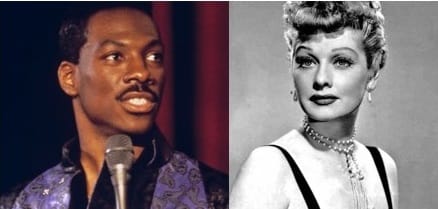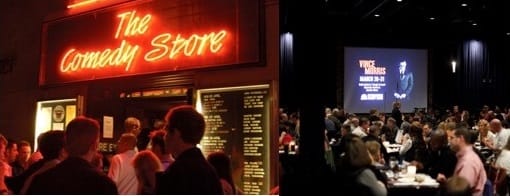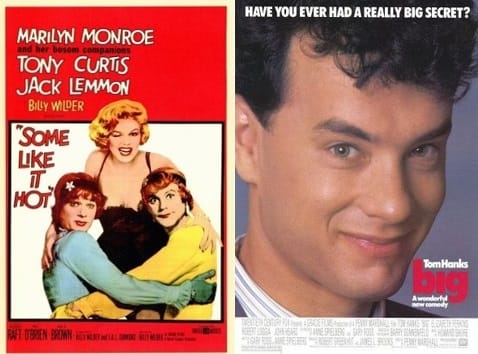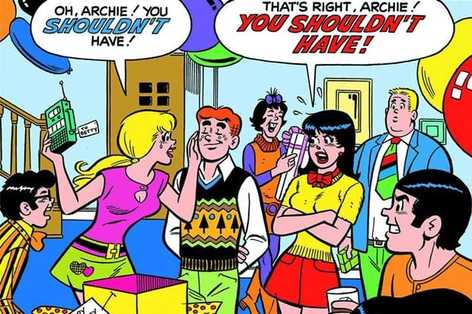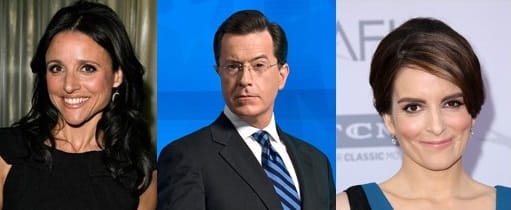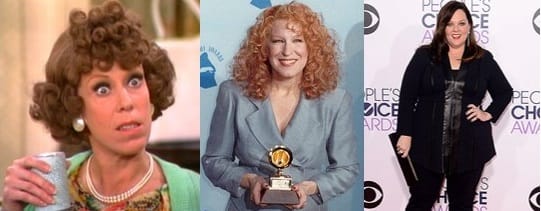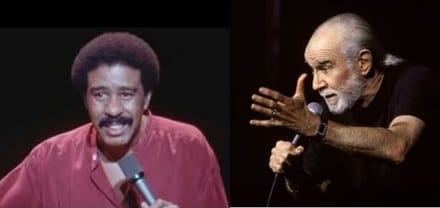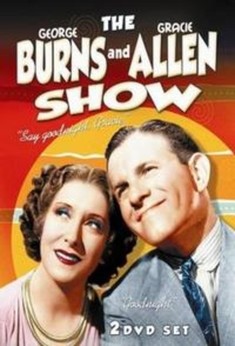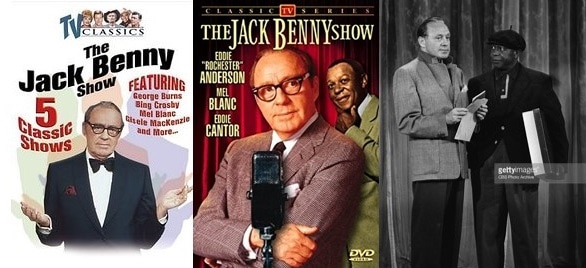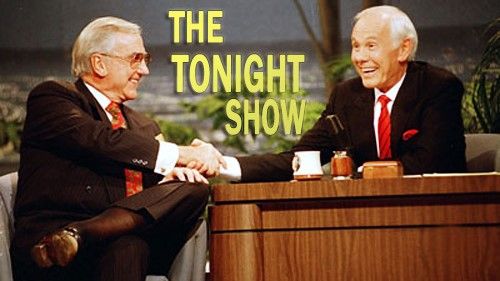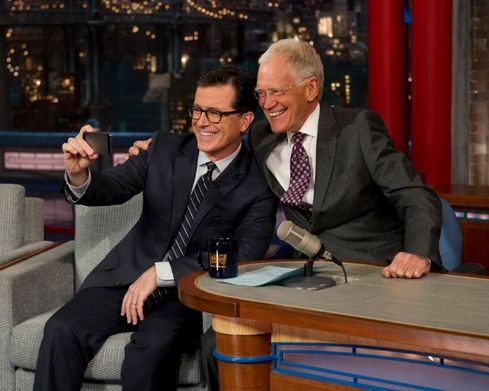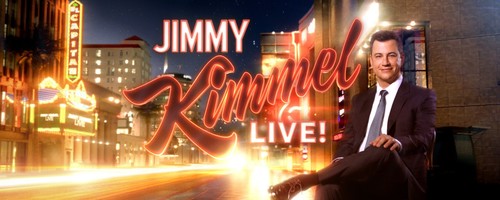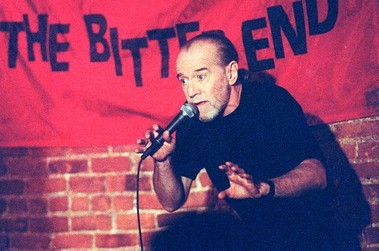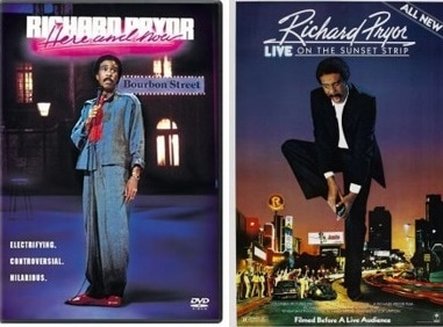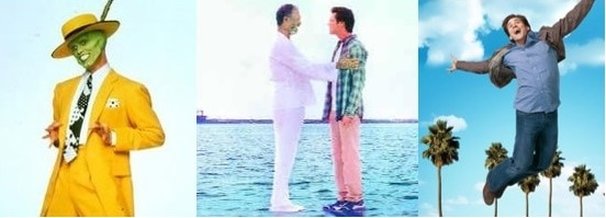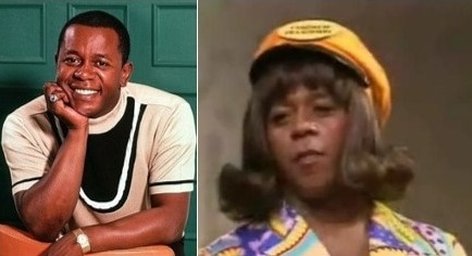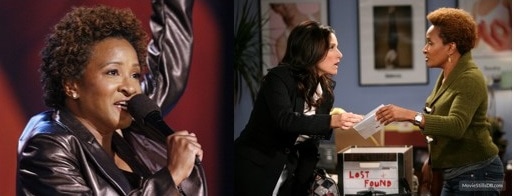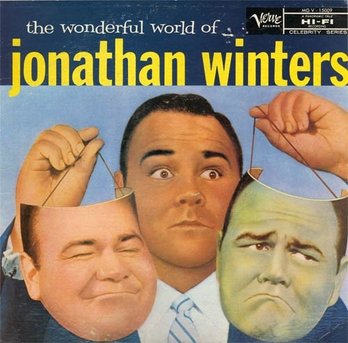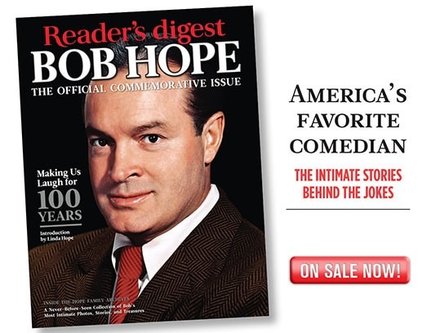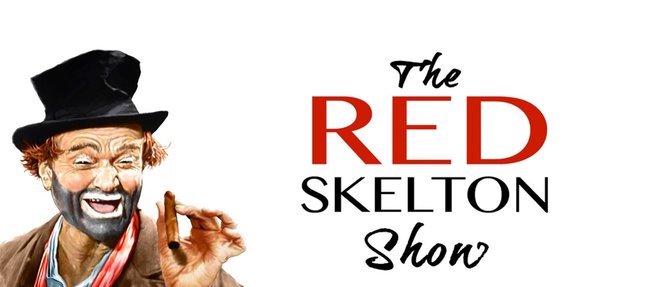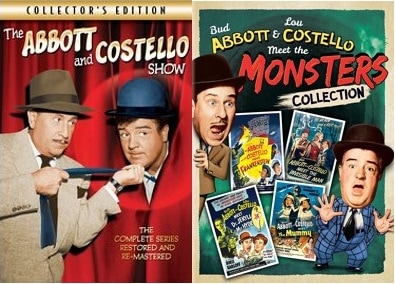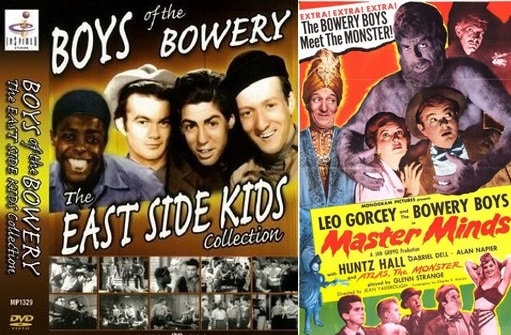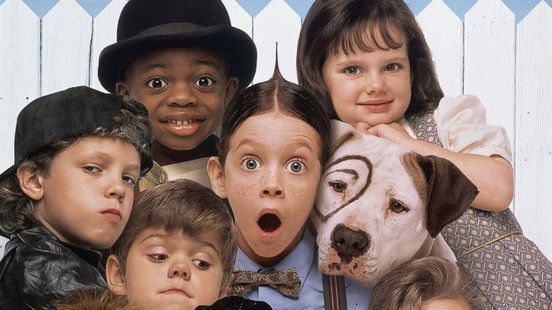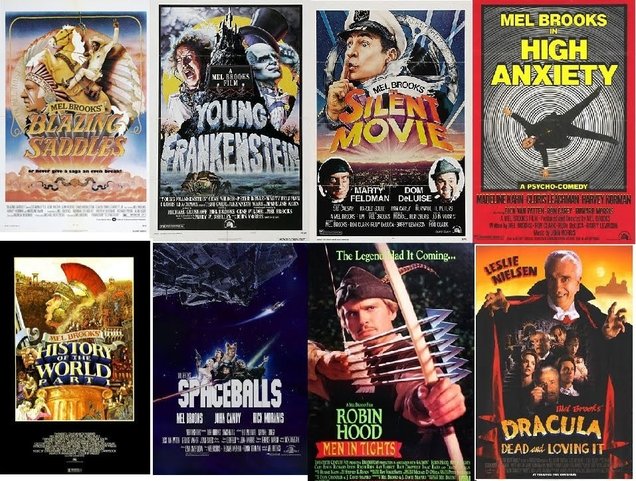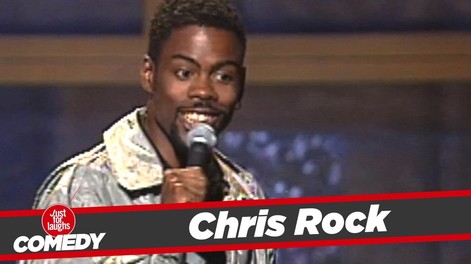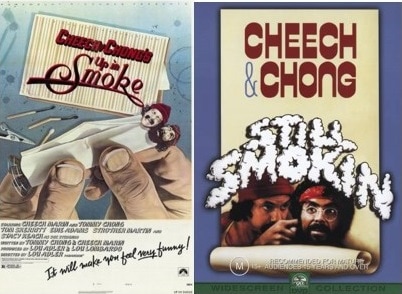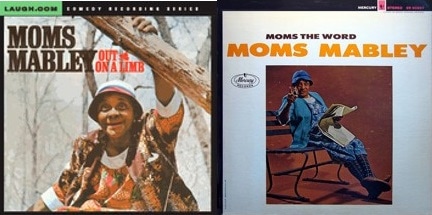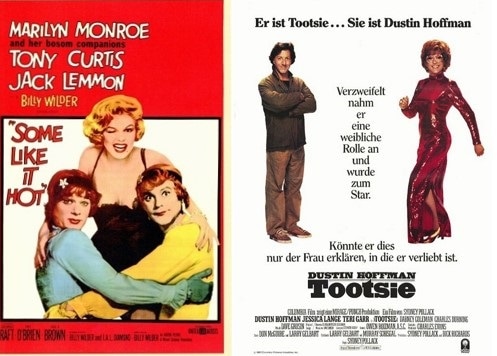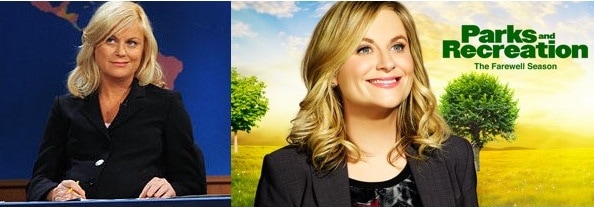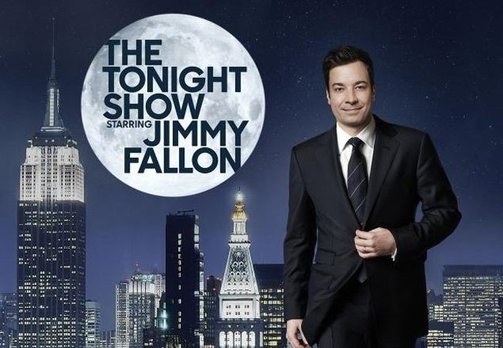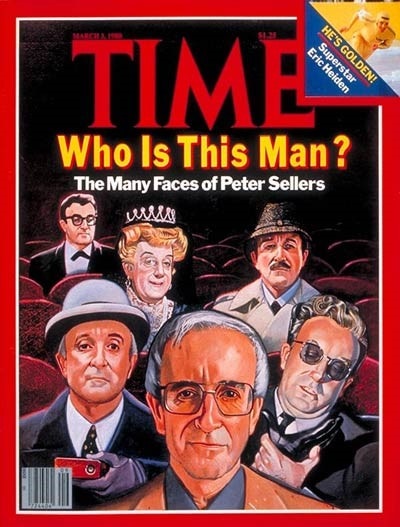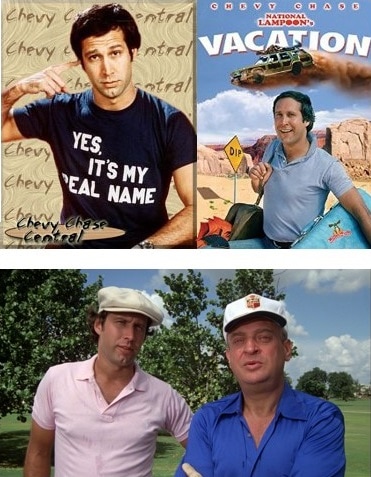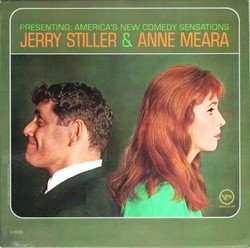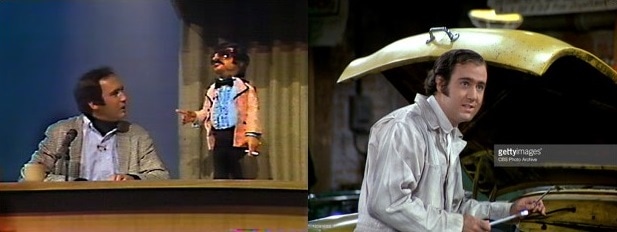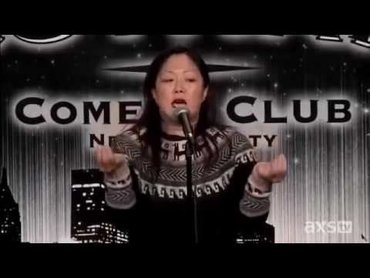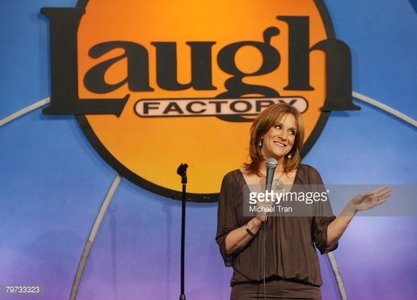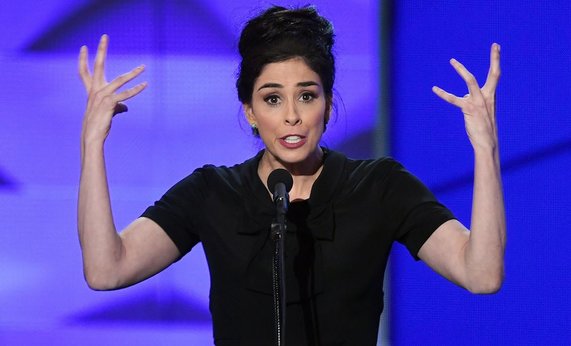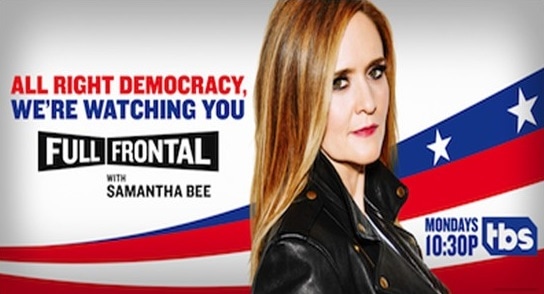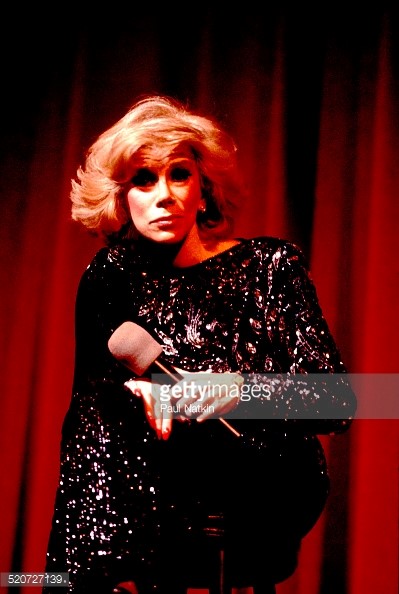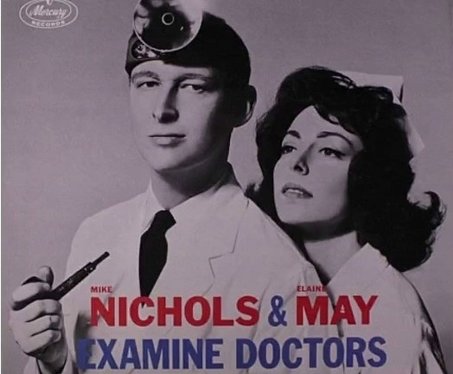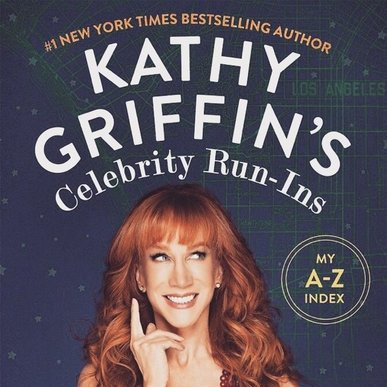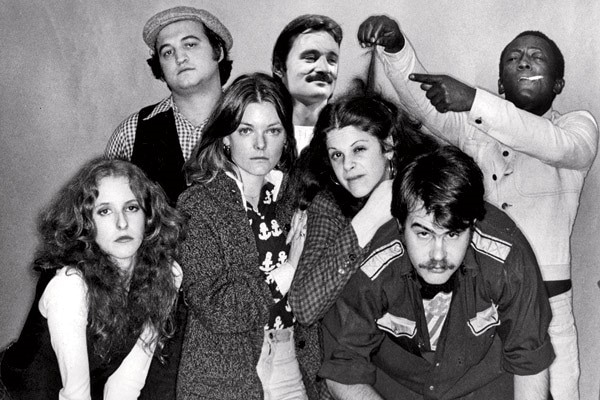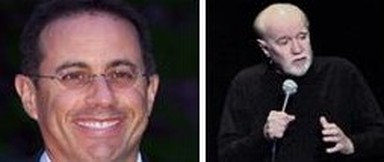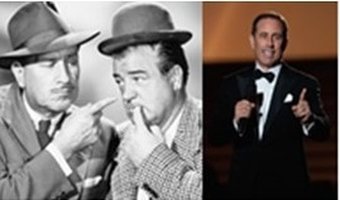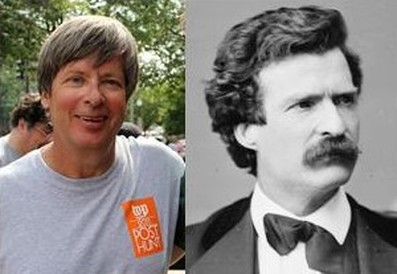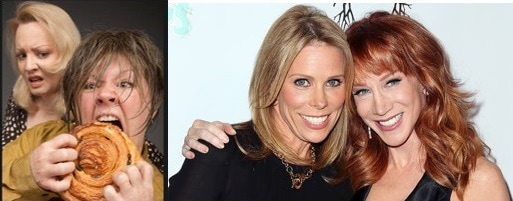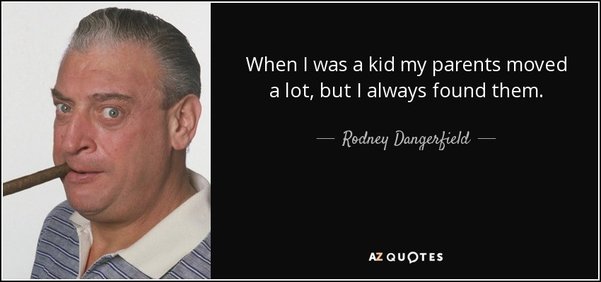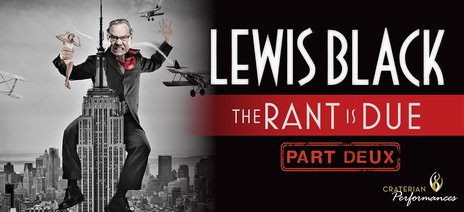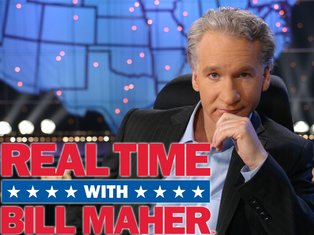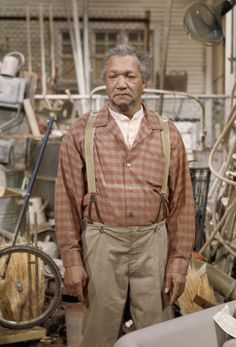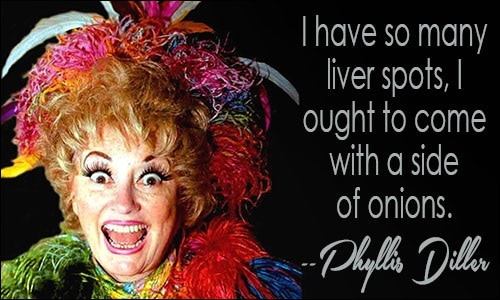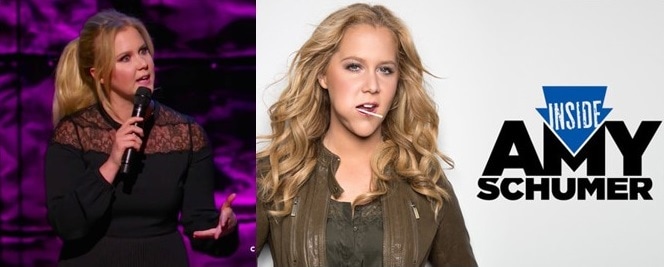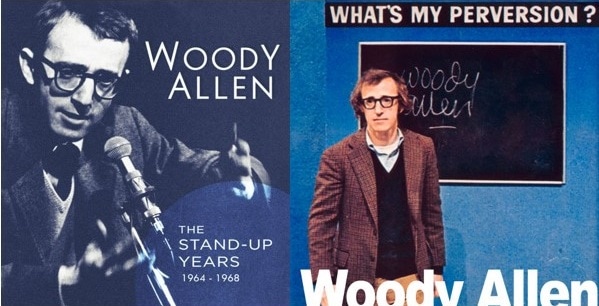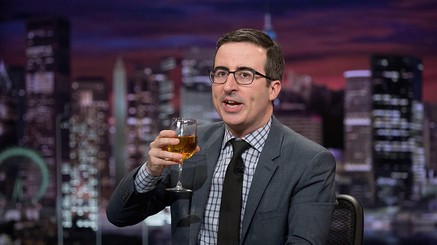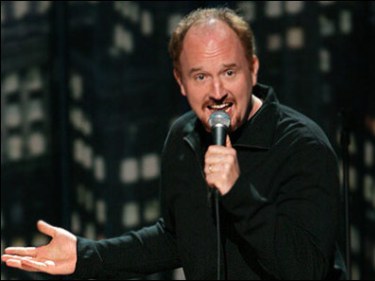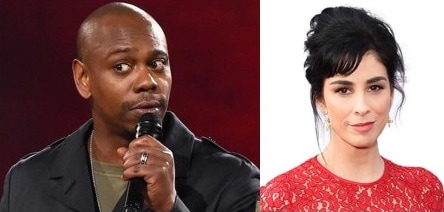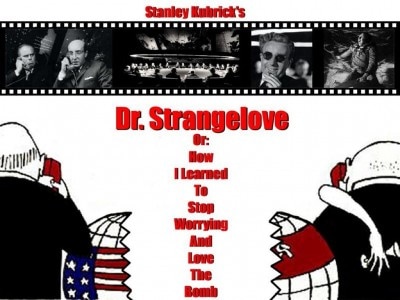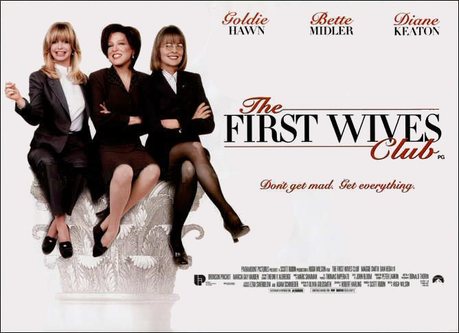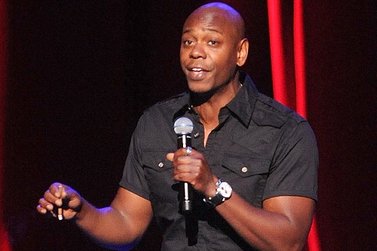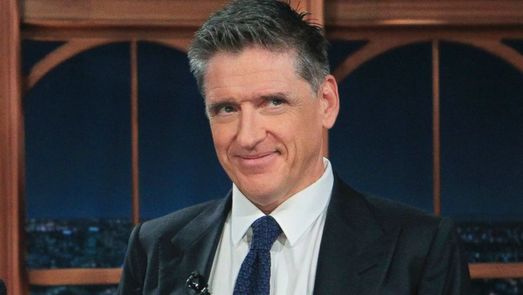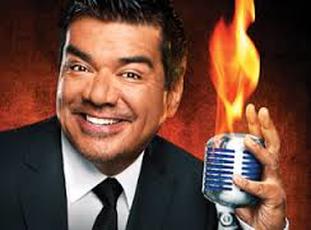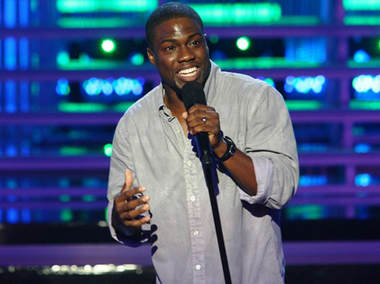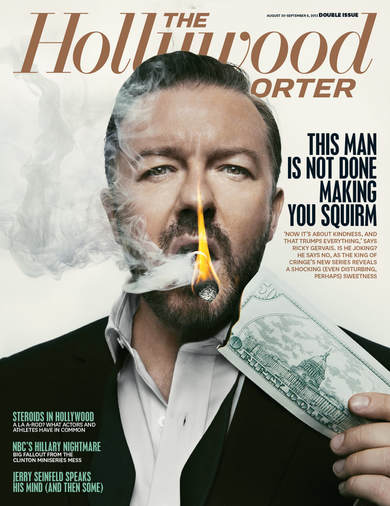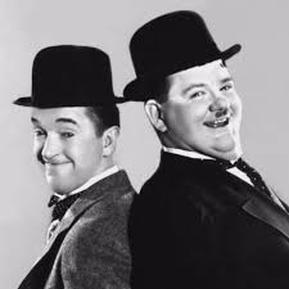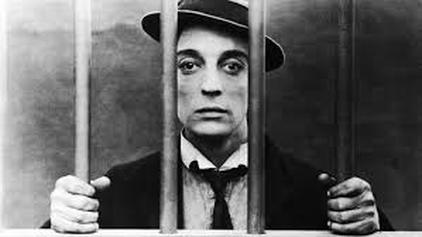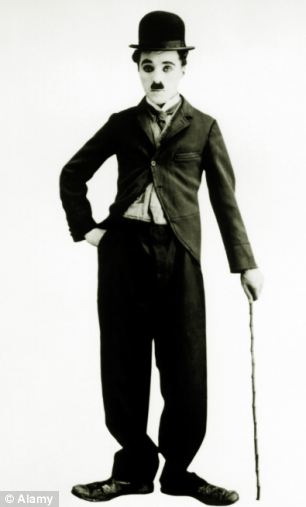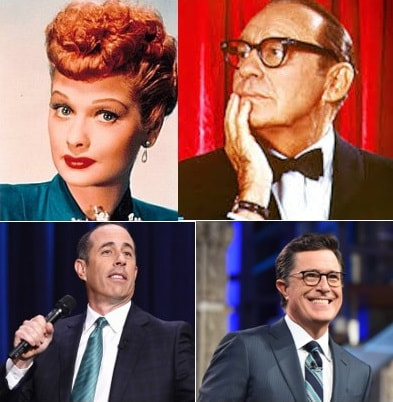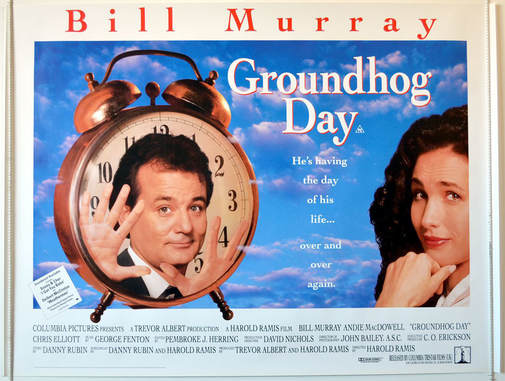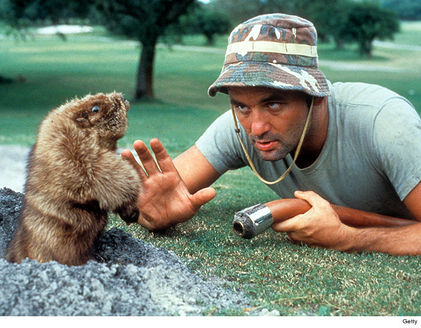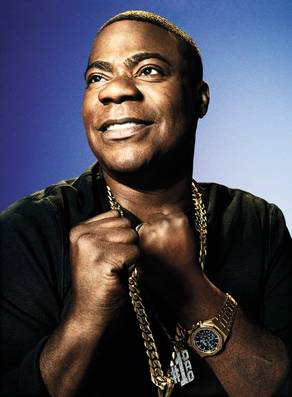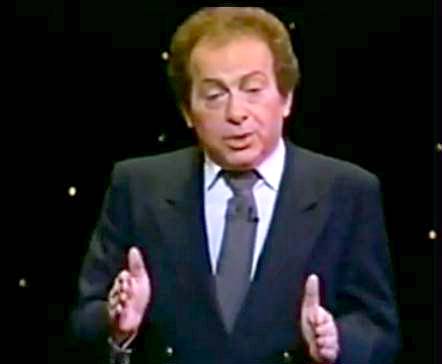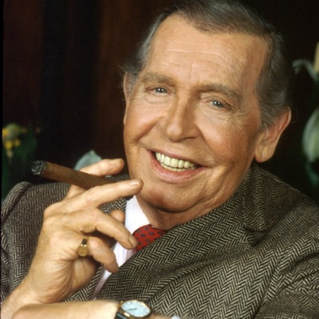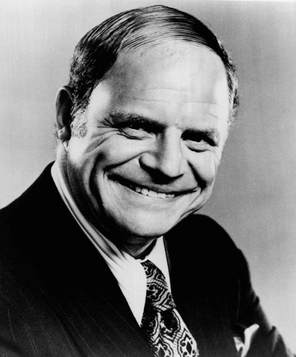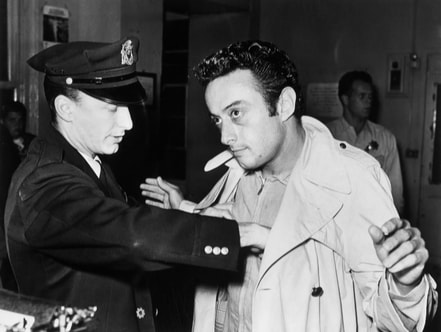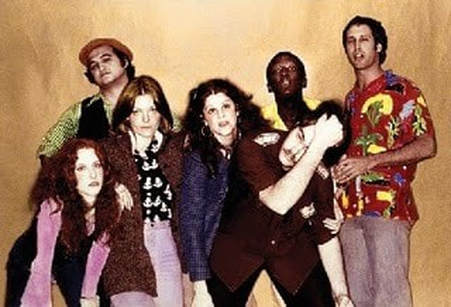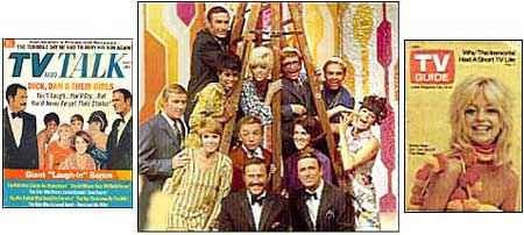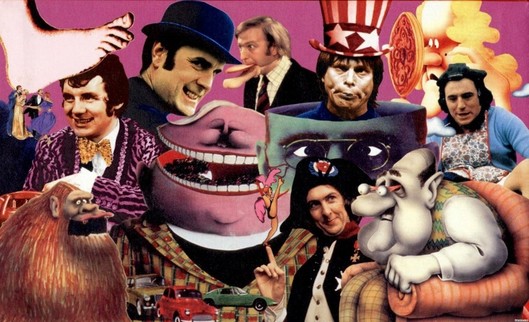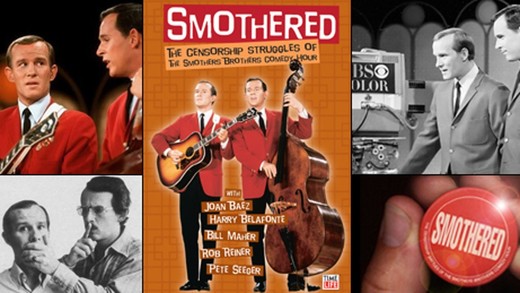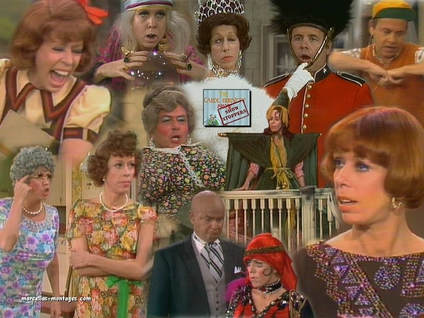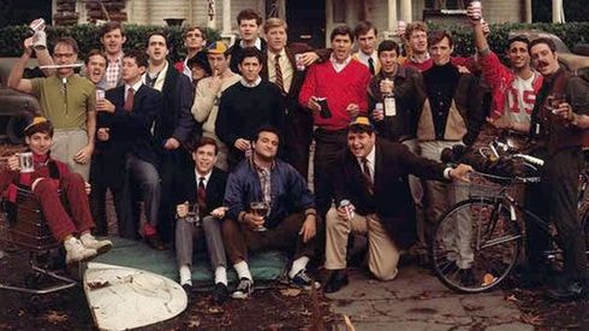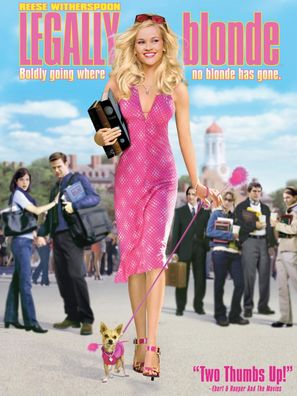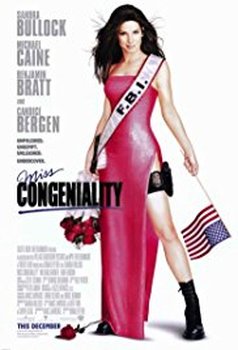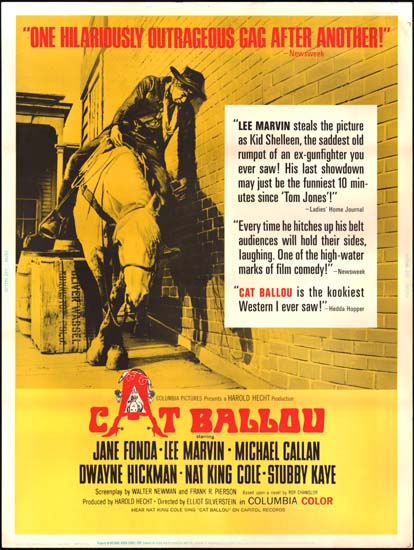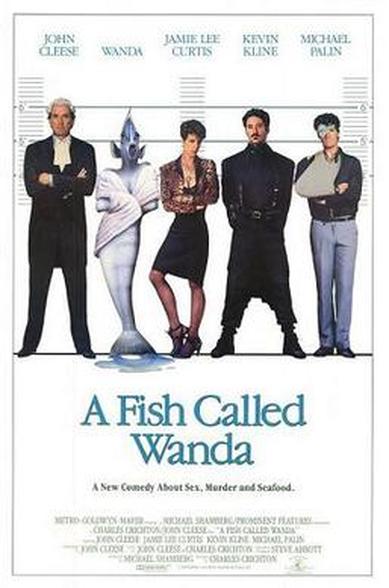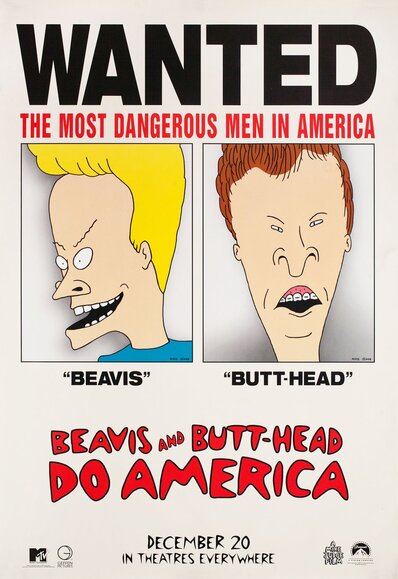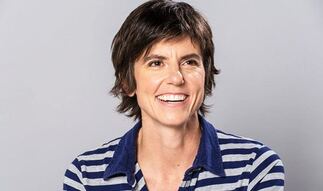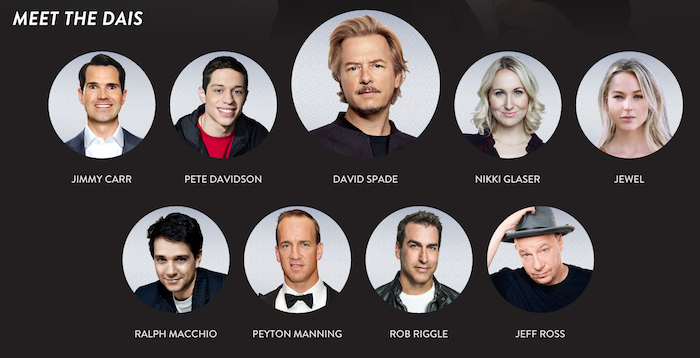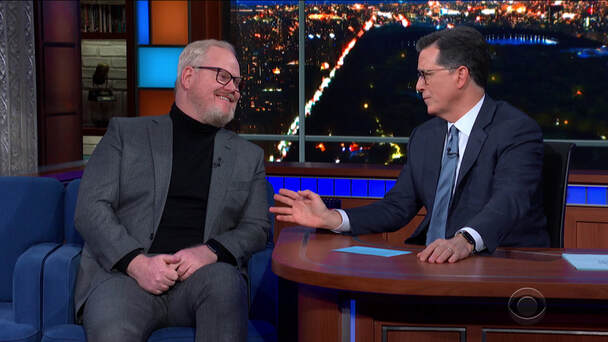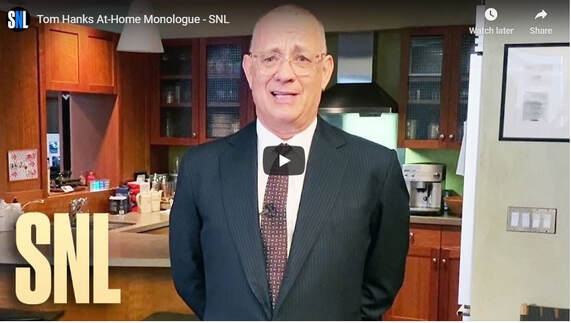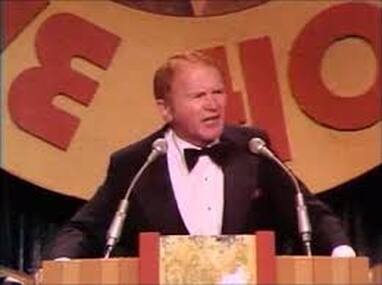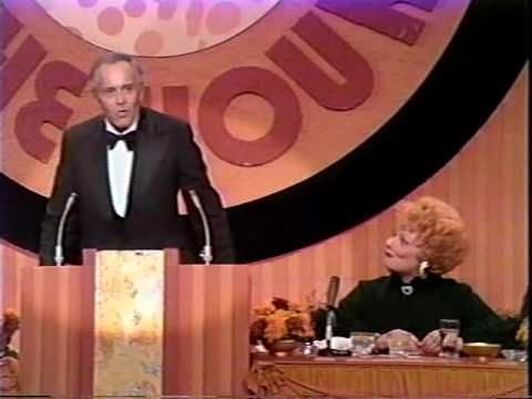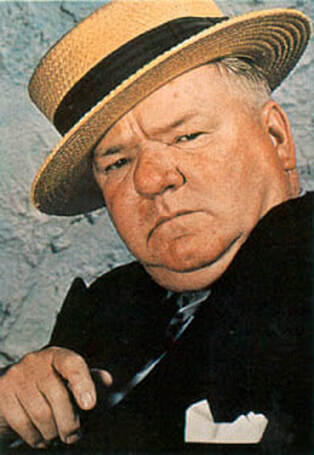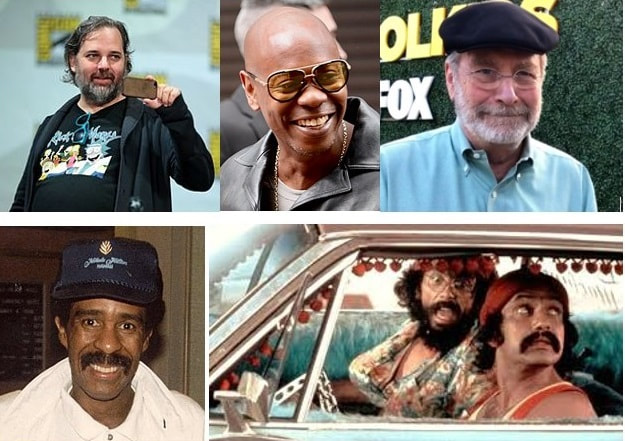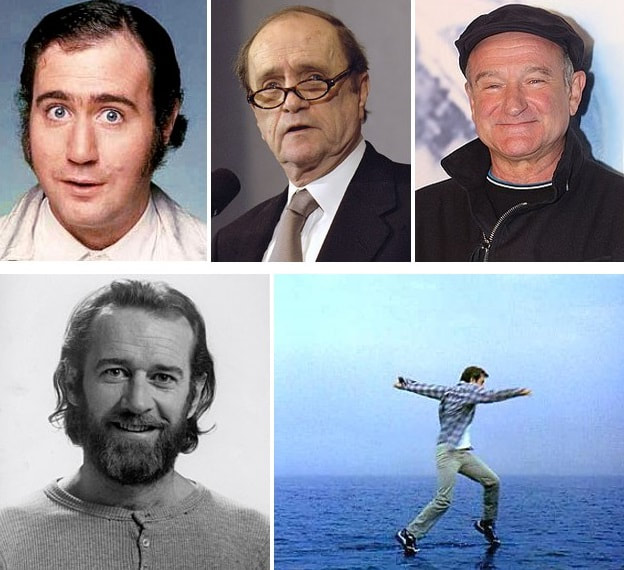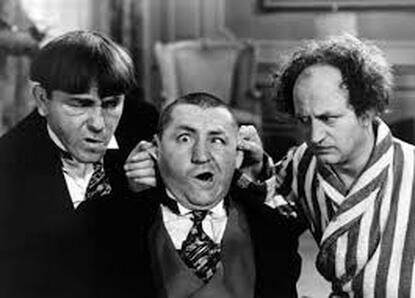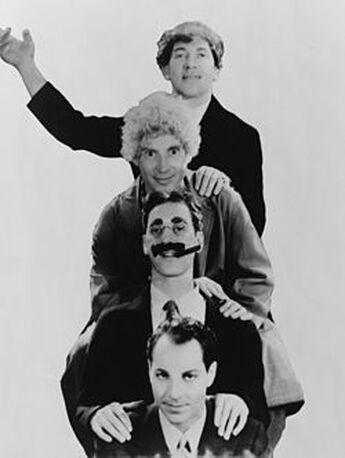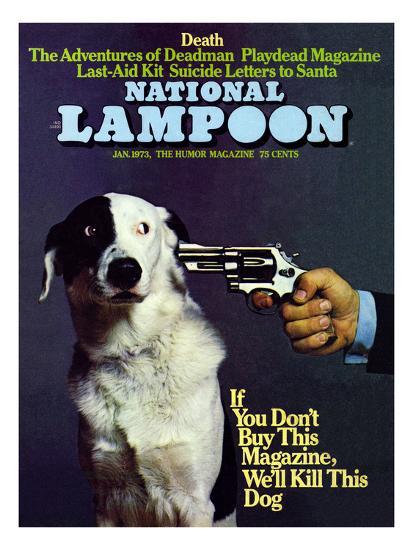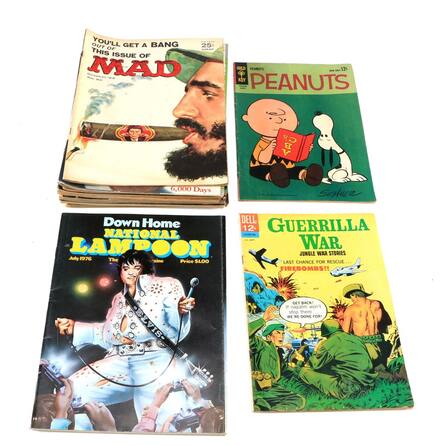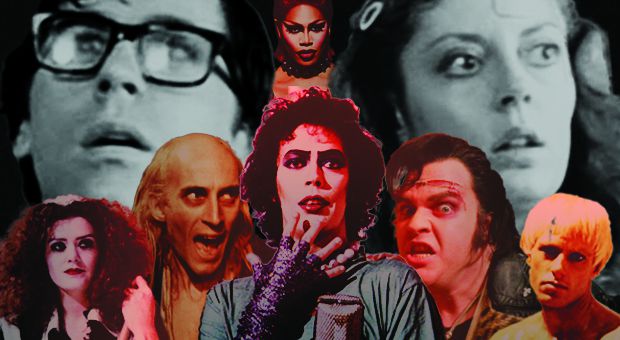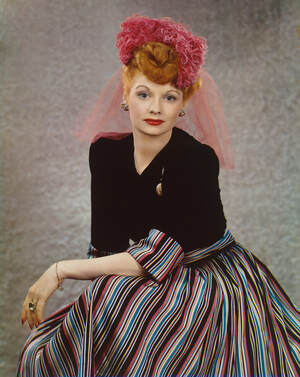Copyright © 2015 Bert N. Langford (Images may be subject to copyright. Please send feedback)
Welcome to Our Generation USA!
The Best in Comedy
Within the following we feature the most popular comedians and comedy venues, whether in live performances or found in the Movies, Television, the Internet, and other venues
For TV Sitcoms, click here
Comedy, including a List of Stand-up Comedians in the United States
YouTube Video: Abbott & Costello* Who's On First
* -- Abbott & Costello
Pictured: LEFT: Eddie Murphy; RIGHT: Lucille Ball
Click here for a listing of Stand-up Comedians in the United States
Comedy refers to any discourse or work generally intended to be humorous or amusing by inducing laughter, especially in theatre, television, film, and stand-up comedy.
Satire and political satire use comedy to portray persons or social institutions as ridiculous or corrupt, thus alienating their audience from the object of their humor.
Parody subverts popular genres and forms, critiquing those forms without necessarily condemning them.
Other forms of comedy include screwball comedy, which derives its humor largely from bizarre, surprising (and improbable) situations or characters, and black comedy, which is characterized by a form of humor that includes darker aspects of human behavior or human nature.
Similarly scatological humor, sexual humor, and race humor create comedy by violating social conventions or taboos in comic ways. A comedy of manners typically takes as its subject a particular part of society (usually upper class society) and uses humor to parody or satirize the behavior and mannerisms of its members.
Romantic comedy is a popular genre that depicts burgeoning romance in humorous terms and focuses on the foibles of those who are falling in love.
The phenomena connected with laughter and that which provokes it have been carefully investigated by psychologists. They agree the predominant characteristics are incongruity or contrast in the object and shock or emotional seizure on the part of the subject. It has also been held that the feeling of superiority is an essential factor: thus Thomas Hobbes speaks of laughter as a "sudden glory". Modern investigators have paid much attention to the origin both of laughter and of smiling, as well as the development of the "play instinct" and its emotional expression.
George Meredith said that "One excellent test of the civilization of a country ... I take to be the flourishing of the Comic idea and Comedy; and the test of true Comedy is that it shall awaken thoughtful laughter." Laughter is said to be the cure to being sick. Studies show that people who laugh more often get sick less.
American literary theorist Kenneth Burke writes that the "comic frame" in rhetoric is "neither wholly euphemistic, nor wholly debunking—hence it provides the charitable attitude towards people that is required for purposes of persuasion and co-operation, but at the same time maintains our shrewdness concerning the simplicities of ‘cashing in.’"
The purpose of the comic frame is to satirize a given circumstance and promote change by doing so. The comic frame makes fun of situations and people, while simultaneously provoking thought. The comic frame does not aim to vilify in its analysis, but rather, rebuke the stupidity and foolery of those involved in the circumstances.
For example, on The Daily Show, Jon Stewart uses the "comic frame" to intervene in political arguments, one such way is his sudden contrast of serious news with crude humor.
In a segment on President Obama's trip to China Stewart remarks on America's debt to the Chinese government while also having a weak relationship with the country. After depicting this dismal situation, Stewart shifts to speak directly to President Obama, calling upon him to "shine that turd up."
For Stewart and his audience, introducing coarse language into what is otherwise a serious commentary on the state of foreign relations serves to frame the segment comically, creating a serious tone underlying the comedic agenda presented by Stewart.
Forms: Comedic genres
Comedy may be divided into multiple genres based on the source of humor, the method of delivery, and the context in which it is delivered. The different forms of comedy often overlap, and most comedy can fit into multiple genres. Some of the subgenres of comedy are:
Some comedy apes certain cultural forms: for instance, parody and satire often imitate the conventions of the genre they are parodying or satirizing. For example, The Onion and The Colbert Report parody newspapers and television news shows like The O'Reilly Factor.
Another form of comedy would be self-deprecation. Many comedians focus on their misfortunes and foibles to entertain the public.
For further amplification about Comedy, click on any of the following blue hyperlinks:
Comedy refers to any discourse or work generally intended to be humorous or amusing by inducing laughter, especially in theatre, television, film, and stand-up comedy.
Satire and political satire use comedy to portray persons or social institutions as ridiculous or corrupt, thus alienating their audience from the object of their humor.
Parody subverts popular genres and forms, critiquing those forms without necessarily condemning them.
Other forms of comedy include screwball comedy, which derives its humor largely from bizarre, surprising (and improbable) situations or characters, and black comedy, which is characterized by a form of humor that includes darker aspects of human behavior or human nature.
Similarly scatological humor, sexual humor, and race humor create comedy by violating social conventions or taboos in comic ways. A comedy of manners typically takes as its subject a particular part of society (usually upper class society) and uses humor to parody or satirize the behavior and mannerisms of its members.
Romantic comedy is a popular genre that depicts burgeoning romance in humorous terms and focuses on the foibles of those who are falling in love.
The phenomena connected with laughter and that which provokes it have been carefully investigated by psychologists. They agree the predominant characteristics are incongruity or contrast in the object and shock or emotional seizure on the part of the subject. It has also been held that the feeling of superiority is an essential factor: thus Thomas Hobbes speaks of laughter as a "sudden glory". Modern investigators have paid much attention to the origin both of laughter and of smiling, as well as the development of the "play instinct" and its emotional expression.
George Meredith said that "One excellent test of the civilization of a country ... I take to be the flourishing of the Comic idea and Comedy; and the test of true Comedy is that it shall awaken thoughtful laughter." Laughter is said to be the cure to being sick. Studies show that people who laugh more often get sick less.
American literary theorist Kenneth Burke writes that the "comic frame" in rhetoric is "neither wholly euphemistic, nor wholly debunking—hence it provides the charitable attitude towards people that is required for purposes of persuasion and co-operation, but at the same time maintains our shrewdness concerning the simplicities of ‘cashing in.’"
The purpose of the comic frame is to satirize a given circumstance and promote change by doing so. The comic frame makes fun of situations and people, while simultaneously provoking thought. The comic frame does not aim to vilify in its analysis, but rather, rebuke the stupidity and foolery of those involved in the circumstances.
For example, on The Daily Show, Jon Stewart uses the "comic frame" to intervene in political arguments, one such way is his sudden contrast of serious news with crude humor.
In a segment on President Obama's trip to China Stewart remarks on America's debt to the Chinese government while also having a weak relationship with the country. After depicting this dismal situation, Stewart shifts to speak directly to President Obama, calling upon him to "shine that turd up."
For Stewart and his audience, introducing coarse language into what is otherwise a serious commentary on the state of foreign relations serves to frame the segment comically, creating a serious tone underlying the comedic agenda presented by Stewart.
Forms: Comedic genres
Comedy may be divided into multiple genres based on the source of humor, the method of delivery, and the context in which it is delivered. The different forms of comedy often overlap, and most comedy can fit into multiple genres. Some of the subgenres of comedy are:
- farce,
- comedy of manners,
- burlesque, and
- satire.
Some comedy apes certain cultural forms: for instance, parody and satire often imitate the conventions of the genre they are parodying or satirizing. For example, The Onion and The Colbert Report parody newspapers and television news shows like The O'Reilly Factor.
Another form of comedy would be self-deprecation. Many comedians focus on their misfortunes and foibles to entertain the public.
For further amplification about Comedy, click on any of the following blue hyperlinks:
Comedy Clubs including a List of Comedy Clubs in the United States
YouTube Video of Richard Pryor & Robin Williams at The Comedy Store* in Los Angeles
* -- Comedy Store
Pictured: LEFT: The Comedy Store; the Funny Bone Comedy Club
Click here for a List of Comedy Clubs in the United States.
A comedy club is a venue—typically a nightclub, bar, or restaurant—where people watch or listen to performances, including:
The term "comedy club" usually refers to venues that feature stand-up comedy, as distinguished from improvisational theatres, which host improv or sketch comedy, and variety clubs (which may also host musical acts).
Comedy clubs are usually broken down by comedians into "A rooms", "B rooms", and "C rooms":
A comedy club is a venue—typically a nightclub, bar, or restaurant—where people watch or listen to performances, including:
- stand-up comedians,
- improvisational comedians,
- impersonators,
- magicians,
- ventriloquists,
- and other comedy acts.
The term "comedy club" usually refers to venues that feature stand-up comedy, as distinguished from improvisational theatres, which host improv or sketch comedy, and variety clubs (which may also host musical acts).
Comedy clubs are usually broken down by comedians into "A rooms", "B rooms", and "C rooms":
- "A" rooms usually cater to people with movie deals, people with television shows, and generally well known acts.
- "C" rooms act as "neighborhood" comedy clubs, for the most part. The headliners are not usually very well known or popular, and the audiences are random walk-ins.
- "B" rooms are where the best aspects of both A rooms and C rooms meet. Young comics need B rooms as a stepping stone. These are rooms where someone doing a 10- to 15-minute set (hosting/MCing) can be asked, after they've been going up long enough, to do a 20-minute set (featuring) and so on. These clubs also typically allow dirtier material, since they can become established names for "dirty" comedy or shows that usually cover adult themes.
Comedy Movies including a List of American Comedy Movies
YouTube Video of the Movie Trailer for "Bruce Almighty"*
* -- Bruce Almighty (2003)
Pictured: Theatrical Posters for Comedy Movies LEFT: “Some Like it Hot” (1959); RIGHT: “Big” (1989)
Click here for a list of American Comedy Movies.
Comedy is a genre of film in which the main emphasis is on humor. These films are designed to make the audience laugh through amusement and most often work by exaggerating characteristics for humorous effect.
Films in this style traditionally have a happy ending (black comedy being an exception). One of the oldest genres in film, some of the very first silent movies were comedies, as slapstick comedy often relies on visual depictions, without requiring sound. When sound films became more prevalent during the 1920s, comedy films took another swing, as laughter could result from burlesque situations but also dialogue.
Comedy, compared to other film genres, puts much more focus on individual stars, with many former stand-up comics transitioning to the film industry due to their popularity.
While many comic films are lighthearted stories with no intent other than to amuse, others contain political or social commentary (such as Wag the Dog and Man of the Year).
American comedy films are comedy films produced in the United States. The genre is one of the oldest in American cinema; some of the very first silent movies were comedies, as slapstick comedy often relies on visual depictions, without requiring sound.
With the advent of sound in the late 1920s and 1930s, comedic dialogue rose in prominence in the work of film comedians such as W. C. Fields and the Marx Brothers. By the 1950s, the television industry had become serious competition for the movie industry. The 1960s saw an increasing number of broad, star-packed comedies.
In the 1970s, black comedies were popular. Leading figures in the 1970s were Woody Allen and Mel Brooks. One of the major developments of the 1990s was the re-emergence of the romantic comedy film. Another development was the increasing use of "gross-out humor".
1930 and earlier:
Comic films began to appear in significant numbers during the era of silent films, roughly 1895 to 1930. The visual humor of many of these silent films relied on slapstick and burlesque. In American film, the most prominent comic actors of the silent era were Charlie Chaplin (although born in England, his success was principally in the U.S.), Buster Keaton and Harold Lloyd.
A popular trend during the 1920s and afterward was comedy in the form of animated cartoons. Several popular characters of the period received the cartoon treatment. Among these were Felix the Cat, Mickey Mouse, Oswald the Lucky Rabbit, and Betty Boop.
1931-1959:
Toward the end of the 1920s, the introduction of sound into movies made possible dramatic new film styles and the use of verbal humour. During the 1930s, the silent film comedy was replaced by dialogue from film comedians such as the W. C. Fields and the Marx Brothers.
Stan Laurel and Oliver Hardy, who had made a number of very popular short silent films, used the arrival of sound to deepen their well-formed screen characterizations and enhance their visual humour, and went on to great success in talking films. The comedian Charlie Chaplin was one of the last silent film hold-outs, and his films during the 1930s were devoid of dialogue, although they did employ sound effects.
Screwball comedies, such as produced by Frank Capra, exhibited a pleasing, idealized climate that portrayed reassuring social values and a certain optimism about everyday life.
Movies still included slapstick humour and other physical comedy, but these were now frequently supplemental to the verbal interaction. Another common comic production from the 1930s was the short subject. Hal Roach Studio specialized in this form. While Columbia was prolific, producing 190 Three Stooges releases, alone. These non-feature productions only went into decline in the 1950s when they were migrated to the television.
With the entry of the United States into World War II, Hollywood became focused on themes related to the conflict. Comedies portrayed military themes such as service, civil defense, boot-camp and shore-leave. The war-time restrictions on travel made this a boom time for Hollywood, and nearly a quarter of the money spent on attending movies.
The post-war period was an age of reflection on the war, and the emergence of a competing medium, the television. In 1948, television began to acquire commercial momentum and by the following year there were nearly a hundred television transmitters in American cities.
By the 1950s, the television industry had become a serious competition for the movie industry. Despite the technological limitations of the TV medium at the time, more and more people chose to stay home to watch the television. The Hollywood studios at first viewed the television as a threat, and later as a commercial market. Several comic forms that had previously been a staple of movie theaters transitioned to the television. Both the short subject and the cartoon now appeared on the television rather than in the theater, and the "B" movie also found its outlet on the television.
As television became filled with family-oriented comedies, the 1950s saw a trend toward more adult social situations. Only the Walt Disney studios continued to steadily release family comedies. The release of comedy films also went into a decline during this decade. In 1947 almost one in five films had been comic in nature, but by 1954 this was down to ten percent.
The 1950s saw the decline of past comedy stars and a certain paucity of new talent in Hollywood. Among the few popular new stars during this period were Judy Holliday and the comedy team phenom of Dean Martin and Jerry Lewis. Lewis followed the legacy of such comedians as Keaton and Harold Lloyd, but his work was not well received by critics in the United States (in contrast to France where he proved highly popular.)
1960s-1980s:
The next decade saw an increasing number of broad, star-packed comedies including:
By the middle of the decade, some of the 1950s generation of American comedians, such as Jerry Lewis, went into decline, while Peter Sellers found success with international audiences in his first American film The Pink Panther. The bumbling Inspector Clouseau was a character Sellers would continue to return to over the next decade.
Toward the end of the 1950s, darker humor and more serious themes had begun to emerge, including satire and social commentary. Dr. Strangelove (1964) was a satirical comedy about Cold War paranoia, while The Apartment (1960), Alfie (1966) and The Graduate (1967) featured sexual themes in a way that would have been impossible only a few years previously.
In 1970, the black comedies Catch 22 and M*A*S*H reflected the anti-war sentiment then prevalent, as well as treating the sensitive topic of suicide. M*A*S*H would be toned down and brought to television in the following decade as a long-running series.
Among the leading lights in comedy films of the next decade were Woody Allen and Mel Brooks. Both wrote, directed and appeared in their movies.
Brooks' style was generally slapstick and zany in nature, often parodying film styles and genres, including Universal horror films (Young Frankenstein), westerns (Blazing Saddles) and Hitchcock films (High Anxiety).
Following his success on Broadway and on film with The Odd Couple playwright and screenwriter Neil Simon would also be prominent in the 1970s, with films like The Sunshine Boys and California Suite.
Other notable film comedians who appeared later in the decade were Richard Pryor, Steve Martin and Burt Reynolds.
In 1980, the gag-based comedy Airplane!, a spoof of the previous decade's disaster film series was released and paved the way for more of the same including Top Secret! (1984) and the Naked Gun films.
Popular comedy stars in the 1980s included Dudley Moore, Tom Hanks, Eddie Murphy and Dan Aykroyd. Many had come to prominence on the American TV series Saturday Night Live, including Bill Murray, Steve Martin and Chevy Chase.
Eddie Murphy made a success of comedy-action films including 48 Hrs. (1982) and the Beverly Hills Cop series (1984–1993).
Also popular were the films of John Hughes such as Ferris Bueller's Day Off. He would later become best known for the Home Alone series of the early 1990s. The latter film helped a revival in comedies aimed at a family audience, along with Honey, I Shrunk the Kids and its sequels.
1990-Present:
One of the major developments of the 1990s was the re-emergence of the romantic comedy film, encouraged by the success of When Harry Met Sally... in 1989. Other examples included Sleepless in Seattle (1993), Clueless (1995) and You've Got Mail (1998). Spoofs remained popular as well, especially with the Scary Movie franchise and Not Another Teen Movie.
There were also "stoner" comedies, which often involve two men on an adventure with random things happening to them along the way. Big movies of this subgenre would be Dude, Where's My Car, Big Nothing, Harold & Kumar Go to White Castle, and Pineapple Express. These movies usually have drug-related jokes and crude content.
Another development was the increasing use of "gross-out humour" usually aimed at a younger audience, in films like There's Something About Mary, American Pie and its sequels, and Freddy Got Fingered. In mid-2000s, the trend of "gross-out" movies is continuing, with adult-oriented comedies picking up the box office.
But serious black comedies (also known as dramatic comedies or dramedies) were performing also well, such as The Weather Man, Broken Flowers and Shopgirl. In late 2006, Borat: Cultural Learnings of America for Make Benefit Glorious Nation of Kazakhstan blended vulgar humour with cultural satire.
Since the late 2000s, the live-action comedy film has entered a period of severe decline, with studios green-lighting far fewer of them each year.
The problem is that faced with brutal competition in developed markets in the same timeframe, major film studios became dependent upon distributing their films to increasingly diverse international audiences in emerging markets to maintain their profits; but the humor in most comedy films is tightly bound to the home culture of the films' creators and does not translate well.
Comedy is a genre of film in which the main emphasis is on humor. These films are designed to make the audience laugh through amusement and most often work by exaggerating characteristics for humorous effect.
Films in this style traditionally have a happy ending (black comedy being an exception). One of the oldest genres in film, some of the very first silent movies were comedies, as slapstick comedy often relies on visual depictions, without requiring sound. When sound films became more prevalent during the 1920s, comedy films took another swing, as laughter could result from burlesque situations but also dialogue.
Comedy, compared to other film genres, puts much more focus on individual stars, with many former stand-up comics transitioning to the film industry due to their popularity.
While many comic films are lighthearted stories with no intent other than to amuse, others contain political or social commentary (such as Wag the Dog and Man of the Year).
American comedy films are comedy films produced in the United States. The genre is one of the oldest in American cinema; some of the very first silent movies were comedies, as slapstick comedy often relies on visual depictions, without requiring sound.
With the advent of sound in the late 1920s and 1930s, comedic dialogue rose in prominence in the work of film comedians such as W. C. Fields and the Marx Brothers. By the 1950s, the television industry had become serious competition for the movie industry. The 1960s saw an increasing number of broad, star-packed comedies.
In the 1970s, black comedies were popular. Leading figures in the 1970s were Woody Allen and Mel Brooks. One of the major developments of the 1990s was the re-emergence of the romantic comedy film. Another development was the increasing use of "gross-out humor".
1930 and earlier:
Comic films began to appear in significant numbers during the era of silent films, roughly 1895 to 1930. The visual humor of many of these silent films relied on slapstick and burlesque. In American film, the most prominent comic actors of the silent era were Charlie Chaplin (although born in England, his success was principally in the U.S.), Buster Keaton and Harold Lloyd.
A popular trend during the 1920s and afterward was comedy in the form of animated cartoons. Several popular characters of the period received the cartoon treatment. Among these were Felix the Cat, Mickey Mouse, Oswald the Lucky Rabbit, and Betty Boop.
1931-1959:
Toward the end of the 1920s, the introduction of sound into movies made possible dramatic new film styles and the use of verbal humour. During the 1930s, the silent film comedy was replaced by dialogue from film comedians such as the W. C. Fields and the Marx Brothers.
Stan Laurel and Oliver Hardy, who had made a number of very popular short silent films, used the arrival of sound to deepen their well-formed screen characterizations and enhance their visual humour, and went on to great success in talking films. The comedian Charlie Chaplin was one of the last silent film hold-outs, and his films during the 1930s were devoid of dialogue, although they did employ sound effects.
Screwball comedies, such as produced by Frank Capra, exhibited a pleasing, idealized climate that portrayed reassuring social values and a certain optimism about everyday life.
Movies still included slapstick humour and other physical comedy, but these were now frequently supplemental to the verbal interaction. Another common comic production from the 1930s was the short subject. Hal Roach Studio specialized in this form. While Columbia was prolific, producing 190 Three Stooges releases, alone. These non-feature productions only went into decline in the 1950s when they were migrated to the television.
With the entry of the United States into World War II, Hollywood became focused on themes related to the conflict. Comedies portrayed military themes such as service, civil defense, boot-camp and shore-leave. The war-time restrictions on travel made this a boom time for Hollywood, and nearly a quarter of the money spent on attending movies.
The post-war period was an age of reflection on the war, and the emergence of a competing medium, the television. In 1948, television began to acquire commercial momentum and by the following year there were nearly a hundred television transmitters in American cities.
By the 1950s, the television industry had become a serious competition for the movie industry. Despite the technological limitations of the TV medium at the time, more and more people chose to stay home to watch the television. The Hollywood studios at first viewed the television as a threat, and later as a commercial market. Several comic forms that had previously been a staple of movie theaters transitioned to the television. Both the short subject and the cartoon now appeared on the television rather than in the theater, and the "B" movie also found its outlet on the television.
As television became filled with family-oriented comedies, the 1950s saw a trend toward more adult social situations. Only the Walt Disney studios continued to steadily release family comedies. The release of comedy films also went into a decline during this decade. In 1947 almost one in five films had been comic in nature, but by 1954 this was down to ten percent.
The 1950s saw the decline of past comedy stars and a certain paucity of new talent in Hollywood. Among the few popular new stars during this period were Judy Holliday and the comedy team phenom of Dean Martin and Jerry Lewis. Lewis followed the legacy of such comedians as Keaton and Harold Lloyd, but his work was not well received by critics in the United States (in contrast to France where he proved highly popular.)
1960s-1980s:
The next decade saw an increasing number of broad, star-packed comedies including:
- It's a Mad, Mad, Mad, Mad World (1963),
- Those Magnificent Men in Their Flying Machines (1965)
- and The Great Race (1965).
By the middle of the decade, some of the 1950s generation of American comedians, such as Jerry Lewis, went into decline, while Peter Sellers found success with international audiences in his first American film The Pink Panther. The bumbling Inspector Clouseau was a character Sellers would continue to return to over the next decade.
Toward the end of the 1950s, darker humor and more serious themes had begun to emerge, including satire and social commentary. Dr. Strangelove (1964) was a satirical comedy about Cold War paranoia, while The Apartment (1960), Alfie (1966) and The Graduate (1967) featured sexual themes in a way that would have been impossible only a few years previously.
In 1970, the black comedies Catch 22 and M*A*S*H reflected the anti-war sentiment then prevalent, as well as treating the sensitive topic of suicide. M*A*S*H would be toned down and brought to television in the following decade as a long-running series.
Among the leading lights in comedy films of the next decade were Woody Allen and Mel Brooks. Both wrote, directed and appeared in their movies.
Brooks' style was generally slapstick and zany in nature, often parodying film styles and genres, including Universal horror films (Young Frankenstein), westerns (Blazing Saddles) and Hitchcock films (High Anxiety).
Following his success on Broadway and on film with The Odd Couple playwright and screenwriter Neil Simon would also be prominent in the 1970s, with films like The Sunshine Boys and California Suite.
Other notable film comedians who appeared later in the decade were Richard Pryor, Steve Martin and Burt Reynolds.
In 1980, the gag-based comedy Airplane!, a spoof of the previous decade's disaster film series was released and paved the way for more of the same including Top Secret! (1984) and the Naked Gun films.
Popular comedy stars in the 1980s included Dudley Moore, Tom Hanks, Eddie Murphy and Dan Aykroyd. Many had come to prominence on the American TV series Saturday Night Live, including Bill Murray, Steve Martin and Chevy Chase.
Eddie Murphy made a success of comedy-action films including 48 Hrs. (1982) and the Beverly Hills Cop series (1984–1993).
Also popular were the films of John Hughes such as Ferris Bueller's Day Off. He would later become best known for the Home Alone series of the early 1990s. The latter film helped a revival in comedies aimed at a family audience, along with Honey, I Shrunk the Kids and its sequels.
1990-Present:
One of the major developments of the 1990s was the re-emergence of the romantic comedy film, encouraged by the success of When Harry Met Sally... in 1989. Other examples included Sleepless in Seattle (1993), Clueless (1995) and You've Got Mail (1998). Spoofs remained popular as well, especially with the Scary Movie franchise and Not Another Teen Movie.
There were also "stoner" comedies, which often involve two men on an adventure with random things happening to them along the way. Big movies of this subgenre would be Dude, Where's My Car, Big Nothing, Harold & Kumar Go to White Castle, and Pineapple Express. These movies usually have drug-related jokes and crude content.
Another development was the increasing use of "gross-out humour" usually aimed at a younger audience, in films like There's Something About Mary, American Pie and its sequels, and Freddy Got Fingered. In mid-2000s, the trend of "gross-out" movies is continuing, with adult-oriented comedies picking up the box office.
But serious black comedies (also known as dramatic comedies or dramedies) were performing also well, such as The Weather Man, Broken Flowers and Shopgirl. In late 2006, Borat: Cultural Learnings of America for Make Benefit Glorious Nation of Kazakhstan blended vulgar humour with cultural satire.
Since the late 2000s, the live-action comedy film has entered a period of severe decline, with studios green-lighting far fewer of them each year.
The problem is that faced with brutal competition in developed markets in the same timeframe, major film studios became dependent upon distributing their films to increasingly diverse international audiences in emerging markets to maintain their profits; but the humor in most comedy films is tightly bound to the home culture of the films' creators and does not translate well.
Comics, including a List
YouTube Video: Best of the Road Runner Cartoon Series*
* -- Wile El Coyote and the Road Runner
Pictured: Panel from the Archie Comic Book
Comics is a medium used to express ideas by images, often combined with text or other visual information. Comics frequently takes the form of juxtaposed sequences of panels of images.
Often textual devices such as speech balloons, captions, and onomatopoeia indicate dialogue, narration, sound effects, or other information. Size and arrangement of panels contribute to narrative pacing.
Cartooning and similar forms of illustration are the most common image-making means in comics; fumetti is a form which uses photographic images.
Common forms of comics include comic strips, editorial and gag cartoons, and comic books. Since the late 20th century, bound volumes such as graphic novels, comic albums, and tankōbon have become increasingly common, and online webcomics have proliferated in the 21st century.
The history of comics has followed different paths in different cultures. Scholars have posited a pre-history as far back as the Lascaux cave paintings. By the mid-20th century, comics flourished particularly in the United States.
American comics emerged as a mass medium in the early 20th century with the advent of newspaper comic strips; magazine-style comic books followed in the 1930s, in which the superhero genre became prominent after Superman appeared in 1938.
Comics have had a lowbrow reputation for much of its history, but towards the end of the 20th century began to find greater acceptance with the public and in academia.
The English term comics is used as a singular noun when it refers to the medium and a plural when referring to particular instances, such as individual strips or comic books. Though the term derives from the humorous (or comic) work that predominated in early American newspaper comic strips, it has become standard also for non-humorous works.
Click here for further amplification about Comics.
Often textual devices such as speech balloons, captions, and onomatopoeia indicate dialogue, narration, sound effects, or other information. Size and arrangement of panels contribute to narrative pacing.
Cartooning and similar forms of illustration are the most common image-making means in comics; fumetti is a form which uses photographic images.
Common forms of comics include comic strips, editorial and gag cartoons, and comic books. Since the late 20th century, bound volumes such as graphic novels, comic albums, and tankōbon have become increasingly common, and online webcomics have proliferated in the 21st century.
The history of comics has followed different paths in different cultures. Scholars have posited a pre-history as far back as the Lascaux cave paintings. By the mid-20th century, comics flourished particularly in the United States.
American comics emerged as a mass medium in the early 20th century with the advent of newspaper comic strips; magazine-style comic books followed in the 1930s, in which the superhero genre became prominent after Superman appeared in 1938.
Comics have had a lowbrow reputation for much of its history, but towards the end of the 20th century began to find greater acceptance with the public and in academia.
The English term comics is used as a singular noun when it refers to the medium and a plural when referring to particular instances, such as individual strips or comic books. Though the term derives from the humorous (or comic) work that predominated in early American newspaper comic strips, it has become standard also for non-humorous works.
Click here for further amplification about Comics.
Improv Comedy Theater, including a List
YouTube Video: Tina Fey Segment from Second City: First Family of Comedy
Pictured: The Second City Improv Group graduates include L-R: Julia Louis-Dreyfus; Stephen Colbert; Tina Fey
Click here for a List of Improv Theater Groups in the United States
Improvisational theatre, often called improv or impro, is a form of theater where most or all of what is performed is created at the moment it is performed.
In its purest form, the dialogue, action, story, and characters are created collaboratively by the players as the improvisation unfolds in present time, without use of an already prepared, written script.
Improvisational theatre exists in performance as a range of styles of improvisational comedy as well as some non-comedic theatrical performances. It is sometimes used in film and television, both to develop characters and scripts and occasionally as part of the final product.
Improvisational techniques are often used extensively in drama programs to train actors for stage, film, and television and can be an important part of the rehearsal process. However, the skills and processes of improvisation are also used outside of the context of performing arts.
It is used in classrooms as an educational tool and in businesses as a way to develop communication skills, creative problem solving, and supportive team-work abilities that are used by improvisational, ensemble players. It is sometimes used in psychotherapy as a tool to gain insight into a person's thoughts, feelings, and relationships.
Improvisation exercises were developed further by Viola Spolin in the 1940s, 50s, and 60s, and codified in her book Improvisation For The Theater, the first book that gave specific techniques for learning to do and teach improvisational theater.
In the 1970s in Canada, British playwright and director Keith Johnstone wrote Impro: Improvisation and the Theatre, a book outlining his ideas on improvisation, and invented Theatresports, which has become a staple of modern improvisational comedy and is the inspiration for the popular television show Whose Line Is It Anyway?
Spolin influenced the first generation of modern American improvisers at The Compass Players in Chicago, which led to The Second City. Her son, Paul Sills, along with David Shepherd, started The Compass Players. Following the demise of the Compass Players, Paul Sills began The Second City. They were the first organized troupes in Chicago, and the modern Chicago improvisational comedy movement grew from their success.
Many of the current "rules" of comedic improv were first formalized in Chicago in the late 1950s and early 1960s, initially among The Compass Players troupe, which was directed by Paul Sills. From most accounts, David Shepherd provided the philosophical vision of the Compass Players, while Elaine May was central to the development of the premises for its improvisations. Mike Nichols, Ted Flicker, and Del Close were her most frequent collaborators in this regard.
When The Second City opened its doors on December 16, 1959, directed by Paul Sills, his mother Viola Spolin began training new improvisers through a series of classes and exercises which became the cornerstone of modern improv training. By the mid-1960s, Viola Spolin's classes were handed over to her protégé, Jo Forsberg, who further developed Spolin's methods into a one-year course, which eventually became The Players Workshop, the first official school of improvisation in the USA. During this time, Forsberg trained many of the performers who went on to star on The Second City stage.
Many of the original cast of Saturday Night Live came from The Second City, and the franchise has produced such comedy stars as:
Simultaneously, Keith Johnstone's group The Theatre Machine, which originated in London, was touring Europe. This work gave birth to Theatresports, at first secretly in Johnstone's workshops, and eventually in public when he moved to Canada. Toronto has been home to a rich improv tradition.
In 1984, Dick Chudnow (Kentucky Fried Theater) founded ComedySportz in Milwaukee, WI. Expansion began with the addition of ComedySportz-Madison (WI), in 1985. The first Comedy League of America National Tournament was held in 1988, with 10 teams participating. The league is now known as World Comedy League and boasts a roster of 24 international cities.
In San Francisco, The Committee theater was active in North Beach during the 1960s. It was founded by alumni of Chicago's Second City, Alan Myerson and his wife Jessica. When The Committee disbanded in 1972, three major companies were formed: The Pitchell Players, The Wing, and Improvisation Inc.
The only company that continued to perform Close's Harold was the latter one. Its two former members, Michael Bossier and John Elk, formed Spaghetti Jam in San Francisco's Old Spaghetti Factory in 1976, where shortform improv and Harolds were performed through 1983.
Stand-up comedians performing down the street at the Intersection for the Arts would drop by and sit in. In 1979, Elk brought shortform to England, teaching workshops at Jacksons Lane Theatre, and he was the first American to perform at The Comedy Store, London, above a Soho strip club.
Modern political improvisation's roots include San Francisco's The Diggers' work in the 1960s. Some of this work led to pure improvisational performance styles, while others simply added to the theatrical vocabulary and were, on the whole, avant-garde experiments.
Modern improvisational comedy, as it is practiced in the West, falls generally into two categories: shortform and longform.
Shortform improv consists of short scenes usually constructed from a predetermined game, structure, or idea and driven by an audience suggestion. Many shortform exercises were first created by Viola Spolin, who called them theater games, influenced by her training from recreational games expert Neva Boyd. The shortform improv comedy television series Whose Line Is It Anyway? has familiarized American and British viewers with shortform.
Longform improv performers create shows in which short scenes are often interrelated by story, characters, or themes.
Longform shows may take the form of an existing type of theatre, for example a full-length play or Broadway-style musical such as Spontaneous Broadway.
One of the better-known longform structures is the Harold, developed by ImprovOlympic co-founder Del Close. Many such longform structures now exist.
Longform improvisation is especially performed in Chicago, New York City, Los Angeles; has a strong presence in Austin, Boston, Minneapolis, Phoenix, Philadelphia, San Francisco, Seattle, Detroit, Toronto, Vancouver, Washington, D.C.; and is building a growing following in Denver, Kansas City, Columbus, New Orleans, Omaha, Rochester, and Hawaii. Longform is growing overseas too is cities like Sydney and Melbourne.
Click here for further amplification.
Improvisational theatre, often called improv or impro, is a form of theater where most or all of what is performed is created at the moment it is performed.
In its purest form, the dialogue, action, story, and characters are created collaboratively by the players as the improvisation unfolds in present time, without use of an already prepared, written script.
Improvisational theatre exists in performance as a range of styles of improvisational comedy as well as some non-comedic theatrical performances. It is sometimes used in film and television, both to develop characters and scripts and occasionally as part of the final product.
Improvisational techniques are often used extensively in drama programs to train actors for stage, film, and television and can be an important part of the rehearsal process. However, the skills and processes of improvisation are also used outside of the context of performing arts.
It is used in classrooms as an educational tool and in businesses as a way to develop communication skills, creative problem solving, and supportive team-work abilities that are used by improvisational, ensemble players. It is sometimes used in psychotherapy as a tool to gain insight into a person's thoughts, feelings, and relationships.
Improvisation exercises were developed further by Viola Spolin in the 1940s, 50s, and 60s, and codified in her book Improvisation For The Theater, the first book that gave specific techniques for learning to do and teach improvisational theater.
In the 1970s in Canada, British playwright and director Keith Johnstone wrote Impro: Improvisation and the Theatre, a book outlining his ideas on improvisation, and invented Theatresports, which has become a staple of modern improvisational comedy and is the inspiration for the popular television show Whose Line Is It Anyway?
Spolin influenced the first generation of modern American improvisers at The Compass Players in Chicago, which led to The Second City. Her son, Paul Sills, along with David Shepherd, started The Compass Players. Following the demise of the Compass Players, Paul Sills began The Second City. They were the first organized troupes in Chicago, and the modern Chicago improvisational comedy movement grew from their success.
Many of the current "rules" of comedic improv were first formalized in Chicago in the late 1950s and early 1960s, initially among The Compass Players troupe, which was directed by Paul Sills. From most accounts, David Shepherd provided the philosophical vision of the Compass Players, while Elaine May was central to the development of the premises for its improvisations. Mike Nichols, Ted Flicker, and Del Close were her most frequent collaborators in this regard.
When The Second City opened its doors on December 16, 1959, directed by Paul Sills, his mother Viola Spolin began training new improvisers through a series of classes and exercises which became the cornerstone of modern improv training. By the mid-1960s, Viola Spolin's classes were handed over to her protégé, Jo Forsberg, who further developed Spolin's methods into a one-year course, which eventually became The Players Workshop, the first official school of improvisation in the USA. During this time, Forsberg trained many of the performers who went on to star on The Second City stage.
Many of the original cast of Saturday Night Live came from The Second City, and the franchise has produced such comedy stars as:
- Mike Myers,
- Tina Fey,
- Bob Odenkirk,
- Amy Sedaris,
- Stephen Colbert,
- Eugene Levy,
- Jack McBrayer,
- Steve Carell,
- Chris Farley,
- Dan Aykroyd,
- and John Belushi.
Simultaneously, Keith Johnstone's group The Theatre Machine, which originated in London, was touring Europe. This work gave birth to Theatresports, at first secretly in Johnstone's workshops, and eventually in public when he moved to Canada. Toronto has been home to a rich improv tradition.
In 1984, Dick Chudnow (Kentucky Fried Theater) founded ComedySportz in Milwaukee, WI. Expansion began with the addition of ComedySportz-Madison (WI), in 1985. The first Comedy League of America National Tournament was held in 1988, with 10 teams participating. The league is now known as World Comedy League and boasts a roster of 24 international cities.
In San Francisco, The Committee theater was active in North Beach during the 1960s. It was founded by alumni of Chicago's Second City, Alan Myerson and his wife Jessica. When The Committee disbanded in 1972, three major companies were formed: The Pitchell Players, The Wing, and Improvisation Inc.
The only company that continued to perform Close's Harold was the latter one. Its two former members, Michael Bossier and John Elk, formed Spaghetti Jam in San Francisco's Old Spaghetti Factory in 1976, where shortform improv and Harolds were performed through 1983.
Stand-up comedians performing down the street at the Intersection for the Arts would drop by and sit in. In 1979, Elk brought shortform to England, teaching workshops at Jacksons Lane Theatre, and he was the first American to perform at The Comedy Store, London, above a Soho strip club.
Modern political improvisation's roots include San Francisco's The Diggers' work in the 1960s. Some of this work led to pure improvisational performance styles, while others simply added to the theatrical vocabulary and were, on the whole, avant-garde experiments.
Modern improvisational comedy, as it is practiced in the West, falls generally into two categories: shortform and longform.
Shortform improv consists of short scenes usually constructed from a predetermined game, structure, or idea and driven by an audience suggestion. Many shortform exercises were first created by Viola Spolin, who called them theater games, influenced by her training from recreational games expert Neva Boyd. The shortform improv comedy television series Whose Line Is It Anyway? has familiarized American and British viewers with shortform.
Longform improv performers create shows in which short scenes are often interrelated by story, characters, or themes.
Longform shows may take the form of an existing type of theatre, for example a full-length play or Broadway-style musical such as Spontaneous Broadway.
One of the better-known longform structures is the Harold, developed by ImprovOlympic co-founder Del Close. Many such longform structures now exist.
Longform improvisation is especially performed in Chicago, New York City, Los Angeles; has a strong presence in Austin, Boston, Minneapolis, Phoenix, Philadelphia, San Francisco, Seattle, Detroit, Toronto, Vancouver, Washington, D.C.; and is building a growing following in Denver, Kansas City, Columbus, New Orleans, Omaha, Rochester, and Hawaii. Longform is growing overseas too is cities like Sydney and Melbourne.
Click here for further amplification.
List of Female American Comedians
YouTube Video: Best Stand Up Comedy In The World From Wanda Sykes*
* - Wanda Sykes
Pictured: L-R: Carol Burnett; Bette Midler; and Melissa McCarthy
Comedy Central's Top 100 Comedians of all time*
About Comedy Central
*-Source = imdb.com
YouTube Video Wanda Sykes* - Sick & Tired
* -- Wanda Sykes
Pictured: Richard Pryor (ranked as #1) and George Carlin (ranked as #2)
The Comedy Central Television Network
including a List of Programs broadcast on Comedy Central
YouTube Video of Comedy Central's Top 10 Celebrity Roasts
Pictured (L-R): President Barack Obama on “The Daily Show” (1996-Present) then hosted by Jon Stewart on 7/21/2015; Stephen Colbert, then the host of "The Colbert Report" (2005-2014); Characters appearing in the animated TV Series “South Park” (1999-Present).
Comedy Central is an American adult basic cable and satellite television channel owned by Viacom Music and Entertainment Group, a unit of the Viacom Media Networks division of Viacom. The channel carries comedy programming, in the form of both original and syndicated series and stand-up comedy specials.
Since the early 2000s, Comedy Central has expanded globally with localized channels in Asia, Germany, Czech Republic, Hungary, Israel, Italy, Latin America, New Zealand, The Netherlands, Norway, Poland, Spain, Sweden, Denmark, Republic of Ireland, United Kingdom, India, Brazil, Albania, Bosnia and Herzegovina, Bulgaria, Belgium, Croatia, Romania, Macedonia, Montenegro, Serbia, Slovenia, Middle East and Africa.
The international channels are operated by Viacom International Media Networks.
As of February 2015, approximately 93,992,000 American households (80.70% of households with television) receive Comedy Central.
Below is a listing of Comedy Central programs currently being broadcast in their original run:
Live-action
Animated:
Syndicated programming:
Since the early 2000s, Comedy Central has expanded globally with localized channels in Asia, Germany, Czech Republic, Hungary, Israel, Italy, Latin America, New Zealand, The Netherlands, Norway, Poland, Spain, Sweden, Denmark, Republic of Ireland, United Kingdom, India, Brazil, Albania, Bosnia and Herzegovina, Bulgaria, Belgium, Croatia, Romania, Macedonia, Montenegro, Serbia, Slovenia, Middle East and Africa.
The international channels are operated by Viacom International Media Networks.
As of February 2015, approximately 93,992,000 American households (80.70% of households with television) receive Comedy Central.
Below is a listing of Comedy Central programs currently being broadcast in their original run:
Live-action
- The Daily Show (1996–present)
- Comedy Central Roast (2003–present)
- Tosh.0 (2009–present)
- Workaholics (2011–ending)
- The Half Hour (2012–present)
- @midnight with Chris Hardwick (2013–present)
- Adam DeVine's House Party (2013–present)
- Drunk History (2013–present)
- Inside Amy Schumer (2013–present)
- Nathan For You (2013–present)
- Broad City (2014–present)
- Review (2014–present)
- Another Period (2015–present)9
- This Is Not Happening with Ari Shaffir (2015–present)
- Idiotsitter (2016–present)
- Kevin Hart Presents: Hart of the City (2016–present)
Animated:
- South Park (1997–present)
- TripTank (2014–present)
- Legends of Chamberlain Heights (2016–present)
Syndicated programming:
- 1000 Ways to Die (2016–present)
- Archer (2015–present)
- How I Met Your Mother (2016–present)
- Saturday Night Live
Burns and Allen including the "The George Burns and Gracie Allen Show" (CBS: 1950-1958)
YouTube Video: Burns & Allen - Gracie Tells a Story
Burns and Allen was an American comedy duo consisting of George Burns and his wife, Gracie Allen. They worked together as a successful comedy team that entertained vaudeville, film, radio, and television audiences for over forty years.
The duo met in 1922 and married in 1926. Burns was the straight man and Allen was a silly, addle-headed woman.
The duo starred in a number of movies including;
Their 30-minute radio show debuted in September 1934 as The Adventures of Gracie, whose title changed to The Burns and Allen Show in 1936; the series ran, moving back and forth between NBC and CBS, until May 1950. After their radio show's cancellation, Burns and Allen reemerged on television with a popular situation comedy, (see below), which ran from 1950 to 1958.
Burns and Allen's radio show was inducted into the National Radio Hall of Fame in 1994. Their TV series received a total of 11 Primetime Emmy Award nominations and produced what TV Guide ranked No. 56 on its 1997 list of the 100 greatest episodes of all time.
___________________________________________________________________________
The George Burns and Gracie Allen Show (CBS: 1950-1958)
The George Burns and Gracie Allen Show, sometimes called The Burns and Allen Show, is a half-hour television series broadcast October 12, 1950 – September 15, 1958, on CBS. It stars George Burns and Gracie Allen, one of the most enduring acts in entertainment history. Burns and Allen were headliners in vaudeville in the 1920s, and radio stars in the 1930s and 1940s. Their situation comedy TV series was an immediate success and received Emmy Award nominations throughout its eight-year run.
Click on any of the following blue hyperlinks for further background about "The George Burns and Gracie Allen Show":
The duo met in 1922 and married in 1926. Burns was the straight man and Allen was a silly, addle-headed woman.
The duo starred in a number of movies including;
- Lambchops (1929),
- The Big Broadcast (1932)
- two sequels in 1935 and 1936,
- and A Damsel in Distress (1937).
Their 30-minute radio show debuted in September 1934 as The Adventures of Gracie, whose title changed to The Burns and Allen Show in 1936; the series ran, moving back and forth between NBC and CBS, until May 1950. After their radio show's cancellation, Burns and Allen reemerged on television with a popular situation comedy, (see below), which ran from 1950 to 1958.
Burns and Allen's radio show was inducted into the National Radio Hall of Fame in 1994. Their TV series received a total of 11 Primetime Emmy Award nominations and produced what TV Guide ranked No. 56 on its 1997 list of the 100 greatest episodes of all time.
___________________________________________________________________________
The George Burns and Gracie Allen Show (CBS: 1950-1958)
The George Burns and Gracie Allen Show, sometimes called The Burns and Allen Show, is a half-hour television series broadcast October 12, 1950 – September 15, 1958, on CBS. It stars George Burns and Gracie Allen, one of the most enduring acts in entertainment history. Burns and Allen were headliners in vaudeville in the 1920s, and radio stars in the 1930s and 1940s. Their situation comedy TV series was an immediate success and received Emmy Award nominations throughout its eight-year run.
Click on any of the following blue hyperlinks for further background about "The George Burns and Gracie Allen Show":
Jack Benny, including “The Jack Benny Show” (CBS 1950-1964 and NBC: 1964-1965)
YouTube Video: Jack Benny and Rochester
Pictured: Three images of "The Jack Benny Show", including "Rochester"
Jack Benny (born Benjamin Kubelsky; February 14, 1894 – December 26, 1974) was an American comedian, vaudevillian, radio, television and film actor, and violinist.
Recognized as a leading American entertainer of the 20th century, Benny portrayed his character as a miser, playing his violin badly. In character, he would claim to be 39 years of age, regardless of his actual age.
Benny was known for comic timing and the ability to cause laughter with a pregnant pause or a single expression, such as his signature exasperated "Well!" His radio and television programs, popular from the 1930s to the 1970s, were a major influence on the sitcom genre.
The Jack Benny Show (TV):
Jack Benny made his TV debut in 1949 with a local appearance on Los Angeles station KTTV, then a CBS affiliate.
In October 1950, he made his full network debut over CBS Television. Benny's television shows were occasional broadcasts in his early seasons on TV, as he was still firmly dedicated to radio.
The regular and continuing Jack Benny Program was telecast on CBS from October 28, 1950, to September 15, 1964 (finally becoming a weekly show in the 1960-1961 season), and on NBC from September 25, 1964, to September 10, 1965. 343 episodes were produced.
The television show was a seamless continuation of Benny's radio program, employing many of the same players, the same approach to situation comedy and some of the same scripts. The suffix "Program" instead of "Show" was also a carryover from radio, where "program" rather than "show" was used frequently for presentations in the non-visual medium.
Occasionally, in several live episodes, the title card read The Jack Benny Show.
The Jack Benny Program appeared infrequently during its first two years on CBS-TV. Benny moved into television slowly: in his first season (1950–1951), he only performed on four shows, but by the 1951-1952 season, he was ready to do one show approximately every six weeks.
In the third season (1952–1953), the show was broadcast every four weeks. During the 1953-1954 season, The Jack Benny Program aired every three weeks. From 1954 to 1960, the program aired every other week, rotating with such shows as Private Secretary and Bachelor Father.
Beginning in the 1960-1961 season, The Jack Benny Program began airing every week. It is also worth noting that the show moved from CBS to NBC prior to the 1964-65 season. During the 1953-54 season, a handful of episodes were filmed during the summer and the others were live, a schedule which allowed Benny to continue doing his radio show. In the 1953-1954 season, Dennis Day had his own short-lived comedy and variety show on NBC, The Dennis Day Show.
Live episodes (and later live on tape episodes) of The Jack Benny Program were broadcast from CBS Television City with live audiences. Early filmed episodes were shot by McCadden Productions at Hollywood Center Studios and later by Desilu Productions at Red Studios Hollywood with an audience brought in to watch the finished film for live responses.
Benny's opening and closing monologues were filmed in front of a live audience. However, from the late 1950s until the last season on NBC, a laugh track was utilized to augment audience responses. By this time, all shows were filmed at Universal Television.
In Jim Bishop's book A Day in the Life of President Kennedy, John F. Kennedy said that he was too busy to watch most television but that he made the time to watch The Jack Benny Program each week.
Outside of North America (being also one of the most popular shows on the CBC), one episode reportedly aired first in the United Kingdom (where one episode was filmed). Benny had also been a familiar figure on Australia since the mid-to-late 1930s with his radio show, and he made a special program for ATN-7 Jack Benny In Australia in March 1964, after a successful tour of Sydney and Melbourne.
Recognized as a leading American entertainer of the 20th century, Benny portrayed his character as a miser, playing his violin badly. In character, he would claim to be 39 years of age, regardless of his actual age.
Benny was known for comic timing and the ability to cause laughter with a pregnant pause or a single expression, such as his signature exasperated "Well!" His radio and television programs, popular from the 1930s to the 1970s, were a major influence on the sitcom genre.
The Jack Benny Show (TV):
Jack Benny made his TV debut in 1949 with a local appearance on Los Angeles station KTTV, then a CBS affiliate.
In October 1950, he made his full network debut over CBS Television. Benny's television shows were occasional broadcasts in his early seasons on TV, as he was still firmly dedicated to radio.
The regular and continuing Jack Benny Program was telecast on CBS from October 28, 1950, to September 15, 1964 (finally becoming a weekly show in the 1960-1961 season), and on NBC from September 25, 1964, to September 10, 1965. 343 episodes were produced.
The television show was a seamless continuation of Benny's radio program, employing many of the same players, the same approach to situation comedy and some of the same scripts. The suffix "Program" instead of "Show" was also a carryover from radio, where "program" rather than "show" was used frequently for presentations in the non-visual medium.
Occasionally, in several live episodes, the title card read The Jack Benny Show.
The Jack Benny Program appeared infrequently during its first two years on CBS-TV. Benny moved into television slowly: in his first season (1950–1951), he only performed on four shows, but by the 1951-1952 season, he was ready to do one show approximately every six weeks.
In the third season (1952–1953), the show was broadcast every four weeks. During the 1953-1954 season, The Jack Benny Program aired every three weeks. From 1954 to 1960, the program aired every other week, rotating with such shows as Private Secretary and Bachelor Father.
Beginning in the 1960-1961 season, The Jack Benny Program began airing every week. It is also worth noting that the show moved from CBS to NBC prior to the 1964-65 season. During the 1953-54 season, a handful of episodes were filmed during the summer and the others were live, a schedule which allowed Benny to continue doing his radio show. In the 1953-1954 season, Dennis Day had his own short-lived comedy and variety show on NBC, The Dennis Day Show.
Live episodes (and later live on tape episodes) of The Jack Benny Program were broadcast from CBS Television City with live audiences. Early filmed episodes were shot by McCadden Productions at Hollywood Center Studios and later by Desilu Productions at Red Studios Hollywood with an audience brought in to watch the finished film for live responses.
Benny's opening and closing monologues were filmed in front of a live audience. However, from the late 1950s until the last season on NBC, a laugh track was utilized to augment audience responses. By this time, all shows were filmed at Universal Television.
In Jim Bishop's book A Day in the Life of President Kennedy, John F. Kennedy said that he was too busy to watch most television but that he made the time to watch The Jack Benny Program each week.
Outside of North America (being also one of the most popular shows on the CBC), one episode reportedly aired first in the United Kingdom (where one episode was filmed). Benny had also been a familiar figure on Australia since the mid-to-late 1930s with his radio show, and he made a special program for ATN-7 Jack Benny In Australia in March 1964, after a successful tour of Sydney and Melbourne.
Johnny Carson including as Host of the Tonight Show (NBC: 1962-1992)
YouTube video Johnny Carson -- one of the final Carnac segments
Pictured: With Ed McMahon, Johnny's Announcer (and sidekick)
John William "Johnny" Carson (October 23, 1925 – January 23, 2005) was an American television talk show host and comedian, best known for his 30 years as host of The Tonight Show Starring Johnny Carson (1962–1992).
Carson received six Emmy Awards, the Governor's Award, and a 1985 Peabody Award. He was inducted into the Television Academy Hall of Fame in 1987. Johnny Carson was awarded the Presidential Medal of Freedom in 1992 and received a Kennedy Center Honor in 1993.
Although his show was already successful by the end of the 1960s, during the 1970s, Carson became an American icon and remained so even after his retirement in 1992. He adopted a casual, conversational approach with extensive interaction with guests, an approach pioneered by Arthur Godfrey and previous Tonight Show hosts Steve Allen and Jack Paar. Former late-night host and friend David Letterman cited Carson's influence.
For further amplification about Johnny Carson, click here.
The Tonight Show Starring Johnny Carson is a talk show hosted by Johnny Carson under The Tonight Show franchise from October 1, 1962 through May 22, 1992.
It originally aired during late-night. For its first decade, Johnny Carson's The Tonight Show was based at 30 Rockefeller Plaza, New York City, with some episodes recorded at NBC-TV's West Coast studios in Burbank, California; on May 1, 1972, the show moved to Burbank as its main venue and remained there exclusively after May 1973 until Carson's retirement.
In 2002, The Tonight Show Starring Johnny Carson was ranked No. 12 on TV Guide's 50 Greatest TV Shows of All Time and in 2013, it was ranked No. 22 on their list of 60 Best Series.
Click on any of the following blue hyperlinks for further information about the Tonight Show Starring Johnny Carson:
Carson received six Emmy Awards, the Governor's Award, and a 1985 Peabody Award. He was inducted into the Television Academy Hall of Fame in 1987. Johnny Carson was awarded the Presidential Medal of Freedom in 1992 and received a Kennedy Center Honor in 1993.
Although his show was already successful by the end of the 1960s, during the 1970s, Carson became an American icon and remained so even after his retirement in 1992. He adopted a casual, conversational approach with extensive interaction with guests, an approach pioneered by Arthur Godfrey and previous Tonight Show hosts Steve Allen and Jack Paar. Former late-night host and friend David Letterman cited Carson's influence.
For further amplification about Johnny Carson, click here.
The Tonight Show Starring Johnny Carson is a talk show hosted by Johnny Carson under The Tonight Show franchise from October 1, 1962 through May 22, 1992.
It originally aired during late-night. For its first decade, Johnny Carson's The Tonight Show was based at 30 Rockefeller Plaza, New York City, with some episodes recorded at NBC-TV's West Coast studios in Burbank, California; on May 1, 1972, the show moved to Burbank as its main venue and remained there exclusively after May 1973 until Carson's retirement.
In 2002, The Tonight Show Starring Johnny Carson was ranked No. 12 on TV Guide's 50 Greatest TV Shows of All Time and in 2013, it was ranked No. 22 on their list of 60 Best Series.
Click on any of the following blue hyperlinks for further information about the Tonight Show Starring Johnny Carson:
The Late Show with David Letterman (CBS: 1993-2015)
YouTube Video: Letterman’s BEST MOMENTS - Late Night David Letterman (ft. Bill Murray Cake!)
Pictured: David Letterman (right) with guest (and Late Night.. Successor) Stephen Colbert (left)
Late Show with David Letterman is an American late-night talk show hosted by David Letterman on CBS, the first iteration of the Late Show franchise.
The show debuted on August 30, 1993, and was produced by Letterman's production company, Worldwide Pants Incorporated and CBS Television Studios. The show's music director and leader of the house band, the CBS Orchestra, was Paul Shaffer. The head writer was Matt Roberts and the announcer was Alan Kalter.
Of the major U.S. late-night programs, Late Show ranked second in cumulative average viewers over time and third in number of episodes over time.
In most U.S. markets the show aired from 11:35 p.m. to 12:37 a.m. Eastern and Pacific Time, and recorded Monday through Wednesdays at 4:30 p.m., and Thursdays at 3:30 p.m. and 6:00 p.m. Eastern Time. The second Thursday episode usually aired on Friday of that week.
In 2002, Late Show with David Letterman was ranked No. 7 on TV Guide's 50 Greatest TV Shows of All Time. As host of both Late Night and Late Show for more than 30 years, Letterman surpassed Johnny Carson as the longest running late-night talk show host in 2013. That same year, Late Night and Late Show were ranked at #41 on TV Guide's 60 Best Series of All Time.
In 2014, Letterman announced his retirement and the final episode of Late Show aired on May 20, 2015. After Letterman's final Late Show, instead of airing reruns of the show or having guest host episodes of Late Show, CBS opted to put the show on hiatus in between Letterman and Colbert and instead aired reruns of scripted dramas in the 11:35 pm time slot over the summer with the branding CBS Summer Showcase.
The show was then succeeded by The Late Show with Stephen Colbert, hosted by Stephen Colbert, which premiered on September 8, 2015.
Click on any of the following blue hyperlinks for further information:
The show debuted on August 30, 1993, and was produced by Letterman's production company, Worldwide Pants Incorporated and CBS Television Studios. The show's music director and leader of the house band, the CBS Orchestra, was Paul Shaffer. The head writer was Matt Roberts and the announcer was Alan Kalter.
Of the major U.S. late-night programs, Late Show ranked second in cumulative average viewers over time and third in number of episodes over time.
In most U.S. markets the show aired from 11:35 p.m. to 12:37 a.m. Eastern and Pacific Time, and recorded Monday through Wednesdays at 4:30 p.m., and Thursdays at 3:30 p.m. and 6:00 p.m. Eastern Time. The second Thursday episode usually aired on Friday of that week.
In 2002, Late Show with David Letterman was ranked No. 7 on TV Guide's 50 Greatest TV Shows of All Time. As host of both Late Night and Late Show for more than 30 years, Letterman surpassed Johnny Carson as the longest running late-night talk show host in 2013. That same year, Late Night and Late Show were ranked at #41 on TV Guide's 60 Best Series of All Time.
In 2014, Letterman announced his retirement and the final episode of Late Show aired on May 20, 2015. After Letterman's final Late Show, instead of airing reruns of the show or having guest host episodes of Late Show, CBS opted to put the show on hiatus in between Letterman and Colbert and instead aired reruns of scripted dramas in the 11:35 pm time slot over the summer with the branding CBS Summer Showcase.
The show was then succeeded by The Late Show with Stephen Colbert, hosted by Stephen Colbert, which premiered on September 8, 2015.
Click on any of the following blue hyperlinks for further information:
- History
- Staff
- Production
- Notable episodes
- Guest hosts
- Awards
- Ratings and revenue
- See also:
- The David Letterman Show (NBC, 1980)
- Late Night with David Letterman (NBC, 1982–1993)
- The Late Late Show (CBS program following Late Show, co-produced by Worldwide Pants from January 9, 1995 to March 20, 2015)
- The Late Show with Stephen Colbert (CBS, 2015–present)
- List of late night network TV programs
Jimmy Kimmel Live! (ABC: 2003-Present)
YouTube Video: Jimmy Kimmel Funniest Moments
Jimmy Kimmel Live! is an American late-night talk show, created and hosted by Jimmy Kimmel, and broadcast on ABC.
The nightly hour-long show made its debut on January 26, 2003, as the first program to air immediately following ABC's coverage of Super Bowl XXXVII. Jimmy Kimmel Live! is produced by Jackhole Productions in association with ABC Studios. Having aired for more than twice as long as either The Dick Cavett Show (1969–1975) or Politically Incorrect (1997–2002), it is the longest running late-night talk show in ABC's history at 13 years and counting as of January 6, 2017.
For its first ten years, the show aired at either the midnight or 12:05 am timeslots before moving to 11:35 pm ET beginning on January 8, 2013 to more directly compete with The Tonight Show with Jay Leno and Late Show with David Letterman while bumping the ABC nightly news program Nightline to 12:35 am ET.
Following the subsequent retirements of Leno in February 2014, Letterman in May 2015, and Jon Stewart in August 2015, Kimmel is now the fourth-longest serving host in network late-night television under Conan O'Brien, Bill Maher, and Carson Daly.
Contrary to its name, Jimmy Kimmel Live! does not air live; instead, it is taped at 7:30 pm Pacific Time on the day of broadcast. On rare occasions, though, it airs a special live edition, usually after major events like the Academy Awards ceremonies and 4-7 special half-hour episodes under the title Jimmy Kimmel Game Night airing in primetime that lead into ABC's coverage of the NBA Finals in June each year.
Until 2009, new episodes aired five nights a week; from 2009 to 2012, the Friday episode was a rebroadcast of a recent episode. Starting with the January 2013 move, the Friday episode had been retitled Jimmy Kimmel Live! This Week, which showed highlights from the entire week of shows. However, the show has since reverted to airing a rebroadcast of a recent episode on Fridays.
On April 14, 2009 after the March sweeps break, the show began broadcasting in 720p high definition.
Click on any of the following blue hyperlinks for further information:
The nightly hour-long show made its debut on January 26, 2003, as the first program to air immediately following ABC's coverage of Super Bowl XXXVII. Jimmy Kimmel Live! is produced by Jackhole Productions in association with ABC Studios. Having aired for more than twice as long as either The Dick Cavett Show (1969–1975) or Politically Incorrect (1997–2002), it is the longest running late-night talk show in ABC's history at 13 years and counting as of January 6, 2017.
For its first ten years, the show aired at either the midnight or 12:05 am timeslots before moving to 11:35 pm ET beginning on January 8, 2013 to more directly compete with The Tonight Show with Jay Leno and Late Show with David Letterman while bumping the ABC nightly news program Nightline to 12:35 am ET.
Following the subsequent retirements of Leno in February 2014, Letterman in May 2015, and Jon Stewart in August 2015, Kimmel is now the fourth-longest serving host in network late-night television under Conan O'Brien, Bill Maher, and Carson Daly.
Contrary to its name, Jimmy Kimmel Live! does not air live; instead, it is taped at 7:30 pm Pacific Time on the day of broadcast. On rare occasions, though, it airs a special live edition, usually after major events like the Academy Awards ceremonies and 4-7 special half-hour episodes under the title Jimmy Kimmel Game Night airing in primetime that lead into ABC's coverage of the NBA Finals in June each year.
Until 2009, new episodes aired five nights a week; from 2009 to 2012, the Friday episode was a rebroadcast of a recent episode. Starting with the January 2013 move, the Friday episode had been retitled Jimmy Kimmel Live! This Week, which showed highlights from the entire week of shows. However, the show has since reverted to airing a rebroadcast of a recent episode on Fridays.
On April 14, 2009 after the March sweeps break, the show began broadcasting in 720p high definition.
Click on any of the following blue hyperlinks for further information:
- History
- Openings
- Notable segments
- International broadcasts
- Controversies
- Awards and Nominations
- See also:
Jerry Lewis (Comedian)
YouTube Video of Jerry Lewis' funniest comedy routines
Pictured: Jerry Lewis Left: In “The Nutty Professor” (1963), Center: “The Sailor Beware” (1952) with Dean Martin; Right: “The King of Comedy” (1983) with Robert De Niro
Jerry Lewis AM (born Joseph Levitch; March 16, 1926) is an American actor, comedian, singer, film producer, film director, screenwriter and humanitarian. He is known for his slapstick humor in film, television, stage and radio.
He and Dean Martin were partners as the hit popular comedy duo of Martin and Lewis. Following that success, he was a solo star in film, nightclubs, television, concert stages and musicals.
Lewis served as national chairman of the Muscular Dystrophy Association and host of the live Labor Day broadcast of the Jerry Lewis MDA Telethon for 40 years.
Lewis has received several awards for lifetime achievements from the American Comedy Awards, Los Angeles Film Critics Association, Venice Film Festival, Academy of Motion Picture Arts and Sciences and been honored with two stars on the Hollywood Walk of Fame.
Click on any of the following blue hyperlinks for further information:
He and Dean Martin were partners as the hit popular comedy duo of Martin and Lewis. Following that success, he was a solo star in film, nightclubs, television, concert stages and musicals.
Lewis served as national chairman of the Muscular Dystrophy Association and host of the live Labor Day broadcast of the Jerry Lewis MDA Telethon for 40 years.
Lewis has received several awards for lifetime achievements from the American Comedy Awards, Los Angeles Film Critics Association, Venice Film Festival, Academy of Motion Picture Arts and Sciences and been honored with two stars on the Hollywood Walk of Fame.
Click on any of the following blue hyperlinks for further information:
- Early life
- Career
- Personal life
- Muscular dystrophy activism
- Theater chain
- Filmography
- Awards and other honors
- Bibliography
- Documentary
Steve Martin
YouTube Video of Steve Martin performing "King Tut" on Saturday Night Live
Pictured: Steve Martin as (Left) a guest on The Tonight Show Starring Johnny Carson; (Center) with Dan Aykroyd as “Two Wild and Crazy Guys” on Saturday Night Live; and (Right) as “The Jerk” (1979 Movie)
Stephen Glenn "Steve" Martin (born August 14, 1945) is an American actor, comedian, writer, producer, and musician.
Martin came to public notice in the 1960s as a writer for the Smothers Brothers Comedy Hour, and later as a frequent guest on The Tonight Show.
In the 1970s, Martin performed his offbeat, absurdist comedy routines before packed houses on national tours.
Since the 1980s, having branched away from comedy, Martin has become a successful actor, as well as an author, playwright, pianist, and banjo player, eventually earning him an Emmy, Grammy, and American Comedy awards, among other honors.
In 2004, Comedy Central ranked Martin at sixth place in a list of the 100 greatest stand-up comics. He was awarded an Honorary Academy Award at the Academy's 5th Annual Governors Awards in 2013.
While he has played banjo since an early age, and included music in his comedy routines from the beginning of his professional career, he has increasingly dedicated his career to music since the 2000s, acting less and spending much of his professional life playing banjo, recording, and touring with various bluegrass acts, including Earl Scruggs, with whom he won a Grammy for Best Country Instrumental Performance in 2002.
He released his first solo music album, The Crow: New Songs for the 5-String Banjo, in 2009, for which he won the Grammy Award for Best Bluegrass Album.
Click on any of the following blue hyperlinks for further amplification:
Martin came to public notice in the 1960s as a writer for the Smothers Brothers Comedy Hour, and later as a frequent guest on The Tonight Show.
In the 1970s, Martin performed his offbeat, absurdist comedy routines before packed houses on national tours.
Since the 1980s, having branched away from comedy, Martin has become a successful actor, as well as an author, playwright, pianist, and banjo player, eventually earning him an Emmy, Grammy, and American Comedy awards, among other honors.
In 2004, Comedy Central ranked Martin at sixth place in a list of the 100 greatest stand-up comics. He was awarded an Honorary Academy Award at the Academy's 5th Annual Governors Awards in 2013.
While he has played banjo since an early age, and included music in his comedy routines from the beginning of his professional career, he has increasingly dedicated his career to music since the 2000s, acting less and spending much of his professional life playing banjo, recording, and touring with various bluegrass acts, including Earl Scruggs, with whom he won a Grammy for Best Country Instrumental Performance in 2002.
He released his first solo music album, The Crow: New Songs for the 5-String Banjo, in 2009, for which he won the Grammy Award for Best Bluegrass Album.
Click on any of the following blue hyperlinks for further amplification:
- Early life
- Comedy
- Career
- Personal life
- Awards and nominations
- Filmography
- Discography
- Written works by Martin
Eddie Murphy
YouTube Video Top 10 Eddie Murphy Moments
Pictured: Eddie Murphy: Left: on Saturday Night Live; CENTER: in “The Nutty Professor” (1996); RIGHT: in “Coming to America” (1988)
Edward Regan "Eddie" Murphy (born April 3, 1961) is an American comedian, actor, writer, singer, and producer.
Murphy was a regular cast member on Saturday Night Live from 1980 to 1984. He has worked as a stand-up comedian and was ranked #10 on Comedy Central's list of the 100 Greatest Stand-ups of All Time.
In films, Murphy has received Golden Globe Award nominations for his performances in 48 Hrs., the Beverly Hills Cop series, Trading Places, and The Nutty Professor.
In 2007, he won the Golden Globe for Best Supporting Actor and received a nomination for the Academy Award for Best Supporting Actor for his portrayal of soul singer James "Thunder" Early in Dreamgirls.
Murphy's work as a voice actor in films includes Thurgood Stubbs in The PJs, Donkey in DreamWorks' Shrek series, and the Chinese dragon Mushu in Disney's Mulan.
In some films, he plays multiple roles in addition to his main character, intended as a tribute to one of his idols Peter Sellers, who played multiple roles in Dr. Strangelove and elsewhere. He has played multiple roles in Coming to America, Wes Craven's Vampire in Brooklyn, the Nutty Professor films (where he played the title role in two incarnations, plus his character's father, brother, mother, and grandmother), Bowfinger, The Adventures of Pluto Nash, Norbit, and Meet Dave.
As of 2014, Murphy's films have grossed over $3.8 billion in the United States and Canada box office and $6.6 billion worldwide. In 2015, his films made him the 6th-highest grossing actor in the United States.
Murphy was awarded the Mark Twain Prize for American Humor by the John F. Kennedy Center for the Performing Arts.
Click on any of the following blue hyperlinks for additional information:
Murphy was a regular cast member on Saturday Night Live from 1980 to 1984. He has worked as a stand-up comedian and was ranked #10 on Comedy Central's list of the 100 Greatest Stand-ups of All Time.
In films, Murphy has received Golden Globe Award nominations for his performances in 48 Hrs., the Beverly Hills Cop series, Trading Places, and The Nutty Professor.
In 2007, he won the Golden Globe for Best Supporting Actor and received a nomination for the Academy Award for Best Supporting Actor for his portrayal of soul singer James "Thunder" Early in Dreamgirls.
Murphy's work as a voice actor in films includes Thurgood Stubbs in The PJs, Donkey in DreamWorks' Shrek series, and the Chinese dragon Mushu in Disney's Mulan.
In some films, he plays multiple roles in addition to his main character, intended as a tribute to one of his idols Peter Sellers, who played multiple roles in Dr. Strangelove and elsewhere. He has played multiple roles in Coming to America, Wes Craven's Vampire in Brooklyn, the Nutty Professor films (where he played the title role in two incarnations, plus his character's father, brother, mother, and grandmother), Bowfinger, The Adventures of Pluto Nash, Norbit, and Meet Dave.
As of 2014, Murphy's films have grossed over $3.8 billion in the United States and Canada box office and $6.6 billion worldwide. In 2015, his films made him the 6th-highest grossing actor in the United States.
Murphy was awarded the Mark Twain Prize for American Humor by the John F. Kennedy Center for the Performing Arts.
Click on any of the following blue hyperlinks for additional information:
Chelsea Handler
YouTube Video: Chelsea Lately Show - The best Guest Ever*
* -- Cyndi Lauper
Pictured: Chelsea Handler on “Chelsea Lately” with (L) Justin Bieber and (R) Jennifer Aniston
Chelsea Joy Handler (born February 25, 1975) is an American comedian, actress, writer, television host, and producer.
She hosted the late-night talk show Chelsea Lately on the E! network from 2007 to 2014, and released a documentary series, Chelsea Does, on Netflix in January 2016.
In May 2016, she began her new talk show, Chelsea, on Netflix.
In 2012, Time placed her on the list of its 100 Most Influential People
Click on any of the following blue hyperlinks for further amplification:
She hosted the late-night talk show Chelsea Lately on the E! network from 2007 to 2014, and released a documentary series, Chelsea Does, on Netflix in January 2016.
In May 2016, she began her new talk show, Chelsea, on Netflix.
In 2012, Time placed her on the list of its 100 Most Influential People
Click on any of the following blue hyperlinks for further amplification:
- Early life
- Television career
- Writings
- Public image
- Awards and recognition
- Personal life
- Filmography
- Published works
George Carlin (1937-2008)
YouTube Video George Carlin - You Have No Rights - Live stand up comedy
YouTube Video: The very best of George Carlin
Pictured: George Carlin at the Bitter End Night Club
George Denis Patrick Carlin (May 12, 1937 – June 22, 2008) was an American stand-up comedian, social critic, actor and author. Carlin was noted for his black comedy and his thoughts on politics, the English language, psychology, religion, and various taboo subjects.
Carlin and his "Seven dirty words" comedy routine were central to the 1978 U.S. Supreme Court case F.C.C. v. Pacifica Foundation, in which a 5–4 decision affirmed the government's power to regulate indecent material on the public airwaves.
He is widely regarded as one of the most important and influential stand-up comedians: One newspaper called Carlin "the dean of counterculture comedians."
In 2004, Carlin was placed second on the Comedy Central list of "Top 10 Comedians of US Audiences" compiled for an April 2004 special.
The first of his 14 stand-up comedy specials for HBO was filmed in 1977. From the late 1980s, Carlin's routines focused on sociocultural criticism of American society. He often commented on contemporary political issues in the United States and satirized the excesses of American culture.
He was a frequent performer and guest host on The Tonight Show during the three-decade Johnny Carson era, and hosted the first episode of Saturday Night Live in 1975. His final HBO special, It's Bad for Ya, was filmed less than four months before his death. In 2008, he was posthumously awarded the Mark Twain Prize for American Humor.
Click on any of the following blue hyperlinks for further amplification:
Carlin and his "Seven dirty words" comedy routine were central to the 1978 U.S. Supreme Court case F.C.C. v. Pacifica Foundation, in which a 5–4 decision affirmed the government's power to regulate indecent material on the public airwaves.
He is widely regarded as one of the most important and influential stand-up comedians: One newspaper called Carlin "the dean of counterculture comedians."
In 2004, Carlin was placed second on the Comedy Central list of "Top 10 Comedians of US Audiences" compiled for an April 2004 special.
The first of his 14 stand-up comedy specials for HBO was filmed in 1977. From the late 1980s, Carlin's routines focused on sociocultural criticism of American society. He often commented on contemporary political issues in the United States and satirized the excesses of American culture.
He was a frequent performer and guest host on The Tonight Show during the three-decade Johnny Carson era, and hosted the first episode of Saturday Night Live in 1975. His final HBO special, It's Bad for Ya, was filmed less than four months before his death. In 2008, he was posthumously awarded the Mark Twain Prize for American Humor.
Click on any of the following blue hyperlinks for further amplification:
- Early life
- Career
- Personal life
- Influences
- Death and tributes
- Works
- Internet hoaxes
- See also: Counterculture of the 1960s
Richard Pryor (1940-2005)
YouTube Video RICHARD PRYOR - 1974 - Standup Comedy"
YouTube Video Richard Pryor, Live at the Sunset Strip, 1982
Pictured: Richard Pryor in LEFT: “Here and Now” (1983) Movie; “Live on the Sunset Strip” Comedy Album
Richard Franklin Lennox Thomas Pryor (December 1, 1940 – December 10, 2005) was an American stand-up comedian, social critic, and actor. Pryor was known for uncompromising examinations of racism and topical contemporary issues, which employed colorful vulgarities and profanity, as well as racial epithets.
He reached a broad audience with his trenchant observations and storytelling style. He is widely regarded as one of the most important and influential stand-up comedians of all time: Jerry Seinfeld called Pryor "The Picasso of our profession" and Bob Newhart heralded Pryor as "the seminal comedian of the last 50 years".
Dave Chappelle said of Pryor, "You know those, like, evolution charts of man? He was the dude walking upright. Richard was the highest evolution of comedy." This legacy can be attributed, in part, to the unusual degree of intimacy Pryor brought to bear on his comedy.
As Bill Cosby reportedly once said, "Richard Pryor drew the line between comedy and tragedy as thin as one could possibly paint it."
Pryor's body of work includes the concert movies and recordings:
As an actor, he starred mainly in comedies such as Silver Streak (1976), but occasionally in dramas, such as Paul Schrader's Blue Collar (1978), or action films, such as Superman III (1983). He collaborated on many projects with actor Gene Wilder. Another frequent collaborator was actor/comedian/writer Paul Mooney.
Pryor won an Emmy Award (1973) and five Grammy Awards (1974, 1975, 1976, 1981, and 1982). In 1974, he also won two American Academy of Humor awards and the Writers Guild of America Award. The first-ever Kennedy Center Mark Twain Prize for American Humor was presented to him in 1998. He was listed at Number 1 on Comedy Central's list of all-time greatest stand-up comedians.
For further amplification, click on any of the following blue hyperlinks:
He reached a broad audience with his trenchant observations and storytelling style. He is widely regarded as one of the most important and influential stand-up comedians of all time: Jerry Seinfeld called Pryor "The Picasso of our profession" and Bob Newhart heralded Pryor as "the seminal comedian of the last 50 years".
Dave Chappelle said of Pryor, "You know those, like, evolution charts of man? He was the dude walking upright. Richard was the highest evolution of comedy." This legacy can be attributed, in part, to the unusual degree of intimacy Pryor brought to bear on his comedy.
As Bill Cosby reportedly once said, "Richard Pryor drew the line between comedy and tragedy as thin as one could possibly paint it."
Pryor's body of work includes the concert movies and recordings:
- Richard Pryor: Live & Smokin' (1971),
- That Nigger's Crazy (1974),
- ...Is It Something I Said? (1975),
- Bicentennial Nigger (1976),
- Richard Pryor: Live in Concert (1979),
- Richard Pryor: Live on the Sunset Strip (1982),
- and Richard Pryor: Here and Now (1983).
As an actor, he starred mainly in comedies such as Silver Streak (1976), but occasionally in dramas, such as Paul Schrader's Blue Collar (1978), or action films, such as Superman III (1983). He collaborated on many projects with actor Gene Wilder. Another frequent collaborator was actor/comedian/writer Paul Mooney.
Pryor won an Emmy Award (1973) and five Grammy Awards (1974, 1975, 1976, 1981, and 1982). In 1974, he also won two American Academy of Humor awards and the Writers Guild of America Award. The first-ever Kennedy Center Mark Twain Prize for American Humor was presented to him in 1998. He was listed at Number 1 on Comedy Central's list of all-time greatest stand-up comedians.
For further amplification, click on any of the following blue hyperlinks:
- Early life
- Career
- Personal life and health
- Later life (1990–2005)
- Death
- Remembrance and legacy
- Discography
- Filmography
Jim Carrey
YouTube Video of the Top 10 Hilarious Moments by Jim Carrey (by Watch Mojo)
Pictured: Jim Carrey (L) in “The Mask”; (C) with Morgan Freeman in “Bruce Almighty” and (R) “Yes, Man”
James Eugene "Jim" Carrey (/born January 17, 1962) is a Canadian-American actor, comedian, impressionist, screenwriter, and producer. He is known for his highly energetic slapstick performances.
Carrey first gained recognition in 1990 after landing a recurring role in the sketch comedy television series In Living Color. His first leading roles in major productions came with Ace Ventura: Pet Detective (1994), Dumb and Dumber (1994), The Mask (1994), and Ace Ventura: When Nature Calls (1995), as well as a supporting role in Batman Forever (1995) and a lead role in Liar Liar (1997).
He then starred in The Truman Show (1998) and Man on the Moon (1999), with each garnering him a Golden Globe Award for Best Actor.
In the 2000s, he gained further recognition for his portrayal of the Grinch in How the Grinch Stole Christmas (2000), as well as Bruce Almighty (2003), Eternal Sunshine of the Spotless Mind (2004) for which he was nominated for the BAFTA Award for Best Actor in a Leading Role, Lemony Snicket's A Series of Unfortunate Events (2004), Fun with Dick and Jane (2005), Yes Man (2008), Horton Hears a Who! (2008) and A Christmas Carol (2009).
In the 2010s, he has starred in Mr. Popper's Penguins (2011) and The Incredible Burt Wonderstone (2013). In 2013, he appeared in Kick-Ass 2 as Colonel Stars and Stripes.
Controversially, he retracted support for the film two months prior to its release. He issued a statement via his Twitter account that, in light of the shootings at Sandy Hook Elementary, "[N]ow in all good conscience I cannot support that level of violence."
Carrey reprised his role as Lloyd Christmas in Dumb and Dumber To (2014).
For additional information, click on any of the following blue hyperlinks:
Carrey first gained recognition in 1990 after landing a recurring role in the sketch comedy television series In Living Color. His first leading roles in major productions came with Ace Ventura: Pet Detective (1994), Dumb and Dumber (1994), The Mask (1994), and Ace Ventura: When Nature Calls (1995), as well as a supporting role in Batman Forever (1995) and a lead role in Liar Liar (1997).
He then starred in The Truman Show (1998) and Man on the Moon (1999), with each garnering him a Golden Globe Award for Best Actor.
In the 2000s, he gained further recognition for his portrayal of the Grinch in How the Grinch Stole Christmas (2000), as well as Bruce Almighty (2003), Eternal Sunshine of the Spotless Mind (2004) for which he was nominated for the BAFTA Award for Best Actor in a Leading Role, Lemony Snicket's A Series of Unfortunate Events (2004), Fun with Dick and Jane (2005), Yes Man (2008), Horton Hears a Who! (2008) and A Christmas Carol (2009).
In the 2010s, he has starred in Mr. Popper's Penguins (2011) and The Incredible Burt Wonderstone (2013). In 2013, he appeared in Kick-Ass 2 as Colonel Stars and Stripes.
Controversially, he retracted support for the film two months prior to its release. He issued a statement via his Twitter account that, in light of the shootings at Sandy Hook Elementary, "[N]ow in all good conscience I cannot support that level of violence."
Carrey reprised his role as Lloyd Christmas in Dumb and Dumber To (2014).
For additional information, click on any of the following blue hyperlinks:
- Early life
- Career
- Personal life
- Filmography
- Discography including Singles
- See also List of awards and nominations received by Jim Carrey
Ellen DeGeneres, including the Ellen DeGeneres Show (Syndication: 2003-Present)
YouTube Video Ellen DeGeneres: Ellen Discusses Technology's Detailed History
Ellen Lee DeGeneres (born January 26, 1958) is an American comedian, television host, actress, writer, and producer. Degeneres starred in the popular sitcom Ellen from 1994 to 1998 and has hosted her syndicated TV talk show, The Ellen DeGeneres Show, since 2003.
Her stand-up career started in the early 1980s, culminating in a 1986 appearance on The Tonight Show Starring Johnny Carson. Carson likened her to Bob Newhart, and invited her for an onscreen chat after her set; DeGeneres was the first female comedian invited by the iconic host to join him for such a discussion, at a time when such an invitation was widely regarded as one of the most influential endorsements available for a comic.
As a film actress, DeGeneres starred in Mr. Wrong (1996), appeared in EDtv (1999), and The Love Letter (1999), and provided the voice of Dory in the Pixar animated films Finding Nemo (2003) and Finding Dory (2016); for Nemo, she was awarded the Saturn Award for Best Supporting Actress, the first time an actress won a Saturn Award for a voice performance.
In 2010, she was a judge on American Idol for its ninth season.
She starred in two television sitcoms, Ellen from 1994 to 1998, and The Ellen Show from 2001 to 2002. During the fourth season of Ellen in 1997, she came out as a lesbian in an appearance on The Oprah Winfrey Show.
Shortly afterward, her character, Ellen Morgan, also came out to a therapist played by Winfrey, and the series went on to explore various LGBT issues, including the coming-out process. This made her the first openly lesbian actress to play an openly lesbian character on television.
In 2008, she married her longtime girlfriend Portia de Rossi.
DeGeneres has hosted the Academy Awards, Grammy Awards, and the Primetime Emmys.
She has authored three books and started her own record company, Eleveneleven. She has won 29 Emmys, 17 People's Choice Awards, and numerous other awards for her work and charitable efforts. In 2016, she received the Presidential Medal of Freedom from President Barack Obama.
For further information about Ellen DeGeneres, click on any of the following blue hyperlinks:
The Ellen DeGeneres Show: is an American television talk show hosted by comedian/actress Ellen DeGeneres.
Debuting on September 8, 2003, it is produced by Telepictures and airs in syndication, including stations owned by NBCUniversal, in the United States and Canada.
For its first five seasons, the show was taped in Studio 11 at NBC Studios in Burbank, California. It later moved to Stage 1 on the nearby Warner Bros. lot.
Since the beginning of the sixth season, Ellen has been broadcast in high definition.
The show has won 36 Daytime Emmy Awards as of 2013. On January 20, 2016, it was announced that the show had been renewed for 3 additional seasons through 2020. As of June 2016, the talk show's YouTube Channel was charted as the fourteenth-most-subscribed YouTube Channel.
Click on any of the following blue hyperlinks for additional information about The Ellen DeGeneres Show:
Her stand-up career started in the early 1980s, culminating in a 1986 appearance on The Tonight Show Starring Johnny Carson. Carson likened her to Bob Newhart, and invited her for an onscreen chat after her set; DeGeneres was the first female comedian invited by the iconic host to join him for such a discussion, at a time when such an invitation was widely regarded as one of the most influential endorsements available for a comic.
As a film actress, DeGeneres starred in Mr. Wrong (1996), appeared in EDtv (1999), and The Love Letter (1999), and provided the voice of Dory in the Pixar animated films Finding Nemo (2003) and Finding Dory (2016); for Nemo, she was awarded the Saturn Award for Best Supporting Actress, the first time an actress won a Saturn Award for a voice performance.
In 2010, she was a judge on American Idol for its ninth season.
She starred in two television sitcoms, Ellen from 1994 to 1998, and The Ellen Show from 2001 to 2002. During the fourth season of Ellen in 1997, she came out as a lesbian in an appearance on The Oprah Winfrey Show.
Shortly afterward, her character, Ellen Morgan, also came out to a therapist played by Winfrey, and the series went on to explore various LGBT issues, including the coming-out process. This made her the first openly lesbian actress to play an openly lesbian character on television.
In 2008, she married her longtime girlfriend Portia de Rossi.
DeGeneres has hosted the Academy Awards, Grammy Awards, and the Primetime Emmys.
She has authored three books and started her own record company, Eleveneleven. She has won 29 Emmys, 17 People's Choice Awards, and numerous other awards for her work and charitable efforts. In 2016, she received the Presidential Medal of Freedom from President Barack Obama.
For further information about Ellen DeGeneres, click on any of the following blue hyperlinks:
- Early life and education
- Stand-up comedy
- Film career
- Television career
- Award shows
- Other ventures
- Personal life
- Filmography
- Discography
- Awards and honors
The Ellen DeGeneres Show: is an American television talk show hosted by comedian/actress Ellen DeGeneres.
Debuting on September 8, 2003, it is produced by Telepictures and airs in syndication, including stations owned by NBCUniversal, in the United States and Canada.
For its first five seasons, the show was taped in Studio 11 at NBC Studios in Burbank, California. It later moved to Stage 1 on the nearby Warner Bros. lot.
Since the beginning of the sixth season, Ellen has been broadcast in high definition.
The show has won 36 Daytime Emmy Awards as of 2013. On January 20, 2016, it was announced that the show had been renewed for 3 additional seasons through 2020. As of June 2016, the talk show's YouTube Channel was charted as the fourteenth-most-subscribed YouTube Channel.
Click on any of the following blue hyperlinks for additional information about The Ellen DeGeneres Show:
Billy Crystal
YouTube Video BILLY CRYSTAL - 1978 - Standup Comedy
Pictured: Billy Crystal (L) in “When Harry Met Sally" (with Meg Ryan); (R) "City Slickers”.
William Edward "Billy" Crystal (born March 14, 1948) is an American actor, writer, producer, director, comedian and television host.
He gained prominence in the 1970s for playing Jodie Dallas on the ABC sitcom Soap and became a Hollywood film star during the late 1980s and 1990s, appearing in the following critical and box office successes:
Crystal also provided the voice of Mike Wazowski in the Monsters, Inc. franchise.
He has hosted the Academy Awards 9 times, beginning in 1990 and most recently in 2012.
Click on any of the following for further amplification:
He gained prominence in the 1970s for playing Jodie Dallas on the ABC sitcom Soap and became a Hollywood film star during the late 1980s and 1990s, appearing in the following critical and box office successes:
- When Harry Met Sally... (1989),
- City Slickers (1991),
- and Analyze This (1999)
Crystal also provided the voice of Mike Wazowski in the Monsters, Inc. franchise.
He has hosted the Academy Awards 9 times, beginning in 1990 and most recently in 2012.
Click on any of the following for further amplification:
Flip Wilson as the host of "The Flip Wilson Show" (NBC: 1970-1974)
YouTube Video of BING CROSBY & FLIP WILSON (as Geraldine) - 1972 - Comedy Routine
* -- Bing Crosby
Pictured: Flip Wilson as (L) Himself; and (R) "Geraldine"
Clerow "Flip" Wilson Jr. (December 8, 1933 – November 25, 1998) was an African American comedian and actor.
In the early 1970s, Wilson hosted his own weekly variety series, The Flip Wilson Show (below) The series earned Wilson a Golden Globe and two Emmy Awards.
In January 1972, Time magazine featured Wilson's image on its cover and named him "TV's first black superstar".
Click on any of the following blue hyperlinks for further amplification on Flip Wilson:
___________________________________________________________________________
The Flip Wilson Show was an hour-long variety show that aired in the U.S. on NBC from September 17, 1970 to June 27, 1974.
The show starred American comedian Flip Wilson; the program was one of the first American television programs starring a black person in the title role to become highly successful with a white audience. Specifically, it was the first successful network variety series starring an African American. During its first two seasons, its Nielsen ratings made it the nation's second most watched show.
The show consisted of many skits over 60 minutes. It also broke new ground in American television by using a "theatre-in-the-round" stage format, with the audience seated on all sides of a circular performance area (with some seats located behind the sketch sets on occasion).
Wilson was most famous for creating the role of Geraldine Jones, a sassy, modern woman who had a boyfriend named Killer (who, when not in prison, was at the pool hall).
Flip also created the role of Reverend Leroy, who was the minister of the Church of What's Happening Now!. New parishioners were wary of coming to the church as it was hinted that Reverend Leroy was a con artist. Wilson popularized such catchphrases as "What you see is what you get", and "The Devil made me do it!".
Geraldine Jones was a huge part of The Flip Wilson Show and was played by Wilson wearing women's clothing. Some of "Geraldine's" most famous quotes are, "The Devil made me buy this dress!", "Don't you touch me, honey, you don't know me that well! You devil, you!" and "What you see is what you get!".
In one episode of the show, "Geraldine" and Bill Cosby were in a skit called "The Night Nurse" in which Geraldine and Bill were in a hospital. Cosby was supposed to be the sick patient and Geraldine was the nurse. "She" was convinced that he was there for a swollen ego. It ends with Geraldine lying in the hospital bed watching her favorite show, Iron Hips, while Cosby leaves.
In another, she is with Ray Charles and presents him with a reward from the Ray Charles Fan Club, which is a kiss on the cheek. Ray asks what he can do for her, and she says that she has been rehearsing a song in the shower for the past week that she wanted to sing with him. All in all, Geraldine Jones was a favorite of Flip Wilson Show fans, and a major part of the show and the years that the show was running.
In addition to the skits, Wilson also signed many popular singers to provide entertainment. African-American singers included the following:
And, many contemporary white entertainers also appeared including
Usually, the singers also chose to partake in skits with Wilson.
Wilson's clout allowed him to get both the new breakout performers (such as:
(All of who became very popular during this period). In late 1971, gospel legend Mahalia Jackson made one of her last public performances on The Flip Wilson Show.
While The Flip Wilson Show first shared a studio with other television series, Wilson's massive popularity allowed for him to get his own set of soundstages, starting in the fall 1972 season.
As the seasons went on, however, the show's ratings slipped; ratings across the variety show genre began a terminal decline in the mid-1970s. This, coupled with Wilson's repeated demands for higher raises in his salary, caused the series to go over its budget and led to its cancellation.
Half-hour versions of the series aired on TV Land from 1997 to 2005. From 2011 to 2012, the show aired on TV One. From 2012 to 2016, half-hour versions of the show aired on the Aspire network.
Click on any of the following blue hyperlinks for further information about The Flip Wilson Show:
In the early 1970s, Wilson hosted his own weekly variety series, The Flip Wilson Show (below) The series earned Wilson a Golden Globe and two Emmy Awards.
In January 1972, Time magazine featured Wilson's image on its cover and named him "TV's first black superstar".
Click on any of the following blue hyperlinks for further amplification on Flip Wilson:
___________________________________________________________________________
The Flip Wilson Show was an hour-long variety show that aired in the U.S. on NBC from September 17, 1970 to June 27, 1974.
The show starred American comedian Flip Wilson; the program was one of the first American television programs starring a black person in the title role to become highly successful with a white audience. Specifically, it was the first successful network variety series starring an African American. During its first two seasons, its Nielsen ratings made it the nation's second most watched show.
The show consisted of many skits over 60 minutes. It also broke new ground in American television by using a "theatre-in-the-round" stage format, with the audience seated on all sides of a circular performance area (with some seats located behind the sketch sets on occasion).
Wilson was most famous for creating the role of Geraldine Jones, a sassy, modern woman who had a boyfriend named Killer (who, when not in prison, was at the pool hall).
Flip also created the role of Reverend Leroy, who was the minister of the Church of What's Happening Now!. New parishioners were wary of coming to the church as it was hinted that Reverend Leroy was a con artist. Wilson popularized such catchphrases as "What you see is what you get", and "The Devil made me do it!".
Geraldine Jones was a huge part of The Flip Wilson Show and was played by Wilson wearing women's clothing. Some of "Geraldine's" most famous quotes are, "The Devil made me buy this dress!", "Don't you touch me, honey, you don't know me that well! You devil, you!" and "What you see is what you get!".
In one episode of the show, "Geraldine" and Bill Cosby were in a skit called "The Night Nurse" in which Geraldine and Bill were in a hospital. Cosby was supposed to be the sick patient and Geraldine was the nurse. "She" was convinced that he was there for a swollen ego. It ends with Geraldine lying in the hospital bed watching her favorite show, Iron Hips, while Cosby leaves.
In another, she is with Ray Charles and presents him with a reward from the Ray Charles Fan Club, which is a kiss on the cheek. Ray asks what he can do for her, and she says that she has been rehearsing a song in the shower for the past week that she wanted to sing with him. All in all, Geraldine Jones was a favorite of Flip Wilson Show fans, and a major part of the show and the years that the show was running.
In addition to the skits, Wilson also signed many popular singers to provide entertainment. African-American singers included the following:
- Ella Fitzgerald,
- James Brown,
- Johnny Mathis,
- Louis Armstrong,
- Lena Horne,
- Stevie Wonder,
- The Jackson 5,
- Ray Charles,
- Aretha Franklin,
- Gladys Knight & the Pips,
- The Pointer Sisters,
- Charley Pride,
- The Temptations,
- and The Supremes.
And, many contemporary white entertainers also appeared including
- Bobby Darin (a frequent guest on his show),
- Bing Crosby (two appearances),
- Roy Clark,
- Joan Rivers,
- The Osmonds,
- Johnny Cash,
- Roger Miller,
- and Pat Boone.
Usually, the singers also chose to partake in skits with Wilson.
Wilson's clout allowed him to get both the new breakout performers (such as:
- The Jackson 5,
- Roberta Flack,
- Sandy Duncan,
- Lily Tomlin,
- George Carlin,
- Richard Pryor,
- Albert Brooks,
- Lola Falana,
- and Melba Moore,
(All of who became very popular during this period). In late 1971, gospel legend Mahalia Jackson made one of her last public performances on The Flip Wilson Show.
While The Flip Wilson Show first shared a studio with other television series, Wilson's massive popularity allowed for him to get his own set of soundstages, starting in the fall 1972 season.
As the seasons went on, however, the show's ratings slipped; ratings across the variety show genre began a terminal decline in the mid-1970s. This, coupled with Wilson's repeated demands for higher raises in his salary, caused the series to go over its budget and led to its cancellation.
Half-hour versions of the series aired on TV Land from 1997 to 2005. From 2011 to 2012, the show aired on TV One. From 2012 to 2016, half-hour versions of the show aired on the Aspire network.
Click on any of the following blue hyperlinks for further information about The Flip Wilson Show:
Wanda Sykes
YouTube Video: Wanda Sykes: What Happened Ms. Sykes? Stand Up Comedy Special 2016
Pictured: Wanda Sykes (L) performing as a stand up comedian on a HBO Special; (R) co-starring with Julia Louis-Dreyfus in “The New Adventures of Old Christine”
Wanda Sykes (born March 7, 1964) is an American comedian, writer, actress and voice artist. She was first recognized for her work as a writer on The Chris Rock Show, for which she won a Primetime Emmy Award in 1999.
In 2004, Entertainment Weekly named Sykes as one of the 25 funniest people in America. She is also known for her role as Barb Baran on CBS' The New Adventures of Old Christine and for appearances on HBO's Curb Your Enthusiasm.
In November 2009, Sykes debuted in her own late-night talk show, The Wanda Sykes Show, which aired Saturday evenings on Fox. The series was cancelled after one season in April 2010.
Sykes has also had a successful career in film, appearing in:
Click on any of the following blue hyperlinks for more about Wanda Sykes:
In 2004, Entertainment Weekly named Sykes as one of the 25 funniest people in America. She is also known for her role as Barb Baran on CBS' The New Adventures of Old Christine and for appearances on HBO's Curb Your Enthusiasm.
In November 2009, Sykes debuted in her own late-night talk show, The Wanda Sykes Show, which aired Saturday evenings on Fox. The series was cancelled after one season in April 2010.
Sykes has also had a successful career in film, appearing in:
- Monster-in-Law,
- My Super Ex-Girlfriend,
- Evan Almighty
- and License to Wed,
- as well as voiced characters in:
Click on any of the following blue hyperlinks for more about Wanda Sykes:
Jonathan Winters (1925-2013)
YouTube Video JONATHAN WINTERS - 1963 - Standup Comedy
YouTube Video of Jonathan Winters As An Airline Pilot
Jonathan Harshman Winters III (November 11, 1925 – April 11, 2013) was an American comedian, actor, author, and artist.
Beginning in 1960, Winters recorded many classic comedy albums for the Verve Records label. He also had records released every decade for over 50 years, receiving 11 nominations for Grammy Award for Best Comedy Album during his career and winning a Grammy Award for Best Album for Children for his contribution to an adaptation of The Little Prince in 1975 and the Grammy Award for Best Spoken Comedy Album for Crank(y) Calls in 1996.
With a career spanning more than six decades, Winters also appeared in hundreds of television show episodes/series and films combined, including eccentric characters on:
He also voiced Grandpa Smurf on The Smurfs TV series from 1986 to the show's conclusion in 1989.
Over twenty years later, Winters was introduced to a new generation through voicing Papa Smurf in The Smurfs (2011) and The Smurfs 2 (2013).
Winters died nine days after recording his dialogue for The Smurfs 2; the film was dedicated in his memory.
In 1991, Winters won the Primetime Emmy Award for Outstanding Supporting Actor in a Comedy Series for playing Gunny Davis in the short-lived sitcom Davis Rules.
1999 saw Winters became the 2nd recipient of the prestigious Mark Twain Prize for American Humor.
In 2002, he was nominated for the Primetime Emmy Award for Outstanding Guest Actor in a Comedy Series for his performance as Q.T. Marlens on Life with Bonnie. Winters was presented with a Pioneer TV Land Award by Robin Williams in 2008.
Winters also spent time painting and presenting his artwork, including silkscreens and sketches, in many gallery shows. He authored several books. His book of short stories, titled Winters' Tales (1988), made the bestseller lists.
Click on any of the following blue hyperlinks for more about Jonathan Winters:
Beginning in 1960, Winters recorded many classic comedy albums for the Verve Records label. He also had records released every decade for over 50 years, receiving 11 nominations for Grammy Award for Best Comedy Album during his career and winning a Grammy Award for Best Album for Children for his contribution to an adaptation of The Little Prince in 1975 and the Grammy Award for Best Spoken Comedy Album for Crank(y) Calls in 1996.
With a career spanning more than six decades, Winters also appeared in hundreds of television show episodes/series and films combined, including eccentric characters on:
- The Steve Allen Show,
- The Garry Moore Show,
- The Wacky World of Jonathan Winters (1972–74),
- Mork & Mindy,
- Hee Haw,
- and It's a Mad, Mad, Mad, Mad World.
He also voiced Grandpa Smurf on The Smurfs TV series from 1986 to the show's conclusion in 1989.
Over twenty years later, Winters was introduced to a new generation through voicing Papa Smurf in The Smurfs (2011) and The Smurfs 2 (2013).
Winters died nine days after recording his dialogue for The Smurfs 2; the film was dedicated in his memory.
In 1991, Winters won the Primetime Emmy Award for Outstanding Supporting Actor in a Comedy Series for playing Gunny Davis in the short-lived sitcom Davis Rules.
1999 saw Winters became the 2nd recipient of the prestigious Mark Twain Prize for American Humor.
In 2002, he was nominated for the Primetime Emmy Award for Outstanding Guest Actor in a Comedy Series for his performance as Q.T. Marlens on Life with Bonnie. Winters was presented with a Pioneer TV Land Award by Robin Williams in 2008.
Winters also spent time painting and presenting his artwork, including silkscreens and sketches, in many gallery shows. He authored several books. His book of short stories, titled Winters' Tales (1988), made the bestseller lists.
Click on any of the following blue hyperlinks for more about Jonathan Winters:
- Early life
- Early career
- 1980s and 1990s career
- Later years
- Personal life
- Death
- Comedy style and legacy
- Quotations
- Filmography
- Discography
Bob Hope including a List of Bob Hope Television Specials
YouTube Video Comedy Act (Bob Hope) From The Year 1951
YouTube Video featuring Bing Crosby* & Bob Hope - Western Sketch
* -- Bing Crosby
Click here for a listing of Bob Hope Television Specials presented by decade from the 1950s through the 1990s.
Bob Hope, KBE, KC*SG, KSS (born Leslie Townes Hope, May 29, 1903 – July 27, 2003) was an American comedian, vaudevillian, actor, singer, dancer, athlete, and author.
With a career spanning nearly 80 years, Hope appeared in over 70 feature films and short films, including a series of "Road" movies. In addition to hosting the Academy Awards 19 times (more than any other host), he appeared in many stage productions and television roles and was the author of 14 books. The song "Thanks for the Memory" is widely regarded as Hope's signature tune.
Born in London, Hope arrived in America with his family at the age of four and grew up in Cleveland, Ohio.
He began his career in show business in the early 1920s, initially on stage, and began appearing on the radio and in films in 1934. He was praised for his comedy timing, specializing in one-liners and rapid-fire delivery of jokes, which were often self-deprecating, with Hope building himself up and then tearing himself down.
Celebrated for his long career performing United Service Organizations (USO) shows to entertain active duty American military personnel (he made 57 tours for the USO between 1941 and 1991), Hope was declared an honorary veteran of the United States Armed Forces in 1997 by act of the U.S. Congress.
He also appeared in numerous specials for NBC television, starting in 1950, and was one of the first users of cue cards. Hope participated in the sports of golf and boxing, and owned a small stake in his hometown baseball team, the Cleveland Indians. He died at age 100 at his home in Toluca Lake, California.
For more about Bob Hope, click on any of the following blue hyperlinks below:
Bob Hope, KBE, KC*SG, KSS (born Leslie Townes Hope, May 29, 1903 – July 27, 2003) was an American comedian, vaudevillian, actor, singer, dancer, athlete, and author.
With a career spanning nearly 80 years, Hope appeared in over 70 feature films and short films, including a series of "Road" movies. In addition to hosting the Academy Awards 19 times (more than any other host), he appeared in many stage productions and television roles and was the author of 14 books. The song "Thanks for the Memory" is widely regarded as Hope's signature tune.
Born in London, Hope arrived in America with his family at the age of four and grew up in Cleveland, Ohio.
He began his career in show business in the early 1920s, initially on stage, and began appearing on the radio and in films in 1934. He was praised for his comedy timing, specializing in one-liners and rapid-fire delivery of jokes, which were often self-deprecating, with Hope building himself up and then tearing himself down.
Celebrated for his long career performing United Service Organizations (USO) shows to entertain active duty American military personnel (he made 57 tours for the USO between 1941 and 1991), Hope was declared an honorary veteran of the United States Armed Forces in 1997 by act of the U.S. Congress.
He also appeared in numerous specials for NBC television, starting in 1950, and was one of the first users of cue cards. Hope participated in the sports of golf and boxing, and owned a small stake in his hometown baseball team, the Cleveland Indians. He died at age 100 at his home in Toluca Lake, California.
For more about Bob Hope, click on any of the following blue hyperlinks below:
- Early years
- Career
- Personal life
- Later years
- Illness and death
- Estate
- Awards and honors including Academy Awards
- Discography including Singles
Red Skelton including "The Red Skelton Show" (NBC/CBS: 1951-1971)
YouTube Video Red Skelton on How to Imitate a Drunk
YouTube Video of Hilarious Red Skelton clips
Richard Bernard "Red" Skelton (July 18, 1913 – September 17, 1997) was an American entertainer. He was best known for his national radio and television acts between 1937 and 1971, and as host of the television program The Red Skelton Show.
Skelton, who has stars on the Hollywood Walk of Fame for his work in radio and television, also appeared in burlesque, vaudeville, films, nightclubs, and casinos, all while he pursued an entirely separate career as an artist.
Skelton began developing his comedic and pantomime skills from the age of 10, when he became part of a traveling medicine show. He then spent time on a showboat, worked the burlesque circuit, then entered into vaudeville in 1934.
The Doughnut Dunkers, a pantomime sketch of how different people ate doughnuts written by Skelton and his wife launched a career for him in vaudeville, in radio and in films.
Skelton's radio career began in 1937 with a guest appearance on The Fleischmann's Yeast Hour which led to his becoming the host of Avalon Time in 1938. He became the host of The Raleigh Cigarette Program in 1941 where many of his comedy characters were created and had a regularly scheduled radio program until 1957.
Skelton made his film debut in 1938 alongside Ginger Rogers and Douglas Fairbanks, Jr. in Alfred Santell's Having Wonderful Time, and he went on to appear in numerous musical and comedy films throughout the 1940s and early 1950s, with starring roles in Ship Ahoy (1941), I Dood It (1943), Ziegfeld Follies (1946) and The Clown (1953).
He was most eager to work in television, even when the medium was in its infancy. The Red Skelton Show made its television premiere on September 30, 1951, on NBC.
By 1954, Skelton's program moved to CBS, where it was expanded to one hour and renamed The Red Skelton Hour in 1962. Despite high ratings, his television show was cancelled by CBS in 1970 as the network believed more youth-oriented programs were needed to attract younger viewers and their spending power.
Skelton moved his program to NBC, where he completed his last year with a regularly scheduled television show in 1971. After he no longer had a television program, Skelton's time was spent making up to 125 personal appearances a year and on his artwork.
Skelton's artwork of clowns remained a hobby until 1964 when his wife, Georgia, convinced him to have a showing of his work at the Sands Hotel in Las Vegas while he was performing there. Sales of his originals were successful and Skelton also sold prints and lithographs of them, earning $2.5 million yearly on lithograph sales. At the time of his death, his art dealer believed that Skelton had earned more money through his paintings than from his television work.
Skelton believed his life's work was to make people laugh; he wanted to be known as a clown because he defined it as being able to do everything. He had a 70-year career as a performer and entertained three generations of Americans during this time. Many of Skelton's personal and professional effects, including prints of his artwork, were donated to Vincennes University by his widow, where they are part of the Red Skelton Museum of American Comedy.
For additional information about Red Skelton, click on any of the following blue hyperlinks:
Skelton, who has stars on the Hollywood Walk of Fame for his work in radio and television, also appeared in burlesque, vaudeville, films, nightclubs, and casinos, all while he pursued an entirely separate career as an artist.
Skelton began developing his comedic and pantomime skills from the age of 10, when he became part of a traveling medicine show. He then spent time on a showboat, worked the burlesque circuit, then entered into vaudeville in 1934.
The Doughnut Dunkers, a pantomime sketch of how different people ate doughnuts written by Skelton and his wife launched a career for him in vaudeville, in radio and in films.
Skelton's radio career began in 1937 with a guest appearance on The Fleischmann's Yeast Hour which led to his becoming the host of Avalon Time in 1938. He became the host of The Raleigh Cigarette Program in 1941 where many of his comedy characters were created and had a regularly scheduled radio program until 1957.
Skelton made his film debut in 1938 alongside Ginger Rogers and Douglas Fairbanks, Jr. in Alfred Santell's Having Wonderful Time, and he went on to appear in numerous musical and comedy films throughout the 1940s and early 1950s, with starring roles in Ship Ahoy (1941), I Dood It (1943), Ziegfeld Follies (1946) and The Clown (1953).
He was most eager to work in television, even when the medium was in its infancy. The Red Skelton Show made its television premiere on September 30, 1951, on NBC.
By 1954, Skelton's program moved to CBS, where it was expanded to one hour and renamed The Red Skelton Hour in 1962. Despite high ratings, his television show was cancelled by CBS in 1970 as the network believed more youth-oriented programs were needed to attract younger viewers and their spending power.
Skelton moved his program to NBC, where he completed his last year with a regularly scheduled television show in 1971. After he no longer had a television program, Skelton's time was spent making up to 125 personal appearances a year and on his artwork.
Skelton's artwork of clowns remained a hobby until 1964 when his wife, Georgia, convinced him to have a showing of his work at the Sands Hotel in Las Vegas while he was performing there. Sales of his originals were successful and Skelton also sold prints and lithographs of them, earning $2.5 million yearly on lithograph sales. At the time of his death, his art dealer believed that Skelton had earned more money through his paintings than from his television work.
Skelton believed his life's work was to make people laugh; he wanted to be known as a clown because he defined it as being able to do everything. He had a 70-year career as a performer and entertained three generations of Americans during this time. Many of Skelton's personal and professional effects, including prints of his artwork, were donated to Vincennes University by his widow, where they are part of the Red Skelton Museum of American Comedy.
For additional information about Red Skelton, click on any of the following blue hyperlinks:
- Biography
- Art and other interests
- Fraternity and honors
- Awards and recognition
- Legacy and tributes
- Filmography
- Published works
Abbott and Costello
YouTube Video: Abbott & Costello "Who's On First"
Pictured: Two DVD Collection Covers
Abbott and Costello were a comedy double act during the early Classical Hollywood era of American cinema. The team was composed of William "Bud" Abbott and Lou Costello whose work in vaudeville and on stage, radio, film and television made them the most popular comedy team during the 1940s and early 1950s.
Their patter routine "Who's on First?" is one of the best-known comedy routines of all time and set the framework for many of their best-known comedy bits. (See YouTube Video above.)
For more about Abbott and Costello, click on any of the following blue hyperlinks:
Their patter routine "Who's on First?" is one of the best-known comedy routines of all time and set the framework for many of their best-known comedy bits. (See YouTube Video above.)
For more about Abbott and Costello, click on any of the following blue hyperlinks:
- Early years
- Movies and fame
- Radio
- Television
- "Who's on First?"
- Private lives
- Later years
- Filmography including Box office ranking
- Discography
- Spin-offs
- In popular culture
The Bowery Boys
YouTube Video Bowery Boys: The Bowery Boys Meet The Monsters
Pictured: Two DVD Covers
The Bowery Boys were fictional New York City characters, portrayed by a company of New York actors, who were the subject of feature films released by Monogram Pictures from 1946 through 1958.
The Bowery Boys were successors of the "The East Side Kids," who had been the subject of films since 1940. The group originated as the "Dead End Kids", who originally appeared in the 1937 film Dead End. A few of the actors previously appeared together as "The Little Tough Guys."
For more about "The Bowery Boys", click on any of the following blue hyperlinks:
The Bowery Boys were successors of the "The East Side Kids," who had been the subject of films since 1940. The group originated as the "Dead End Kids", who originally appeared in the 1937 film Dead End. A few of the actors previously appeared together as "The Little Tough Guys."
For more about "The Bowery Boys", click on any of the following blue hyperlinks:
The Little Rascals (Our Gang)
YouTube Video from The Little Rascals
Our Gang (also known as The Little Rascals or Hal Roach's Rascals) is a series of American comedy short films about a group of poor neighborhood children and their adventures.
Created by comedy producer Hal Roach, the series was produced from 1922 to 1944, and is noted for showing children behaving in a relatively natural way, as Roach and original director Robert F. McGowan worked to film the unaffected, raw nuances apparent in regular children rather than have them imitate adult acting styles. The series broke new ground by portraying boys and girls, and white and black children interacting as equals.
The franchise began in 1922 as a series of silent short subjects produced by the Roach studio and released by Pathé Exchange. Roach changed distributors from Pathé to Metro-Goldwyn-Mayer (MGM) in 1927, and the series entered its most popular period after converting to sound in 1929.
Production continued at the Roach studio until 1938, when the series was sold to MGM, which produced the comedies until 1944. In total, the Our Gang series includes 220 shorts and one feature film, General Spanky, and featured over 41 child actors.
As MGM retained the rights to the Our Gang trademark following their purchase of the production rights, the 80 Roach-produced "talkies" were syndicated for television under the title The Little Rascals, beginning in 1955.
Roach's The Little Rascals package (now owned by CBS Television Distribution) and MGM's Our Gang package (now owned by Turner Entertainment and distributed by Warner Bros. Television) have since remained in syndication. New productions based on the shorts have been made over the years, including a 1994 feature film, Little Rascals, released by Universal Pictures.
For further information about The Little Rascals, click on any of the blue hyperlinks below:
Created by comedy producer Hal Roach, the series was produced from 1922 to 1944, and is noted for showing children behaving in a relatively natural way, as Roach and original director Robert F. McGowan worked to film the unaffected, raw nuances apparent in regular children rather than have them imitate adult acting styles. The series broke new ground by portraying boys and girls, and white and black children interacting as equals.
The franchise began in 1922 as a series of silent short subjects produced by the Roach studio and released by Pathé Exchange. Roach changed distributors from Pathé to Metro-Goldwyn-Mayer (MGM) in 1927, and the series entered its most popular period after converting to sound in 1929.
Production continued at the Roach studio until 1938, when the series was sold to MGM, which produced the comedies until 1944. In total, the Our Gang series includes 220 shorts and one feature film, General Spanky, and featured over 41 child actors.
As MGM retained the rights to the Our Gang trademark following their purchase of the production rights, the 80 Roach-produced "talkies" were syndicated for television under the title The Little Rascals, beginning in 1955.
Roach's The Little Rascals package (now owned by CBS Television Distribution) and MGM's Our Gang package (now owned by Turner Entertainment and distributed by Warner Bros. Television) have since remained in syndication. New productions based on the shorts have been made over the years, including a 1994 feature film, Little Rascals, released by Universal Pictures.
For further information about The Little Rascals, click on any of the blue hyperlinks below:
- Series overview
- History
- Later years and The Little Rascals revival
- Legacy and influence
- Home video releases and rights to the films
- Status of ownership
- Our Gang cast and personnel
- Notable Our Gang comedies
Mel Brooks
YouTube Video from Blazing Saddles | 50 Best Bits
YouTube Video of Mel Brooks and Carl Reiner* in "The 2,000-Year Old Man"
* -- Carl Reiner
Pictured: Theatrical Posters for Eight of Mel Brooks' Comedy Movies
Melvin Brooks Kaminsky, born June 28, 1926) is an American actor, comedian, filmmaker, composer and songwriter.
He is known as a creator of broad film farces and comic parodies. Brooks began his career as a comic and a writer for the early TV variety show Your Show of Shows. He became well known as part of the comedy duo with Carl Reiner in the comedy skit The 2000 Year Old Man. He also created, with Buck Henry, the hit television comedy series Get Smart, which ran from 1965 to 1970.
In middle age, Brooks became one of the most successful film directors of the 1970s, with many of his films being among the top 10 moneymakers of the year they were released. His best-known films include:
A musical adaptation of his first film, The Producers, ran on Broadway from 2001 to 2007.
In 2001, having previously won an Emmy, a Grammy and an Oscar, he joined a small list of EGOT winners with his Tony award for The Producers.
He received a Kennedy Center Honor in 2009, the Hollywood Walk of Fame in 2010, the 41st AFI Life Achievement Award in June 2013, and a British Film Institute Fellowship in March 2015.
Three of his films ranked in the American Film Institute's list of the top 100 comedy films of the past 100 years (1900–2000), all of which ranked in the top 20 of the list: Blazing Saddles at number 6, The Producers at number 11, and Young Frankenstein at number 13.
Brooks was married to Oscar-winning actress Anne Bancroft from 1964 until her death in 2005.
For more about Mel Brooks, click on any of the following blue hyperlinks:
He is known as a creator of broad film farces and comic parodies. Brooks began his career as a comic and a writer for the early TV variety show Your Show of Shows. He became well known as part of the comedy duo with Carl Reiner in the comedy skit The 2000 Year Old Man. He also created, with Buck Henry, the hit television comedy series Get Smart, which ran from 1965 to 1970.
In middle age, Brooks became one of the most successful film directors of the 1970s, with many of his films being among the top 10 moneymakers of the year they were released. His best-known films include:
- The Producers,
- The Twelve Chairs,
- Blazing Saddles,
- Young Frankenstein,
- Silent Movie,
- High Anxiety,
- History of the World, Part I,
- Spaceballs
- and Robin Hood: Men in Tights.
A musical adaptation of his first film, The Producers, ran on Broadway from 2001 to 2007.
In 2001, having previously won an Emmy, a Grammy and an Oscar, he joined a small list of EGOT winners with his Tony award for The Producers.
He received a Kennedy Center Honor in 2009, the Hollywood Walk of Fame in 2010, the 41st AFI Life Achievement Award in June 2013, and a British Film Institute Fellowship in March 2015.
Three of his films ranked in the American Film Institute's list of the top 100 comedy films of the past 100 years (1900–2000), all of which ranked in the top 20 of the list: Blazing Saddles at number 6, The Producers at number 11, and Young Frankenstein at number 13.
Brooks was married to Oscar-winning actress Anne Bancroft from 1964 until her death in 2005.
For more about Mel Brooks, click on any of the following blue hyperlinks:
Chris Rock
YouTube Video: Chris Rock Stand Up Comedy
YouTube Video: from Everybody Hates Chris - Sausage Scene
Christopher Julius Rock III (born February 7, 1965) is an American comedian, actor, writer, producer, and director.
After working as a standup comic and appearing in small film roles, Rock came to wider prominence as a cast member of Saturday Night Live in the early 1990s.
He went on to more prominent film appearances, with starring roles in:
He developed, wrote, and narrated the sitcom Everybody Hates Chris (2005–2009).
Rock hosted the 77th Academy Awards in 2005 and the 88th in 2016. He has won four Emmy Awards and three Grammy Awards.
He was voted the fifth-greatest stand-up comedian in a poll conducted by Comedy Central.
For more about Chris Rock, click on any of the following blue hyperlinks:
After working as a standup comic and appearing in small film roles, Rock came to wider prominence as a cast member of Saturday Night Live in the early 1990s.
He went on to more prominent film appearances, with starring roles in:
- Down to Earth (2001),
- Head of State (2003),
- the Madagascar film series (2005–2012),
- Grown Ups (2010) and its sequel Grown Ups 2 (2013),
- Top Five (2014),
- and a series of acclaimed comedy specials for HBO.
He developed, wrote, and narrated the sitcom Everybody Hates Chris (2005–2009).
Rock hosted the 77th Academy Awards in 2005 and the 88th in 2016. He has won four Emmy Awards and three Grammy Awards.
He was voted the fifth-greatest stand-up comedian in a poll conducted by Comedy Central.
For more about Chris Rock, click on any of the following blue hyperlinks:
- Early life and education
- Career
- Comedic style and views
- Personal life
- Filmography
- Discography
- Awards and nominations
Cheech & Chong
YouTube Video Cheech & Chong "Up In Smoke" Funniest Scenes
YouTube Video of Cheech & Chong "Still Smokin'" (1983)
Pictured: Theatrical Posters for (LEFT) “Up in Smoke” (1978); RIGHT: Sequel “Still Smokin’” (1983)
Cheech & Chong are a Grammy Award–winning comedy duo consisting of Richard "Cheech" Marin and Tommy Chong who found a wide audience in the 1970s and 1980s for their films and stand-up routines, which were based on the hippie and free love era, and especially drug and counterculture movements, most notably their love for cannabis.
For more about Cheech & Chong, click on any of the following blue hyperlinks:
For more about Cheech & Chong, click on any of the following blue hyperlinks:
Moms Mabley
YouTube Video: Jackie " Moms " Mabley performs live 1969
Pictured: Moms Mabley Album Covers for comedy albums LEFT: “Out on a Limb”; RIGHT: “Moms The Word”
Loretta Mary Aiken (March 19, 1894 – May 23, 1975), known by her stage name Jackie "Moms" Mabley, was an American standup comedian. A veteran of the Chitlin' circuit of African-American vaudeville, she later appeared on the Ed Sullivan Show and The Smothers Brothers Comedy Hour.
She took her stage name, Jackie Mabley, from an early boyfriend, commenting to Ebony in a 1970s interview that he had taken so much from her, it was the least she could do to take his name.
Later she became known as "Moms" because she was indeed a "Mom" to many other comedians on the circuit in the 1950s and 1960s. She came out as a lesbian at the age of twenty-seven, becoming one of the first openly gay comedians.
During the 1920s and 1930s she appeared in androgynous clothing (as she did in the film version of The Emperor Jones with Paul Robeson) and recorded several of her early "lesbian stand-up" routines. Mabley was one of the top women doing stand-up in her heyday, eventually recording more than 20 albums of comedy routines. She appeared in movies, on television, and in clubs.
Mabley was one of the most successful entertainers of the Chitlin' circuit, earning US$10,000 a week at Harlem's Apollo Theater at the height of her career. She made her New York City debut at Connie's Inn in Harlem.
In the 1960s, she became known to a wider white audience, playing Carnegie Hall in 1962, and making a number of mainstream TV appearances, particularly her multiple appearances on The Smothers Brothers Comedy Hour when that CBS show was number one on television in the late 1960s, which introduced her to a whole new Boomer audience.
Mabley was billed as "The Funniest Woman in the World". She tackled topics too edgy for many other comics of the time, including racism. One of her regular themes was a romantic interest in handsome young men rather than old "washed-up geezers", and she got away with it courtesy of her stage persona, where she appeared as a toothless, bedraggled woman in a house dress and floppy hat.
She also added the occasional satirical song to her jokes, and her (completely serious and melancholy) cover version of "Abraham, Martin and John" hit #35 on the Billboard Hot 100 on 19 July 1969. At 75 years old, Moms Mabley became the oldest living person ever to have a US Top 40 hit (Louis Armstrong, who would have been 86 when "What a Wonderful World" became a hit in 1988, is the oldest overall, although Armstrong was younger than Mabley when the song was recorded).
Personal Life:
Mabley had six children: Bonnie, Christine, Charles, and Yvonne Ailey, and two given up for adoption when she was a teenager. She died from heart failure in White Plains, New York on May 23, 1975.
Legacy:
She is the subject of Whoopi Goldberg Presents Moms Mabley, a documentary film which first aired on HBO on November 18, 2013. This documentary was nominated for two Creative Arts Emmy Awards at the 66th ceremony held on August 16, 2014, at the Nokia Theatre in Downtown Los Angeles: Outstanding Documentary or Nonfiction Special and Outstanding Narrator for Whoopi Goldberg. In 2015, she was named by Equality Forum as one of their 31 Icons of the 2015 LGBT History Month.
Click here for Work by Moms Mabley, including Stage, Film, Television and Discography.
She took her stage name, Jackie Mabley, from an early boyfriend, commenting to Ebony in a 1970s interview that he had taken so much from her, it was the least she could do to take his name.
Later she became known as "Moms" because she was indeed a "Mom" to many other comedians on the circuit in the 1950s and 1960s. She came out as a lesbian at the age of twenty-seven, becoming one of the first openly gay comedians.
During the 1920s and 1930s she appeared in androgynous clothing (as she did in the film version of The Emperor Jones with Paul Robeson) and recorded several of her early "lesbian stand-up" routines. Mabley was one of the top women doing stand-up in her heyday, eventually recording more than 20 albums of comedy routines. She appeared in movies, on television, and in clubs.
Mabley was one of the most successful entertainers of the Chitlin' circuit, earning US$10,000 a week at Harlem's Apollo Theater at the height of her career. She made her New York City debut at Connie's Inn in Harlem.
In the 1960s, she became known to a wider white audience, playing Carnegie Hall in 1962, and making a number of mainstream TV appearances, particularly her multiple appearances on The Smothers Brothers Comedy Hour when that CBS show was number one on television in the late 1960s, which introduced her to a whole new Boomer audience.
Mabley was billed as "The Funniest Woman in the World". She tackled topics too edgy for many other comics of the time, including racism. One of her regular themes was a romantic interest in handsome young men rather than old "washed-up geezers", and she got away with it courtesy of her stage persona, where she appeared as a toothless, bedraggled woman in a house dress and floppy hat.
She also added the occasional satirical song to her jokes, and her (completely serious and melancholy) cover version of "Abraham, Martin and John" hit #35 on the Billboard Hot 100 on 19 July 1969. At 75 years old, Moms Mabley became the oldest living person ever to have a US Top 40 hit (Louis Armstrong, who would have been 86 when "What a Wonderful World" became a hit in 1988, is the oldest overall, although Armstrong was younger than Mabley when the song was recorded).
Personal Life:
Mabley had six children: Bonnie, Christine, Charles, and Yvonne Ailey, and two given up for adoption when she was a teenager. She died from heart failure in White Plains, New York on May 23, 1975.
Legacy:
She is the subject of Whoopi Goldberg Presents Moms Mabley, a documentary film which first aired on HBO on November 18, 2013. This documentary was nominated for two Creative Arts Emmy Awards at the 66th ceremony held on August 16, 2014, at the Nokia Theatre in Downtown Los Angeles: Outstanding Documentary or Nonfiction Special and Outstanding Narrator for Whoopi Goldberg. In 2015, she was named by Equality Forum as one of their 31 Icons of the 2015 LGBT History Month.
Click here for Work by Moms Mabley, including Stage, Film, Television and Discography.
American Film Institute's Top 100 comedy films of the past 100 years (1900–2000)
YouTube Video from Blazing Saddles*: "the New Sheriff" scene
YouTube Video from the Movie "The Odd Couple"**
* -- AFI # 6: "Blazing Saddles" (1974)
**-- AFI #17: "The Odd Couple" (1968)
Pictured: Theatrical Movie Posters for (L) “Some Like it Hot” 1959;(AFI #1) (R) “Tootsie” 1982 (AFI #2)
The American Film Institute (AFI) is a film organization that educates filmmakers and honors the heritage of the moving picture arts in the U.S. AFI is supported by private funding and public membership.
For more about the AFI, click here.
___________________________________________________________________________
AFI's 100 Years…100 Laughs is a list of the top 100 funniest movies in American cinema.
A wide variety of comedies were nominated for the distinction that included the following comedy genre:
The list was unveiled by the American Film Institute on June 13, 2000.
Cary Grant has the most appearances on the list, with eight films.
Click here for the listing of AFI's 100 Greatest Comedy Movies.
For more about the AFI, click here.
___________________________________________________________________________
AFI's 100 Years…100 Laughs is a list of the top 100 funniest movies in American cinema.
A wide variety of comedies were nominated for the distinction that included the following comedy genre:
- slapstick comedy,
- action comedy,
- screwball comedy,
- romantic comedy,
- satire,
- black comedy,
- musical comedy,
- comedy of manners,
- and comedy of errors.
The list was unveiled by the American Film Institute on June 13, 2000.
Cary Grant has the most appearances on the list, with eight films.
Click here for the listing of AFI's 100 Greatest Comedy Movies.
Tina Fey
YouTube Video on Saturday Night Live*: Tina Fey as Sarah Palin with Amy Poehler** as Hillary Clinton
*--Saturday Night Live; **-- Amy Poehler
Elizabeth Stamatina "Tina" Fey (born May 18, 1970) is an American actress, comedian, writer, and producer.
She is known for her work on the NBC sketch comedy series Saturday Night Live (1998–2006), for her impression of former Alaska Governor and 2008 Vice-Presidential candidate Sarah Palin.
Fey also created the acclaimed series 30 Rock (2006–2013) and Unbreakable Kimmy Schmidt (2015–present).
She is also well known for writing and co-starring in the film Mean Girls (2004), as well as appearing in such films as Baby Mama (2008), Date Night (2010), Muppets Most Wanted (2014), and Sisters (2015).
Fey broke into comedy as a featured player in the Chicago-based improvisational comedy group The Second City.
She then joined SNL as a writer, later becoming head writer and a performer, known for her position as co-anchor in the Weekend Update segment. In 2004, she co-starred in and wrote the screenplay for Mean Girls, which was adapted from the 2002 self-help book Queen Bees and Wannabes.
After leaving SNL in 2006, she created the television series 30 Rock for Broadway Video, a situation comedy loosely based on her experiences at SNL. In the series, Fey portrays the head writer of a fictional sketch comedy series.
In 2008, she starred in the comedy film Baby Mama, alongside former SNL co-star Amy Poehler. Fey next appeared in the 2010 comedy film Date Night and the animated film Megamind.
In 2015, she created and produced the television series Unbreakable Kimmy Schmidt, originally for NBC and eventually for Netflix. Her recent films include Sisters and Whiskey Tango Foxtrot.
Fey has received nine Emmy Awards, two Golden Globe Awards, five Screen Actors Guild Awards, and four Writers Guild of America Awards and was nominated for a Grammy Award for her autobiographical book Bossypants, which topped The New York Times Best Seller list for five weeks.
In 2008, the Associated Press gave Fey the AP Entertainer of the Year award for her satirical portrayal of Republican vice presidential candidate Sarah Palin in a guest appearance on SNL.
In 2010, Fey was awarded the Mark Twain Prize for American Humor, becoming the youngest-ever recipient of the award.
On January 13, 2013, Fey hosted the 70th Golden Globe Awards with her long-time friend and fellow comedian, Amy Poehler, to critical acclaim. The duo hosted again the following two years, generating the highest ratings for the annual ceremony in a decade and receiving similar acclaim.
For more about Tina Fey, click on any of the following blue hyperlinks:
She is known for her work on the NBC sketch comedy series Saturday Night Live (1998–2006), for her impression of former Alaska Governor and 2008 Vice-Presidential candidate Sarah Palin.
Fey also created the acclaimed series 30 Rock (2006–2013) and Unbreakable Kimmy Schmidt (2015–present).
She is also well known for writing and co-starring in the film Mean Girls (2004), as well as appearing in such films as Baby Mama (2008), Date Night (2010), Muppets Most Wanted (2014), and Sisters (2015).
Fey broke into comedy as a featured player in the Chicago-based improvisational comedy group The Second City.
She then joined SNL as a writer, later becoming head writer and a performer, known for her position as co-anchor in the Weekend Update segment. In 2004, she co-starred in and wrote the screenplay for Mean Girls, which was adapted from the 2002 self-help book Queen Bees and Wannabes.
After leaving SNL in 2006, she created the television series 30 Rock for Broadway Video, a situation comedy loosely based on her experiences at SNL. In the series, Fey portrays the head writer of a fictional sketch comedy series.
In 2008, she starred in the comedy film Baby Mama, alongside former SNL co-star Amy Poehler. Fey next appeared in the 2010 comedy film Date Night and the animated film Megamind.
In 2015, she created and produced the television series Unbreakable Kimmy Schmidt, originally for NBC and eventually for Netflix. Her recent films include Sisters and Whiskey Tango Foxtrot.
Fey has received nine Emmy Awards, two Golden Globe Awards, five Screen Actors Guild Awards, and four Writers Guild of America Awards and was nominated for a Grammy Award for her autobiographical book Bossypants, which topped The New York Times Best Seller list for five weeks.
In 2008, the Associated Press gave Fey the AP Entertainer of the Year award for her satirical portrayal of Republican vice presidential candidate Sarah Palin in a guest appearance on SNL.
In 2010, Fey was awarded the Mark Twain Prize for American Humor, becoming the youngest-ever recipient of the award.
On January 13, 2013, Fey hosted the 70th Golden Globe Awards with her long-time friend and fellow comedian, Amy Poehler, to critical acclaim. The duo hosted again the following two years, generating the highest ratings for the annual ceremony in a decade and receiving similar acclaim.
For more about Tina Fey, click on any of the following blue hyperlinks:
- Early life
- Career
- Comedic and acting style
- In the media
- Charity work
- Personal life
- Filmography
- Bibliography
- Awards and nominations
Amy Poehler
YouTube Video of Amy Poehler as "Mom" in the movie "Mean Girls*"
* -- Mean Girls Movie (2004)
Pictured: LEFT: as co-anchor of Weekend Update on Saturday Night Live; RIGHT: as Leslie Knope in the sitcom Parks and Recreation
Amy Poehler (born September 16, 1971) is an American actress, comedian, director, producer, voice artist and writer.
After studying improv at Chicago's Second City and ImprovOlympic in the early 1990s, she went to New York City in 1996 to become part of the improvisational comedy troupe Upright Citizens Brigade.
The group's act became a half-hour sketch comedy series on Comedy Central in 1998. Along with other members of the comedy group, Poehler was a founder of the Upright Citizens Brigade Theatre.
A cast member on the NBC television series Saturday Night Live from 2001 to 2008, Poehler became co-anchor of SNL's Weekend Update in 2004 alongside friend and colleague Tina Fey.
She is also known for voicing the following:
From 2009 to 2015, she starred as Leslie Knope in the sitcom Parks and Recreation, for which she won a Golden Globe Award for Best Actress in a Television Musical or Comedy Series in 2014 and a Critic's Choice Award for Best Actress in a Comedy Series in 2012.
Poehler served as an executive producer on the Swedish-American sitcom Welcome to Sweden, along with her brother Greg Poehler. The series aired on NBC.
She is also an executive producer on Broad City which airs on Comedy Central, and appeared in the season one finale.
Since August 2015, she has served as an executive producer on the Hulu original series Difficult People, which stars her former Parks and Recreation co-star Billy Eichner and comedian Julie Klausner, the latter of whom is the creator of the show.
In December 2015, Poehler received a star on the Hollywood Walk of Fame for her contributions in television. An 18-time Primetime Emmy Award nominee, she won the 2016 Primetime Emmy Award for Outstanding Guest Actress in a Comedy Series for Saturday Night Live.
For additional information about Amy Poehler, click on any of the following blue hyperlinks:
After studying improv at Chicago's Second City and ImprovOlympic in the early 1990s, she went to New York City in 1996 to become part of the improvisational comedy troupe Upright Citizens Brigade.
The group's act became a half-hour sketch comedy series on Comedy Central in 1998. Along with other members of the comedy group, Poehler was a founder of the Upright Citizens Brigade Theatre.
A cast member on the NBC television series Saturday Night Live from 2001 to 2008, Poehler became co-anchor of SNL's Weekend Update in 2004 alongside friend and colleague Tina Fey.
She is also known for voicing the following:
- Joy from Inside Out,
- Sally O'Malley from the Horton Hears a Who! movie adaption,
- Bessie Higgenbottom in the 2008–2011 Nickelodeon series,
- The Mighty B! and Homily Clock from the American-English dub of The Secret World of Arrietty.
From 2009 to 2015, she starred as Leslie Knope in the sitcom Parks and Recreation, for which she won a Golden Globe Award for Best Actress in a Television Musical or Comedy Series in 2014 and a Critic's Choice Award for Best Actress in a Comedy Series in 2012.
Poehler served as an executive producer on the Swedish-American sitcom Welcome to Sweden, along with her brother Greg Poehler. The series aired on NBC.
She is also an executive producer on Broad City which airs on Comedy Central, and appeared in the season one finale.
Since August 2015, she has served as an executive producer on the Hulu original series Difficult People, which stars her former Parks and Recreation co-star Billy Eichner and comedian Julie Klausner, the latter of whom is the creator of the show.
In December 2015, Poehler received a star on the Hollywood Walk of Fame for her contributions in television. An 18-time Primetime Emmy Award nominee, she won the 2016 Primetime Emmy Award for Outstanding Guest Actress in a Comedy Series for Saturday Night Live.
For additional information about Amy Poehler, click on any of the following blue hyperlinks:
- Early life
- Career
- Personal life
- Filmography
- Bibliography
- Awards and nominations
- See also Saturday Night Live parodies of Hillary Clinton
The Tonight Show Starring Jimmy Fallon (NBC: 2014-Present)
YouTube Video: Donald Trump Interviews Himself In the Mirror
The Tonight Show Starring Jimmy Fallon is an American late-night talk show hosted by Jimmy Fallon on NBC. The show premiered on February 17, 2014, and is produced by Broadway Video and Universal Television. It is the seventh incarnation of NBC's long-running Tonight Show franchise, with Fallon serving as the sixth host.
The show also stars sidekick and announcer Steve Higgins and house band The Roots. The Tonight Show is produced by Katie Hockmeyer and executive-produced by Lorne Michaels. The show records from Studio 6B in Rockefeller Center, New York City.
The program airs weeknights at 11:34 p.m. ET/AT. The show opens with Fallon's topical monologue, then transitions into comedic sketches/games, concluding with a guest interview and musical performance. The Tonight Show Starring Jimmy Fallon has attracted high ratings since its 2014 premiere, consistently beating competition. In addition, many moments from the series have originated viral videos. The show has been nominated for nine Primetime Emmy Awards, winning two.
On August 13, 2015, NBC announced that Fallon signed a contract to remain as host until at least 2021.
For more about The Tonight Show Starring Jimmy Fallon, click on any of the following blue hyperlinks:
The show also stars sidekick and announcer Steve Higgins and house band The Roots. The Tonight Show is produced by Katie Hockmeyer and executive-produced by Lorne Michaels. The show records from Studio 6B in Rockefeller Center, New York City.
The program airs weeknights at 11:34 p.m. ET/AT. The show opens with Fallon's topical monologue, then transitions into comedic sketches/games, concluding with a guest interview and musical performance. The Tonight Show Starring Jimmy Fallon has attracted high ratings since its 2014 premiere, consistently beating competition. In addition, many moments from the series have originated viral videos. The show has been nominated for nine Primetime Emmy Awards, winning two.
On August 13, 2015, NBC announced that Fallon signed a contract to remain as host until at least 2021.
For more about The Tonight Show Starring Jimmy Fallon, click on any of the following blue hyperlinks:
Peter Sellers
YouTube Video Funny Clip - Everything Peter Sellers – Muppet Show
YouTube Video: The Pink Panther Series: Peter Sellers funniest scenes as Chief Inspector Jacques Clouseau
Pictured: Peter Sellers featured on the TIME Magazine Cover for Mar. 3, 1980
Peter Sellers, CBE (born Richard Henry Sellers; 8 September 1925 – 24 July 1980) was an English film actor, comedian and singer.
He performed in the BBC Radio comedy series The Goon Show, featured on a number of hit comic songs and became known to a worldwide audience through his many film characterizations, among them Chief Inspector Clouseau in The Pink Panther series of films.
Born in Portsmouth, Sellers made his stage debut at the Kings Theatre, Southsea, when he was two weeks old. He began accompanying his parents in a variety act that toured the provincial theaters.
He first worked as a drummer and toured around England as a member of the Entertainments National Service Association (ENSA).
He developed his mimicry and improvisational skills during a spell in Ralph Reader's wartime Gang Show entertainment troupe, which toured Britain and the Far East. After the war,
Sellers made his radio debut in ShowTime, and eventually became a regular performer on various BBC radio shows. During the early 1950s, Sellers, along with Spike Milligan, Harry Secombe and Michael Bentine, took part in the successful radio series The Goon Show, which ended in 1960.
Sellers began his film career during the 1950s. Although the bulk of his work was comedic, often parodying characters of authority such as military officers or policemen, he also performed in other film genres and roles.
Films demonstrating his artistic range include:
Sellers's versatility enabled him to portray a wide range of comic characters using different accents and guises, and he would often assume multiple roles within the same film, frequently with contrasting temperaments and styles.
Satire and black humor were major features of many of his films, and his performances had a strong influence on a number of later comedians.
Sellers was nominated three times for an Academy Award, twice for the Academy Award for Best Actor for his performances in Dr. Strangelove and Being There, and once for the Academy Award for Best Live Action Short Film for The Running Jumping & Standing Still Film (1959).
He won the BAFTA Award for Best Actor in a Leading Role twice, for I'm All Right Jack and for the original Pink Panther film, The Pink Panther (1963) and was nominated as Best Actor three times. In 1980 he won the Golden Globe Award for Best Actor – Motion Picture Musical or Comedy for his role in Being There, and also earned three other Golden Globe nominations in the same category. Turner Classic Movies calls Sellers "one of the most accomplished comic actors of the late 20th century."
In his personal life, Sellers struggled with depression and insecurities. An enigmatic figure, he often claimed to have no identity outside the roles that he played. His behavior was often erratic and compulsive, and he frequently clashed with his directors and co-stars, especially in the mid-1970s when his physical and mental health, together with his alcohol and drug problems, were at their worst.
Sellers was married four times, and had three children from his first two marriages. He died as a result of a heart attack in 1980, aged 54. English filmmakers the Boulting brothers described Sellers as "the greatest comic genius this country has produced since Charles Chaplin."
For more about Peter Sellers, click on any of the following blue hyperlinks:
He performed in the BBC Radio comedy series The Goon Show, featured on a number of hit comic songs and became known to a worldwide audience through his many film characterizations, among them Chief Inspector Clouseau in The Pink Panther series of films.
Born in Portsmouth, Sellers made his stage debut at the Kings Theatre, Southsea, when he was two weeks old. He began accompanying his parents in a variety act that toured the provincial theaters.
He first worked as a drummer and toured around England as a member of the Entertainments National Service Association (ENSA).
He developed his mimicry and improvisational skills during a spell in Ralph Reader's wartime Gang Show entertainment troupe, which toured Britain and the Far East. After the war,
Sellers made his radio debut in ShowTime, and eventually became a regular performer on various BBC radio shows. During the early 1950s, Sellers, along with Spike Milligan, Harry Secombe and Michael Bentine, took part in the successful radio series The Goon Show, which ended in 1960.
Sellers began his film career during the 1950s. Although the bulk of his work was comedic, often parodying characters of authority such as military officers or policemen, he also performed in other film genres and roles.
Films demonstrating his artistic range include:
- I'm All Right Jack (1959),
- Stanley Kubrick's:
- Lolita (1962)
- and Dr. Strangelove (1964),
- What's New, Pussycat? (1965),
- Casino Royale (1967),
- The Party (1968),
- Being There (1979),
- and the five films of the Pink Panther series (1963–78).
Sellers's versatility enabled him to portray a wide range of comic characters using different accents and guises, and he would often assume multiple roles within the same film, frequently with contrasting temperaments and styles.
Satire and black humor were major features of many of his films, and his performances had a strong influence on a number of later comedians.
Sellers was nominated three times for an Academy Award, twice for the Academy Award for Best Actor for his performances in Dr. Strangelove and Being There, and once for the Academy Award for Best Live Action Short Film for The Running Jumping & Standing Still Film (1959).
He won the BAFTA Award for Best Actor in a Leading Role twice, for I'm All Right Jack and for the original Pink Panther film, The Pink Panther (1963) and was nominated as Best Actor three times. In 1980 he won the Golden Globe Award for Best Actor – Motion Picture Musical or Comedy for his role in Being There, and also earned three other Golden Globe nominations in the same category. Turner Classic Movies calls Sellers "one of the most accomplished comic actors of the late 20th century."
In his personal life, Sellers struggled with depression and insecurities. An enigmatic figure, he often claimed to have no identity outside the roles that he played. His behavior was often erratic and compulsive, and he frequently clashed with his directors and co-stars, especially in the mid-1970s when his physical and mental health, together with his alcohol and drug problems, were at their worst.
Sellers was married four times, and had three children from his first two marriages. He died as a result of a heart attack in 1980, aged 54. English filmmakers the Boulting brothers described Sellers as "the greatest comic genius this country has produced since Charles Chaplin."
For more about Peter Sellers, click on any of the following blue hyperlinks:
- Biography
- Early life (1925–35)
- Early performances (1935–39)
- Second World War (1939–45)
- Early post-war career and The Goon Show (1946–55)
- I'm All Right Jack and early years in film (1956–59)
- The Millionairess, Lolita, The Pink Panther and divorce (1960–63)
- Dr. Strangelove, health problems, a second marriage and Casino Royale (1964–69)
- "Period of indifference": two marriages, three Pink Panther films (1970–78)
- Being There, Fu Manchu and marital problems (1979–80)
- Death and subsequent family issues
- Technique
- Legacy
- Filmography and other works
Chevy Chase (Comedian)
YouTube Video of Chevy Chase on Saturday Night Live: Weekend Update
YouTube Video Chevy Chase Funniest Scene Ever
Cornelius Crane "Chevy" Chase (born October 8, 1943) is an American comedian, actor, writer and producer.
Born into a prominent New York family, he worked a plethora of strange jobs before moving into comedy and began acting with National Lampoon. He immediately became a key cast member in the debut season of Saturday Night Live, where his recurring Weekend Update segment soon became a staple of the show.
Chase is well known for his portrayal of the character Clark Griswold in five National Lampoon's Vacation films, and for his roles in comedies including:
He has hosted the Academy Awards twice (1987 and 1988) and briefly had his own late-night talk show, The Chevy Chase Show. He became a regular cast member as the character Pierce Hawthorne on the NBC comedy series Community, which began in 2009, though he left the show in 2012 after filming most of the episodes of the fourth season.
For more about Chevy Chase, click on any of the following blue hyperlinks:
Born into a prominent New York family, he worked a plethora of strange jobs before moving into comedy and began acting with National Lampoon. He immediately became a key cast member in the debut season of Saturday Night Live, where his recurring Weekend Update segment soon became a staple of the show.
Chase is well known for his portrayal of the character Clark Griswold in five National Lampoon's Vacation films, and for his roles in comedies including:
- Foul Play (1978),
- Caddyshack (1980),
- Seems Like Old Times (1980),
- Fletch (1985),
- Spies Like Us (1985),
- and ¡Three Amigos! (1986).
He has hosted the Academy Awards twice (1987 and 1988) and briefly had his own late-night talk show, The Chevy Chase Show. He became a regular cast member as the character Pierce Hawthorne on the NBC comedy series Community, which began in 2009, though he left the show in 2012 after filming most of the episodes of the fourth season.
For more about Chevy Chase, click on any of the following blue hyperlinks:
- Early life
- Saturday Night Live
- Leaving SNL
- Film including Later work
- Return to television
- TV commercials
- Personal life
- Filmography
Stiller and Meara
YouTube Video by Stiller and Meara on Computer Dating
Stiller and Meara (Jerry Stiller and Anne Meara) were a husband-and-wife comedy duo that was popular primarily in the 1960s and 1970s. They made frequent appearances on television variety shows such as The Ed Sullivan Show.
Stiller and Meara were among the earliest graduates of the Second City improvisational comedy troupe to become famous.
When variety shows became scarce in the late 1970s, they had a syndicated short program, only five minutes long, which ran on the NBC affiliate in the Washington, D.C. market immediately after Saturday Night Live.
They also did comical radio ads. During the mid-1970s Stiller and Meara made a couple of appearances together on the sitcom Rhoda. (Meara was a semi-regular during that show's third season, and Stiller appeared twice, playing her character's ex-husband.)
Anne Meara played Veronica Rooney, a cook on Archie Bunker's Place from 1979–82. She often made wisecracks and gave Archie a hard time. She insisted that Archie also hire her openly gay nephew Fred as a waiter to help him pay for law school. She was an alcoholic and privately pined to reconcile with her ex-husband, Carmine (who appeared in a few episodes and was played by Meara's real-life husband Jerry Stiller), but knew it wasn't going to happen. Meara appeared sporadically throughout the show's third season and left the show before the fourth and final year.
Stiller and Meara's career declined, however, as variety series gradually disappeared. The duo's own 1986 TV sitcom, The Stiller and Meara Show, in which Stiller played the deputy mayor of New York City and Meara portrayed his wife, a TV commercial actress, was unsuccessful; Stiller had better luck with his next series, playing George Costanza's father in Seinfeld.
In 1999 and from 2003 to 2007, Stiller and Meara reunited on several episodes of The King of Queens, on which Stiller played the supporting role of Arthur Spooner.
Comedians and actors Amy Stiller and Ben Stiller are their real-life children.
Prior to Meara's death in 2015, the duo were starring in a web series from Red Hour Digital, in which they discussed current topics.
Stiller and Meara were among the earliest graduates of the Second City improvisational comedy troupe to become famous.
When variety shows became scarce in the late 1970s, they had a syndicated short program, only five minutes long, which ran on the NBC affiliate in the Washington, D.C. market immediately after Saturday Night Live.
They also did comical radio ads. During the mid-1970s Stiller and Meara made a couple of appearances together on the sitcom Rhoda. (Meara was a semi-regular during that show's third season, and Stiller appeared twice, playing her character's ex-husband.)
Anne Meara played Veronica Rooney, a cook on Archie Bunker's Place from 1979–82. She often made wisecracks and gave Archie a hard time. She insisted that Archie also hire her openly gay nephew Fred as a waiter to help him pay for law school. She was an alcoholic and privately pined to reconcile with her ex-husband, Carmine (who appeared in a few episodes and was played by Meara's real-life husband Jerry Stiller), but knew it wasn't going to happen. Meara appeared sporadically throughout the show's third season and left the show before the fourth and final year.
Stiller and Meara's career declined, however, as variety series gradually disappeared. The duo's own 1986 TV sitcom, The Stiller and Meara Show, in which Stiller played the deputy mayor of New York City and Meara portrayed his wife, a TV commercial actress, was unsuccessful; Stiller had better luck with his next series, playing George Costanza's father in Seinfeld.
In 1999 and from 2003 to 2007, Stiller and Meara reunited on several episodes of The King of Queens, on which Stiller played the supporting role of Arthur Spooner.
Comedians and actors Amy Stiller and Ben Stiller are their real-life children.
Prior to Meara's death in 2015, the duo were starring in a web series from Red Hour Digital, in which they discussed current topics.
Andy Kaufman
YouTube Video Andy Kaufman's Elvis Presley Impression on Johnny Carson's Tonight Show, 1977
Pictured: Andy Kaufman (L) in Saturday Night Live; (R) as Latka in the sitcom Taxi
Andrew G. "Andy" Kaufman (January 17, 1949 – May 16, 1984) was an American entertainer, actor, writer, and performance artist and professional wrestler. While often referred to as a comedian, Kaufman did not consider himself as such.
He disdained telling jokes and engaging in comedy as it was traditionally understood, once saying in a rare introspective interview, "I am not a comic, I have never told a joke. ... The comedian's promise is that he will go out there and make you laugh with him. ... My only promise is that I will try to entertain you as best I can."
After working in small comedy clubs in the early 1970s, Kaufman first came to the attention of a wider audience in 1975, when he was invited to perform portions of his act on the first season of Saturday Night Live. His Foreign Man character was the basis of his role as Latka Gravas on the hit television show Taxi, on which he appeared from 1978 until 1983.
During this time, he continued to tour comedy clubs and theaters in a series of unique performance art / comedy shows, sometimes appearing as himself and sometimes as obnoxiously rude lounge singer Tony Clifton.
He was also a frequent guest on sketch comedy and late-night talk shows, particularly Late Night with David Letterman.
In 1982, Kaufman brought his professional wrestling villain act to Letterman's show with a staged encounter with Jerry "The King" Lawler of the Continental Wrestling Association (although the fact that the altercation was planned in advance was not publicly disclosed for over a decade).
Kaufman died of lung cancer at age 35 in 1984. However, because pranks and elaborate ruses were major elements of his career, persistent rumors have circulated insisting that Kaufman faked his own death as a grand hoax.
His body of work maintains a cult following and he continues to be respected for his original material, unique performance style, and unflinching commitment to character.
Click here for more about Andy Kaufman.
He disdained telling jokes and engaging in comedy as it was traditionally understood, once saying in a rare introspective interview, "I am not a comic, I have never told a joke. ... The comedian's promise is that he will go out there and make you laugh with him. ... My only promise is that I will try to entertain you as best I can."
After working in small comedy clubs in the early 1970s, Kaufman first came to the attention of a wider audience in 1975, when he was invited to perform portions of his act on the first season of Saturday Night Live. His Foreign Man character was the basis of his role as Latka Gravas on the hit television show Taxi, on which he appeared from 1978 until 1983.
During this time, he continued to tour comedy clubs and theaters in a series of unique performance art / comedy shows, sometimes appearing as himself and sometimes as obnoxiously rude lounge singer Tony Clifton.
He was also a frequent guest on sketch comedy and late-night talk shows, particularly Late Night with David Letterman.
In 1982, Kaufman brought his professional wrestling villain act to Letterman's show with a staged encounter with Jerry "The King" Lawler of the Continental Wrestling Association (although the fact that the altercation was planned in advance was not publicly disclosed for over a decade).
Kaufman died of lung cancer at age 35 in 1984. However, because pranks and elaborate ruses were major elements of his career, persistent rumors have circulated insisting that Kaufman faked his own death as a grand hoax.
His body of work maintains a cult following and he continues to be respected for his original material, unique performance style, and unflinching commitment to character.
Click here for more about Andy Kaufman.
Margaret Cho
YouTube Video Margaret Cho ~ mom on gays
Margaret Moran Cho (born December 5, 1968) is an American stand up comedienne, actress, fashion designer, author, and singer-songwriter. Cho is best known for her stand-up routines, through which she critiques social and political problems, especially regarding race and sexuality.
She has created music videos and has her own clothing line of crotchless underwear for men and women. Cho has also frequently supported LGBT rights and has won awards for her humanitarian efforts on behalf of women, Asians, and the LGBT community.
As an actress, she has acted in such roles as Charlene Lee in It's My Party and John Travolta's FBI colleague in the action movie Face/Off. Cho was part of the cast of the TV series Drop Dead Diva on Lifetime Television, in which she appeared as Teri Lee, a paralegal assistant.
For more about Margaret Cho, click here.
She has created music videos and has her own clothing line of crotchless underwear for men and women. Cho has also frequently supported LGBT rights and has won awards for her humanitarian efforts on behalf of women, Asians, and the LGBT community.
As an actress, she has acted in such roles as Charlene Lee in It's My Party and John Travolta's FBI colleague in the action movie Face/Off. Cho was part of the cast of the TV series Drop Dead Diva on Lifetime Television, in which she appeared as Teri Lee, a paralegal assistant.
For more about Margaret Cho, click here.
Carol Leifer
YouTube Video: Carol Leifer Does Stand-up on "The Tonight Show Starring Johnny Carson" — 1992
Carol Leifer (born July 27, 1956) is a four-time Emmy Award-nominated American comedian, writer, producer and actress whose career as a stand-up comedian started in the 1970s when she was in college.
David Letterman discovered her performing in a comedy club in the 1980s and she has since been a guest on Late Night with David Letterman over twenty-five times as well as numerous other shows and venues. She has written many television scripts including for The Larry Sanders Show, Saturday Night Live and most notably, Seinfeld.
Leifer's inner-monologue driven, observational style is often autobiographical encompassing subjects about her Jewish ancestry and upbringing, coming out, same-sex marriage, relationships (having been married previously to a man and now partnered with a woman) and parenting.
Click here for more about Carol Leifer.
David Letterman discovered her performing in a comedy club in the 1980s and she has since been a guest on Late Night with David Letterman over twenty-five times as well as numerous other shows and venues. She has written many television scripts including for The Larry Sanders Show, Saturday Night Live and most notably, Seinfeld.
Leifer's inner-monologue driven, observational style is often autobiographical encompassing subjects about her Jewish ancestry and upbringing, coming out, same-sex marriage, relationships (having been married previously to a man and now partnered with a woman) and parenting.
Click here for more about Carol Leifer.
Sarah Silverman
YouTube Video: Sarah Silverman - Stand up Comedy
Sarah Kate Silverman (born December 1, 1970) is an American stand-up comedian, actress, producer, and writer. Her comedy addresses social taboos and controversial topics, such as racism, sexism, and religion, having her comic character endorse them in a sarcastic fashion.
For her work on television, she won two Primetime Emmy Awards.
Silverman was a writer and occasional performer on Saturday Night Live, and starred in and produced The Sarah Silverman Program, which ran from 2007 to 2010 on Comedy Central, for which she was nominated for a Primetime Emmy Award for Outstanding Lead Actress in a Comedy Series.
She released an autobiography The Bedwetter in 2010. She also appeared in other television programs, such as Mr. Show and V.I.P., and starred in films, including Who's the Caboose? (1997), School of Rock (2003), Wreck-It Ralph (2012), and A Million Ways to Die in the West (2014).
In 2015, she starred in the drama I Smile Back, for which she was nominated for a Screen Actors Guild Award for Outstanding Performance by a Female Actor in a Leading Role.
For more about Sarah Silverman, click here.
For her work on television, she won two Primetime Emmy Awards.
Silverman was a writer and occasional performer on Saturday Night Live, and starred in and produced The Sarah Silverman Program, which ran from 2007 to 2010 on Comedy Central, for which she was nominated for a Primetime Emmy Award for Outstanding Lead Actress in a Comedy Series.
She released an autobiography The Bedwetter in 2010. She also appeared in other television programs, such as Mr. Show and V.I.P., and starred in films, including Who's the Caboose? (1997), School of Rock (2003), Wreck-It Ralph (2012), and A Million Ways to Die in the West (2014).
In 2015, she starred in the drama I Smile Back, for which she was nominated for a Screen Actors Guild Award for Outstanding Performance by a Female Actor in a Leading Role.
For more about Sarah Silverman, click here.
Samantha Bee
YouTube Video Greetings, Trump Supporters! | Full Frontal with Samantha Bee | TBS
Samantha Bee (born October 25, 1969) is a Canadian-American comedian, writer, producer, political commentator, actress, media critic, and television host. Bee holds both Canadian and United States citizenship after being naturalized as an American citizen.
Bee is best known for being a correspondent on The Daily Show with Jon Stewart, where she became the longest-serving regular correspondent.
In 2015, she departed the show after 12 years to start her own show, Full Frontal with Samantha Bee.
Click on any of the following blue hyperlinks for more about Samantha Bee:
Bee is best known for being a correspondent on The Daily Show with Jon Stewart, where she became the longest-serving regular correspondent.
In 2015, she departed the show after 12 years to start her own show, Full Frontal with Samantha Bee.
Click on any of the following blue hyperlinks for more about Samantha Bee:
- Early life and education
- Career
- Influences
- Personal life
- Filmography
- Film
- Television including As crew member
- Published works
- Awards and nominations
Joan Rivers
YouTube Video Joan Rivers is Hilarious on Johnny Carson's Tonight Show FULL INTERVIEW, 1986
Joan Alexandra Molinsky (June 8, 1933 – September 4, 2014), widely known as Joan Rivers, was an American comedian, actress, writer, producer, and television host noted for her often controversial comedic persona—alternatingly self-deprecating or sharply acerbic, especially toward celebrities and politicians.
Rivers came to prominence in 1965 as a guest on The Tonight Show. Hosted by her mentor, Johnny Carson, the show established Rivers' comedic style.
In 1986, with her own rival program, The Late Show with Joan Rivers, Rivers became the first woman to host a late night network television talk show. She subsequently hosted The Joan Rivers Show (1989–1993), winning a Daytime Emmy for Outstanding Talk Show Host.
Having become widely known for her comedic red carpet awards show celebrity interviews, Rivers co-hosted the E! celebrity fashion show Fashion Police from 2010 to 2014 and starred in reality series Joan & Melissa: Joan Knows Best? (2011–2014) with daughter Melissa Rivers. She was the subject of the documentary Joan Rivers: A Piece of Work (2010).
In addition to marketing a line of jewelry and apparel on the QVC shopping channel, Rivers authored 12 best-selling books and released numerous comedy albums. She was nominated in 1984 for a Grammy Award for her album What Becomes a Semi-Legend Most?; and was nominated in 1994 for the Tony Award for Best Actress in a Play for her performance of the title role in Sally Marr...and Her Escorts. In 2015, Rivers posthumously received a Grammy Award for Best Spoken Word Album for her book, Diary of a Mad Diva.
In 1968, The New York Times television critic Jack Gould called Rivers "quite possibly the most intuitively funny woman alive".
Click on any of the following blue hyperlinks for more about Joan Rivers:
Rivers came to prominence in 1965 as a guest on The Tonight Show. Hosted by her mentor, Johnny Carson, the show established Rivers' comedic style.
In 1986, with her own rival program, The Late Show with Joan Rivers, Rivers became the first woman to host a late night network television talk show. She subsequently hosted The Joan Rivers Show (1989–1993), winning a Daytime Emmy for Outstanding Talk Show Host.
Having become widely known for her comedic red carpet awards show celebrity interviews, Rivers co-hosted the E! celebrity fashion show Fashion Police from 2010 to 2014 and starred in reality series Joan & Melissa: Joan Knows Best? (2011–2014) with daughter Melissa Rivers. She was the subject of the documentary Joan Rivers: A Piece of Work (2010).
In addition to marketing a line of jewelry and apparel on the QVC shopping channel, Rivers authored 12 best-selling books and released numerous comedy albums. She was nominated in 1984 for a Grammy Award for her album What Becomes a Semi-Legend Most?; and was nominated in 1994 for the Tony Award for Best Actress in a Play for her performance of the title role in Sally Marr...and Her Escorts. In 2015, Rivers posthumously received a Grammy Award for Best Spoken Word Album for her book, Diary of a Mad Diva.
In 1968, The New York Times television critic Jack Gould called Rivers "quite possibly the most intuitively funny woman alive".
Click on any of the following blue hyperlinks for more about Joan Rivers:
- Early life
- Career
- Personal life
- Philanthropy
- Illness and death
- Books
- Filmography
- Theater work
- Awards and nominations
Nichols and May
YouTube Video of Nichols and May classic: "Mother and Son" Sketch
Nichols and May is a Grammy Award-winning American improvisational comedy duo act developed by Mike Nichols and Elaine May. Their three comedy albums reached the Billboard Top 40 between 1959 and 1962.
Nichols and May met as students at the University of Chicago in the early 1950s. They began their career together at The Compass Players, a predecessor to Chicago's Second City.
Nichols dropped out of college in 1953 and moved to New York in 1954 to study acting with Lee Strasberg. May remained in Chicago at Compass, and Nichols returned in 1955.
For a short time they worked as a trio with Shelley Berman, but Nichols felt a duo worked better for their style. Both Nichols and May held various jobs and pursued their craft until 1957, when Compass began an expansion to St. Louis, Missouri.
Nichols rejoined the company but was fired in 1958, because May objected to Nichols' treatment of Close, and because the producer suspected Nichols and May were honing an act they planned to take with them.
They soon auditioned for agent Jack Rollins in New York, and within weeks they were booked on The Steve Allen Show and Omnibus. Soon they were touring the country and doing voiceover work for ads, most notably a cartoon campaign for Narragansett Brewing Company.
Their 1959 album "Improvisations to Music" featured the pianist Marty Rubenstein playing improvisations to existing classical and popular songs, as well as original material, with humorous conversations by Nichols and May.
Their 1960 album An Evening with Mike Nichols and Elaine May was a recording of their Broadway debut and won a Grammy Award for Best Comedy Performance.
Their next album Mike Nichols & Elaine May Examine Doctors was also nominated for a Grammy. Nichols and May grew in fame quickly, and in 1962, for John F. Kennedy's birthday, they performed, alongside Marilyn Monroe. They also recorded a series of short sketches for the radio program Monitor, which were aired over several years in the 1960s.
The duo discontinued the act in 1961, with each pursuing different careers. Nichols worked as a film director, and directed such films as Who's Afraid of Virginia Woolf? and The Graduate, for which he won the Academy Award for Best Director.
May appeares in an uncredited cameo in "The Graduate." May primarily worked as a screenwriter, writing such films as A New Leaf, which she also directed and played the lead role, and Heaven Can Wait.
The duo continued to sporadically reunite after 1961. In the early 1960s they appeared several times on NBC's The Jack Paar Program. The duo reunited in 1972 at New York's Madison Square Garden for the all-star "Together For McGovern" rally for Senator George McGovern's presidential campaign.
They also took the stage at President Jimmy Carter's 1977 inaugural gala. They appeared together in a 1980 stage revival of Who's Afraid of Virginia Woolf? in New Haven, Connecticut.
May also wrote the screenplays to The Birdcage (1996) and Primary Colors (1998), which Nichols directed. In 1996, the PBS series American Masters aired Nichols and May: Take Two, an hour long documentary about the duo.
Discography:
Nichols and May met as students at the University of Chicago in the early 1950s. They began their career together at The Compass Players, a predecessor to Chicago's Second City.
Nichols dropped out of college in 1953 and moved to New York in 1954 to study acting with Lee Strasberg. May remained in Chicago at Compass, and Nichols returned in 1955.
For a short time they worked as a trio with Shelley Berman, but Nichols felt a duo worked better for their style. Both Nichols and May held various jobs and pursued their craft until 1957, when Compass began an expansion to St. Louis, Missouri.
Nichols rejoined the company but was fired in 1958, because May objected to Nichols' treatment of Close, and because the producer suspected Nichols and May were honing an act they planned to take with them.
They soon auditioned for agent Jack Rollins in New York, and within weeks they were booked on The Steve Allen Show and Omnibus. Soon they were touring the country and doing voiceover work for ads, most notably a cartoon campaign for Narragansett Brewing Company.
Their 1959 album "Improvisations to Music" featured the pianist Marty Rubenstein playing improvisations to existing classical and popular songs, as well as original material, with humorous conversations by Nichols and May.
Their 1960 album An Evening with Mike Nichols and Elaine May was a recording of their Broadway debut and won a Grammy Award for Best Comedy Performance.
Their next album Mike Nichols & Elaine May Examine Doctors was also nominated for a Grammy. Nichols and May grew in fame quickly, and in 1962, for John F. Kennedy's birthday, they performed, alongside Marilyn Monroe. They also recorded a series of short sketches for the radio program Monitor, which were aired over several years in the 1960s.
The duo discontinued the act in 1961, with each pursuing different careers. Nichols worked as a film director, and directed such films as Who's Afraid of Virginia Woolf? and The Graduate, for which he won the Academy Award for Best Director.
May appeares in an uncredited cameo in "The Graduate." May primarily worked as a screenwriter, writing such films as A New Leaf, which she also directed and played the lead role, and Heaven Can Wait.
The duo continued to sporadically reunite after 1961. In the early 1960s they appeared several times on NBC's The Jack Paar Program. The duo reunited in 1972 at New York's Madison Square Garden for the all-star "Together For McGovern" rally for Senator George McGovern's presidential campaign.
They also took the stage at President Jimmy Carter's 1977 inaugural gala. They appeared together in a 1980 stage revival of Who's Afraid of Virginia Woolf? in New Haven, Connecticut.
May also wrote the screenplays to The Birdcage (1996) and Primary Colors (1998), which Nichols directed. In 1996, the PBS series American Masters aired Nichols and May: Take Two, an hour long documentary about the duo.
Discography:
- Improvisations to Music (1959) Mercury
- An Evening with Mike Nichols and Elaine May (1960) Mercury
- Mike Nichols & Elaine May Examine Doctors (1961) Mercury MG 20680/SR 60680
- In Retrospect (1962) Polygram, re-released as compact disc in 1996
Kathy Griffin
YouTube Video of Kathy Griffin: "Hoarders"
Kathleen Mary "Kathy" Griffin (born November 4, 1960) is an American stand up comedian, writer, producer, actress, and television host. Born in Oak Park, Illinois, she moved to Los Angeles in 1978, where she studied drama at the Lee Strasberg Theatre and Film Institute and became a member of the improvisational comedy troupe The Groundlings.
In the 1990s, Griffin began performing as a standup comedian and also appeared as a guest star on several television shows. She achieved recognition in a supporting role on the NBC sitcom Suddenly Susan (1996–2000).
Her Bravo reality show Kathy Griffin: My Life on the D-List (2005–2010) became a ratings hit for the network and earned her two Emmy Awards for Outstanding Reality Program.
Griffin has released six comedy albums, all of which received Grammy Award nominations. Her first album, For Your Consideration (2008), made her the first female comedian to debut at the top of the Billboard Top Comedy Albums chart.
In 2009, she released her autobiography Official Book Club Selection: A Memoir According to Kathy Griffin.
Griffin has taped numerous standup specials with HBO and Bravo. For the latter network, she has recorded 16 television specials, breaking the Guinness World record for the number of aired TV specials on any network, by any comedian in the history of comedy.
In 2011, she also became the first comedian to have four televised specials in a year. Besides her comedy career, she is an LGBT activist involved in causes such as same-sex marriage and the repeal of "Don't ask, don't tell."
She has also participated in two USO tours. Griffin is known for her conversational style and controversial statements on celebrities, religion and sexuality. After being nominated for six years in a row for the Grammy for Best Comedy Album, she won the award in 2014, becoming only the third woman to win the category (the others being Lily Tomlin and Whoopi Goldberg).
For more about Kathy Griffin, click on any of the following blue hyperlinks:
In the 1990s, Griffin began performing as a standup comedian and also appeared as a guest star on several television shows. She achieved recognition in a supporting role on the NBC sitcom Suddenly Susan (1996–2000).
Her Bravo reality show Kathy Griffin: My Life on the D-List (2005–2010) became a ratings hit for the network and earned her two Emmy Awards for Outstanding Reality Program.
Griffin has released six comedy albums, all of which received Grammy Award nominations. Her first album, For Your Consideration (2008), made her the first female comedian to debut at the top of the Billboard Top Comedy Albums chart.
In 2009, she released her autobiography Official Book Club Selection: A Memoir According to Kathy Griffin.
Griffin has taped numerous standup specials with HBO and Bravo. For the latter network, she has recorded 16 television specials, breaking the Guinness World record for the number of aired TV specials on any network, by any comedian in the history of comedy.
In 2011, she also became the first comedian to have four televised specials in a year. Besides her comedy career, she is an LGBT activist involved in causes such as same-sex marriage and the repeal of "Don't ask, don't tell."
She has also participated in two USO tours. Griffin is known for her conversational style and controversial statements on celebrities, religion and sexuality. After being nominated for six years in a row for the Grammy for Best Comedy Album, she won the award in 2014, becoming only the third woman to win the category (the others being Lily Tomlin and Whoopi Goldberg).
For more about Kathy Griffin, click on any of the following blue hyperlinks:
- Early life
- Career
- Style of humor
- LGBT rights and political advocacy
- Personal life
- Filmography
- Stand-up specials
- Discography
- Bibliography
- Awards and nominations
The Second City (Improvisational Comedy Theater Group)
YouTube Video of Steve Carell* as Fabio in 1994 at The Second City
*- Steve Carell
Pictured: Prominent Saturday Night Live members like John Belushi and Dan Aykroyd got their start at Second City.
The Second City is an improvisational comedy enterprise, best known as the first ever on-going improvisational theater troupe based in Chicago.
It also has programs that run out of Toronto and Los Angeles. The Second City Theater opened on December 16, 1959 and has since become one of the most influential and prolific comedy theaters in the world.
The Second City has produced television programs in both the United States and Canada including SCTV, Second City Presents, and Next Comedy Legend.
Since its debut, the Second City has consistently been a starting point for comedians, award winning actors, directors, and others in show business such as Bill Murray, Tina Fey, and John Candy among many others.
For a complete listing of Resident Stage Alumni, click here.
It also has programs that run out of Toronto and Los Angeles. The Second City Theater opened on December 16, 1959 and has since become one of the most influential and prolific comedy theaters in the world.
The Second City has produced television programs in both the United States and Canada including SCTV, Second City Presents, and Next Comedy Legend.
Since its debut, the Second City has consistently been a starting point for comedians, award winning actors, directors, and others in show business such as Bill Murray, Tina Fey, and John Candy among many others.
For a complete listing of Resident Stage Alumni, click here.
List of Stand-up Comedians in the United States
YouTube Video of George Carlin's Famous Stand-up Routine about "Stuff"
Pictured: Jerry Seinfeld & George Carlin
Click here for an alphabetical listing of Stand-up Comedians in the United States.
Stand-up comedy is a comic style in which a comedian performs in front of a live audience, usually speaking directly to them.
The performer is commonly known as a comic, stand-up comic, stand-up comedian, or simply a stand-up.
In stand-up comedy, the comedian usually recites a grouping of humorous stories, jokes and one-liners typically called a monologue, routine, or act.
Some stand-up comedians use props, music, or magic tricks to "enhance" their acts. Stand-up comedy is often performed in comedy clubs, bars and pubs, nightclubs, neo-burlesques, colleges and theaters.
Outside of live performance, stand-up is often distributed commercially via television, DVD, CD and the internet
Click on any of the following blue hyperlinks for more about Stand-up Comedy:
Stand-up comedy is a comic style in which a comedian performs in front of a live audience, usually speaking directly to them.
The performer is commonly known as a comic, stand-up comic, stand-up comedian, or simply a stand-up.
In stand-up comedy, the comedian usually recites a grouping of humorous stories, jokes and one-liners typically called a monologue, routine, or act.
Some stand-up comedians use props, music, or magic tricks to "enhance" their acts. Stand-up comedy is often performed in comedy clubs, bars and pubs, nightclubs, neo-burlesques, colleges and theaters.
Outside of live performance, stand-up is often distributed commercially via television, DVD, CD and the internet
Click on any of the following blue hyperlinks for more about Stand-up Comedy:
- Overview
- History in the United States
- Venues
- Training and the Importance of Improvisation
- Other media
- See also:
- 2017 in stand-up comedy
- Comedian
- Comedy festivals
- Improvisational theatre
- List of comedians
- List of musical comedians
- List of humorists
- Open mic — live show where audience members may perform at the microphone
- Situation comedy
The 100 funniest people in film and Television history
YouTube Video of Abbott and Costello Doing their "Who's on First" Classical Comedy Routine.
Pictured: Abbott & Costello and Jerry Seinfeld
by RT Firefly created 08 Jan 2011 | last updated - 11 Jun 2015 as reported by IMDb
"The people on this list are comedians that have the ability to consistently create comedy, either by writing or by bringing so much to their rolls that they elevate it to a quotable status. They must be performers in some form.
Popularity and financial success were not considered factors. Because of this there are obvious omissions.
This is a list compiled by a professional comedian, not a fan.
Apologies to those whose favorites may have been left off the list, comedy is subjective to some extent, however, there are many entertainers that frequently appear on best-of lists that when objectively considered, should not even be considered funny, let alone "the funniest ever".
Others may have been funny occasionally, but were either overrated or only funny by association (see the notes on #32 Ted Knight for an example of this).
That being said, many of the people who do not appear on this list were excellent actors and fine entertainers. Omission from this list is not a criticism. Feel free to suggest anyone you feel was erroneously omitted as the list is updated from time to time.
About the author: R.T. Firefly has been involved in the comedy business for over 30 years, from television and movies to stand up and writing.
PLEASE NOTE! The top ten are in order of importance. 11-100 ARE IN NO PARTICULAR ORDER.
Click Here to see List
"The people on this list are comedians that have the ability to consistently create comedy, either by writing or by bringing so much to their rolls that they elevate it to a quotable status. They must be performers in some form.
Popularity and financial success were not considered factors. Because of this there are obvious omissions.
This is a list compiled by a professional comedian, not a fan.
Apologies to those whose favorites may have been left off the list, comedy is subjective to some extent, however, there are many entertainers that frequently appear on best-of lists that when objectively considered, should not even be considered funny, let alone "the funniest ever".
Others may have been funny occasionally, but were either overrated or only funny by association (see the notes on #32 Ted Knight for an example of this).
That being said, many of the people who do not appear on this list were excellent actors and fine entertainers. Omission from this list is not a criticism. Feel free to suggest anyone you feel was erroneously omitted as the list is updated from time to time.
About the author: R.T. Firefly has been involved in the comedy business for over 30 years, from television and movies to stand up and writing.
PLEASE NOTE! The top ten are in order of importance. 11-100 ARE IN NO PARTICULAR ORDER.
Click Here to see List
Humorist, as a List
YouTube Video of friends commenting on Woody Allen*
* -- Woody Allen
Pictured: Dave Barry & Mark Twain (Picture Credit: Brady-Handy photo portrait)
A humorist is a person who writes or performs humorous material. A humorist is usually distinct from a stand-up comedian.
Click here for a List of Humorists.
Click here for a List of Humorists.
The Groundlings (Improv Comedy Theater)
YouTube Video of Comedians who got their start at the Groundlings Improv Theater Group
Pictured: The Groundlings alumnae include (L) Wendi McLendon-Covey and Melissa McCarthy; (R) Cheryl Hines and Kathy Griffin
The Groundlings are an improvisational and sketch comedy troupe and school based in Los Angeles, California. The troupe was formed by Gary Austin in 1974 and uses an improv format influenced by Viola Spolin, learning her improvisational theater techniques from the Second City's Del Close, to produce sketches and improvised scenes.
Its name is taken from Shakespeare's Hamlet, Act III, Scene II: "...to split the ears of the groundlings, who for the most part are capable of nothing but inexplicable dumbshows and noise." In 1975 the troupe purchased and moved into its current location on Melrose Avenue.
The Groundlings School holds new sessions every six weeks with over 300 students per session, with more than 2,000 students per year going through the program. The competitive program, with admission by audition, consists of 5 levels (Basic, Intermediate, Advanced Improv, Writing Lab and Advanced Lab). Participants must satisfy instructors in order to advance.
The program takes years to complete, as 18-month to two-year wait-lists between upper levels are common. Students may be asked to repeat Basic and Intermediate classes multiple times. By the late 2000s, students had one chance to complete classes in Improv and Writing.
Failure to pass either of these classes means a student cannot complete the program, nor be invited into the Sunday Company. Students may be voted into the Sunday Company, where they may remain no more than two years.
Many move on sooner than that. Many Groundlings performers have found success in movies and television, including several who have become cast members and writers on Saturday Night Live, MADtv, and Reno 911!
Click on any of the following blue hyperlinks for more about The Groundlings Improv Theater:
Its name is taken from Shakespeare's Hamlet, Act III, Scene II: "...to split the ears of the groundlings, who for the most part are capable of nothing but inexplicable dumbshows and noise." In 1975 the troupe purchased and moved into its current location on Melrose Avenue.
The Groundlings School holds new sessions every six weeks with over 300 students per session, with more than 2,000 students per year going through the program. The competitive program, with admission by audition, consists of 5 levels (Basic, Intermediate, Advanced Improv, Writing Lab and Advanced Lab). Participants must satisfy instructors in order to advance.
The program takes years to complete, as 18-month to two-year wait-lists between upper levels are common. Students may be asked to repeat Basic and Intermediate classes multiple times. By the late 2000s, students had one chance to complete classes in Improv and Writing.
Failure to pass either of these classes means a student cannot complete the program, nor be invited into the Sunday Company. Students may be voted into the Sunday Company, where they may remain no more than two years.
Many move on sooner than that. Many Groundlings performers have found success in movies and television, including several who have become cast members and writers on Saturday Night Live, MADtv, and Reno 911!
Click on any of the following blue hyperlinks for more about The Groundlings Improv Theater:
- History
- Operations
- Shows
- Creation of Pee-Wee Herman Show
- In popular culture
- David Blaine Street Magic
- Members
- See also:
Rodney Dangerfield
YouTube Video Rodney Dangerfield Funniest Jokes Ever On The Johnny Carson Show 1983
Rodney Dangerfield (born Jacob Cohen, November 22, 1921 – October 5, 2004) was an American stand-up comedian, actor, producer and screenwriter known for the catchphrase "I don't get no respect!" and his monologues on that theme.
He is also remembered for his 1980s film roles, especially in Easy Money, Caddyshack, and Back to School.
Click on any of the following blue hyperlinks for more about Rodney Dangerfield:
He is also remembered for his 1980s film roles, especially in Easy Money, Caddyshack, and Back to School.
Click on any of the following blue hyperlinks for more about Rodney Dangerfield:
Lewis Black
YouTube Video Lewis Black on Donald Trump and Election News Coverage*
*-- Late Night with Seth Myers
Lewis Niles Black (born August 30, 1948) is an American stand-up comedian, author, playwright, social critic and actor.
He is known for his angry face and his belligerent comedic style, in which he often simulates having a mental breakdown. His comedy routines often escalate into angry rants about history, politics, religion, or any other cultural trends.
Black hosted the Comedy Central series Lewis Black's Root of All Evil, and made regular appearances on The Daily Show with Jon Stewart delivering his "Back in Black" commentary segment.
When not on the road performing, he resides in Manhattan. He also maintains a residence in Chapel Hill, N.C.
He is also a spokesman for the Aruba Tourism Authority, appearing in television ads that first aired in late 2009 and 2010. He was voted 51st of the 100 greatest stand-up comedians of all time by Comedy Central in 2004; he was voted 5th in Comedy Central's Stand Up Showdown in 2008 and 11th in 2010.
Black has served as an "ambassador for voting rights" for the American Civil Liberties Union, since 2013.
Click on any of the following blue hyperlinks for more about Lewis Black:
He is known for his angry face and his belligerent comedic style, in which he often simulates having a mental breakdown. His comedy routines often escalate into angry rants about history, politics, religion, or any other cultural trends.
Black hosted the Comedy Central series Lewis Black's Root of All Evil, and made regular appearances on The Daily Show with Jon Stewart delivering his "Back in Black" commentary segment.
When not on the road performing, he resides in Manhattan. He also maintains a residence in Chapel Hill, N.C.
He is also a spokesman for the Aruba Tourism Authority, appearing in television ads that first aired in late 2009 and 2010. He was voted 51st of the 100 greatest stand-up comedians of all time by Comedy Central in 2004; he was voted 5th in Comedy Central's Stand Up Showdown in 2008 and 11th in 2010.
Black has served as an "ambassador for voting rights" for the American Civil Liberties Union, since 2013.
Click on any of the following blue hyperlinks for more about Lewis Black:
Bill Maher including his TV Show "Real Time with Bill Maher" (HBO)
YouTube Video Bill Maher destroys Donald Trump again and again
William "Bill" Maher (born January 20, 1956) is an American comedian, writer, producer, political commentator, actor, media critic, and television host.
As a television host, he is well known for the HBO political talk show Real Time with Bill Maher (2003–present). Maher previously hosted a similar late-night show called Politically Incorrect, originally on Comedy Central and later on ABC.
Maher is known for his sarcastic attitude, political satire, and sociopolitical commentary. He targets many topics including religion, politics, bureaucracies, political correctness, and the mass media.
Maher supports the legalization of cannabis and same-sex marriage. His critical views of religion were the basis for the 2008 documentary film Religulous. He is a supporter of animal rights, having served on the board of PETA since 1997, and is an advisory board member of Project Reason.
In 2005, Maher ranked at number 38 on Comedy Central's 100 greatest stand-up comedians of all time. He received a Hollywood Walk of Fame star on September 14, 2010.
Click on any of the following blue hyperlinks for more about Bill Maher: ___________________________________________________________________________
Real Time with Bill Maher is a talk show that airs weekly on HBO, hosted by comedian and political satirist Bill Maher (see above).
Much like his previous series Politically Incorrect on ABC (and before that, on Comedy Central), Real Time features a panel of guests who discuss current events in politics and the media.
Unlike the previous show, guests are usually more well-versed in the subject matter: more experts such as journalists, professors and politicians participate in the panel, and fewer actors and celebrities are included. Additionally, many guests appear via satellite.
Real Time is a weekly hour-long program with a studio audience, airing live on Friday nights at 10:00 pm EST. It originates from Studio 33 ("The Bob Barker Studio") at CBS Television City in Los Angeles.
In addition, a 10 to 15 minute "Overtime" segment quickly follows the show on YouTube (Live Streams) which answers questions posted by viewers through HBO's online website for the show. Prior to 2009, approximately 12 new weekly episodes aired from February to early May, followed by another such set of new episodes from late August to November. In 2009, the show began airing as one continuous season.
HBO has renewed Real Time through 2018, for its 15th and 16th seasons.
For more about the HBO Comedy Series "Real Time with Bill Maher", click on any of the following blue hyperlinks:
As a television host, he is well known for the HBO political talk show Real Time with Bill Maher (2003–present). Maher previously hosted a similar late-night show called Politically Incorrect, originally on Comedy Central and later on ABC.
Maher is known for his sarcastic attitude, political satire, and sociopolitical commentary. He targets many topics including religion, politics, bureaucracies, political correctness, and the mass media.
Maher supports the legalization of cannabis and same-sex marriage. His critical views of religion were the basis for the 2008 documentary film Religulous. He is a supporter of animal rights, having served on the board of PETA since 1997, and is an advisory board member of Project Reason.
In 2005, Maher ranked at number 38 on Comedy Central's 100 greatest stand-up comedians of all time. He received a Hollywood Walk of Fame star on September 14, 2010.
Click on any of the following blue hyperlinks for more about Bill Maher: ___________________________________________________________________________
Real Time with Bill Maher is a talk show that airs weekly on HBO, hosted by comedian and political satirist Bill Maher (see above).
Much like his previous series Politically Incorrect on ABC (and before that, on Comedy Central), Real Time features a panel of guests who discuss current events in politics and the media.
Unlike the previous show, guests are usually more well-versed in the subject matter: more experts such as journalists, professors and politicians participate in the panel, and fewer actors and celebrities are included. Additionally, many guests appear via satellite.
Real Time is a weekly hour-long program with a studio audience, airing live on Friday nights at 10:00 pm EST. It originates from Studio 33 ("The Bob Barker Studio") at CBS Television City in Los Angeles.
In addition, a 10 to 15 minute "Overtime" segment quickly follows the show on YouTube (Live Streams) which answers questions posted by viewers through HBO's online website for the show. Prior to 2009, approximately 12 new weekly episodes aired from February to early May, followed by another such set of new episodes from late August to November. In 2009, the show began airing as one continuous season.
HBO has renewed Real Time through 2018, for its 15th and 16th seasons.
For more about the HBO Comedy Series "Real Time with Bill Maher", click on any of the following blue hyperlinks:
Redd Foxx
YouTube: Sanford & Son Funniest exchange from Aunt Esther & Fred
Pictured: Redd Foxx in the TV Comedy "Sanford and Son"
John Elroy Sanford (December 9, 1922 – October 11, 1991), known professionally as Redd Foxx, was an American comedian and actor, best remembered for his explicit comedy records and his starring role on the 1970s sitcom Sanford and Son.
Foxx gained notoriety with his raunchy nightclub acts during the 1950s and 1960s. Known as the "King of the Party Records", he performed on more than 50 records in his lifetime.
Sanford also starred in Sanford, The Redd Foxx Show and The Royal Family.
His film roles included All the Fine Young Cannibals (1960) and Harlem Nights (1989).
In 2004, Comedy Central Presents: 100 Greatest Stand-ups of All Time ranked Foxx as the 24th best stand-up comedian.
Foxx not only influenced many comedians, but was often portrayed in popular culture as well, mainly as a result of his famous catchphrases, body language and facial expressions exhibited on Sanford and Son.
Click on any of the following blue hyperlinks for more about Redd Foxx:
Foxx gained notoriety with his raunchy nightclub acts during the 1950s and 1960s. Known as the "King of the Party Records", he performed on more than 50 records in his lifetime.
Sanford also starred in Sanford, The Redd Foxx Show and The Royal Family.
His film roles included All the Fine Young Cannibals (1960) and Harlem Nights (1989).
In 2004, Comedy Central Presents: 100 Greatest Stand-ups of All Time ranked Foxx as the 24th best stand-up comedian.
Foxx not only influenced many comedians, but was often portrayed in popular culture as well, mainly as a result of his famous catchphrases, body language and facial expressions exhibited on Sanford and Son.
Click on any of the following blue hyperlinks for more about Redd Foxx:
- Early life
- Career
- Personal life
- Death
- Influence
- Portrayals of Foxx in popular media
- Filmography
- TV work
- Discography
Phyllis Diller
YouTube Video PHYLLIS DILLER - 1978 - Standup Comedy
Phyllis Ada Driver (July 17, 1917 – August 20, 2012), better known as Phyllis Diller, was an American actress and stand-up comedian, best known for her eccentric stage persona, her self-deprecating humor, her wild hair and clothes, and her exaggerated, cackling laugh.
Diller was a groundbreaking stand-up comic—one of the first female comics to become a household name in the U.S. She paved the way for Joan Rivers, Roseanne Barr, and Ellen Degeneres, among others, who credit her influence. Diller had a large gay following and is considered a gay icon. She was also one of the first celebrities to openly champion plastic surgery, for which she was recognized by the industry.
Diller worked in more than 40 films, beginning with 1961's Splendor in the Grass. She appeared in many television series, often in cameos, but also including her own short-lived sitcom and variety show. Some of her credits are The Night Gallery, The Muppet Show, The Love Boat, Cybill, and Boston Legal, plus eleven seasons of The Bold and the Beautiful.
Her voice-acting roles included the monster's wife in Mad Monster Party, the Queen in A Bug's Life, Granny Neutron in The Adventures of Jimmy Neutron: Boy Genius, and Thelma Griffin in Family Guy.
Click on any of the following blue hyperlinks for more about Phyllis Diller:
Diller was a groundbreaking stand-up comic—one of the first female comics to become a household name in the U.S. She paved the way for Joan Rivers, Roseanne Barr, and Ellen Degeneres, among others, who credit her influence. Diller had a large gay following and is considered a gay icon. She was also one of the first celebrities to openly champion plastic surgery, for which she was recognized by the industry.
Diller worked in more than 40 films, beginning with 1961's Splendor in the Grass. She appeared in many television series, often in cameos, but also including her own short-lived sitcom and variety show. Some of her credits are The Night Gallery, The Muppet Show, The Love Boat, Cybill, and Boston Legal, plus eleven seasons of The Bold and the Beautiful.
Her voice-acting roles included the monster's wife in Mad Monster Party, the Queen in A Bug's Life, Granny Neutron in The Adventures of Jimmy Neutron: Boy Genius, and Thelma Griffin in Family Guy.
Click on any of the following blue hyperlinks for more about Phyllis Diller:
- Early life
- Career
- Personal life
- Illness and death
- Influence and legacy
- Awards and honors
- Filmography
- Television work
Amy Schumer and her TV Comedy Series "Inside Amy Schumer" (Comedy Central: 2013-2016)
YouTube Video: Amy Schumer Stand Up Special 2015
Pictured: Amy Schumer LEFT: doing stand-up comedy on Comedy Central; RIGHT: on her TV Show “Inside Amy Schumer”
Amy Beth Schumer (born June 1, 1981) is an American stand-up comedian, writer, actress, and producer. She is the creator, co-producer, co-writer and star of the sketch comedy series Inside Amy Schumer, which debuted on Comedy Central in 2013 and has received a Peabody Award. Schumer has been nominated for five Primetime Emmy Awards for her work on the series, winning for Outstanding Variety Sketch Series in 2015.
That year, she also wrote and starred in the comedy film Trainwreck, receiving nominations for the Writers Guild of America Award for Best Original Screenplay and the Golden Globe Award for Best Actress – Motion Picture Comedy or Musical.
Click on any of the following blue hyperlinks for more about Amy Schumer:
"Inside Amy Schumer" (Comedy Central: 2013-2016)
Inside Amy Schumer is an American sketch comedy television series created and hosted by its star, Amy Schumer.
The series premiered on April 30, 2013, on Comedy Central. Schumer and Daniel Powell serve as the show's executive producers. Inside Amy Schumer completed its second season on June 3, 2014, and was renewed for a third season a week later. The third season premiered on April 21, 2015, with a fourth season ordered the same day. The fourth season premiered on April 21, 2016.
The show has received a Peabody Award and has been nominated for eight Primetime Emmy Awards, winning two. On January 6, 2016, the show was renewed for a fifth season.
However, in August 2016, Schumer revealed that while a fifth season would happen at some point, there were no plans for it to begin production in the near future.
Each episode is divided into segments of varying length – sketches, stand-up bits, street interviews and longer interviews with an unusual personality, often regarding sexuality and gender roles.
Amy Schumer is the only actor featured in every episode and each segment. Comedy Central airs two versions of the series; the regular version for prime time and earlier airings rated TV-14 with profanity bleeped, along with a late night 'uncensored' version rated TV-MA-L with no censoring at all. This version, as of season three, is also the version offered on online video portals such as iTunes, and is also the version aired on Canada's Comedy Network at all times.
Click on any of the following blue hyperlinks for more about the TV Comedy "Inside Amy Schumer":
That year, she also wrote and starred in the comedy film Trainwreck, receiving nominations for the Writers Guild of America Award for Best Original Screenplay and the Golden Globe Award for Best Actress – Motion Picture Comedy or Musical.
Click on any of the following blue hyperlinks for more about Amy Schumer:
- Early life
- Career
- Influences
- In the media
- Personal life
- Filmography
- Discography
- Bibliography
- Awards and nominations
"Inside Amy Schumer" (Comedy Central: 2013-2016)
Inside Amy Schumer is an American sketch comedy television series created and hosted by its star, Amy Schumer.
The series premiered on April 30, 2013, on Comedy Central. Schumer and Daniel Powell serve as the show's executive producers. Inside Amy Schumer completed its second season on June 3, 2014, and was renewed for a third season a week later. The third season premiered on April 21, 2015, with a fourth season ordered the same day. The fourth season premiered on April 21, 2016.
The show has received a Peabody Award and has been nominated for eight Primetime Emmy Awards, winning two. On January 6, 2016, the show was renewed for a fifth season.
However, in August 2016, Schumer revealed that while a fifth season would happen at some point, there were no plans for it to begin production in the near future.
Each episode is divided into segments of varying length – sketches, stand-up bits, street interviews and longer interviews with an unusual personality, often regarding sexuality and gender roles.
Amy Schumer is the only actor featured in every episode and each segment. Comedy Central airs two versions of the series; the regular version for prime time and earlier airings rated TV-14 with profanity bleeped, along with a late night 'uncensored' version rated TV-MA-L with no censoring at all. This version, as of season three, is also the version offered on online video portals such as iTunes, and is also the version aired on Canada's Comedy Network at all times.
Click on any of the following blue hyperlinks for more about the TV Comedy "Inside Amy Schumer":
- Guest stars
- Episodes
- Season 1 (2013)
Season 2 (2014)
Season 3 (2015)
Season 4 (2016)
- Season 1 (2013)
- Reception
- International broadcast
- Accolades
Woody Allen
YouTube Video: WOODY ALLEN - 1964 - Standup Comedy
Pictured: Woody Allen Stand-up Comedy Album Covers
Woody Allen (born Allan Stewart Konigsberg; December 1, 1935) is an American actor, writer, director, comedian, playwright, and musician whose career spans more than six decades.
He worked as a comedy writer in the 1950s, writing jokes and scripts for television and publishing several books of short humor pieces. In the early 1960s, Allen began performing as a stand-up comedian, emphasizing monologues rather than traditional jokes. As a comedian, he developed the persona of an insecure, intellectual, fretful nebbish, which he maintains is quite different from his real-life personality.
In 2004, Comedy Central ranked Allen in fourth place on a list of the 100 greatest stand-up comedians, while a UK survey ranked Allen as the third greatest comedian.
By the mid-1960s Allen was writing and directing films, first specializing in slapstick comedies before moving into dramatic material influenced by European art cinema during the 1970s, and alternating between comedies and dramas to the present.
He is often identified as part of the New Hollywood wave of filmmakers of the mid-1960s to late 1970s. Allen often stars in his films, typically in the persona he developed as a standup.
Some of the best-known of his over 40 films are as follows:
In 2007 he said Stardust Memories (1980), The Purple Rose of Cairo (1985), and Match Point (2005) were his best films. Critic Roger Ebert described Allen as "a treasure of the cinema."
Allen won four Academy Awards: three for Best Original Screenplay and one for Best Director (Annie Hall). He also won nine British Academy of Film and Television Arts Awards. His screenplay for Annie Hall was named the funniest screenplay by the Writers Guild of America in its list of the "101 Funniest Screenplays." In 2011, PBS televised the film biography Woody Allen: A Documentary on the American Masters TV series.
Click on any of the following blue hyperlinks for more about Woody Allen:
He worked as a comedy writer in the 1950s, writing jokes and scripts for television and publishing several books of short humor pieces. In the early 1960s, Allen began performing as a stand-up comedian, emphasizing monologues rather than traditional jokes. As a comedian, he developed the persona of an insecure, intellectual, fretful nebbish, which he maintains is quite different from his real-life personality.
In 2004, Comedy Central ranked Allen in fourth place on a list of the 100 greatest stand-up comedians, while a UK survey ranked Allen as the third greatest comedian.
By the mid-1960s Allen was writing and directing films, first specializing in slapstick comedies before moving into dramatic material influenced by European art cinema during the 1970s, and alternating between comedies and dramas to the present.
He is often identified as part of the New Hollywood wave of filmmakers of the mid-1960s to late 1970s. Allen often stars in his films, typically in the persona he developed as a standup.
Some of the best-known of his over 40 films are as follows:
- Annie Hall (1977),
- Manhattan (1979),
- and Hannah and Her Sisters (1986).
In 2007 he said Stardust Memories (1980), The Purple Rose of Cairo (1985), and Match Point (2005) were his best films. Critic Roger Ebert described Allen as "a treasure of the cinema."
Allen won four Academy Awards: three for Best Original Screenplay and one for Best Director (Annie Hall). He also won nine British Academy of Film and Television Arts Awards. His screenplay for Annie Hall was named the funniest screenplay by the Writers Guild of America in its list of the "101 Funniest Screenplays." In 2011, PBS televised the film biography Woody Allen: A Documentary on the American Masters TV series.
Click on any of the following blue hyperlinks for more about Woody Allen:
John Oliver, host of "Last Week Tonight with John Oliver" (HBO 2014-Present)
YouTube Video: Top 10 John Oliver Moments by WatchMojo
John William Oliver (born 23 April 1977) is an English comedian, writer, producer, political commentator, actor, media critic, and television host.
He is the host of the HBO political talk-show Last Week Tonight with John Oliver (2014–present).
He is the recipient of five Primetime Emmy Awards and two Writers Guild Awards.
Oliver became known in the United States for his work on The Daily Show with Jon Stewart.
He has co-hosted the satirical comedy podcast The Bugle and hosted John Oliver's New York Stand-Up Show on Comedy Central. Oliver has worked frequently with Andy Zaltzman with the collaborative work including satirical podcasts and radio broadcasts, as well as series' such as Political Animal and The Department.
Click on any of the following blue hyperlinks for more about John Oliver:
He is the host of the HBO political talk-show Last Week Tonight with John Oliver (2014–present).
He is the recipient of five Primetime Emmy Awards and two Writers Guild Awards.
Oliver became known in the United States for his work on The Daily Show with Jon Stewart.
He has co-hosted the satirical comedy podcast The Bugle and hosted John Oliver's New York Stand-Up Show on Comedy Central. Oliver has worked frequently with Andy Zaltzman with the collaborative work including satirical podcasts and radio broadcasts, as well as series' such as Political Animal and The Department.
Click on any of the following blue hyperlinks for more about John Oliver:
- Early life and education
- Career
- Influence and the "John Oliver effect"
- Personal life
- Filmography
- Awards and nominations
- Published works
Louis C.K.
YouTube Video: Louis CK Stand up comedy | Bill Gates
Louis Székely (born September 12, 1967), known professionally as Louis C.K., is an American comedian, actor, writer, producer, director, and editor.
He began his career writing for several comedy shows in the 1990s and early 2000s for comedians including David Letterman, Conan O'Brien, Dana Carvey and Chris Rock. Also in this period, he was directing surreal short phonographic films and went on to direct two features--Tomorrow Night (1998) and Pootie Tang (2001)—before he starred in the short-lived HBO television sitcom Lucky Louie in 2006.
Louie, an acclaimed semi-autobiographical comedy-drama series that C.K. created, stars in, writes, directs, executive produces, and is the primary editor of, began airing in 2010 on FX.
He had supporting acting roles in the films The Invention of Lying (2009), American Hustle, Blue Jasmine (both 2013), and Trumbo (2015). During an extended Louie hiatus, C.K. created and starred in his web series Horace and Pete in 2016, and voiced the lead role in the animated film The Secret Life of Pets the same year.
He released his debut comedy album, Live in Houston, in 2001 directly through his website and became among the first performers to offer direct-to-fan sales of tickets to his stand-up shows, as well as DRM-free video concert downloads, via his website.
C.K. has released nine comedy albums in his career, often directing and editing his specials as well. He is known for his use of observational, self-deprecating, dark and vulgar humor.
C.K. won a 2012 Peabody Award, and has received six Emmy awards, as well as numerous awards for The Chris Rock Show, Louie, and his stand-up specials Live at the Beacon Theater (2011) and Oh My God (2013). He has won the Grammy Award for Best Comedy Album twice. Rolling Stone ranked C.K.'s stand-up special Shameless number three on their "Divine Comedy: 25 Best Stand-Up Specials and Movies of All Time" list and, in 2017, ranked him fourth on its list of the 50 best stand-up comics of all time,
Click on any of the following blue hyperlinks for more about Louis C.K.:
He began his career writing for several comedy shows in the 1990s and early 2000s for comedians including David Letterman, Conan O'Brien, Dana Carvey and Chris Rock. Also in this period, he was directing surreal short phonographic films and went on to direct two features--Tomorrow Night (1998) and Pootie Tang (2001)—before he starred in the short-lived HBO television sitcom Lucky Louie in 2006.
Louie, an acclaimed semi-autobiographical comedy-drama series that C.K. created, stars in, writes, directs, executive produces, and is the primary editor of, began airing in 2010 on FX.
He had supporting acting roles in the films The Invention of Lying (2009), American Hustle, Blue Jasmine (both 2013), and Trumbo (2015). During an extended Louie hiatus, C.K. created and starred in his web series Horace and Pete in 2016, and voiced the lead role in the animated film The Secret Life of Pets the same year.
He released his debut comedy album, Live in Houston, in 2001 directly through his website and became among the first performers to offer direct-to-fan sales of tickets to his stand-up shows, as well as DRM-free video concert downloads, via his website.
C.K. has released nine comedy albums in his career, often directing and editing his specials as well. He is known for his use of observational, self-deprecating, dark and vulgar humor.
C.K. won a 2012 Peabody Award, and has received six Emmy awards, as well as numerous awards for The Chris Rock Show, Louie, and his stand-up specials Live at the Beacon Theater (2011) and Oh My God (2013). He has won the Grammy Award for Best Comedy Album twice. Rolling Stone ranked C.K.'s stand-up special Shameless number three on their "Divine Comedy: 25 Best Stand-Up Specials and Movies of All Time" list and, in 2017, ranked him fourth on its list of the 50 best stand-up comics of all time,
Click on any of the following blue hyperlinks for more about Louis C.K.:
Political Satire including a List of Satirists and Satires
YouTube Video: Donald Trump Press Conference Cold Open - Saturday Night Live
Pictured: Comedians (and Political Satirists) (L) Dave Chappelle and (R) Sarah Silverman
Political satire is a significant part of satire that specializes in gaining entertainment from politics; it has also been used with subversive intent where political speech and dissent are forbidden by a regime, as a method of advancing political arguments where such arguments are expressly forbidden.
Political satire is usually distinguished from political protest or political dissent, as it does not necessarily carry an agenda nor seek to influence the political process. While occasionally it may, it more commonly aims simply to provide entertainment. By its very nature, it rarely offers a constructive view in itself; when it is used as part of protest or dissent, it tends to simply establish the error of matters rather than provide solutions.
During the 20th and 21st Centuries satire is found in an increasing number of media (in cartoons as political cartoons with heavy caricature and exaggeration, and in political magazines) and the parallel exposure of political scandals to performances (including television shows).
Examples include musicians such as Tom Lehrer, live performance groups like the Capitol Steps and the Montana Logging and Ballet Co., and public television and live performer Mark Russell.
Additional subgenres include such literary classics as Gulliver's Travels and Animal Farm, and more recently, internet Ezine and website sources such as The Onion.
On American Television:
Satire became more visible on American television during the 1960s. Some of the early shows that used political satire include:
During the months leading up to the 1968 presidential election, Richard Nixon appeared on Laugh-In and repeated the program's catch-phrase "Sock it to me."
Other forms of satire of the 1960s and early 1970s typically used the sitcom format, such as the show All in the Family.
When Saturday Night Live debuted in 1975, the show began to change the way that comedians would depict the president on television. Chevy Chase opened the fourth episode of the show with his impersonation of a bumbling Gerald Ford. Chase did not change his appearance to look like President Ford, and he portrayed the president by repeatedly falling down on the stage.
Some of the other famous presidential impersonations on Saturday Night Live include Dan Aykroyd's Richard Nixon and Jimmy Carter caricatures, Dana Carvey as George H. W. Bush, Darrell Hammond as Bill Clinton, and Will Ferrell as George W. Bush.
Fred Armisen was the first cast member to impersonate Barack Obama, and the show's Barack Obama impersonation is currently performed by Jay Pharoah.
During the 2008 presidential campaign, Saturday Night Live gained wide attention because former cast member Tina Fey returned to the show to satirize Republican Vice Presidential candidate Sarah Palin. In addition to Fey's striking physical resemblance to Palin, the impersonation of the vice presidential candidate was also noteworthy because of Fey's humorous use of some of exactly the same words Palin used in media interviews and campaign speeches as a way to perform political satire.
Saturday Night Live also uses political satire throughout its Weekend Update sketch. Weekend Update is a fake news segment on the show that satirizes politics and current events. It has been a part of SNL since the first episode of the show on October 11, 1975.
The Daily Show and The Colbert Report use stylistic formats that are similar to Weekend Update:
Both hosts' television programs were broadcast on Comedy Central, while The Daily Show continues to run featuring a new host. With their shows, Stewart and Colbert helped increase public and academic discussion of the significance of political satire.
For a List of Satire and Satirists, click on any of the following blue hyperlinks:
Political satire is usually distinguished from political protest or political dissent, as it does not necessarily carry an agenda nor seek to influence the political process. While occasionally it may, it more commonly aims simply to provide entertainment. By its very nature, it rarely offers a constructive view in itself; when it is used as part of protest or dissent, it tends to simply establish the error of matters rather than provide solutions.
During the 20th and 21st Centuries satire is found in an increasing number of media (in cartoons as political cartoons with heavy caricature and exaggeration, and in political magazines) and the parallel exposure of political scandals to performances (including television shows).
Examples include musicians such as Tom Lehrer, live performance groups like the Capitol Steps and the Montana Logging and Ballet Co., and public television and live performer Mark Russell.
Additional subgenres include such literary classics as Gulliver's Travels and Animal Farm, and more recently, internet Ezine and website sources such as The Onion.
On American Television:
Satire became more visible on American television during the 1960s. Some of the early shows that used political satire include:
- the British and American versions of the program That Was the Week That Was (airing on ABC, in the U.S.,
- CBS's The Smothers Brothers Comedy Hour,
- and NBC's Rowan and Martin's Laugh-In.
During the months leading up to the 1968 presidential election, Richard Nixon appeared on Laugh-In and repeated the program's catch-phrase "Sock it to me."
Other forms of satire of the 1960s and early 1970s typically used the sitcom format, such as the show All in the Family.
When Saturday Night Live debuted in 1975, the show began to change the way that comedians would depict the president on television. Chevy Chase opened the fourth episode of the show with his impersonation of a bumbling Gerald Ford. Chase did not change his appearance to look like President Ford, and he portrayed the president by repeatedly falling down on the stage.
Some of the other famous presidential impersonations on Saturday Night Live include Dan Aykroyd's Richard Nixon and Jimmy Carter caricatures, Dana Carvey as George H. W. Bush, Darrell Hammond as Bill Clinton, and Will Ferrell as George W. Bush.
Fred Armisen was the first cast member to impersonate Barack Obama, and the show's Barack Obama impersonation is currently performed by Jay Pharoah.
During the 2008 presidential campaign, Saturday Night Live gained wide attention because former cast member Tina Fey returned to the show to satirize Republican Vice Presidential candidate Sarah Palin. In addition to Fey's striking physical resemblance to Palin, the impersonation of the vice presidential candidate was also noteworthy because of Fey's humorous use of some of exactly the same words Palin used in media interviews and campaign speeches as a way to perform political satire.
Saturday Night Live also uses political satire throughout its Weekend Update sketch. Weekend Update is a fake news segment on the show that satirizes politics and current events. It has been a part of SNL since the first episode of the show on October 11, 1975.
The Daily Show and The Colbert Report use stylistic formats that are similar to Weekend Update:
- On The Daily Show, host Jon Stewart used footage from news programs to satirize politics and the news media.
- Stephen Colbert performed in character on The Colbert Report as a right-wing news pundit.
Both hosts' television programs were broadcast on Comedy Central, while The Daily Show continues to run featuring a new host. With their shows, Stewart and Colbert helped increase public and academic discussion of the significance of political satire.
For a List of Satire and Satirists, click on any of the following blue hyperlinks:
- Contemporary satirists (born 1930–1960)
- Contemporary satirists (born 1960–present)
- Notable satires in contemporary popular culture
Dr. Strangelove (or How I Learned to Stop Worrying and Love the Bomb) (1964)
YouTube Video of the Movie Trailer for Dr. Strangelove
Dr. Strangelove or: How I Learned to Stop Worrying and Love the Bomb, more commonly known as Dr. Strangelove, is a 1964 political satire black comedy film that satirizes the Cold War fears of a nuclear conflict between the Soviet Union and the United States.
The film was directed, produced, and co-written by Stanley Kubrick, stars Peter Sellers and George C. Scott, and features Sterling Hayden, Keenan Wynn, and Slim Pickens. Production took place in the United Kingdom. The film is loosely based on Peter George's thriller novel Red Alert (1958).
The story concerns an unhinged United States Air Force general who orders a first strike nuclear attack on the Soviet Union. It follows the President of the United States, his advisers, the Joint Chiefs of Staff, and a Royal Air Force (RAF) officer as they try to recall the bombers to prevent a nuclear apocalypse. It separately follows the crew of one B-52 bomber as they try to deliver their payload.
Dr. Strangelove is considered one of cinema's best comedies. In 1989, the United States Library of Congress included it in the first group of films selected for preservation in the National Film Registry. It was listed as number three on AFI's 100 Years...100 Laughs list.
Premise:
United States Air Force Brigadier General Jack D. Ripper (Sterling Hayden) is commander of Burpelson Air Force Base, which houses the Strategic Air Command 843rd Bomb Wing, equipped with B-52 bombers and nuclear bombs. The 843rd is currently in-flight on airborne alert, two hours from their targets inside Russia.
General Ripper orders his executive officer, Group Captain Lionel Mandrake (Peter Sellers) of the UK Royal Air Force, to put the base on alert. Ripper also issues "Wing Attack Plan R" to the patrolling aircraft, one of which is commanded by Major T. J. "King" Kong (Slim Pickens).
All of the aircraft commence an attack flight on Russia and set their radios to allow communications only through the CRM 114 discriminator, which is programmed to accept only communications preceded by a secret three-letter code known only to General Ripper.
Mandrake discovers that no war order has been issued by the Pentagon and tries to stop Ripper, who locks them both in his office. Ripper tells Mandrake that he believes the Soviets have been using fluoridation of United States water supplies to pollute the "precious bodily fluids" of Americans. Mandrake now realizes that Ripper is insane.
In the War Room at the Pentagon, General Buck Turgidson briefs President Merkin Muffley (Sellers in a dual role) and other officers about how Plan R enables a senior officer to launch a strike against the Soviets if all superiors have been killed in a first strike on Washington, D.C. Turgidson reports that his men are trying every possible three-letter CRM code to issue the stand-down order, but that could take over two days and the planes are due to reach their targets in about an hour. Muffley orders the Army chief to storm the base and arrest General Ripper.
Turgidson attempts to convince Muffley to let the attack continue, but Muffley refuses to be party to a nuclear first strike. Instead, he brings Soviet ambassador Alexei de Sadeski into the War Room, to telephone Soviet premier Dimitri Kissov on the "hot line". Muffley warns the Premier of the impending attack and offers to reveal the planes' positions and targets so the Russians can protect themselves.
After a heated discussion in Russian with the Premier, the ambassador informs President Muffley that the Soviet Union has created a doomsday device, which consists of many buried bombs jacketed with "Cobalt-Thorium G" connected to a computer network set to detonate them automatically should any nuclear attack strike the country. Within two months after detonation, the Cobalt-Thorium G would encircle the earth in a radioactive "doomsday shroud", wiping out all human and animal life, rendering the surface of the earth uninhabitable for 93 years.
The device cannot be dismantled or "untriggered", as it is programmed to explode if any such attempt is made. When the President's wheelchair-bound scientific advisor, former-Nazi Dr. Strangelove points out that such a doomsday device would only be an effective deterrent if everyone knew about it, de Sadeski replies that the Russian Premier had planned to reveal its existence to the world the following week.
Meanwhile, United States Army forces arrive at Burpelson, still sealed by Ripper's order, and soon take over the base. Ripper kills himself, while Mandrake identifies Ripper's CRM code from his desk blotter ("OPE," a variant of both Peace on Earth and Purity of Essence) and relays this code to the Pentagon. Using the recall code, SAC successfully recalls all of the aircraft except one. No one in the War Room knows that a surface-to-air missile has ruptured the fuel tank of that plane and destroyed its communications device, making it impossible to recall this particular plane even with the correct recall code.
Muffley discloses the plane's target to help the Soviets find it, but Major Kong, his fuel dwindling, has selected a closer target. As the plane approaches the new target, the crew is unable to open the damaged bomb bay doors. Major Kong enters the bomb bay and repairs the broken electric wiring, whereupon the doors open. With Kong straddling it like a rodeo bull, the bomb falls and detonates.
In the War Room, Dr. Strangelove recommends that the President gather several hundred thousand people to live in deep mineshafts where the radiation will not penetrate. He suggests a 10:1 female-to-male ratio for a breeding program to repopulate the Earth when the radiation has subsided. Turgidson, worried that the Soviets will do the same, warns about a "mineshaft gap." Dr. Strangelove comes out of his wheelchair and loudly announces that he can walk again. Just then the doomsday device kicks into operation and the film ends with a montage of nuclear detonations, accompanied by Vera Lynn's version of the World War II-era song "We'll Meet Again".
Click on any of the following blue hyperlinks for more about "Dr. Strangelove":
See also:
The film was directed, produced, and co-written by Stanley Kubrick, stars Peter Sellers and George C. Scott, and features Sterling Hayden, Keenan Wynn, and Slim Pickens. Production took place in the United Kingdom. The film is loosely based on Peter George's thriller novel Red Alert (1958).
The story concerns an unhinged United States Air Force general who orders a first strike nuclear attack on the Soviet Union. It follows the President of the United States, his advisers, the Joint Chiefs of Staff, and a Royal Air Force (RAF) officer as they try to recall the bombers to prevent a nuclear apocalypse. It separately follows the crew of one B-52 bomber as they try to deliver their payload.
Dr. Strangelove is considered one of cinema's best comedies. In 1989, the United States Library of Congress included it in the first group of films selected for preservation in the National Film Registry. It was listed as number three on AFI's 100 Years...100 Laughs list.
Premise:
United States Air Force Brigadier General Jack D. Ripper (Sterling Hayden) is commander of Burpelson Air Force Base, which houses the Strategic Air Command 843rd Bomb Wing, equipped with B-52 bombers and nuclear bombs. The 843rd is currently in-flight on airborne alert, two hours from their targets inside Russia.
General Ripper orders his executive officer, Group Captain Lionel Mandrake (Peter Sellers) of the UK Royal Air Force, to put the base on alert. Ripper also issues "Wing Attack Plan R" to the patrolling aircraft, one of which is commanded by Major T. J. "King" Kong (Slim Pickens).
All of the aircraft commence an attack flight on Russia and set their radios to allow communications only through the CRM 114 discriminator, which is programmed to accept only communications preceded by a secret three-letter code known only to General Ripper.
Mandrake discovers that no war order has been issued by the Pentagon and tries to stop Ripper, who locks them both in his office. Ripper tells Mandrake that he believes the Soviets have been using fluoridation of United States water supplies to pollute the "precious bodily fluids" of Americans. Mandrake now realizes that Ripper is insane.
In the War Room at the Pentagon, General Buck Turgidson briefs President Merkin Muffley (Sellers in a dual role) and other officers about how Plan R enables a senior officer to launch a strike against the Soviets if all superiors have been killed in a first strike on Washington, D.C. Turgidson reports that his men are trying every possible three-letter CRM code to issue the stand-down order, but that could take over two days and the planes are due to reach their targets in about an hour. Muffley orders the Army chief to storm the base and arrest General Ripper.
Turgidson attempts to convince Muffley to let the attack continue, but Muffley refuses to be party to a nuclear first strike. Instead, he brings Soviet ambassador Alexei de Sadeski into the War Room, to telephone Soviet premier Dimitri Kissov on the "hot line". Muffley warns the Premier of the impending attack and offers to reveal the planes' positions and targets so the Russians can protect themselves.
After a heated discussion in Russian with the Premier, the ambassador informs President Muffley that the Soviet Union has created a doomsday device, which consists of many buried bombs jacketed with "Cobalt-Thorium G" connected to a computer network set to detonate them automatically should any nuclear attack strike the country. Within two months after detonation, the Cobalt-Thorium G would encircle the earth in a radioactive "doomsday shroud", wiping out all human and animal life, rendering the surface of the earth uninhabitable for 93 years.
The device cannot be dismantled or "untriggered", as it is programmed to explode if any such attempt is made. When the President's wheelchair-bound scientific advisor, former-Nazi Dr. Strangelove points out that such a doomsday device would only be an effective deterrent if everyone knew about it, de Sadeski replies that the Russian Premier had planned to reveal its existence to the world the following week.
Meanwhile, United States Army forces arrive at Burpelson, still sealed by Ripper's order, and soon take over the base. Ripper kills himself, while Mandrake identifies Ripper's CRM code from his desk blotter ("OPE," a variant of both Peace on Earth and Purity of Essence) and relays this code to the Pentagon. Using the recall code, SAC successfully recalls all of the aircraft except one. No one in the War Room knows that a surface-to-air missile has ruptured the fuel tank of that plane and destroyed its communications device, making it impossible to recall this particular plane even with the correct recall code.
Muffley discloses the plane's target to help the Soviets find it, but Major Kong, his fuel dwindling, has selected a closer target. As the plane approaches the new target, the crew is unable to open the damaged bomb bay doors. Major Kong enters the bomb bay and repairs the broken electric wiring, whereupon the doors open. With Kong straddling it like a rodeo bull, the bomb falls and detonates.
In the War Room, Dr. Strangelove recommends that the President gather several hundred thousand people to live in deep mineshafts where the radiation will not penetrate. He suggests a 10:1 female-to-male ratio for a breeding program to repopulate the Earth when the radiation has subsided. Turgidson, worried that the Soviets will do the same, warns about a "mineshaft gap." Dr. Strangelove comes out of his wheelchair and loudly announces that he can walk again. Just then the doomsday device kicks into operation and the film ends with a montage of nuclear detonations, accompanied by Vera Lynn's version of the World War II-era song "We'll Meet Again".
Click on any of the following blue hyperlinks for more about "Dr. Strangelove":
See also:
- Politics in fiction
- Stanley Kubrick Archive
- Operation Paperclip OSS program used to recruit scientists from Nazi Germany
- Dr. Strangelove at the TCM Movie Database
- Dr. Strangelove at AllMovie
- Dr. Strangelove at the American Film Institute Catalog
- Dr. Strangelove at Rotten Tomatoes
- Checkup with Dr. Strangelove by Terry Southern
- Don't Panic covers Dr. Strangelove (archived)
- Continuity transcript
- Commentary on Dr. Strangelove by Brian Siano
- Last Secrets of Strangelove Revealed by Grant B. Stillman
- Study Guide by Dan Lindley. See also: longer version
- Annotated bibliography on Dr. Strangelove from the Alsos Digital Library
The First Wives Club (1996 Movie)
YouTube Video of the Movie Trailer for "The First Wives Club"
teThe First Wives Club is a 1996 American comedy film, based on the best-selling 1992 novel of the same name by Olivia Goldsmith. Narrated by Diane Keaton, it stars Keaton, Goldie Hawn, and Bette Midler as three divorced women who seek revenge on their ex-husbands who left them for younger women.
Stephen Collins, Victor Garber and Dan Hedaya co-star as the husbands, and Sarah Jessica Parker, Marcia Gay Harden and Elizabeth Berkley as their lovers, with Maggie Smith, Bronson Pinchot and Stockard Channing also starring. Scott Rudin produced and Hugh Wilson directed; the film was distributed by Paramount Pictures.
The film became a surprise box-office hit following its North American release, eventually grossing $181,490,000 worldwide, mostly from its domestic run, despite receiving mixed reviews.
It developed a cult following particularly among middle-aged women, and the actresses' highest-grossing project of the decade helped revitalize their careers in film and television.
Composer Marc Shaiman was nominated for an Academy Award for Best Original Music Score, while Hawn was awarded a Blockbuster Entertainment Award and both Midler and Parker received Satellite Award nominations for their portrayals.
For more about the movie "First Wives Club", click on any of the following blue hyperlinks:
Stephen Collins, Victor Garber and Dan Hedaya co-star as the husbands, and Sarah Jessica Parker, Marcia Gay Harden and Elizabeth Berkley as their lovers, with Maggie Smith, Bronson Pinchot and Stockard Channing also starring. Scott Rudin produced and Hugh Wilson directed; the film was distributed by Paramount Pictures.
The film became a surprise box-office hit following its North American release, eventually grossing $181,490,000 worldwide, mostly from its domestic run, despite receiving mixed reviews.
It developed a cult following particularly among middle-aged women, and the actresses' highest-grossing project of the decade helped revitalize their careers in film and television.
Composer Marc Shaiman was nominated for an Academy Award for Best Original Music Score, while Hawn was awarded a Blockbuster Entertainment Award and both Midler and Parker received Satellite Award nominations for their portrayals.
For more about the movie "First Wives Club", click on any of the following blue hyperlinks:
- Plot
- Cast
- Development
- Reception
- Box office
- Further developments
- Awards and nominations
- Soundtracks
- See also:
Dave Chappelle
YouTube Video of Top 10 Chappelle's Show Sketches (Explicit) (by Watch Mojo)
David Khari Webber Chappelle, born August 24, 1973) is an American stand-up comedian, actor, writer, and producer.
After beginning his film career in 1993 as Ahchoo in Mel Brooks' Robin Hood: Men in Tights, he landed supporting roles in box office hits including:
His first lead role was in the 1998 comedy film Half Baked, which he co-wrote with Neal Brennan. Chappelle also starred in the ABC TV series Buddies.
In 2003, Chappelle became more widely known for his sketch comedy television series, Chappelle's Show, also co-written with Brennan, which ran until his retirement from the show two years later. The show continues to run in late-night syndication and on television networks around the world.
By 2006, Chappelle was called the "comic genius of America" by Esquire and, in 2013, "the best" by a Billboard writer.
Chappelle lives with his family in Yellow Springs, Ohio, and performs touring stand-up comedy all across the country. In 2009, Comedy Central ranked him No. 43 in the "100 Greatest Stand-Ups of All Time".
Click on any of the following blue hyperlinks for more about Dave Chappelle:
After beginning his film career in 1993 as Ahchoo in Mel Brooks' Robin Hood: Men in Tights, he landed supporting roles in box office hits including:
His first lead role was in the 1998 comedy film Half Baked, which he co-wrote with Neal Brennan. Chappelle also starred in the ABC TV series Buddies.
In 2003, Chappelle became more widely known for his sketch comedy television series, Chappelle's Show, also co-written with Brennan, which ran until his retirement from the show two years later. The show continues to run in late-night syndication and on television networks around the world.
By 2006, Chappelle was called the "comic genius of America" by Esquire and, in 2013, "the best" by a Billboard writer.
Chappelle lives with his family in Yellow Springs, Ohio, and performs touring stand-up comedy all across the country. In 2009, Comedy Central ranked him No. 43 in the "100 Greatest Stand-Ups of All Time".
Click on any of the following blue hyperlinks for more about Dave Chappelle:
- Early life
- Career
- Charity
- Legacy
- Influences
- Personal life
- Filmography
- See Also:
- Dave Chappelle on Internet Movie Database
- "Dave Chapelle". Fresh Air. NPR. July 7, 2006.
Craig Ferguson
YouTube Video of the Best of Craig Ferguson
Craig Ferguson (born 17 May 1962) is a Scottish-American television host, comedian, and actor. He is the host of both the syndicated game show Celebrity Name Game (2014–2017), for which he has won two Daytime Emmy Awards, and of Join or Die with Craig Ferguson (2016–) on History. He was also the host of the CBS late-night talk show The Late Late Show with Craig Ferguson (2005–2014).
After starting his career in Britain with music, comedy and theatre, Ferguson moved to the United States where he found success in the role of Nigel Wick on the ABC sitcom The Drew Carey Show (1996–2004). He has written and starred in three films, directing one of them, and has appeared in several others, including several voice-over roles for animations.
Ferguson has also written two books: Between the Bridge and the River, a novel, and American on Purpose, a memoir. He was naturalized as a United States citizen in 2008.
Click on any of the following blue hyperlinks for more about Craig Ferguson:
After starting his career in Britain with music, comedy and theatre, Ferguson moved to the United States where he found success in the role of Nigel Wick on the ABC sitcom The Drew Carey Show (1996–2004). He has written and starred in three films, directing one of them, and has appeared in several others, including several voice-over roles for animations.
Ferguson has also written two books: Between the Bridge and the River, a novel, and American on Purpose, a memoir. He was naturalized as a United States citizen in 2008.
Click on any of the following blue hyperlinks for more about Craig Ferguson:
George Lopez
YouTube Video of George Lopez "Why You Cryin'?"
George Lopez (born April 23, 1961) is an American comedian and actor. He is known for starring in his self-produced ABC sitcom George Lopez. His stand-up comedy examines race and ethnic relations, including Mexican American culture.
Lopez has received several honors for his work and contributions to the Latino community, including the 2003 Imagen Vision Award, the 2003 Latino Spirit Award for Excellence in Television and the National Hispanic Media Coalition Impact Award. He was also named one of "The Top 25 Hispanics in America" by Time magazine in 2005.
Click on any of the following blue hyperlinks for more about George Lopez:
Lopez has received several honors for his work and contributions to the Latino community, including the 2003 Imagen Vision Award, the 2003 Latino Spirit Award for Excellence in Television and the National Hispanic Media Coalition Impact Award. He was also named one of "The Top 25 Hispanics in America" by Time magazine in 2005.
Click on any of the following blue hyperlinks for more about George Lopez:
Kevin Hart
YouTube Video: Kevin Hart Stand Up 2007
Kevin Darnell Hart (born July 6, 1979) is an American actor, comedian, writer, and producer.
Born and raised in Philadelphia, Pennsylvania, Hart began his career by winning several amateur comedy competitions at clubs throughout New England, culminating in his first real break in 2001 when he was cast by Judd Apatow for a recurring role on the TV series Undeclared. The series lasted only one season, but he soon landed other roles in movies like Paper Soldiers (2002), Scary Movie 3 (2003), Soul Plane (2004), In the Mix (2005) and Little Fockers (2010).
Hart's comedic reputation continued to grow with the release of his first stand-up album I'm a Grown Little Man (2008), and performances in such films as:
He also released four more comedy albums:
In 2015, Time Magazine named Hart one of the 100 most influential people in the world on the annual Time 100 list. He currently stars as himself in the lead role of Real Husbands of Hollywood.
Click on any of the following blue hyperlinks for more about Kevin Hart:
Born and raised in Philadelphia, Pennsylvania, Hart began his career by winning several amateur comedy competitions at clubs throughout New England, culminating in his first real break in 2001 when he was cast by Judd Apatow for a recurring role on the TV series Undeclared. The series lasted only one season, but he soon landed other roles in movies like Paper Soldiers (2002), Scary Movie 3 (2003), Soul Plane (2004), In the Mix (2005) and Little Fockers (2010).
Hart's comedic reputation continued to grow with the release of his first stand-up album I'm a Grown Little Man (2008), and performances in such films as:
- Think Like a Man (2012),
- Grudge Match (2013),
- Ride Along (2014),
- About Last Night (2014),
- Get Hard (2015),
- Central Intelligence (2015),
- and The Secret Life of Pets (2016).
He also released four more comedy albums:
- Seriously Funny in 2010,
- Laugh at My Pain in 2011,
- Let Me Explain in 2013,
- and What Now? in 2016.
In 2015, Time Magazine named Hart one of the 100 most influential people in the world on the annual Time 100 list. He currently stars as himself in the lead role of Real Husbands of Hollywood.
Click on any of the following blue hyperlinks for more about Kevin Hart:
- Early life
- Career
- Music
- Personal life
- Legal issues
- Filmography
- Awards and nominations
- See Also:
- Kevin Hart on IMDb
Ricky Gervais
YouTube Video Ricky Gervais funniest appearances 2015
Ricky Dene Gervais (born 25 June 1961) is an English comedian, actor, writer, producer, director, singer, and musician.
Gervais worked initially in the music industry, attempting a career as a pop star in the 1980s as the singer of the new wave act Seona Dancing and working as the manager of the then-unknown band Suede before turning to comedy. Gervais appeared on The 11 O'Clock Show on Channel 4 between 1998 and 2000.
In 2000, he was given a Channel 4 talk show, Meet Ricky Gervais, and then achieved greater mainstream fame a year later with his BBC television series The Office. It was followed by Extras in 2005. He co-wrote and co-directed both series with Stephen Merchant. In addition to writing and directing the shows, he played the lead roles of David Brent in The Office and Andy Millman in Extras. He reprised his role as Brent in the comedy film Life on the Road.
He has also starred in the Hollywood films Ghost Town, and Muppets Most Wanted, and wrote, directed and starred in The Invention of Lying and the Netflix released Special Correspondents.
He has performed on four stand-up comedy tours and written the Flanimals book series.
Gervais also starred with Merchant and Karl Pilkington in the podcast The Ricky Gervais Show, which has spawned various spin-offs starring Pilkington and produced by Gervais and Merchant.
He hosted the Golden Globe Awards in 2010, 2011, 2012 and 2016.
Gervais has won seven BAFTA Awards, five British Comedy Awards, three Golden Globe Awards, two Emmy Awards, and the 2006 Rose d'Or, as well as a Screen Actors Guild Award nomination. In a 2004 poll for the BBC, he was named the third most influential person in British culture. In 2007 he was voted the 11th greatest stand-up comic on Channel 4's 100 Greatest Stand-Ups and again in the updated 2010 list as the 3rd greatest stand-up comic. In 2010 he was named on the Time 100 list of the world's most influential people.
Click on any of the following blue hyperlinks for more about Ricky Gervais:
Gervais worked initially in the music industry, attempting a career as a pop star in the 1980s as the singer of the new wave act Seona Dancing and working as the manager of the then-unknown band Suede before turning to comedy. Gervais appeared on The 11 O'Clock Show on Channel 4 between 1998 and 2000.
In 2000, he was given a Channel 4 talk show, Meet Ricky Gervais, and then achieved greater mainstream fame a year later with his BBC television series The Office. It was followed by Extras in 2005. He co-wrote and co-directed both series with Stephen Merchant. In addition to writing and directing the shows, he played the lead roles of David Brent in The Office and Andy Millman in Extras. He reprised his role as Brent in the comedy film Life on the Road.
He has also starred in the Hollywood films Ghost Town, and Muppets Most Wanted, and wrote, directed and starred in The Invention of Lying and the Netflix released Special Correspondents.
He has performed on four stand-up comedy tours and written the Flanimals book series.
Gervais also starred with Merchant and Karl Pilkington in the podcast The Ricky Gervais Show, which has spawned various spin-offs starring Pilkington and produced by Gervais and Merchant.
He hosted the Golden Globe Awards in 2010, 2011, 2012 and 2016.
Gervais has won seven BAFTA Awards, five British Comedy Awards, three Golden Globe Awards, two Emmy Awards, and the 2006 Rose d'Or, as well as a Screen Actors Guild Award nomination. In a 2004 poll for the BBC, he was named the third most influential person in British culture. In 2007 he was voted the 11th greatest stand-up comic on Channel 4's 100 Greatest Stand-Ups and again in the updated 2010 list as the 3rd greatest stand-up comic. In 2010 he was named on the Time 100 list of the world's most influential people.
Click on any of the following blue hyperlinks for more about Ricky Gervais:
- Interviews
- Time Magazine (2008). Renaissance Man: Ricky Gervais by Joel Stein
- The Independent, et al. (2005). Ricky Gervais: My life as a pure superstar
- The Guardian Newspaper, et al. (2005). "Second Coming" by Tim Adams
- Gervais' video interview on Big Think
- Video interview & acceptance speech of Ricky Gervais winning Sir Peter Ustinov Award for Comedy @2010 Banff World TV Festival
- External links
- Ricky Gervais Official website
- Ricky Gervais on IMDb
- Ricky Gervais at Rotten Tomatoes
Laurel and Hardy
YouTube Video: Laurel and Hardy Dance to Billy Jean
Pictured (L-R): Stan Laurel and Oliver Hardy
Laurel and Hardy were a comedy double act during the early Classical Hollywood era of American cinema. The team was composed of thin Englishman Stan Laurel (1890–1965) and heavyset American Oliver Hardy (1892–1957).
They became well known during the late 1920s through the mid-1940s for their slapstick comedy, with Laurel playing the clumsy and childlike friend of the pompous Hardy. The duo's signature tune is known variously as "The Cuckoo Song", "Ku-Ku", or "The Dance of the Cuckoos". It was played over the opening credits of their films and has become as emblematic of the duo as their bowler hats.
Prior to emerging as a team, both actors had well-established film careers. Laurel had appeared in over 50 films while Hardy had been in more than 250 productions. The two comedians had previously worked together as cast members on the film The Lucky Dog in 1921.
However, they were not a comedy team at that time and it was not until 1926 that they appeared in a movie short together, when both separately signed contracts with the Hal Roach film studio.
Laurel and Hardy officially became a team in 1927 when they appeared together in the silent short film Putting Pants on Philip. They remained with the Roach studio until 1940 and then appeared in eight "B" movie comedies for 20th Century Fox and Metro-Goldwyn-Mayer from 1941 to 1945.
After finishing their movie commitments at the end of 1944, they concentrated on performing in stage shows and embarked on a music hall tour of England, Ireland, and Scotland In 1950, before retiring from the screen, they made their last film, a French/Italian co-production called Atoll K.
They appeared as a team in 107 films, starring in 32 short silent films, 40 short sound films, and 23 full-length feature films. They also made 12 guest or cameo appearances that included the Galaxy of Stars promotional film of 1936.
On December 1, 1954, the pair made one American television appearance when they were surprised and interviewed by Ralph Edwards on his live NBC-TV program This Is Your Life. Since the 1930s, the works of Laurel and Hardy have been released in numerous theatrical reissues, television revivals, 8-mm and 16-mm home movies, feature-film compilations, and home videos.
In 2005, they were voted the seventh-greatest comedy act of all time by a UK poll of fellow comedians. The official Laurel and Hardy appreciation society is known as The Sons of the Desert which was named after a fictitious fraternal society featured in the Laurel and Hardy film of the same name.
Click on any of the following blue hyperlinks for more about Laurel and Hardy:
- Early careers
- History as Laurel and Hardy
- Style of comedy and characterizations
Catchphrases
Films
Final years
Supporting cast members
Music
- Style of comedy and characterizations
- Influence and legacy
- Filmographies
- Posthumous revivals and popular culture
- Appreciation society
- Around the world
- See also:
Buster Keaton
YouTube Video of Buster Keaton: "Seriously Funny"
Joseph Frank "Buster" Keaton (October 4, 1895 – February 1, 1966) was an American actor, comedian, film director, producer, screenwriter, and stunt performer. He was best known for his silent films, in which his trademark was physical comedy with a consistently stoic, deadpan expression, earning him the nickname "The Great Stone Face."
Critic Roger Ebert wrote of Keaton's "extraordinary period from 1920 to 1929, [when] he worked without interruption on a series of films that make him, arguably, the greatest actor–director in the history of the movies".
His career declined afterward with a dispiriting loss of his artistic independence when he was hired by Metro-Goldwyn-Mayer and he descended into alcoholism, ruining his family life. He recovered in the 1940s, remarried, and revived his career to a degree as an honored comic performer for the rest of his life, earning an Academy Honorary Award in 1959.
Many of Keaton's films from the 1920s, such as Sherlock Jr. (1924), The General (1926), and The Cameraman (1928), remain highly regarded, with the second of these three widely viewed as his masterpiece.
Among its strongest admirers was Orson Welles, who stated that The General was cinema's highest achievement in comedy, and perhaps the greatest film ever made.
Keaton was recognized as the seventh-greatest film director by Entertainment Weekly, and in 1999, the American Film Institute ranked him the 21st greatest male star of classic Hollywood cinema.
Click on any of the following blue hyperlinks for more about Buster Keaton:
Critic Roger Ebert wrote of Keaton's "extraordinary period from 1920 to 1929, [when] he worked without interruption on a series of films that make him, arguably, the greatest actor–director in the history of the movies".
His career declined afterward with a dispiriting loss of his artistic independence when he was hired by Metro-Goldwyn-Mayer and he descended into alcoholism, ruining his family life. He recovered in the 1940s, remarried, and revived his career to a degree as an honored comic performer for the rest of his life, earning an Academy Honorary Award in 1959.
Many of Keaton's films from the 1920s, such as Sherlock Jr. (1924), The General (1926), and The Cameraman (1928), remain highly regarded, with the second of these three widely viewed as his masterpiece.
Among its strongest admirers was Orson Welles, who stated that The General was cinema's highest achievement in comedy, and perhaps the greatest film ever made.
Keaton was recognized as the seventh-greatest film director by Entertainment Weekly, and in 1999, the American Film Institute ranked him the 21st greatest male star of classic Hollywood cinema.
Click on any of the following blue hyperlinks for more about Buster Keaton:
- Career
- Early life in vaudeville
Silent film era
Use of parody
Sound era and television
Educational Pictures
Columbia Pictures
1940s and feature films
1950s–1960s and television
- Early life in vaudeville
- Personal life
- Death
- Influence and legacy
- Filmography
- See Also:
- Buster Keaton on IMDb
- Buster Keaton at the TCM Movie Database
- Buster Keaton at Find a Grave
- Buster Keaton at Rotten Tomatoes
- The International Buster Keaton Society
- Buster Keaton Museum
- Buster Keaton and the Muskegon Connection
- Buster Keaton Photo Galleries (includes rare images of BK smiling and laughing)
- Buster Keaton as a child performer (Univ. of Washington/Sayre collection)
- Buster Keaton's Silent Shorts (1920–1923) by James L. Neibaur and Terri Niemi
Charlie Chaplin
YouTube Video of Charlie Chaplin: "King of Slapstick"
YouTube Video from "The Kid": Charlie Chaplin fight scene one of the funniest scenes.
Sir Charles Spencer "Charlie" Chaplin, KBE (16 April 1889 – 25 December 1977) was an English comic actor, filmmaker, and composer who rose to fame making silent films in the U.S. Chaplin became a worldwide icon through his screen persona "the Tramp" and is considered one of the most important figures in the history of the film industry.
Chaplin's career spanned more than 75 years, from childhood in the Victorian era until a year before his death in 1977, and encompassed both adulation and controversy.
Chaplin's childhood in London was one of poverty and hardship. As his father was absent and his mother struggled financially, he was sent to a workhouse twice before the age of nine. When he was 14, his mother was committed to a mental asylum.
Chaplin began performing at an early age, touring music halls and later working as a stage actor and comedian. At 19, he was signed to the prestigious Fred Karno company, which took him to America. Chaplin was scouted for the film industry and began appearing in 1914 for Keystone Studios. He soon developed the Tramp persona and formed a large fan base. Chaplin directed his own films from an early stage and continued to hone his craft as he moved to the Essanay, Mutual, and First National corporations. By 1918, he was one of the best-known figures in the world.
In 1919, Chaplin co-founded the distribution company United Artists, which gave him complete control over his films. His first feature-length was The Kid (1921), followed by A Woman of Paris (1923), The Gold Rush (1925), and The Circus (1928). He refused to move to sound films in the 1930s, instead producing City Lights (1931) and Modern Times (1936) without dialogue.
Chaplin became increasingly political, and his next film, The Great Dictator (1940), satirized Adolf Hitler. The 1940s were a decade marked with controversy for Chaplin, and his popularity declined rapidly. He was accused of communist sympathies, while his involvement in a paternity suit and marriages to much younger women caused scandal.
An FBI investigation was opened, and Chaplin was forced to leave the United States and settle in Switzerland. He abandoned the Tramp in his later films, which include Monsieur Verdoux (1947), Limelight (1952), A King in New York (1957), and A Countess from Hong Kong (1967).
Chaplin wrote, directed, produced, edited, starred in, and composed the music for most of his films. He was a perfectionist, and his financial independence enabled him to spend years on the development and production of a picture. His films are characterized by slapstick combined with pathos, typified in the Tramp's struggles against adversity. Many contain social and political themes, as well as autobiographical elements.
In 1972, as part of a renewed appreciation for his work, Chaplin received an Honorary Academy Award for "the incalculable effect he has had in making motion pictures the art form of this century". He continues to be held in high regard, with The Gold Rush, City Lights, Modern Times, and The Great Dictator often ranked on industry lists of the greatest films of all time.
Click on any of the following blue hyperlinks for more about Charlie Chaplin:
Chaplin's career spanned more than 75 years, from childhood in the Victorian era until a year before his death in 1977, and encompassed both adulation and controversy.
Chaplin's childhood in London was one of poverty and hardship. As his father was absent and his mother struggled financially, he was sent to a workhouse twice before the age of nine. When he was 14, his mother was committed to a mental asylum.
Chaplin began performing at an early age, touring music halls and later working as a stage actor and comedian. At 19, he was signed to the prestigious Fred Karno company, which took him to America. Chaplin was scouted for the film industry and began appearing in 1914 for Keystone Studios. He soon developed the Tramp persona and formed a large fan base. Chaplin directed his own films from an early stage and continued to hone his craft as he moved to the Essanay, Mutual, and First National corporations. By 1918, he was one of the best-known figures in the world.
In 1919, Chaplin co-founded the distribution company United Artists, which gave him complete control over his films. His first feature-length was The Kid (1921), followed by A Woman of Paris (1923), The Gold Rush (1925), and The Circus (1928). He refused to move to sound films in the 1930s, instead producing City Lights (1931) and Modern Times (1936) without dialogue.
Chaplin became increasingly political, and his next film, The Great Dictator (1940), satirized Adolf Hitler. The 1940s were a decade marked with controversy for Chaplin, and his popularity declined rapidly. He was accused of communist sympathies, while his involvement in a paternity suit and marriages to much younger women caused scandal.
An FBI investigation was opened, and Chaplin was forced to leave the United States and settle in Switzerland. He abandoned the Tramp in his later films, which include Monsieur Verdoux (1947), Limelight (1952), A King in New York (1957), and A Countess from Hong Kong (1967).
Chaplin wrote, directed, produced, edited, starred in, and composed the music for most of his films. He was a perfectionist, and his financial independence enabled him to spend years on the development and production of a picture. His films are characterized by slapstick combined with pathos, typified in the Tramp's struggles against adversity. Many contain social and political themes, as well as autobiographical elements.
In 1972, as part of a renewed appreciation for his work, Chaplin received an Honorary Academy Award for "the incalculable effect he has had in making motion pictures the art form of this century". He continues to be held in high regard, with The Gold Rush, City Lights, Modern Times, and The Great Dictator often ranked on industry lists of the greatest films of all time.
Click on any of the following blue hyperlinks for more about Charlie Chaplin:
- Biography
- Filmmaking
- Legacy
- Awards and recognition
- Filmography
- See also:
- Official website by Association Chaplin
- Charles Chaplin on IMDb
- Charles Chaplin at the TCM Movie Database
- Charles Chaplin at Rotten Tomatoes
- Works by Charlie Chaplin at Project Gutenberg
- Works by or about Charlie Chaplin at Internet Archive
- Works by Charlie Chaplin at LibriVox (public domain audiobooks)
- The Charlie Chaplin Archive Online catalogue of Chaplin's professional and personal archives at the Cineteca di Bologna, Italy
- Charlie Chaplin Comedy Film Festival in Waterville, Ireland
- Chaplin's World Museum at the Manoir de Ban, Switzerland
- Chaplin's file at the Federal Bureau of Investigation website
- Charlie Chaplin at the British Film Institute
Comedians, including a List of Comedians
YouTube Video: George Carlin & Richard Pryor on the Johnny Carson Tonight Show 1981
Pictured: Clockwise from Upper Left: Lucille Ball, Jack Benny, Stephen Colbert and Jerry Seinfeld
Click here for a List of Comedians, Comedy groups, and Comedy writers.
A comedian or comic is a person who seeks to entertain an audience by making them laugh. This might be through jokes or amusing situations, or acting foolish (as in slapstick) or employing prop comedy. A comedian who addresses an audience directly is called a stand-up comedian.
A popular saying, variously quoted but generally attributed to Ed Wynn, is, "A comic says funny things; a comedian says things funny", which draws a distinction between how much of the comedy can be attributed to verbal content and how much to acting and persona.
Since the 1980s, a new wave of comedy, called alternative comedy, has grown in popularity with its more offbeat and experimental style. This normally involves more experiential, or observational reporting, e.g.: Alexei Sayle, Daniel Tosh, Louis C.K. and Malcolm Hardee.
As far as content is concerned, comedians such as Tommy Tiernan, Des Bishop, and Joan Rivers draw on their background to poke fun at themselves, while others such as Jon Stewart, and Ben Elton have very strong political and cultural undertones.
Many comics achieve a cult following while touring famous comedy hubs such as the Just for Laughs festival in Montreal, the Edinburgh Fringe, and Melbourne Comedy Festival in Australia.
Often a comic's career advances significantly when they win a notable comedy award, such as the Edinburgh Comedy Award (formerly the Perrier comedy award). Comics sometimes foray into other areas of entertainment, such as film and television, where they become more widely known; e.g., Eddie Izzard or Ricky Gervais. However, a comic's stand-up success does not guarantee a film's critical or box office success.
Click on any of the following blue hyperlinks for more about Comedians:
A comedian or comic is a person who seeks to entertain an audience by making them laugh. This might be through jokes or amusing situations, or acting foolish (as in slapstick) or employing prop comedy. A comedian who addresses an audience directly is called a stand-up comedian.
A popular saying, variously quoted but generally attributed to Ed Wynn, is, "A comic says funny things; a comedian says things funny", which draws a distinction between how much of the comedy can be attributed to verbal content and how much to acting and persona.
Since the 1980s, a new wave of comedy, called alternative comedy, has grown in popularity with its more offbeat and experimental style. This normally involves more experiential, or observational reporting, e.g.: Alexei Sayle, Daniel Tosh, Louis C.K. and Malcolm Hardee.
As far as content is concerned, comedians such as Tommy Tiernan, Des Bishop, and Joan Rivers draw on their background to poke fun at themselves, while others such as Jon Stewart, and Ben Elton have very strong political and cultural undertones.
Many comics achieve a cult following while touring famous comedy hubs such as the Just for Laughs festival in Montreal, the Edinburgh Fringe, and Melbourne Comedy Festival in Australia.
Often a comic's career advances significantly when they win a notable comedy award, such as the Edinburgh Comedy Award (formerly the Perrier comedy award). Comics sometimes foray into other areas of entertainment, such as film and television, where they become more widely known; e.g., Eddie Izzard or Ricky Gervais. However, a comic's stand-up success does not guarantee a film's critical or box office success.
Click on any of the following blue hyperlinks for more about Comedians:
Groundhog Day (1993)
YouTube Video of the Movie Trailer for "Groundhog Day"
Groundhog Day is a 1993 American fantasy-comedy film directed by Harold Ramis, starring Bill Murray, Andie MacDowell, and Chris Elliott. It was written by Ramis and Danny Rubin, based on a story by Rubin.
Murray plays Phil Connors, an arrogant Pittsburgh TV weatherman who, during an assignment covering the annual Groundhog Day event in Punxsutawney, Pennsylvania, finds himself caught in a time loop, repeating the same day again and again. After indulging in hedonism and committing suicide numerous times, he begins to re-examine his life and priorities.
On its release, Groundhog Day was a modest success and garnered generally positive reviews. It gained stronger appreciation among critics and film historians over time, and is now often listed among the best comedy films ever. It further entered into the public consciousness, where the term "Groundhog Day" can represent a situation that seems to repeat over and over in government and military arenas, as well as influencing other entertainment.
In 2006, the film was added to the United States National Film Registry as being deemed "culturally, historically, or aesthetically significant". A stage musical version of the story premiered in 2016.
Premise:
During his nightly TV weather forecast on February 1, weatherman Phil Connors confidently reassures Pittsburgh viewers that an approaching winter storm will miss western Pennsylvania completely.
He then sets off with news producer Rita Hanson and cameraman Larry for Punxsutawney, Pennsylvania to cover the next morning's Groundhog Day festivities. Phil makes no secret of his contempt for the assignment, the small town, and the "hicks" who live there.
On February 2, Phil awakens at his Punxsutawney bed and breakfast to Sonny & Cher's "I Got You Babe" on the clock radio and the declaration, "It's Groundhog Day!"
He tapes a half-hearted report on Punxsutawney Phil and the town's festivities. Rita wants to stay and cover some of the other events, but Phil wants to return to Pittsburgh immediately. The blizzard—the one that Phil predicted would miss the area—resolves the issue by blanketing the region in snow, stranding them in Punxsutawney. Phil shuns the celebrations and retires to bed early.
Phil wakes to "I Got You Babe" and the same announcement from the radio, and soon discovers the day's events repeating exactly as before. Thinking it is a bad dream, Phil relives the day and returns to bed, only to discover when he wakes, it is still Groundhog Day. He finds he is trapped in a time loop that no one else is seemingly aware of.
Phil realizes there are no consequences for his actions, and spends the first several loops in rambunctious behavior, such as binge drinking, one-night stands, and reckless driving. However, Phil soon becomes depressed being stuck in the loop, leading to him to find ways to commit suicide to end the loop, including electrocuting himself with a toaster in a bathtub, and stealing Punxsutawney Phil and driving off a cliff. Even with his apparent deaths, he still wakes up to "I Got You Babe" on February 2.
Phil tries to explain his situation to Rita, for whom he has feelings. To demonstrate his plight to Rita, he points out all the trivial actions of the various townsfolk he has memorized due to being stuck in the loop. Rita takes sympathy and they spend the entirety of one loop together, ending up falling asleep on Phil's bed that night.
However, Phil still wakes up alone at the start of February 2. He decides to use his knowledge of the day's events to try to better himself and the lives of the townsfolks. Over many loops, he learns how to play the piano, sculpt ice, and speak French. After finding himself unable to prevent the death of a homeless man over several loops, he starts to arrange his actions throughout the day to avert similar accidents and disastrous situations that otherwise would have occurred to the other Punxsutawney residents.
Ultimately, on one loop, Phil eagerly attends the Groundhog Day festivities, and gives a very eloquent report broadcast by all of the other camera crews, amazing Rita. Phil and Rita spend the rest of the day together, with Phil impressing her with his apparent overnight transformation through his contributions to the festivities and helpful nature to the townsfolk.
That evening at the town's Groundhog Day dinner-dance, she "wins" Phil with the high bid at the charity bachelor auction. Phil makes a beautiful snow sculpture of Rita's face, and tells her that no matter what happens, even if he is doomed to continue awakening alone each morning forever, he wants her to know that he is finally happy, because he loves her. They retire together to Phil's lodgings.
Phil wakes to "I Got You Babe" again, but finds Rita is still in bed with him, and Punxsutawney covered in a fresh blanket of snow; it is February 3 and he has been able to escape the time loop. As they walk out together and marvel at the peaceful, beautiful town, Phil comments to Rita that they should live there—but will rent to start.
Click on any of the following blue hyperlinks for more about "Groundhog Day":
Murray plays Phil Connors, an arrogant Pittsburgh TV weatherman who, during an assignment covering the annual Groundhog Day event in Punxsutawney, Pennsylvania, finds himself caught in a time loop, repeating the same day again and again. After indulging in hedonism and committing suicide numerous times, he begins to re-examine his life and priorities.
On its release, Groundhog Day was a modest success and garnered generally positive reviews. It gained stronger appreciation among critics and film historians over time, and is now often listed among the best comedy films ever. It further entered into the public consciousness, where the term "Groundhog Day" can represent a situation that seems to repeat over and over in government and military arenas, as well as influencing other entertainment.
In 2006, the film was added to the United States National Film Registry as being deemed "culturally, historically, or aesthetically significant". A stage musical version of the story premiered in 2016.
Premise:
During his nightly TV weather forecast on February 1, weatherman Phil Connors confidently reassures Pittsburgh viewers that an approaching winter storm will miss western Pennsylvania completely.
He then sets off with news producer Rita Hanson and cameraman Larry for Punxsutawney, Pennsylvania to cover the next morning's Groundhog Day festivities. Phil makes no secret of his contempt for the assignment, the small town, and the "hicks" who live there.
On February 2, Phil awakens at his Punxsutawney bed and breakfast to Sonny & Cher's "I Got You Babe" on the clock radio and the declaration, "It's Groundhog Day!"
He tapes a half-hearted report on Punxsutawney Phil and the town's festivities. Rita wants to stay and cover some of the other events, but Phil wants to return to Pittsburgh immediately. The blizzard—the one that Phil predicted would miss the area—resolves the issue by blanketing the region in snow, stranding them in Punxsutawney. Phil shuns the celebrations and retires to bed early.
Phil wakes to "I Got You Babe" and the same announcement from the radio, and soon discovers the day's events repeating exactly as before. Thinking it is a bad dream, Phil relives the day and returns to bed, only to discover when he wakes, it is still Groundhog Day. He finds he is trapped in a time loop that no one else is seemingly aware of.
Phil realizes there are no consequences for his actions, and spends the first several loops in rambunctious behavior, such as binge drinking, one-night stands, and reckless driving. However, Phil soon becomes depressed being stuck in the loop, leading to him to find ways to commit suicide to end the loop, including electrocuting himself with a toaster in a bathtub, and stealing Punxsutawney Phil and driving off a cliff. Even with his apparent deaths, he still wakes up to "I Got You Babe" on February 2.
Phil tries to explain his situation to Rita, for whom he has feelings. To demonstrate his plight to Rita, he points out all the trivial actions of the various townsfolk he has memorized due to being stuck in the loop. Rita takes sympathy and they spend the entirety of one loop together, ending up falling asleep on Phil's bed that night.
However, Phil still wakes up alone at the start of February 2. He decides to use his knowledge of the day's events to try to better himself and the lives of the townsfolks. Over many loops, he learns how to play the piano, sculpt ice, and speak French. After finding himself unable to prevent the death of a homeless man over several loops, he starts to arrange his actions throughout the day to avert similar accidents and disastrous situations that otherwise would have occurred to the other Punxsutawney residents.
Ultimately, on one loop, Phil eagerly attends the Groundhog Day festivities, and gives a very eloquent report broadcast by all of the other camera crews, amazing Rita. Phil and Rita spend the rest of the day together, with Phil impressing her with his apparent overnight transformation through his contributions to the festivities and helpful nature to the townsfolk.
That evening at the town's Groundhog Day dinner-dance, she "wins" Phil with the high bid at the charity bachelor auction. Phil makes a beautiful snow sculpture of Rita's face, and tells her that no matter what happens, even if he is doomed to continue awakening alone each morning forever, he wants her to know that he is finally happy, because he loves her. They retire together to Phil's lodgings.
Phil wakes to "I Got You Babe" again, but finds Rita is still in bed with him, and Punxsutawney covered in a fresh blanket of snow; it is February 3 and he has been able to escape the time loop. As they walk out together and marvel at the peaceful, beautiful town, Phil comments to Rita that they should live there—but will rent to start.
Click on any of the following blue hyperlinks for more about "Groundhog Day":
- Cast
- Production
- Concept
Writing and casting
Filming
- Concept
- Release
- Interpretations and analysis including Time loop duration speculations
- Legacy
- Events
- Stage adaptation
- See also:
Bill Murray
YouTube Video: Top 10 Bill Murray Performances by WatchMojo
William James Murray (born September 21, 1950) is an American actor, comedian, and writer. He first gained exposure on Saturday Night Live, a series of performances that earned him his first Emmy Award, and later starred in comedy films—including:
Murray co-directed Quick Change (1990).
Murray garnered additional critical acclaim later in his career, starring in Lost in Translation (2003), which earned him a Golden Globe and a BAFTA Award for Best Actor, as well as an Academy Award nomination for Best Actor.
Murray also received Golden Globe nominations for his roles in:
Murray received the Mark Twain Prize for American Humor in 2016. His comedy is known for its deadpan delivery.
Click on any of the following blue hyperlinks for more about Bill Murray:
- Meatballs (1979),
- Caddyshack (1980),
- Stripes (1981),
- Tootsie (1982),
- Ghostbusters (1984),
- Scrooged (1988),
- Ghostbusters II (1989),
- What About Bob? (1991),
- and Groundhog Day (1993: see above image)
Murray co-directed Quick Change (1990).
Murray garnered additional critical acclaim later in his career, starring in Lost in Translation (2003), which earned him a Golden Globe and a BAFTA Award for Best Actor, as well as an Academy Award nomination for Best Actor.
Murray also received Golden Globe nominations for his roles in:
- Ghostbusters,
- Rushmore (1998),
- Hyde Park on Hudson (2012),
- St. Vincent (2014),
- and the HBO miniseries Olive Kitteridge (2014), for which he later won his second Primetime Emmy Award.
Murray received the Mark Twain Prize for American Humor in 2016. His comedy is known for its deadpan delivery.
Click on any of the following blue hyperlinks for more about Bill Murray:
- Early life
- Career
- Second City
Saturday Night Live
Film career
- Second City
- Outside show business
- Personal life
- Filmography
- See also:
Tracy Morgan
YouTube Video of the Best of Tracy Morgan
Tracy Jamal Morgan (born November 10, 1968) is an American actor and comedian best known for his seven seasons as a cast member on Saturday Night Live (1996–2003), 30 Rock (2006–2013) and his 2010 buddy cop film Cop Out and hosting Scare Tactics. He was nominated for an Emmy Award in 2009 for his work on 30 Rock. He has appeared in numerous films as an actor and voice actor.
Click on any of the following blue hyperlinks for more about Tracy Morgan:
Click on any of the following blue hyperlinks for more about Tracy Morgan:
- Early life
- Career
- Saturday Night Live
30 Rock
Other work
- Saturday Night Live
- Influences
- Personal life
- Controversies
- Awards and nominations
- Filmography
- See Also:
Jackie Mason
YouTube Video: Jackie Mason on Jewish Husbands
Jackie Mason (born June 9, 1931) is an American stand-up comedian and film and television actor. He is ranked #63 on Comedy Central's 100 greatest stand-up comedians of all-time.
His 1986 one-man show The World According to Me won a Special Tony Award, an Outer Critics Circle Award, an Ace Award, an Emmy Award, and a Grammy nomination. Later, his 1988 special "Jackie Mason on Broadway" won another Emmy Award (for outstanding writing) and another Ace Award, and his 1992 voice-over of Rabbi Hyman Krustofski in The Simpsons episode "Like Father, Like Clown" won Mason a third Emmy Award. He has written and performed in six one-man shows on Broadway.
Known for his delivery and voice, as well as his use of innuendo and pun, Mason's often-culturally-grounded humor has been described as irreverent and sometimes politically incorrect. A critic for Time wrote that he spoke to audiences: "with the Yiddish locutions of an immigrant who just completed a course in English. By mail.
Click on any of the following blue hyperlinks for more about Jackie Mason:
His 1986 one-man show The World According to Me won a Special Tony Award, an Outer Critics Circle Award, an Ace Award, an Emmy Award, and a Grammy nomination. Later, his 1988 special "Jackie Mason on Broadway" won another Emmy Award (for outstanding writing) and another Ace Award, and his 1992 voice-over of Rabbi Hyman Krustofski in The Simpsons episode "Like Father, Like Clown" won Mason a third Emmy Award. He has written and performed in six one-man shows on Broadway.
Known for his delivery and voice, as well as his use of innuendo and pun, Mason's often-culturally-grounded humor has been described as irreverent and sometimes politically incorrect. A critic for Time wrote that he spoke to audiences: "with the Yiddish locutions of an immigrant who just completed a course in English. By mail.
Click on any of the following blue hyperlinks for more about Jackie Mason:
Milton Berle
YouTube Video: Milton Berle has problems with the censors!
Milton Berle (born Mendel Berlinger; July 12, 1908 – March 27, 2002) was an American comedian and actor. As the host of NBC's Texaco Star Theater (1948–55), he was the first major American television star and was known to millions of viewers as "Uncle Miltie" and "Mr. Television" during TV's golden age.
Click on any of the following blue hyperlinks for more about Milton Berle:
Click on any of the following blue hyperlinks for more about Milton Berle:
- Early life
- Child actor
- Career
- Vaudeville
Rising star
Radio
Mr. Television
TV decline
Life after The Milton Berle Show
Late career
- Vaudeville
- Berle offstage
- Personal life
- Final role and death
- Other awards
- Broadway
- Selected filmography
Don Rickles
YouTube Video of the Very Best of Don Rickles
Donald Jay Rickles (May 8, 1926 – April 6, 2017) was an American stand-up comedian, actor, and author. He became well known as an insult comic. His prominent film roles included Run Silent, Run Deep (1958) with Clark Gable and Kelly's Heroes (1970) with Clint Eastwood, and beginning in 1976 he enjoyed a two-year run starring in the NBC television sitcom C.P.O. Sharkey.
He received widespread exposure as a popular guest on numerous talk and variety shows, including:
Later, Rickles voiced Mr. Potato Head in the Toy Story franchise. He won a Primetime Emmy Award for the 2007 documentary Mr. Warmth: The Don Rickles Project.
Click on any of the following blue hyperlinks for more about Don Rickles:
He received widespread exposure as a popular guest on numerous talk and variety shows, including:
Later, Rickles voiced Mr. Potato Head in the Toy Story franchise. He won a Primetime Emmy Award for the 2007 documentary Mr. Warmth: The Don Rickles Project.
Click on any of the following blue hyperlinks for more about Don Rickles:
- Early life
- Career
- Personal life
- Death including Tributes
- Filmography
- Other
- Awards and nominations
- See also:
- Don Rickles at Find a Grave
- Don Rickles on IMDb
- Don Rickles at the TCM Movie Database
- Don Rickles at TVGuide.com
- Mr. Warmth: The Don Rickles Project full-length feature film at Hulu (link is only accessible from within the United States)
- Don Rickles Mr. Warmth App – iTunes Store
- Don Rickles (Aveleyman)
Lenny Bruce
YouTube Video of Lenny Bruce: Standup
Pictured: Bruce arrested in 1961 -- Obscenity Case Files: People v. Bruce (The Lenny Bruce Trial)
Leonard Alfred Schneider (October 13, 1925 – August 3, 1966), better known by his stage name Lenny Bruce, was a Jewish-American stand-up comedian, social critic, and satirist.
Bruce was renowned for his open, free-style and critical form of comedy which integrated satire, politics, religion, sex, and vulgarity. His 1964 conviction in an obscenity trial was followed by a posthumous pardon, the first in the history of New York state, by then-Governor George Pataki in 2003.
He paved the way for future outspoken counterculture-era comedians, and his trial for obscenity is seen as a landmark for freedom of speech in the United States.
In 2017, Rolling Stone magazine ranked him third (behind disciples Richard Pryor and George Carlin) on its list of the 50 best stand-up comics of all time.
Click on any of the following blue hyperlinks for more about Lenny Bruce:
Bruce was renowned for his open, free-style and critical form of comedy which integrated satire, politics, religion, sex, and vulgarity. His 1964 conviction in an obscenity trial was followed by a posthumous pardon, the first in the history of New York state, by then-Governor George Pataki in 2003.
He paved the way for future outspoken counterculture-era comedians, and his trial for obscenity is seen as a landmark for freedom of speech in the United States.
In 2017, Rolling Stone magazine ranked him third (behind disciples Richard Pryor and George Carlin) on its list of the 50 best stand-up comics of all time.
Click on any of the following blue hyperlinks for more about Lenny Bruce:
- Early life
- Career
- Personal life
- Legal troubles including Obscenity arrests
- Later years
- Death and posthumous pardon
- Legacy
- In popular culture
- Books by and/or about Bruce
- Filmography
- Partial discography
- See also:
- Dirtymouth
- The Official Lenny Bruce Website
- FBI Records: The Vault - Lenny Bruce at fbi.gov
- Lenny Bruce on IMDb
- Lenny Bruce at Find a Grave
- Lenny Bruce discography at Discogs
Saturday Night Live (SNL) (NBS: 1975-Present) Including a List of Cast Members over the years
- YouTube Video: On this edition of "Point/Counterpoint," Dan Aykroyd and Jane Curtin debate Lee Marvin and Michelle Triola's relationship. [Season 04, 1979]
- YouTube Video: Alec Baldwin as Donald Trump
- YouTube Video: "Pupper Uppers and Doggie Downers"
Click here for a List of Cast Members of Saturday Night Live Over the Years.
Saturday Night Live (abbreviated as SNL) is an American late-night live television sketch comedy and variety show created by Lorne Michaels and developed by Dick Ebersol. The show premiered on NBC on October 11, 1975, under the original title NBC's Saturday Night.
The show's comedy sketches, which parody contemporary culture and politics, are performed by a large and varying cast of repertory and newer cast members. Each episode is hosted by a celebrity guest (who usually delivers an opening monologue and performs in sketches with the cast) and features performances by a musical guest.
An episode normally begins with a cold open sketch that ends with someone breaking character and proclaiming, "Live from New York, it's Saturday Night!", properly beginning the show.
In 1980, Michaels left the series to explore other opportunities. He was replaced by Jean Doumanian, who was replaced by Ebersol after a season of bad reviews. Ebersol ran the show until 1985, when Michaels returned; Michaels has remained since then.
Many of SNL's cast found national stardom while appearing on the show, and achieved success in film and television, both in front of and behind the camera. Others associated with the show, such as writers, have gone on to successful careers creating, writing, or starring in TV and film.
Broadcast from Studio 8H at NBC's headquarters in the Comcast Building, SNL has aired 818 episodes since its debut, and began its forty-second season on October 1, 2016, making it one of the longest-running network television programs in the United States.
The show format has been developed and recreated in several countries, including Canada, Spain, Italy, South Korea, Japan, Brazil, and Finland, each meeting with different levels of success.
Successful sketches have seen life outside of the show as feature films, although only two met with critical and financial success: The Blues Brothers (1980) and Wayne's World (1992).
The show has been marketed in other ways, including home media releases of "best of" and whole seasons, and books and documentaries about behind-the-scenes activities of running and developing the show.
Throughout four decades on air, Saturday Night Live has received a number of awards, including 50 Primetime Emmy Awards, two Peabody Awards, and three Writers Guild of America Awards.
In 2000, it was inducted into the National Association of Broadcasters Hall of Fame. It was ranked tenth in TV Guide's "50 Greatest TV Shows of All Time" list, and in 2007 it was listed as one of Time magazine's "100 Best TV Shows of All-TIME".
As of 2012, it has received 156 Emmy nominations, the most received by any TV show. The live aspect of the show has resulted in several controversies and acts of censorship, with mistakes and intentional acts of sabotage by performers as well as guests.
Click on any of the following blue hyperlinks for further amplification:
Saturday Night Live (abbreviated as SNL) is an American late-night live television sketch comedy and variety show created by Lorne Michaels and developed by Dick Ebersol. The show premiered on NBC on October 11, 1975, under the original title NBC's Saturday Night.
The show's comedy sketches, which parody contemporary culture and politics, are performed by a large and varying cast of repertory and newer cast members. Each episode is hosted by a celebrity guest (who usually delivers an opening monologue and performs in sketches with the cast) and features performances by a musical guest.
An episode normally begins with a cold open sketch that ends with someone breaking character and proclaiming, "Live from New York, it's Saturday Night!", properly beginning the show.
In 1980, Michaels left the series to explore other opportunities. He was replaced by Jean Doumanian, who was replaced by Ebersol after a season of bad reviews. Ebersol ran the show until 1985, when Michaels returned; Michaels has remained since then.
Many of SNL's cast found national stardom while appearing on the show, and achieved success in film and television, both in front of and behind the camera. Others associated with the show, such as writers, have gone on to successful careers creating, writing, or starring in TV and film.
Broadcast from Studio 8H at NBC's headquarters in the Comcast Building, SNL has aired 818 episodes since its debut, and began its forty-second season on October 1, 2016, making it one of the longest-running network television programs in the United States.
The show format has been developed and recreated in several countries, including Canada, Spain, Italy, South Korea, Japan, Brazil, and Finland, each meeting with different levels of success.
Successful sketches have seen life outside of the show as feature films, although only two met with critical and financial success: The Blues Brothers (1980) and Wayne's World (1992).
The show has been marketed in other ways, including home media releases of "best of" and whole seasons, and books and documentaries about behind-the-scenes activities of running and developing the show.
Throughout four decades on air, Saturday Night Live has received a number of awards, including 50 Primetime Emmy Awards, two Peabody Awards, and three Writers Guild of America Awards.
In 2000, it was inducted into the National Association of Broadcasters Hall of Fame. It was ranked tenth in TV Guide's "50 Greatest TV Shows of All Time" list, and in 2007 it was listed as one of Time magazine's "100 Best TV Shows of All-TIME".
As of 2012, it has received 156 Emmy nominations, the most received by any TV show. The live aspect of the show has resulted in several controversies and acts of censorship, with mistakes and intentional acts of sabotage by performers as well as guests.
Click on any of the following blue hyperlinks for further amplification:
The Daily Show with Jon Stewart
YouTube Video: The Daily Show - Majority Retort
Pictured: The Daily Show with LEFT: Trevor Noah (2015-Present); RIGHT: Jon Stewart (1999-2015)
The Daily Show is an American news satire and talk show television program hosted by Trevor Noah. It airs each Monday through Thursday on Comedy Central. Describing itself as a fake news program, The Daily Show draws its comedy and satire from recent news stories, political figures, media organizations, and often uses self-referential humor as well.
The half-hour-long show premiered on July 21, 1996, and was hosted by Craig Kilborn until December 17, 1998. Jon Stewart then took over as the host from January 11, 1999 until August 6, 2015, making the show more strongly focused on politics and the national media, in contrast with the pop culture focus during Kilborn's tenure.
Stewart was succeeded by Trevor Noah, whose tenure premiered on September 28, 2015. The Daily Show is the longest-running program on Comedy Central (counting all three tenures), and has won 23 Primetime Emmy Awards.
The program is popular among young audiences, with organizations such as the Pew Research Center suggesting that 74% of regular viewers are between 18 and 49, and that 10% of the audience watch the show for its news headlines, 2% for in-depth reporting, and 43% for entertainment, compared with 64% who watch CNN for the news headlines.
Critics have chastised Stewart for not conducting sufficiently hard-hitting interviews with his political guests, some of whom he may have lampooned in previous segments. Stewart and other Daily Show writers have responded to such criticism by saying that they do not have any journalistic responsibility and that as comedians their only duty is to provide entertainment. Stewart's appearance on the CNN show Crossfire picked up this debate, where he chastised the CNN production and hosts for not conducting informative and current interviews on a news network.
Opening segment:
Each episode begins with announcer Drew Birns announcing the date and the introduction, "From Comedy Central's World News Headquarters in New York, this is The Daily Show with Trevor Noah,".
Previously, the introduction was "This is The Daily Show, the most important television program, ever." The host then opens the show with a monologue drawing from current news stories and issues.
The show had also divided its news commentary into sections known as "Headlines", "Other News", and "This Just In"; these titles were dropped from regular use on October 28, 2002 and were last used on March 6, 2003. Some episodes will begin with a 1-3 minute intro on a small story (or small set of stories) before fully transitioning into the main story of the night.
Correspondent segments:
The monologue segment is often followed by a segment featuring an exchange with a correspondent—typically introduced as the show's "senior" specialist in the subject at hand—either at the anchor desk with the host or reporting from a false location in front of a greenscreen showing stock footage.
Their stated areas of expertise vary depending on the news story that is being discussed, and can range from relatively general (such as Senior Political Analyst) to absurdly specific (such as Senior Religious Registry Correspondent).
The cast of correspondents is quite diverse, and many often sarcastically portray extreme stereotypes of themselves to poke fun at a news story, such as "Senior Latino Correspondent", "Senior Youth Correspondent" or "Senior Black Correspondent". They typically present absurd or humorously exaggerated takes on current events against the host's straight man.
While correspondents stated to be reporting abroad are usually performing in-studio in front of a greenscreen background, on rare occasions, cast members have recorded pieces on location. For instance, during the week of August 20, 2007, the show aired a series of segments called "Operation Silent Thunder: The Daily Show in Iraq" in which correspondent Rob Riggle reported from Iraq.
In August 2008, Riggle traveled to China for a series of segments titled "Rob Riggle: Chasing the Dragon", which focused on the 2008 Beijing Olympics.
Additionally, Jason Jones traveled to Iran in early June 2009 to report on the Iranian elections, and John Oliver traveled to South Africa for the series of segments "Into Africa" to report on the 2010 FIFA World Cup.
In March 2012, John Oliver traveled to Gabon, on the west African coast, to report on the Gabonese government's decision to donate $2 million to UNESCO after the United States cut its funding for UNESCO earlier that year. On July 19, 2016, Roy Wood Jr. reported live from the Republican National Convention and talked about Donald Trump's African-American support.
Correspondent segments feature a rotating supporting cast, and involve the show's members travelling to different locations to file comedic reports on current news stories and conduct interviews with people related to the featured issue.
Topics have varied widely; during the early years of the show they tended toward character-driven human interest stories such as Bigfoot enthusiasts. Since Stewart began hosting in 1999, the focus of the show has become more political and the field pieces have come to more closely reflect current issues and debates.
Under Kilborn and the early years of Stewart, most interviewees were either unaware or not entirely aware of the comedic nature of The Daily Show. However, since the show began to gain popularity—particularly following its coverage of the 2000 and 2004 presidential elections—most of the subjects now interviewed are aware of the comedic element.
Recurring segments:
Main article: List of The Daily Show recurring segments
Some segments have recurred periodically throughout different tenures, such as "Back in Black" with Lewis Black & "Your Moment of Zen". Since the 2003 invasion of Iraq, a common segment of the show has been dubbed "Mess O' Potamia", focusing on the United States' policies in the Middle East, especially Iraq.
Elections in the United States were a prominent focus in the show's "Indecision" coverage throughout Stewart & Noah's time as host (the title "InDecision" is a parody of NBC News' "Decision" segment).
Since 2000, the show has gone on the road to record week-long specials from the cities hosting the Democratic and Republican National Convention. For the 2006 U.S. midterm elections, a week of episodes was recorded in the contested state of Ohio.
The "Indecision" & "Democalpyse" coverage of the 2000, 2004, 2006, 2008, 2010, 2012, 2014, 2016 elections all culminated in live Election Night specials.
With Noah as host, one new recurring segment has been "What the Actual Fact", with correspondent Desi Lydic examining statements made by political figures during speeches or events. Under Noah, the continuation of "Democalypse" and "Indecision" also took place with live shows after the Republican National Convention and Democratic National Convention. For the first time, under Noah, the show also went live after all three U.S presidential debates in 2016.
Interviews:
In the show's third act, the host conducts an interview with a celebrity guest. Guests come from a wide range of cultural sources, and include actors, musicians, authors, athletes, pundits and political figures.
Since Stewart became host, the show's guest list has tended away from celebrities and more towards non-fiction authors and political pundits, as well as many prominent elected officials.
While in the show's earlier years it struggled to book high-profile politicians—in 1999, for an Indecision 2000 segment, Steve Carell struggled to talk his way off Republican candidate John McCain's press overflow bus and onto the Straight Talk Express—it has since risen in popularity, particularly following the show's coverage of the 2000 and 2004 elections.
In 2006, Rolling Stone described The Daily Show under Stewart as "the hot destination for anyone who wants to sell books or seem hip, from presidential candidates to military dictators", while Newsweek calls it "the coolest pit stop on television".
Prominent political guests have included the following:
The show has played host to former and current members of the Administration and Cabinet as well as members of Congress. Numerous presidential candidates have appeared on the show during their campaigns, including John McCain, John Kerry and Barack Obama.
Closing segment:
In a closing segment, there is a brief segue to the closing credits in the form of the host introducing "Your Moment of Zen", a humorous piece of video footage without commentary that has been part of the show's wrap-up since the series began in 1996. The segment often relates to a story covered earlier in the episode, but occasionally is merely a humorous or ridiculous clip. Occasionally, the segment is used as a tribute to someone who has died.
Sometimes, before the "Your Moment of Zen", this segment is used for quick promotions. The host might promote the show that follows right after their broadcast, such as promoting the show @midnight. This time has also been used to promote books or stand-up specials that are affiliated with the host.
In October 2005, following The Colbert Report's premiere, a new feature (sometimes referred to as the toss) was added to the closing segment in which Stewart would have a short exchange with "our good friend, Stephen Colbert at The Colbert Report", which aired immediately after. The two would have a scripted comedic exchange via split-screen from their respective sets.
In 2007, the "toss" was cut back to twice per week, and by 2009 was once a week before gradually being phased out. It was used on the 2014 mid-term election night and again just before the final episode of The Colbert Report on December 18, 2014, and returned upon the premiere of The Nightly Show with Larry Wilmore. Stewart then regularly tossed to Wilmore at the end of his Monday night episodes. Under Noah, the "toss" has never been used.
Click on any of the following blue hyperlinks for further amplification:
The half-hour-long show premiered on July 21, 1996, and was hosted by Craig Kilborn until December 17, 1998. Jon Stewart then took over as the host from January 11, 1999 until August 6, 2015, making the show more strongly focused on politics and the national media, in contrast with the pop culture focus during Kilborn's tenure.
Stewart was succeeded by Trevor Noah, whose tenure premiered on September 28, 2015. The Daily Show is the longest-running program on Comedy Central (counting all three tenures), and has won 23 Primetime Emmy Awards.
The program is popular among young audiences, with organizations such as the Pew Research Center suggesting that 74% of regular viewers are between 18 and 49, and that 10% of the audience watch the show for its news headlines, 2% for in-depth reporting, and 43% for entertainment, compared with 64% who watch CNN for the news headlines.
Critics have chastised Stewart for not conducting sufficiently hard-hitting interviews with his political guests, some of whom he may have lampooned in previous segments. Stewart and other Daily Show writers have responded to such criticism by saying that they do not have any journalistic responsibility and that as comedians their only duty is to provide entertainment. Stewart's appearance on the CNN show Crossfire picked up this debate, where he chastised the CNN production and hosts for not conducting informative and current interviews on a news network.
Opening segment:
Each episode begins with announcer Drew Birns announcing the date and the introduction, "From Comedy Central's World News Headquarters in New York, this is The Daily Show with Trevor Noah,".
Previously, the introduction was "This is The Daily Show, the most important television program, ever." The host then opens the show with a monologue drawing from current news stories and issues.
The show had also divided its news commentary into sections known as "Headlines", "Other News", and "This Just In"; these titles were dropped from regular use on October 28, 2002 and were last used on March 6, 2003. Some episodes will begin with a 1-3 minute intro on a small story (or small set of stories) before fully transitioning into the main story of the night.
Correspondent segments:
The monologue segment is often followed by a segment featuring an exchange with a correspondent—typically introduced as the show's "senior" specialist in the subject at hand—either at the anchor desk with the host or reporting from a false location in front of a greenscreen showing stock footage.
Their stated areas of expertise vary depending on the news story that is being discussed, and can range from relatively general (such as Senior Political Analyst) to absurdly specific (such as Senior Religious Registry Correspondent).
The cast of correspondents is quite diverse, and many often sarcastically portray extreme stereotypes of themselves to poke fun at a news story, such as "Senior Latino Correspondent", "Senior Youth Correspondent" or "Senior Black Correspondent". They typically present absurd or humorously exaggerated takes on current events against the host's straight man.
While correspondents stated to be reporting abroad are usually performing in-studio in front of a greenscreen background, on rare occasions, cast members have recorded pieces on location. For instance, during the week of August 20, 2007, the show aired a series of segments called "Operation Silent Thunder: The Daily Show in Iraq" in which correspondent Rob Riggle reported from Iraq.
In August 2008, Riggle traveled to China for a series of segments titled "Rob Riggle: Chasing the Dragon", which focused on the 2008 Beijing Olympics.
Additionally, Jason Jones traveled to Iran in early June 2009 to report on the Iranian elections, and John Oliver traveled to South Africa for the series of segments "Into Africa" to report on the 2010 FIFA World Cup.
In March 2012, John Oliver traveled to Gabon, on the west African coast, to report on the Gabonese government's decision to donate $2 million to UNESCO after the United States cut its funding for UNESCO earlier that year. On July 19, 2016, Roy Wood Jr. reported live from the Republican National Convention and talked about Donald Trump's African-American support.
Correspondent segments feature a rotating supporting cast, and involve the show's members travelling to different locations to file comedic reports on current news stories and conduct interviews with people related to the featured issue.
Topics have varied widely; during the early years of the show they tended toward character-driven human interest stories such as Bigfoot enthusiasts. Since Stewart began hosting in 1999, the focus of the show has become more political and the field pieces have come to more closely reflect current issues and debates.
Under Kilborn and the early years of Stewart, most interviewees were either unaware or not entirely aware of the comedic nature of The Daily Show. However, since the show began to gain popularity—particularly following its coverage of the 2000 and 2004 presidential elections—most of the subjects now interviewed are aware of the comedic element.
Recurring segments:
Main article: List of The Daily Show recurring segments
Some segments have recurred periodically throughout different tenures, such as "Back in Black" with Lewis Black & "Your Moment of Zen". Since the 2003 invasion of Iraq, a common segment of the show has been dubbed "Mess O' Potamia", focusing on the United States' policies in the Middle East, especially Iraq.
Elections in the United States were a prominent focus in the show's "Indecision" coverage throughout Stewart & Noah's time as host (the title "InDecision" is a parody of NBC News' "Decision" segment).
Since 2000, the show has gone on the road to record week-long specials from the cities hosting the Democratic and Republican National Convention. For the 2006 U.S. midterm elections, a week of episodes was recorded in the contested state of Ohio.
The "Indecision" & "Democalpyse" coverage of the 2000, 2004, 2006, 2008, 2010, 2012, 2014, 2016 elections all culminated in live Election Night specials.
With Noah as host, one new recurring segment has been "What the Actual Fact", with correspondent Desi Lydic examining statements made by political figures during speeches or events. Under Noah, the continuation of "Democalypse" and "Indecision" also took place with live shows after the Republican National Convention and Democratic National Convention. For the first time, under Noah, the show also went live after all three U.S presidential debates in 2016.
Interviews:
In the show's third act, the host conducts an interview with a celebrity guest. Guests come from a wide range of cultural sources, and include actors, musicians, authors, athletes, pundits and political figures.
Since Stewart became host, the show's guest list has tended away from celebrities and more towards non-fiction authors and political pundits, as well as many prominent elected officials.
While in the show's earlier years it struggled to book high-profile politicians—in 1999, for an Indecision 2000 segment, Steve Carell struggled to talk his way off Republican candidate John McCain's press overflow bus and onto the Straight Talk Express—it has since risen in popularity, particularly following the show's coverage of the 2000 and 2004 elections.
In 2006, Rolling Stone described The Daily Show under Stewart as "the hot destination for anyone who wants to sell books or seem hip, from presidential candidates to military dictators", while Newsweek calls it "the coolest pit stop on television".
Prominent political guests have included the following:
- U.S. President Barack Obama,
- Vice President Joe Biden,
- former Presidents Jimmy Carter and Bill Clinton,
- former British Prime Ministers Tony Blair and Gordon Brown,
- former Pakistani President Pervez Musharraf,
- Liberian President Ellen Johnson Sirleaf,
- Bolivian President Evo Morales,
- Jordanian King Abdullah II,
- Estonia Prime Minister Taavi Roivas
- and former Mexican President Vicente Fox.
The show has played host to former and current members of the Administration and Cabinet as well as members of Congress. Numerous presidential candidates have appeared on the show during their campaigns, including John McCain, John Kerry and Barack Obama.
Closing segment:
In a closing segment, there is a brief segue to the closing credits in the form of the host introducing "Your Moment of Zen", a humorous piece of video footage without commentary that has been part of the show's wrap-up since the series began in 1996. The segment often relates to a story covered earlier in the episode, but occasionally is merely a humorous or ridiculous clip. Occasionally, the segment is used as a tribute to someone who has died.
Sometimes, before the "Your Moment of Zen", this segment is used for quick promotions. The host might promote the show that follows right after their broadcast, such as promoting the show @midnight. This time has also been used to promote books or stand-up specials that are affiliated with the host.
In October 2005, following The Colbert Report's premiere, a new feature (sometimes referred to as the toss) was added to the closing segment in which Stewart would have a short exchange with "our good friend, Stephen Colbert at The Colbert Report", which aired immediately after. The two would have a scripted comedic exchange via split-screen from their respective sets.
In 2007, the "toss" was cut back to twice per week, and by 2009 was once a week before gradually being phased out. It was used on the 2014 mid-term election night and again just before the final episode of The Colbert Report on December 18, 2014, and returned upon the premiere of The Nightly Show with Larry Wilmore. Stewart then regularly tossed to Wilmore at the end of his Monday night episodes. Under Noah, the "toss" has never been used.
Click on any of the following blue hyperlinks for further amplification:
- Studio
- Production
- History
- Correspondents, contributors, and staff
- Reception
- Episodes
- Awards and nominations
- Global editions
- Spin-offs
- Unofficial spin-offs
- See also:
Rowan & Martin's Laugh-in (NBC: 1968-1973)
YouTube Video ROWAN & MARTIN's LAUGH IN (2nd season) - Davy Jones, Robert Wagner, Greer Garson
Rowan & Martin's Laugh-In (often simply referred to as Laugh-In) is an American sketch comedy television program that ran for 140 episodes from January 22, 1968, to March 12, 1973, on the NBC television network.
It was hosted by comedians Dan Rowan and Dick Martin and featured, at various times,
Laugh-In originally aired as a one-time special on September 9, 1967, and was such a success that it was brought back as a series, replacing The Man from U.N.C.L.E. on Mondays at 8 pm (ET).
The title of the show was a play on the "love-ins" or "be-ins" of the 1960s hippie culture, terms that were, in turn, derived from "sit-ins", common in protests associated with civil rights and antiwar demonstrations of the time.
In 2002, Rowan & Martin's Laugh-In was ranked number 42 on TV Guide's 50 Greatest TV Shows of All Time.
Laugh-In had its roots in the humor of vaudeville and burlesque, but its most direct influences were from the comedy of Olsen and Johnson (specifically, their free-form Broadway revue Hellzapoppin'), the innovative television works of Ernie Kovacs, and the topical satire of That Was The Week That Was.
The show was characterized by a rapid-fire series of gags and sketches, many of which conveyed sexual innuendo or were politically charged. The co-hosts continued the exasperated straight man (Rowan) and "dumb" guy (Martin) act which they had established as nightclub comics.
It was hosted by comedians Dan Rowan and Dick Martin and featured, at various times,
- Chelsea Brown,
- Johnny Brown,
- Ruth Buzzi,
- Judy Carne,
- Richard Dawson,
- Moosie Drier,
- Henry Gibson,
- Teresa Graves,
- Goldie Hawn,
- Arte Johnson,
- Larry Hovis,
- Sarah Kennedy,
- Jeremy Lloyd,
- Dave Madden,
- Pigmeat Markham,
- Gary Owens,
- Pamela Rodgers,
- Barbara Sharma,
- Jud Strunk,
- Alan Sues,
- Lily Tomlin,
- and Jo Anne Worley.
Laugh-In originally aired as a one-time special on September 9, 1967, and was such a success that it was brought back as a series, replacing The Man from U.N.C.L.E. on Mondays at 8 pm (ET).
The title of the show was a play on the "love-ins" or "be-ins" of the 1960s hippie culture, terms that were, in turn, derived from "sit-ins", common in protests associated with civil rights and antiwar demonstrations of the time.
In 2002, Rowan & Martin's Laugh-In was ranked number 42 on TV Guide's 50 Greatest TV Shows of All Time.
Laugh-In had its roots in the humor of vaudeville and burlesque, but its most direct influences were from the comedy of Olsen and Johnson (specifically, their free-form Broadway revue Hellzapoppin'), the innovative television works of Ernie Kovacs, and the topical satire of That Was The Week That Was.
The show was characterized by a rapid-fire series of gags and sketches, many of which conveyed sexual innuendo or were politically charged. The co-hosts continued the exasperated straight man (Rowan) and "dumb" guy (Martin) act which they had established as nightclub comics.
Monty Python's Flying Circus (BBC: 1969 to 1974)
YouTube Video Top 10 Monty Python's Flying Circus Moments
Monty Python’s Flying Circus (known during the final series as just Monty Python) is a British sketch comedy series created by the comedy group Monty Python and broadcast by the BBC from 1969 to 1974.
The shows were composed of surreality, risqué or innuendo-laden humour, sight gags and observational sketches without punchlines.
It also featured animations by group member Terry Gilliam, often sequenced or merged with live action. The first episode was recorded on 7 September and premiered on 5 October 1969 on BBC One, with 45 episodes airing over four series from 1969 to 1974, plus two episodes for German TV.
The show often targets the idiosyncrasies of British life, especially that of professionals, and is at times politically charged. The members of Monty Python were highly educated. Terry Jones and Michael Palin are Oxford University graduates; Eric Idle, John Cleese, and Graham Chapman attended Cambridge University; and American-born member Gilliam is an Occidental College graduate.
Their comedy is often pointedly intellectual, with numerous erudite references to philosophers and literary figures. The series followed and elaborated upon the style used by Spike Milligan in his ground breaking series Q5, rather than the traditional sketch show format. The team intended their humour to be impossible to categorise, and succeeded (although, by their perspective, failed) so completely that the adjective "Pythonesque" was invented to define it and, later, similar material.
The Pythons play the majority of the series characters themselves, including the majority of the female characters, but occasionally they cast an extra actor. Regular supporting cast members include Carol Cleveland (referred to by the team as the unofficial "Seventh Python"), Connie Booth (Cleese's first wife), series Producer Ian MacNaughton, Ian Davidson, Neil Innes (in the fourth series), and Fred Tomlinson and the Fred Tomlinson Singers (for musical numbers).
The series' theme tune is the first segment of John Philip Sousa's The Liberty Bell, as played by the Band of the Grenadier Guards, and chosen because it was in the public domain and thus could be used without charge.
The title Monty Python's Flying Circus was partly the result of the group's reputation at the BBC. Michael Mills, the BBC's Head of Comedy, wanted their name to include the word "circus" because the BBC referred to the six members wandering around the building as a circus, in particular "Baron Von Took's Flying Circus", after Barry Took, who had brought them to the BBC.
The group added "flying" to make it sound less like an actual circus and more like something from World War I. The group was coming up with their name at a time when the 1966 Royal Guardsmen song Snoopy vs. the Red Baron had been at a peak. Manfred von Richthofen, the World War I German flying ace known as The Red Baron, commanded a squadron of planes known as "The Flying Circus."
The words "Monty Python" were added because they claimed it sounded like a really bad theatrical agent, the sort of person who would have brought them together, with John Cleese suggesting "Python" as something slimy and slithery, and Eric Idle suggesting "Monty". They later explained that the name Monty "...made us laugh because Monty to us means Lord Montgomery, our great general of the Second World War".
The BBC had rejected some other names put forward by the group including Whither Canada?, The Nose Show, Ow! It's Colin Plint!, A Horse, a Spoon and a Basin, The Toad Elevating Moment and Owl Stretching Time. Several of these titles were later used for individual episodes.
For further amplification, click on any of the following blue hyperlinks:
The shows were composed of surreality, risqué or innuendo-laden humour, sight gags and observational sketches without punchlines.
It also featured animations by group member Terry Gilliam, often sequenced or merged with live action. The first episode was recorded on 7 September and premiered on 5 October 1969 on BBC One, with 45 episodes airing over four series from 1969 to 1974, plus two episodes for German TV.
The show often targets the idiosyncrasies of British life, especially that of professionals, and is at times politically charged. The members of Monty Python were highly educated. Terry Jones and Michael Palin are Oxford University graduates; Eric Idle, John Cleese, and Graham Chapman attended Cambridge University; and American-born member Gilliam is an Occidental College graduate.
Their comedy is often pointedly intellectual, with numerous erudite references to philosophers and literary figures. The series followed and elaborated upon the style used by Spike Milligan in his ground breaking series Q5, rather than the traditional sketch show format. The team intended their humour to be impossible to categorise, and succeeded (although, by their perspective, failed) so completely that the adjective "Pythonesque" was invented to define it and, later, similar material.
The Pythons play the majority of the series characters themselves, including the majority of the female characters, but occasionally they cast an extra actor. Regular supporting cast members include Carol Cleveland (referred to by the team as the unofficial "Seventh Python"), Connie Booth (Cleese's first wife), series Producer Ian MacNaughton, Ian Davidson, Neil Innes (in the fourth series), and Fred Tomlinson and the Fred Tomlinson Singers (for musical numbers).
The series' theme tune is the first segment of John Philip Sousa's The Liberty Bell, as played by the Band of the Grenadier Guards, and chosen because it was in the public domain and thus could be used without charge.
The title Monty Python's Flying Circus was partly the result of the group's reputation at the BBC. Michael Mills, the BBC's Head of Comedy, wanted their name to include the word "circus" because the BBC referred to the six members wandering around the building as a circus, in particular "Baron Von Took's Flying Circus", after Barry Took, who had brought them to the BBC.
The group added "flying" to make it sound less like an actual circus and more like something from World War I. The group was coming up with their name at a time when the 1966 Royal Guardsmen song Snoopy vs. the Red Baron had been at a peak. Manfred von Richthofen, the World War I German flying ace known as The Red Baron, commanded a squadron of planes known as "The Flying Circus."
The words "Monty Python" were added because they claimed it sounded like a really bad theatrical agent, the sort of person who would have brought them together, with John Cleese suggesting "Python" as something slimy and slithery, and Eric Idle suggesting "Monty". They later explained that the name Monty "...made us laugh because Monty to us means Lord Montgomery, our great general of the Second World War".
The BBC had rejected some other names put forward by the group including Whither Canada?, The Nose Show, Ow! It's Colin Plint!, A Horse, a Spoon and a Basin, The Toad Elevating Moment and Owl Stretching Time. Several of these titles were later used for individual episodes.
For further amplification, click on any of the following blue hyperlinks:
- Recurring characters
- Popular character traits
- Lost sketches
- Monty Python's Fliegender Zirkus
- Stage incarnations
- Landing of Flying Circus
- Awards and honours
- Legacy
- Production
- Transnational themes
- See also:
The Smothers Brothers and their TV Series "Smother Brothers Comedy Hour" (CBS: 1967-1969)
YouTube Video: The Smothers Brothers "Red River Valley" Smothers Brothers Comedy Hour
The Smothers Brothers are Thomas ("Tom" – born February 2, 1937) and Richard ("Dick" – born November 20, 1939), American singers, musicians, and comedians. The brothers' trademark double act was performing folk songs (Tommy on acoustic guitar, Dick on string bass), which usually led to arguments between the siblings.
Tommy's signature line was, "Mom always liked you best!" Tommy (the elder of the two) acted "slow", and Dick, the straight man, acted "superior".
In the late 1950s and early 1960s, the brothers frequently appeared on television variety
shows and issued several popular record albums of their stage performances. Their own television variety show, The Smothers Brothers Comedy Hour (Below), became one of the most controversial American TV programs of the Vietnam War era.
Despite popular success, the brothers' penchant for material that was critical of the political mainstream and sympathetic to the emerging counterculture led to their firing by the CBS network in 1969. One show was left un-aired.
The brothers continued to work, both independently and as a team, on stage and television, and in films during subsequent decades
Click here for more about the Smothers Brothers comedy duo.
___________________________________________________________________________
The Smothers Brothers Comedy Hour was an American comedy and variety show television series hosted by the Smothers Brothers and initially airing on CBS from 1967 to 1969.
The series was a major success, especially considering it was scheduled against the major NBC television series, Bonanza, with content that appealed to contemporary youth viewership with daring political satire humor and major music acts like Buffalo Springfield, Pete Seeger and The Who.
Despite this success, continual conflicts with network executives over content led to the show being abruptly pulled from the schedule in violation of the Smothers' contract in 1969.
Background:
The evolution of The Comedy Hour was unique to a medium that was fearful of change. The show debuted in the winter of 1967 as a slightly "hip" version of the typical comedy-variety show of its era. But within weeks it rapidly evolved into a program that extended the boundaries of what was considered permissible in television satire.
While the brothers themselves were at the forefront of these efforts, credit also goes to the roster of writers and regular performers they brought to their many shows, including:
The show also introduced audiences to pop singer Jennifer Warnes (originally billed as Jennifer Warren or simply Jennifer), who was a regular on the series. The television premiere of Mason Williams' hit record, Classical Gas, took place on the show, and Williams himself received an Emmy for his work as a staff writer
Musical Guests:
The series showcased new musical artists that other comedy-variety shows rarely gave airtime to, due to the nature of their music or their political affiliations. These included:
These were showcased during the latter years of the show despite the advertiser-sensitive nature of their music.
Seeger's appearance on the season two premiere which aired on September 10, 1967 was his first on network commercial television in 17 years since being blacklisted in 1950. His performance of "Waist Deep in the Big Muddy" was dropped from the broadcast after his refusal to comply with CBS's request to remove the sixth verse.
The song, its story related to the present by the controversial stanza, was a metaphor for President Lyndon B. Johnson and his Vietnam War policy. Seeger was eventually allowed to reappear on the show to perform the song again on Episode 24 later that season.
In 1968, the show broadcast several promotional films (later known as "music videos") for The Beatles' songs "Hey Jude" and "Revolution" and Bee Gees. Before a rowdy crowd at the Los Angeles Forum, Jimi Hendrix dedicated "I Don't Live Today" to the Smothers Brothers, as heard on The Jimi Hendrix Box Set.
Click on any of the following blue hyperlinks for further information:
Tommy's signature line was, "Mom always liked you best!" Tommy (the elder of the two) acted "slow", and Dick, the straight man, acted "superior".
In the late 1950s and early 1960s, the brothers frequently appeared on television variety
shows and issued several popular record albums of their stage performances. Their own television variety show, The Smothers Brothers Comedy Hour (Below), became one of the most controversial American TV programs of the Vietnam War era.
Despite popular success, the brothers' penchant for material that was critical of the political mainstream and sympathetic to the emerging counterculture led to their firing by the CBS network in 1969. One show was left un-aired.
The brothers continued to work, both independently and as a team, on stage and television, and in films during subsequent decades
Click here for more about the Smothers Brothers comedy duo.
___________________________________________________________________________
The Smothers Brothers Comedy Hour was an American comedy and variety show television series hosted by the Smothers Brothers and initially airing on CBS from 1967 to 1969.
The series was a major success, especially considering it was scheduled against the major NBC television series, Bonanza, with content that appealed to contemporary youth viewership with daring political satire humor and major music acts like Buffalo Springfield, Pete Seeger and The Who.
Despite this success, continual conflicts with network executives over content led to the show being abruptly pulled from the schedule in violation of the Smothers' contract in 1969.
Background:
The evolution of The Comedy Hour was unique to a medium that was fearful of change. The show debuted in the winter of 1967 as a slightly "hip" version of the typical comedy-variety show of its era. But within weeks it rapidly evolved into a program that extended the boundaries of what was considered permissible in television satire.
While the brothers themselves were at the forefront of these efforts, credit also goes to the roster of writers and regular performers they brought to their many shows, including:
- Hal Goldman and Al Gordon who wrote for The Jack Benny Program from 1950 to 1965,
- Jim Stafford (who served as head writer and producer of their 1975 NBC variety hour),
- Steve Martin,
- Don Novello ("Father Guido Sarducci"),
- Rob Reiner ("Mike 'Meathead' Stivic"),
- Lorenzo Music (Carlton The Door Man on Rhoda,
- Garfield on Garfield and Friends,
- Peter Venkman on The Real Ghostbusters),
- perennial Presidential candidate Pat Paulsen,
- Bob Einstein ("Super Dave Osborne",
- "Marty Funkhouser", and "Officer Judy"),
- Einstein's brother, Albert (who works professionally as Albert Brooks),
- and resident hippie Leigh French ("Share a Little Tea with Goldie").
The show also introduced audiences to pop singer Jennifer Warnes (originally billed as Jennifer Warren or simply Jennifer), who was a regular on the series. The television premiere of Mason Williams' hit record, Classical Gas, took place on the show, and Williams himself received an Emmy for his work as a staff writer
Musical Guests:
The series showcased new musical artists that other comedy-variety shows rarely gave airtime to, due to the nature of their music or their political affiliations. These included:
- George Harrison,
- Joan Baez,
- Buffalo Springfield,
- Cass Elliot,
- Harry Belafonte,
- Cream,
- The Who,
- Donovan,
- The Doors,
- Janis Ian,
- Yank Barry,
- Jefferson Airplane,
- Peter, Paul and Mary,
- Spanky and Our Gang,
- Steppenwolf,
- Simon and Garfunkel,
- Ray Charles,
- The Hello People,
- and Pete Seeger
These were showcased during the latter years of the show despite the advertiser-sensitive nature of their music.
Seeger's appearance on the season two premiere which aired on September 10, 1967 was his first on network commercial television in 17 years since being blacklisted in 1950. His performance of "Waist Deep in the Big Muddy" was dropped from the broadcast after his refusal to comply with CBS's request to remove the sixth verse.
The song, its story related to the present by the controversial stanza, was a metaphor for President Lyndon B. Johnson and his Vietnam War policy. Seeger was eventually allowed to reappear on the show to perform the song again on Episode 24 later that season.
In 1968, the show broadcast several promotional films (later known as "music videos") for The Beatles' songs "Hey Jude" and "Revolution" and Bee Gees. Before a rowdy crowd at the Los Angeles Forum, Jimi Hendrix dedicated "I Don't Live Today" to the Smothers Brothers, as heard on The Jimi Hendrix Box Set.
Click on any of the following blue hyperlinks for further information:
The Comedy Central Television Network
including a List of Programs broadcast on Comedy Central
YouTube Video of Comedy Central's Top 10 Celebrity Roasts
Pictured (L-R): President Barack Obama on “The Daily Show” (1996-Present) then hosted by Jon Stewart on 7/21/2015; Stephen Colbert, then the host of "The Colbert Report" (2005-2014); Characters appearing in the animated TV Series “South Park” (1999-Present).
Comedy Central is an American adult basic cable and satellite television channel owned by Viacom Music and Entertainment Group, a unit of the Viacom Media Networks division of Viacom. The channel carries comedy programming, in the form of both original and syndicated series and stand-up comedy specials.
Since the early 2000s, Comedy Central has expanded globally with localized channels in Asia, Germany, Czech Republic, Hungary, Israel, Italy, Latin America, New Zealand, The Netherlands, Norway, Poland, Spain, Sweden, Denmark, Republic of Ireland, United Kingdom, India, Brazil, Albania, Bosnia and Herzegovina, Bulgaria, Belgium, Croatia, Romania, Macedonia, Montenegro, Serbia, Slovenia, Middle East and Africa.
The international channels are operated by Viacom International Media Networks.
As of February 2015, approximately 93,992,000 American households (80.70% of households with television) receive Comedy Central.
Below is a listing of Comedy Central programs currently being broadcast in their original run:
Live-action
Animated:
Syndicated programming:
Since the early 2000s, Comedy Central has expanded globally with localized channels in Asia, Germany, Czech Republic, Hungary, Israel, Italy, Latin America, New Zealand, The Netherlands, Norway, Poland, Spain, Sweden, Denmark, Republic of Ireland, United Kingdom, India, Brazil, Albania, Bosnia and Herzegovina, Bulgaria, Belgium, Croatia, Romania, Macedonia, Montenegro, Serbia, Slovenia, Middle East and Africa.
The international channels are operated by Viacom International Media Networks.
As of February 2015, approximately 93,992,000 American households (80.70% of households with television) receive Comedy Central.
Below is a listing of Comedy Central programs currently being broadcast in their original run:
Live-action
- The Daily Show (1996–present)
- Comedy Central Roast (2003–present)
- Tosh.0 (2009–present)
- Workaholics (2011–ending)
- The Half Hour (2012–present)
- @midnight with Chris Hardwick (2013–present)
- Adam DeVine's House Party (2013–present)
- Drunk History (2013–present)
- Inside Amy Schumer (2013–present)
- Nathan For You (2013–present)
- Broad City (2014–present)
- Review (2014–present)
- Another Period (2015–present)
- This Is Not Happening with Ari Shaffir (2015–present)
- Idiotsitter (2016–present)
- Kevin Hart Presents: Hart of the City (2016–present)
Animated:
- South Park (1997–present)
- TripTank (2014–present)
- Legends of Chamberlain Heights (2016–present)
Syndicated programming:
- 1000 Ways to Die (2016–present)
- Archer (2015–present)
- How I Met Your Mother (2016–present)
- Saturday Night Live
The Carol Burnett Show (CBS: 1967-1978)
YouTube Video The Carol Burnett Show - Tough Truckers
The Carol Burnett Show (also Carol Burnett and Friends in syndication) is an American variety/sketch comedy television show starring Carol Burnett, Harvey Korman, Vicki Lawrence, and Lyle Waggoner.
In 1975, frequent guest star Tim Conway became a regular when Waggoner left this show due to a mutual agreement with the producer about the series not having reruns. In 1977, Dick Van Dyke replaced Korman for much of its final season.
The show originally ran on CBS from September 11, 1967, to March 29, 1978, for 279 episodes, and again with nine episodes in the fall of 1991. The series originated in CBS Television City's Studio 33, and won 25 primetime Emmy Awards, was ranked number 16 on TV Guide's 50 Greatest TV Shows of All Time in 2002, and in 2007 was listed as one of Time magazine's 100 Best TV Shows of All Time.
In 2013, TV Guide ranked The Carol Burnett Show number 17 on their list of the 60 Greatest Shows of All Time.
Background:
In 1967, Carol Burnett had been a popular veteran of television for 11 years, having made her first appearances in 1956 on such programs as The Paul Winchell Show and the sitcom Stanley starring the comedian Buddy Hackett.
In 1959, she became a regular supporting cast member on the CBS-TV variety series The Garry Moore Show. After leaving The Garry Moore Show in the spring of 1962 to pursue other projects, which included not only television, but also Broadway and films, Burnett signed a contract with CBS for 10 years which required her to do two guest appearances and a special a year.
Within the first five years of this contract, she had the option to "push the button" and be put on the air in 30 one-hour variety shows, pay-or-play. After discussion with her husband Joe Hamilton, in the last week of that fifth year of the contract, Burnett decided to call the head of CBS Michael Dann and exercise the clause. Dann, explaining that variety is a "man's genre", offered Burnett a sitcom called Here's Agnes. Burnett had no interest in doing a sitcom, and because of the contract, CBS was obliged to give Burnett her own variety show.
Click on any of the following blue hyperlinks for additional information:
In 1975, frequent guest star Tim Conway became a regular when Waggoner left this show due to a mutual agreement with the producer about the series not having reruns. In 1977, Dick Van Dyke replaced Korman for much of its final season.
The show originally ran on CBS from September 11, 1967, to March 29, 1978, for 279 episodes, and again with nine episodes in the fall of 1991. The series originated in CBS Television City's Studio 33, and won 25 primetime Emmy Awards, was ranked number 16 on TV Guide's 50 Greatest TV Shows of All Time in 2002, and in 2007 was listed as one of Time magazine's 100 Best TV Shows of All Time.
In 2013, TV Guide ranked The Carol Burnett Show number 17 on their list of the 60 Greatest Shows of All Time.
Background:
In 1967, Carol Burnett had been a popular veteran of television for 11 years, having made her first appearances in 1956 on such programs as The Paul Winchell Show and the sitcom Stanley starring the comedian Buddy Hackett.
In 1959, she became a regular supporting cast member on the CBS-TV variety series The Garry Moore Show. After leaving The Garry Moore Show in the spring of 1962 to pursue other projects, which included not only television, but also Broadway and films, Burnett signed a contract with CBS for 10 years which required her to do two guest appearances and a special a year.
Within the first five years of this contract, she had the option to "push the button" and be put on the air in 30 one-hour variety shows, pay-or-play. After discussion with her husband Joe Hamilton, in the last week of that fifth year of the contract, Burnett decided to call the head of CBS Michael Dann and exercise the clause. Dann, explaining that variety is a "man's genre", offered Burnett a sitcom called Here's Agnes. Burnett had no interest in doing a sitcom, and because of the contract, CBS was obliged to give Burnett her own variety show.
Click on any of the following blue hyperlinks for additional information:
- Production
- Notable characters/sketches including Movie parodies
- After the series
- List of guest stars, Seasons 1 through 11.
- Legacy
- Media
- Nielsen ratings/broadcast schedule
Animal House (1978)
YouTube Video of Animal House Food Fight
Pictured: Members of the fictional fraternity “Delta Tau Chi”.
National Lampoon's Animal House is a 1978 American comedy film from Universal Pictures, produced by Ivan Reitman and Matty Simmons, directed by John Landis, and starring John Belushi, Tim Matheson, John Vernon, Verna Bloom, Thomas Hulce, and Donald Sutherland. The film, a direct spin-off from National Lampoon magazine, is about a misfit group of fraternity members who challenge the authority of the dean of Faber College.
The screenplay was adapted by Douglas Kenney, Chris Miller, and Harold Ramis from stories written by Miller and published in National Lampoon magazine.
The stories were based on Ramis's experience in the Zeta Beta Tau fraternity at Washington University in St. Louis, as well as Miller's experience in the Alpha Delta Phi fraternity at Dartmouth College, and producer Ivan Reitman's experiences at Delta Upsilon at McMaster University in Hamilton, Ontario.
Of the younger lead actors, only John Belushi was an established star, but even he had not yet appeared in a film, having gained fame mainly from his Saturday Night Live television appearances.
Several of the actors who were cast as college students, including Karen Allen, Tom Hulce, and Kevin Bacon, were just beginning their film careers, although Tim Matheson had recently appeared as one of the vigilante motorcycle cops in the second Dirty Harry film, Magnum Force.
Upon its initial release, Animal House received generally mixed reviews from critics, but Time and Roger Ebert proclaimed it one of the year's best.
Filmed for $2.8 million, it is one of the most profitable movies in history, garnering an estimated gross of more than $141 million in the form of theatrical rentals and home video, not including merchandising.
The film, along with 1977's The Kentucky Fried Movie, also directed by Landis, was largely responsible for defining and launching the gross-out genre of films, which became one of Hollywood's staples.
It is also now considered one of the greatest comedy films ever made by many fans and critics. In 2001 the United States Library of Congress deemed Animal House "culturally, historically, or aesthetically significant" and selected it for preservation in the National Film Registry. It was No. 1 on Bravo's "100 Funniest Movies". It was No. 36 on AFI's "100 Years... 100 Laughs" list of the 100 best American comedies. In 2008 Empire magazine selected it as one of "The 500 Greatest Movies of All Time".
Plot:
The year is 1962, and Faber College freshmen Lawrence "Larry" Kroger and Kent Dorfman seek to join a fraternity. Finding themselves out of place at the prestigious Omega Theta Pi house's party, they visit the Delta Tau Chi house next door, where Kent's brother was once a member, making Kent a "legacy" who cannot be rejected.
John "Bluto" Blutarsky (Belushi) welcomes them, and they meet other Deltas, including biker Daniel "D-Day" Day, ladies' man Eric "Otter" Stratton (Matheson), and Otter's best friend Donald "Boon" Schoenstein (Peter Riegert), whose girlfriend Katy (Karen Allen) is constantly pressuring him to stop drinking with the Deltas and do something with his life.
Larry (Hulce)) and Kent (Stephen Furst) are invited to pledge and given the fraternity names "Pinto" and "Flounder", respectively, by Bluto, Delta's sergeant-at-arms.
College Dean Vernon Wormer (John Vernon) wants to remove the Deltas, who are already on probation, so he invokes the Dean's right to "unlimited power in case of emergencies" and puts the Deltas on "double-secret probation" due to various campus conduct violations and their abysmal academic standing.
He directs the clean-cut, smug Omega president Greg Marmalard to find a way for him "to kick these punks off campus, permanently". Various incidents, including the accidental death, in the Dean's office (after hours), of a horse belonging to Omega member and ROTC cadet commander Douglas Neidermeyer, and an attempt by Otter to date Marmalard's girlfriend, further increase the Dean's and the Omegas' animosity toward the Deltas.
Bluto and D-Day steal the answers to an upcoming test from the trash, not realizing that the Omegas have planted a fake set of answers for them to find. The Deltas fail the exam, and their grade-point averages fall so low that Wormer tells them he needs only one more incident to revoke their charter.
To cheer themselves up, the Deltas organize a toga party. Wormer's wife attends at Otter's invitation and has sex with him. Pinto hooks up with Clorette, a girl he met at the supermarket. They make out, but do not have sex because she passes out drunk. Pinto takes her home in a shopping cart and later discovers that she is the mayor's daughter.
Outraged by his wife's escapades and the mayor's threat of personal violence, Wormer organizes a kangaroo court and revokes Delta's charter. To take their minds off this action, Otter, Boon, Flounder, and Pinto go on a road trip.
Otter is successful in picking up four young women from Emily Dickinson College as dates for himself and his Delta brothers. He elicits sympathy by posing as the fiancé of a young woman at the college who died in a recent kiln explosion, "She was going to make a pot for me."
They stop at a roadhouse bar, not realizing it has an exclusively African-American clientele. A couple of hulking patrons intimidate the Deltas and they quickly exit, smashing up Flounder's borrowed sedan, leaving their dates behind.
Marmalard and other Omegas lure Otter to a motel and beat him up, believing that Otter is having an affair with Marmalard's girlfriend, Mandy. The Deltas' midterm grades are so poor that an ecstatic Wormer expels them all and tells them that their draft boards have all been informed and that they are now eligible for military service. Asked if he has anything to say for himself, Flounder tries to open his mouth, and the angry Dean yells "WELL??? OUT WITH IT!!!", causing Flounder to vomit on Wormer.
The Deltas are despondent, but Bluto rallies them with an impassioned, if historically inaccurate, speech ("Was it over when the Germans bombed Pearl Harbor? Hell no!"), and so they decide to take action against Wormer, the Omegas, and the college.
The Deltas construct an armored, all-black parade float labeled in red letters "Deathmobile", using Flounder's damaged sedan. They wreak havoc on the annual homecoming parade with it, while individually escaping town during the resulting chaos. As they do so, the futures of many of the main characters are revealed using freeze frame labels: many of the Deltas become respectable professionals, while a number of the Omegas have "less fortunate" outcomes.
Reception:
In its opening weekend, Animal House grossed $276,538 in 12 theaters. It grossed $120.1 million in North America and went on to achieve a domestic lifetime gross of $141.6 million.
The screenplay was adapted by Douglas Kenney, Chris Miller, and Harold Ramis from stories written by Miller and published in National Lampoon magazine.
The stories were based on Ramis's experience in the Zeta Beta Tau fraternity at Washington University in St. Louis, as well as Miller's experience in the Alpha Delta Phi fraternity at Dartmouth College, and producer Ivan Reitman's experiences at Delta Upsilon at McMaster University in Hamilton, Ontario.
Of the younger lead actors, only John Belushi was an established star, but even he had not yet appeared in a film, having gained fame mainly from his Saturday Night Live television appearances.
Several of the actors who were cast as college students, including Karen Allen, Tom Hulce, and Kevin Bacon, were just beginning their film careers, although Tim Matheson had recently appeared as one of the vigilante motorcycle cops in the second Dirty Harry film, Magnum Force.
Upon its initial release, Animal House received generally mixed reviews from critics, but Time and Roger Ebert proclaimed it one of the year's best.
Filmed for $2.8 million, it is one of the most profitable movies in history, garnering an estimated gross of more than $141 million in the form of theatrical rentals and home video, not including merchandising.
The film, along with 1977's The Kentucky Fried Movie, also directed by Landis, was largely responsible for defining and launching the gross-out genre of films, which became one of Hollywood's staples.
It is also now considered one of the greatest comedy films ever made by many fans and critics. In 2001 the United States Library of Congress deemed Animal House "culturally, historically, or aesthetically significant" and selected it for preservation in the National Film Registry. It was No. 1 on Bravo's "100 Funniest Movies". It was No. 36 on AFI's "100 Years... 100 Laughs" list of the 100 best American comedies. In 2008 Empire magazine selected it as one of "The 500 Greatest Movies of All Time".
Plot:
The year is 1962, and Faber College freshmen Lawrence "Larry" Kroger and Kent Dorfman seek to join a fraternity. Finding themselves out of place at the prestigious Omega Theta Pi house's party, they visit the Delta Tau Chi house next door, where Kent's brother was once a member, making Kent a "legacy" who cannot be rejected.
John "Bluto" Blutarsky (Belushi) welcomes them, and they meet other Deltas, including biker Daniel "D-Day" Day, ladies' man Eric "Otter" Stratton (Matheson), and Otter's best friend Donald "Boon" Schoenstein (Peter Riegert), whose girlfriend Katy (Karen Allen) is constantly pressuring him to stop drinking with the Deltas and do something with his life.
Larry (Hulce)) and Kent (Stephen Furst) are invited to pledge and given the fraternity names "Pinto" and "Flounder", respectively, by Bluto, Delta's sergeant-at-arms.
College Dean Vernon Wormer (John Vernon) wants to remove the Deltas, who are already on probation, so he invokes the Dean's right to "unlimited power in case of emergencies" and puts the Deltas on "double-secret probation" due to various campus conduct violations and their abysmal academic standing.
He directs the clean-cut, smug Omega president Greg Marmalard to find a way for him "to kick these punks off campus, permanently". Various incidents, including the accidental death, in the Dean's office (after hours), of a horse belonging to Omega member and ROTC cadet commander Douglas Neidermeyer, and an attempt by Otter to date Marmalard's girlfriend, further increase the Dean's and the Omegas' animosity toward the Deltas.
Bluto and D-Day steal the answers to an upcoming test from the trash, not realizing that the Omegas have planted a fake set of answers for them to find. The Deltas fail the exam, and their grade-point averages fall so low that Wormer tells them he needs only one more incident to revoke their charter.
To cheer themselves up, the Deltas organize a toga party. Wormer's wife attends at Otter's invitation and has sex with him. Pinto hooks up with Clorette, a girl he met at the supermarket. They make out, but do not have sex because she passes out drunk. Pinto takes her home in a shopping cart and later discovers that she is the mayor's daughter.
Outraged by his wife's escapades and the mayor's threat of personal violence, Wormer organizes a kangaroo court and revokes Delta's charter. To take their minds off this action, Otter, Boon, Flounder, and Pinto go on a road trip.
Otter is successful in picking up four young women from Emily Dickinson College as dates for himself and his Delta brothers. He elicits sympathy by posing as the fiancé of a young woman at the college who died in a recent kiln explosion, "She was going to make a pot for me."
They stop at a roadhouse bar, not realizing it has an exclusively African-American clientele. A couple of hulking patrons intimidate the Deltas and they quickly exit, smashing up Flounder's borrowed sedan, leaving their dates behind.
Marmalard and other Omegas lure Otter to a motel and beat him up, believing that Otter is having an affair with Marmalard's girlfriend, Mandy. The Deltas' midterm grades are so poor that an ecstatic Wormer expels them all and tells them that their draft boards have all been informed and that they are now eligible for military service. Asked if he has anything to say for himself, Flounder tries to open his mouth, and the angry Dean yells "WELL??? OUT WITH IT!!!", causing Flounder to vomit on Wormer.
The Deltas are despondent, but Bluto rallies them with an impassioned, if historically inaccurate, speech ("Was it over when the Germans bombed Pearl Harbor? Hell no!"), and so they decide to take action against Wormer, the Omegas, and the college.
The Deltas construct an armored, all-black parade float labeled in red letters "Deathmobile", using Flounder's damaged sedan. They wreak havoc on the annual homecoming parade with it, while individually escaping town during the resulting chaos. As they do so, the futures of many of the main characters are revealed using freeze frame labels: many of the Deltas become respectable professionals, while a number of the Omegas have "less fortunate" outcomes.
Reception:
In its opening weekend, Animal House grossed $276,538 in 12 theaters. It grossed $120.1 million in North America and went on to achieve a domestic lifetime gross of $141.6 million.
Michelle Wolf, Stand-up Comedian
YouTube Video: What you missed from Michelle Wolf's correspondents' dinner speech (Washington Post 4/28/18)
YouTube Video of Michelle Wolf Stand-Up Performance - Late Night with Seth Meyers
Michelle Wolf (born June 21, 1985) is an American comedian and writer from New York City, who is a contributor for The Daily Show with Trevor Noah.
Wolf grew up in Hershey, Pennsylvania. She was on the track and field team while in high school and college, and participated in the high jump, triple jump, and 400 meter sprint before an injury caused her to stop competing.
Wolf graduated from Hershey High School in 2003, and the College of William & Mary in 2007, where she majored in kinesiology. Wolf worked at Bear Stearns from 2007 to 2008, and later at JPMorgan Chase, for a total of almost four years between the two banks.
Her first time appearing on late-night television was in July 2014, when she appeared on Late Night with Seth Meyers. She went on to re-appear on numerous segments on Late Night, often as her fictional persona, "Grown-Up Annie."
She later held multiple additional positions at the same show, including, most recently, writing supervisor.
In November 2015, Comedy Central released the entirety of Now Hiring, a web series hosted by Wolf, on YouTube. Wolf is a regular at the legendary Comedy Cellar in Greenwich Village NYC.
She joined The Daily Show with Trevor Noah as a contributor in April 2016. In August 2016, she performed her stand-up show So Brave at the Edinburgh Festival, which was her first time performing outside North America.
Wolf's television work in the United Kingdom also includes an appearance on Live At The Apollo in late 2016 and an appearance as a panelist on the UK comedy game show 8 Out of 10 Cats Does Countdown in early 2017, partnering with team captain and British stand-up comedian Jon Richardson.
Wolf appeared on the same show later on in the year, this time partnering with Sean Lock. On November 20, 2016, Wolf appeared as a guest on Frankie Boyle's American Autopsy on BBC2, reflecting on the result of the 2016 US Presidential Election.
She also appeared on an episode of 8 Out of 10 Cats in January 2017, partnering with English footballer Jermaine Jenas and team captain Rob Beckett.
On December 2, 2017, Michelle made her HBO stand-up debut, Michelle Wolf: Nice Lady, which was taped at the Skirball Center for the Performing Arts in New York City in Mid-August 2017, and has received rave reviews highlighting the comedian's ability to keep her jokes fresh while not relying on the news headlines as most comedians have been doing of late.
See also:
Wolf grew up in Hershey, Pennsylvania. She was on the track and field team while in high school and college, and participated in the high jump, triple jump, and 400 meter sprint before an injury caused her to stop competing.
Wolf graduated from Hershey High School in 2003, and the College of William & Mary in 2007, where she majored in kinesiology. Wolf worked at Bear Stearns from 2007 to 2008, and later at JPMorgan Chase, for a total of almost four years between the two banks.
Her first time appearing on late-night television was in July 2014, when she appeared on Late Night with Seth Meyers. She went on to re-appear on numerous segments on Late Night, often as her fictional persona, "Grown-Up Annie."
She later held multiple additional positions at the same show, including, most recently, writing supervisor.
In November 2015, Comedy Central released the entirety of Now Hiring, a web series hosted by Wolf, on YouTube. Wolf is a regular at the legendary Comedy Cellar in Greenwich Village NYC.
She joined The Daily Show with Trevor Noah as a contributor in April 2016. In August 2016, she performed her stand-up show So Brave at the Edinburgh Festival, which was her first time performing outside North America.
Wolf's television work in the United Kingdom also includes an appearance on Live At The Apollo in late 2016 and an appearance as a panelist on the UK comedy game show 8 Out of 10 Cats Does Countdown in early 2017, partnering with team captain and British stand-up comedian Jon Richardson.
Wolf appeared on the same show later on in the year, this time partnering with Sean Lock. On November 20, 2016, Wolf appeared as a guest on Frankie Boyle's American Autopsy on BBC2, reflecting on the result of the 2016 US Presidential Election.
She also appeared on an episode of 8 Out of 10 Cats in January 2017, partnering with English footballer Jermaine Jenas and team captain Rob Beckett.
On December 2, 2017, Michelle made her HBO stand-up debut, Michelle Wolf: Nice Lady, which was taped at the Skirball Center for the Performing Arts in New York City in Mid-August 2017, and has received rave reviews highlighting the comedian's ability to keep her jokes fresh while not relying on the news headlines as most comedians have been doing of late.
See also:
Tiffany Haddish
YouTube Video: TRY NOT TO LAUGH | Tiffany Haddish (Laugh Factory)
Tiffany Sarac Haddish (born December 3, 1979) is an American comedian and actress.
After guest starring on several television series, Haddish gained prominence as Jackie on the first season of the OWN television drama If Loving You Is Wrong from 2014 to 2015.
From 2015 to 2017, she starred as Nekeisha Williams on the NBC sitcom The Carmichael Show. After appearing in the 2016 comedy film Keanu, Haddish made her film breakthrough as Dina in the 2017 film Girls Trip, for which she received critical acclaim.
Click on any of the following blue hyperlinks for more about Tiffany Haddish:
After guest starring on several television series, Haddish gained prominence as Jackie on the first season of the OWN television drama If Loving You Is Wrong from 2014 to 2015.
From 2015 to 2017, she starred as Nekeisha Williams on the NBC sitcom The Carmichael Show. After appearing in the 2016 comedy film Keanu, Haddish made her film breakthrough as Dina in the 2017 film Girls Trip, for which she received critical acclaim.
Click on any of the following blue hyperlinks for more about Tiffany Haddish:
Legally Blonde (2001 Movie)
YouTube Video of the Movie Trailer for Legally Blonde
Legally Blonde is a 2001 American comedy film based on the novel of the same name by Amanda Brown. It was directed by Robert Luketic, scripted by Karen McCullah Lutz and Kirsten Smith, and stars Reese Witherspoon, Luke Wilson, Selma Blair, Matthew Davis, Victor Garber, and Jennifer Coolidge. The film tells the story of Elle Woods, a sorority girl who attempts to win back her ex-boyfriend by getting a law degree. The title is a pun on the term "legally blind".
The film was released on July 13, 2001, and received positive reviews from critics. The critics' consensus states that "though the material is predictable and formulaic, Reese Witherspoon's funny, nuanced performance makes this movie better than it would have been otherwise".
The movie was nominated for a Golden Globe Award for Best Motion Picture: Musical or Comedy and ranked 29th on Bravo's 2007 list of "100 Funniest Movies".
Witherspoon received a Golden Globe nomination for Best Actress – Motion Picture Musical or Comedy, and the 2002 MTV Movie Award for Best Female Performance.
The box office success led to a 2003 sequel, Legally Blonde 2: Red, White & Blonde, and a 2009 direct-to-DVD spin-off, Legally Blondes. Additionally, Legally Blonde: The Musical premiered on January 23, 2007, in San Francisco and opened in New York City at the Palace Theatre on Broadway on April 29, 2007, starring Laura Bell Bundy.
Plot:
Fashion merchandising student Elle Woods has everything: rich, pretty, popular, a straight-A student, a handsome boyfriend and is president of her sorority Delta Nu. Elle is taken to an expensive restaurant by her boyfriend, the governor's son, Warner Huntington III.
She expects Warner to propose marriage, but he breaks up with her instead, reasoning that she is not serious enough for his political aspirations. Her sorority sisters encourage her to pursue him. After reading a magazine article about Warner's brother getting engaged to a socialite, Elle decides to enroll into law school in order to win back Warner. After much effort, Elle scores a 179 out of 180 on the Law School Admission Test. Her score, combined with her 4.0 GPA, admissions essay video, and strong extracurricular activities, gains her admission into Harvard Law School, where Warner has enrolled.
Upon arriving at Harvard, Elle's SoCal personality is in complete contrast to her East Coast classmates' personalities, who refuse to take her seriously. She soon encounters Warner and asks him to meet her later after her first class. Elle struggles to keep up with the reading and is unprepared for a lecture, which causes strict Professor Stromwell, as well as another student Vivian Kensington, to berate her and force her out of the class.
Outside in the courtyard, Elle meets Emmett, an associate at Harvard who gives her advice on handling each of her professors. She then meets up with Warner but discovers he's engaged to Vivian, the girl who humiliated her in Stromwell's class. Leaving in a huff, Elle finds the nearest salon to ease her anger and meets Paulette, a beautician who befriends her as she herself recollects all the times a man has rejected her.
Paulette’s dog Rufus has been confiscated from her and is now in the hands of her ex. Elle tearfully tells Paulette her situation and Paulette encourages her to "steal the bastard back."
Elle tries to blend in with the others, even making an effort to join Warner and his friends in a study group but was unsuccessful. She overhears Vivian inviting people to a party and tells Elle that it was a "costume party" and says that she can come.
Elle arrives to the party in a Playboy bunny suit but sees that the party is not a costume party. Elle tells Warner that she intends to apply for Professor Callahan's prestigious internship, but Warner tells her that she is not smart enough and is wasting her time. Elle realizes that Warner will never take her back and finds motivation to prove herself. She does this by helping Paulette reclaim her dog from her ex Dewey Newcomb, stating that their long relationship counts as a common-law marriage, and Paulette should be allowed to keep her dog.
After several months of dramatic improvement, Elle, along with Warner, Vivian and another student Enid Wexler, is given a surprise internship at Callahan's law office. Callahan is defending a prominent fitness instructor named Brooke Windham, who is one of Elle's role models and a former member of her sorority. Accused of murdering her wealthy husband, Brooke is unwilling to produce an alibi. She later tells Elle that she was having liposuction at the time of her husband's murder but refused to tell Callahan and the media for fearing it will destroy her career.
Discussing the trial, the defending team tries to persuade Elle to reveal Brooke's alibi, which she refuses to do. Warner attempts to convince her, saying if she shares the alibi that Callahan might hire her as a summer associate and to not worry about Brooke and to think about herself. Vivian overhearing this is disgusted with Warner's lack of empathy and ethical stance as a means to get ahead.
Elle and Emmett get assigned by Callahan to meet the murder victim's ex-wife at a spa to question her about Brooke. The ex-wife claims that Brooke was a bad stepmother to her daughter Chutney and that Brooke had her eye on the family's pool cleaner, but Elle doesn't believe her.
As Elle returns to her dorm-room, she encounters one of her kind, but awkward, classmates attempting to ask a girl on a date. The girl says no and humiliates him. Elle interrupts and feigns having an amazing sexual encounter together in a successful effort to make him seem more desirable. Vivian approaches Elle's dorm to compliment her integrity during the trial.
Clearly disturbed by Warner's behavior earlier, she continues to bond with Elle while they make fun of Warner's privileged upbringing and reveals that Warner was put on the wait list when he first applied to Harvard and his father "had to make a call," much to Elle's surprise.
Back at the salon, the UPS delivery man catches Paulette’s eye, and Paulette is speechless, not knowing how to communicate with him because she’s that attracted to him. Elle asks Paulette if this was their first time actually talking to each other, and while Paulette is still speechless, Elle decides to teach her, along with the rest of the salon, a technique she learned to captivate boys, called the “Bend and Snap”.
Soon Elle is seen teaching the entire salon the Bend and Snap in a hilarious montage, and when Paulette meets eyes with the UPS guy again, she tries the new move on him and ends up breaking his nose in the process.
At the trial, Enrique Salvatore, the pool cleaner and the prosecution's main witness, says that he was having an affair with Brooke and that they were planning to run off with her husband's money. Elle deduces that Enrique is gay because he knew the designer brand of the shoes she was wearing, and points out to Emmett that gay men normally know designers and that straight men don't. Brooke recalls that he had once left a 'Cher' tape in the pool house.
Armed with this knowledge, Emmett, after cross examination, redirects and then tricks Enrique into outing himself by admitting he has a boyfriend named Chuck; while attempting to deny the revelation, Chuck himself stands up and effeminately shouts "You Bitch!" before storming out of the courtroom. In an uproar, the judge calls for order and dismisses Enrique while the trial resumes.
Apparently impressed, Callahan asks Elle to meet him in his office later that evening. In his office that evening, Callahan makes a pass at Elle while offering to "discuss the future of her career." Vivian, approaching the office, saw Callahan trying to seduce Elle, and assuming that Elle was willing and had been relying on her attractiveness to succeed. Vivian storms out of Callahan's office, telling Elle that the only reason Elle has gotten this far is because of her attractiveness. Despondent, Elle decides to quit the internship.
As she was preparing to move back to California, Elle stops at the salon to say goodbye to Paulette. She tells her that, despite other people not taking her seriously, the internship made her feel confident about herself but that Callahan only gave it to her because he wanted to have sex with her. As she was about to drop out of law school and leave, Professor Stromwell, who happened to be at the salon, reassures and motivates her to want to stay.
Later on, Emmett explains to Brooke how Callahan's behavior caused Elle to quit her internship, and Vivian now regrets her judgment of Elle. Brooke happily fires Callahan as she enters the courtroom and reveals Elle as his replacement for her defense. Despite her law student status, Massachusetts' Supreme Judicial Court ruling 3.03 allows Elle to legally appear on a defendant's behalf under the supervision of a licensed attorney. Callahan refuses to sponsor her, but Emmett immediately accepts to supervise instead.
Nervous at first, Elle cross-examines Brooke's step-daughter Chutney. Chutney claims she did not hear the gun shot because she was upstairs taking a shower at the time of the apparent murder. Elle catches Chutney in a lie when she says she had gotten a perm done less than 24 hours prior to the incident.
Elle confidently lures Chutney to expose her faulty alibi and correctly points out that applying water and shampoo to the hair within the 24 hour period deactivates the ammonium thioglycolate used in perming hair. She continues to cross-examine Chutney on how anyone who had sustained as many as 30+ perm treatments in their life would be "well aware of this rule". Now in a panic, Chutney tears up and unwittingly reveals that she intended to shoot Brooke but accidentally shot and killed her father by mistake, thinking it was Brooke that entered the house.
Elle had won her first case and all the charges against Brooke are dismissed. Chutney is taken into custody. Warner approaches Elle and tells her that he loves her and tries to convince her to take him back. She rejects his advances and mocks him by repeating his earlier line that she wasn't serious enough for him, and cuts her ties with him.
Two years later, Elle graduates from Harvard and gives the graduation speech. Vivian broke off her engagement to Warner and is now her best friend. Warner has graduated with no honors, no girlfriend, and no job offers. Paulette ended up marrying the UPS guy, and they are expecting their first child together, a girl they plan to name after Elle. Emmett has started his own firm and he and Elle have been dating since the trial, and he plans to propose to her later that night.
Click on the following blue hyperlinks for more about movie Legally Blonde:
The film was released on July 13, 2001, and received positive reviews from critics. The critics' consensus states that "though the material is predictable and formulaic, Reese Witherspoon's funny, nuanced performance makes this movie better than it would have been otherwise".
The movie was nominated for a Golden Globe Award for Best Motion Picture: Musical or Comedy and ranked 29th on Bravo's 2007 list of "100 Funniest Movies".
Witherspoon received a Golden Globe nomination for Best Actress – Motion Picture Musical or Comedy, and the 2002 MTV Movie Award for Best Female Performance.
The box office success led to a 2003 sequel, Legally Blonde 2: Red, White & Blonde, and a 2009 direct-to-DVD spin-off, Legally Blondes. Additionally, Legally Blonde: The Musical premiered on January 23, 2007, in San Francisco and opened in New York City at the Palace Theatre on Broadway on April 29, 2007, starring Laura Bell Bundy.
Plot:
Fashion merchandising student Elle Woods has everything: rich, pretty, popular, a straight-A student, a handsome boyfriend and is president of her sorority Delta Nu. Elle is taken to an expensive restaurant by her boyfriend, the governor's son, Warner Huntington III.
She expects Warner to propose marriage, but he breaks up with her instead, reasoning that she is not serious enough for his political aspirations. Her sorority sisters encourage her to pursue him. After reading a magazine article about Warner's brother getting engaged to a socialite, Elle decides to enroll into law school in order to win back Warner. After much effort, Elle scores a 179 out of 180 on the Law School Admission Test. Her score, combined with her 4.0 GPA, admissions essay video, and strong extracurricular activities, gains her admission into Harvard Law School, where Warner has enrolled.
Upon arriving at Harvard, Elle's SoCal personality is in complete contrast to her East Coast classmates' personalities, who refuse to take her seriously. She soon encounters Warner and asks him to meet her later after her first class. Elle struggles to keep up with the reading and is unprepared for a lecture, which causes strict Professor Stromwell, as well as another student Vivian Kensington, to berate her and force her out of the class.
Outside in the courtyard, Elle meets Emmett, an associate at Harvard who gives her advice on handling each of her professors. She then meets up with Warner but discovers he's engaged to Vivian, the girl who humiliated her in Stromwell's class. Leaving in a huff, Elle finds the nearest salon to ease her anger and meets Paulette, a beautician who befriends her as she herself recollects all the times a man has rejected her.
Paulette’s dog Rufus has been confiscated from her and is now in the hands of her ex. Elle tearfully tells Paulette her situation and Paulette encourages her to "steal the bastard back."
Elle tries to blend in with the others, even making an effort to join Warner and his friends in a study group but was unsuccessful. She overhears Vivian inviting people to a party and tells Elle that it was a "costume party" and says that she can come.
Elle arrives to the party in a Playboy bunny suit but sees that the party is not a costume party. Elle tells Warner that she intends to apply for Professor Callahan's prestigious internship, but Warner tells her that she is not smart enough and is wasting her time. Elle realizes that Warner will never take her back and finds motivation to prove herself. She does this by helping Paulette reclaim her dog from her ex Dewey Newcomb, stating that their long relationship counts as a common-law marriage, and Paulette should be allowed to keep her dog.
After several months of dramatic improvement, Elle, along with Warner, Vivian and another student Enid Wexler, is given a surprise internship at Callahan's law office. Callahan is defending a prominent fitness instructor named Brooke Windham, who is one of Elle's role models and a former member of her sorority. Accused of murdering her wealthy husband, Brooke is unwilling to produce an alibi. She later tells Elle that she was having liposuction at the time of her husband's murder but refused to tell Callahan and the media for fearing it will destroy her career.
Discussing the trial, the defending team tries to persuade Elle to reveal Brooke's alibi, which she refuses to do. Warner attempts to convince her, saying if she shares the alibi that Callahan might hire her as a summer associate and to not worry about Brooke and to think about herself. Vivian overhearing this is disgusted with Warner's lack of empathy and ethical stance as a means to get ahead.
Elle and Emmett get assigned by Callahan to meet the murder victim's ex-wife at a spa to question her about Brooke. The ex-wife claims that Brooke was a bad stepmother to her daughter Chutney and that Brooke had her eye on the family's pool cleaner, but Elle doesn't believe her.
As Elle returns to her dorm-room, she encounters one of her kind, but awkward, classmates attempting to ask a girl on a date. The girl says no and humiliates him. Elle interrupts and feigns having an amazing sexual encounter together in a successful effort to make him seem more desirable. Vivian approaches Elle's dorm to compliment her integrity during the trial.
Clearly disturbed by Warner's behavior earlier, she continues to bond with Elle while they make fun of Warner's privileged upbringing and reveals that Warner was put on the wait list when he first applied to Harvard and his father "had to make a call," much to Elle's surprise.
Back at the salon, the UPS delivery man catches Paulette’s eye, and Paulette is speechless, not knowing how to communicate with him because she’s that attracted to him. Elle asks Paulette if this was their first time actually talking to each other, and while Paulette is still speechless, Elle decides to teach her, along with the rest of the salon, a technique she learned to captivate boys, called the “Bend and Snap”.
Soon Elle is seen teaching the entire salon the Bend and Snap in a hilarious montage, and when Paulette meets eyes with the UPS guy again, she tries the new move on him and ends up breaking his nose in the process.
At the trial, Enrique Salvatore, the pool cleaner and the prosecution's main witness, says that he was having an affair with Brooke and that they were planning to run off with her husband's money. Elle deduces that Enrique is gay because he knew the designer brand of the shoes she was wearing, and points out to Emmett that gay men normally know designers and that straight men don't. Brooke recalls that he had once left a 'Cher' tape in the pool house.
Armed with this knowledge, Emmett, after cross examination, redirects and then tricks Enrique into outing himself by admitting he has a boyfriend named Chuck; while attempting to deny the revelation, Chuck himself stands up and effeminately shouts "You Bitch!" before storming out of the courtroom. In an uproar, the judge calls for order and dismisses Enrique while the trial resumes.
Apparently impressed, Callahan asks Elle to meet him in his office later that evening. In his office that evening, Callahan makes a pass at Elle while offering to "discuss the future of her career." Vivian, approaching the office, saw Callahan trying to seduce Elle, and assuming that Elle was willing and had been relying on her attractiveness to succeed. Vivian storms out of Callahan's office, telling Elle that the only reason Elle has gotten this far is because of her attractiveness. Despondent, Elle decides to quit the internship.
As she was preparing to move back to California, Elle stops at the salon to say goodbye to Paulette. She tells her that, despite other people not taking her seriously, the internship made her feel confident about herself but that Callahan only gave it to her because he wanted to have sex with her. As she was about to drop out of law school and leave, Professor Stromwell, who happened to be at the salon, reassures and motivates her to want to stay.
Later on, Emmett explains to Brooke how Callahan's behavior caused Elle to quit her internship, and Vivian now regrets her judgment of Elle. Brooke happily fires Callahan as she enters the courtroom and reveals Elle as his replacement for her defense. Despite her law student status, Massachusetts' Supreme Judicial Court ruling 3.03 allows Elle to legally appear on a defendant's behalf under the supervision of a licensed attorney. Callahan refuses to sponsor her, but Emmett immediately accepts to supervise instead.
Nervous at first, Elle cross-examines Brooke's step-daughter Chutney. Chutney claims she did not hear the gun shot because she was upstairs taking a shower at the time of the apparent murder. Elle catches Chutney in a lie when she says she had gotten a perm done less than 24 hours prior to the incident.
Elle confidently lures Chutney to expose her faulty alibi and correctly points out that applying water and shampoo to the hair within the 24 hour period deactivates the ammonium thioglycolate used in perming hair. She continues to cross-examine Chutney on how anyone who had sustained as many as 30+ perm treatments in their life would be "well aware of this rule". Now in a panic, Chutney tears up and unwittingly reveals that she intended to shoot Brooke but accidentally shot and killed her father by mistake, thinking it was Brooke that entered the house.
Elle had won her first case and all the charges against Brooke are dismissed. Chutney is taken into custody. Warner approaches Elle and tells her that he loves her and tries to convince her to take him back. She rejects his advances and mocks him by repeating his earlier line that she wasn't serious enough for him, and cuts her ties with him.
Two years later, Elle graduates from Harvard and gives the graduation speech. Vivian broke off her engagement to Warner and is now her best friend. Warner has graduated with no honors, no girlfriend, and no job offers. Paulette ended up marrying the UPS guy, and they are expecting their first child together, a girl they plan to name after Elle. Emmett has started his own firm and he and Elle have been dating since the trial, and he plans to propose to her later that night.
Click on the following blue hyperlinks for more about movie Legally Blonde:
Miss Congeniality (2000)
YouTube Video of the Movie Trailer for "Miss Congeniality"
Miss Congeniality is a 2000 American action comedy film directed by Donald Petrie, written by Marc Lawrence, Katie Ford, and Caryn Lucas, and starring Sandra Bullock with Michael Caine, Benjamin Bratt, William Shatner, Ernie Hudson, and Candice Bergen.
Miss Congeniality was released by Warner Bros. Pictures on December 22, 2000 and was a box office hit grossing $212 million worldwide. A sequel, Miss Congeniality 2: Armed and Fabulous, was released in March 24, 2005 with Bullock, Shatner and Hudson reprising their roles.
Plot:
In 1982, a very young Gracie Hart steps into a playground fight to beat up a bully who is threatening a boy she likes. However, the boy feels humiliated at being rescued "by a girl", and rejects her rudely, whereupon she punches him in the nose and leaves to sulk alone.
Years later, Gracie is now a tough Special Agent for the FBI. During a sting operation against Russian mobsters, she disobeys her superior's orders in order to save a mob boss who appears to be choking, which causes one of the other agents to be shot. She is demoted to a desk job as punishment.
Some time later, the agency is alerted, via a letter from the notorious domestic terrorist known only as "The Citizen", to a bomb threat at the upcoming 75th annual Miss United States beauty pageant in San Antonio, Texas.
Gracie's partner Eric Matthews is put in charge, but he relies entirely on Gracie's suggestions and yet takes credit for them himself. One of Gracie's ideas is to plant an agent undercover at the event. Eric then suggests that Gracie take on that role, replacing Miss New Jersey who was just disqualified. Beauty pageant coach Victor Melling teaches Gracie how to dress, walk, and behave like a contestant.
Though initially appalled, she comes to appreciate Victor's thoroughness. Gracie enters the contest as "Gracie Lou Freebush", representing New Jersey, and becomes friends with Cheryl Frasier, who is Miss Rhode Island. As the competition begins, Gracie impresses the judges with her glass harp skills and self-defense techniques during the talent competition.
Several suspects are identified, including the current competition director and former pageant winner Kathy Morningside, her assistant Frank Tobin, the veteran MC Stan Fields, and Cheryl, who has a history of being a radical animal rights activist.
Gracie accompanies Cheryl and other contestants as they spend a night partying, where Gracie tries to dig into Cheryl's past, but inadvertently learns from the others that Kathy's past as a pageant contestant is suspect, including the fact that she won after the leading contestant suddenly came down with food poisoning.
Gracie comes to believe Kathy is a "Citizen" copycat. However, when she reports this to Eric and the team, she learns that "The Citizen" has been arrested on an unrelated charge, and because there is no further threat, their supervisor has pulled the mission. Gracie convinces Eric that she nonetheless suspects something is wrong, and he returns to help her continue the investigation against orders.
In the final round, Gracie is stunned when she is awarded the 1st Runner-up prize. Cheryl is named Miss United States, but as she goes to accept the tiara, Gracie recognizes that Frank, who is actually Kathy's son, impersonated "The Citizen" in making the original bomb threat.
Suspecting foul play, Gracie stops the crowning ceremony in time, as the tiara contained an explosive. As Kathy and Frank are arrested, Gracie determines that the two wanted to kill the pageant winner on stage as revenge for Kathy's termination from the competition. As the event closes down and Gracie and Eric prepare to return to headquarters with a newfound interest in each other, the other contestants name Gracie as "Miss Congeniality".
Click on any of the following blue hyperlinks for more about "Miss Congeniality":
Miss Congeniality was released by Warner Bros. Pictures on December 22, 2000 and was a box office hit grossing $212 million worldwide. A sequel, Miss Congeniality 2: Armed and Fabulous, was released in March 24, 2005 with Bullock, Shatner and Hudson reprising their roles.
Plot:
In 1982, a very young Gracie Hart steps into a playground fight to beat up a bully who is threatening a boy she likes. However, the boy feels humiliated at being rescued "by a girl", and rejects her rudely, whereupon she punches him in the nose and leaves to sulk alone.
Years later, Gracie is now a tough Special Agent for the FBI. During a sting operation against Russian mobsters, she disobeys her superior's orders in order to save a mob boss who appears to be choking, which causes one of the other agents to be shot. She is demoted to a desk job as punishment.
Some time later, the agency is alerted, via a letter from the notorious domestic terrorist known only as "The Citizen", to a bomb threat at the upcoming 75th annual Miss United States beauty pageant in San Antonio, Texas.
Gracie's partner Eric Matthews is put in charge, but he relies entirely on Gracie's suggestions and yet takes credit for them himself. One of Gracie's ideas is to plant an agent undercover at the event. Eric then suggests that Gracie take on that role, replacing Miss New Jersey who was just disqualified. Beauty pageant coach Victor Melling teaches Gracie how to dress, walk, and behave like a contestant.
Though initially appalled, she comes to appreciate Victor's thoroughness. Gracie enters the contest as "Gracie Lou Freebush", representing New Jersey, and becomes friends with Cheryl Frasier, who is Miss Rhode Island. As the competition begins, Gracie impresses the judges with her glass harp skills and self-defense techniques during the talent competition.
Several suspects are identified, including the current competition director and former pageant winner Kathy Morningside, her assistant Frank Tobin, the veteran MC Stan Fields, and Cheryl, who has a history of being a radical animal rights activist.
Gracie accompanies Cheryl and other contestants as they spend a night partying, where Gracie tries to dig into Cheryl's past, but inadvertently learns from the others that Kathy's past as a pageant contestant is suspect, including the fact that she won after the leading contestant suddenly came down with food poisoning.
Gracie comes to believe Kathy is a "Citizen" copycat. However, when she reports this to Eric and the team, she learns that "The Citizen" has been arrested on an unrelated charge, and because there is no further threat, their supervisor has pulled the mission. Gracie convinces Eric that she nonetheless suspects something is wrong, and he returns to help her continue the investigation against orders.
In the final round, Gracie is stunned when she is awarded the 1st Runner-up prize. Cheryl is named Miss United States, but as she goes to accept the tiara, Gracie recognizes that Frank, who is actually Kathy's son, impersonated "The Citizen" in making the original bomb threat.
Suspecting foul play, Gracie stops the crowning ceremony in time, as the tiara contained an explosive. As Kathy and Frank are arrested, Gracie determines that the two wanted to kill the pageant winner on stage as revenge for Kathy's termination from the competition. As the event closes down and Gracie and Eric prepare to return to headquarters with a newfound interest in each other, the other contestants name Gracie as "Miss Congeniality".
Click on any of the following blue hyperlinks for more about "Miss Congeniality":
Cat Ballou (1965)
YouTube Video: clip from Movie
Pictured: Original Movie Poster
Cat Ballou is a 1965 comedy Western musical film starring Jane Fonda and Lee Marvin, who won an Academy Award for Best Actor for his dual role.
The story involves a woman who hires a notorious gunman to protect her father's ranch, and later to avenge his murder, but finds that the gunman is not what she expected.
The supporting cast features Michael Callan, Dwayne Hickman, and singers Nat King Cole and Stubby Kaye, who together perform the movie's theme song.
The film was directed by Elliot Silverstein from a screenplay by Walter Newman and Frank Pierson from the novel The Ballad of Cat Ballou by Roy Chanslor. Chanslor's novel was a serious Western, and though it was turned into a comedy for the movie, the filmmakers retained some darker elements. The film references many classic Western films, notably Shane.
Plot:
Catherine Ballou (Jane Fonda), who wants to be a schoolteacher, is returning home by train to Wolf City, Wyoming, to the ranch of her father, Frankie Ballou (John Marley).
On the way, she unwittingly helps accused cattle rustler Clay Boone (Michael Callan) elude his captor, Sheriff Maledon (Bruce Cabot), when Boone's Uncle Jed (Dwayne Hickman), a drunkard disguised as a preacher, distracts the lawman.
At the ranch, she learns that the Wolf City Development Corporation is scheming to take the ranch from her father, whose sole defender is his ranch hand, an educated Native American, Jackson Two-Bears (Tom Nardini). Clay and Jed appear and reluctantly offer to help Catherine, and she hires legendary gunfighter Kid Shelleen (Lee Marvin) to help protect her father from gunslinger Tim Strawn (also played by Lee Marvin), the hired killer who is threatening him.
Shelleen arrives, a drunken bum whose pants fall down when he draws his gun, and who is unable to hit a barn when he shoots. Strawn kills Frankie, and when the townspeople refuse to bring Strawn to justice, Catherine becomes a revenge-seeking outlaw known as Cat Ballou.
She and her gang rob a train carrying the Wolf City payroll, then take refuge in "Hole-in-the-Wall", where desperados go to hide from the law, but are thrown out when it is learned what they have done, since Hole-in-the-Wall can only continue to exist on the sufferance of Wolf City.
Shelleen, inspired by his love for Cat, works himself into shape, dresses up in his finest gunfighting outfit, and goes into town to kill Strawn, casually revealing later that Strawn is his brother. In a humorous scene, Shelleen enters the funeral parlor where Frankie's body is resting, and sings "Happy Birthday" before blowing out the candles.
Cat poses as a prostitute and confronts Sir Harry Percival (Reginald Denny), the head of the Wolf City Development Corporation. A struggle ensues, Sir Harry is killed, and Cat is sentenced to be hanged on the gallows.
With Sir Harry dead, there's no hope for Wolf City's future, and the townspeople have no mercy for Cat. As the noose is placed around her neck, Uncle Jed appears, again dressed as a preacher, and cuts the rope just as the trapdoor is opened. Cat falls through and onto a wagon and her gang spirits her away in a daring rescue.
Click here for more about the Movie Cat Ballou.
The story involves a woman who hires a notorious gunman to protect her father's ranch, and later to avenge his murder, but finds that the gunman is not what she expected.
The supporting cast features Michael Callan, Dwayne Hickman, and singers Nat King Cole and Stubby Kaye, who together perform the movie's theme song.
The film was directed by Elliot Silverstein from a screenplay by Walter Newman and Frank Pierson from the novel The Ballad of Cat Ballou by Roy Chanslor. Chanslor's novel was a serious Western, and though it was turned into a comedy for the movie, the filmmakers retained some darker elements. The film references many classic Western films, notably Shane.
Plot:
Catherine Ballou (Jane Fonda), who wants to be a schoolteacher, is returning home by train to Wolf City, Wyoming, to the ranch of her father, Frankie Ballou (John Marley).
On the way, she unwittingly helps accused cattle rustler Clay Boone (Michael Callan) elude his captor, Sheriff Maledon (Bruce Cabot), when Boone's Uncle Jed (Dwayne Hickman), a drunkard disguised as a preacher, distracts the lawman.
At the ranch, she learns that the Wolf City Development Corporation is scheming to take the ranch from her father, whose sole defender is his ranch hand, an educated Native American, Jackson Two-Bears (Tom Nardini). Clay and Jed appear and reluctantly offer to help Catherine, and she hires legendary gunfighter Kid Shelleen (Lee Marvin) to help protect her father from gunslinger Tim Strawn (also played by Lee Marvin), the hired killer who is threatening him.
Shelleen arrives, a drunken bum whose pants fall down when he draws his gun, and who is unable to hit a barn when he shoots. Strawn kills Frankie, and when the townspeople refuse to bring Strawn to justice, Catherine becomes a revenge-seeking outlaw known as Cat Ballou.
She and her gang rob a train carrying the Wolf City payroll, then take refuge in "Hole-in-the-Wall", where desperados go to hide from the law, but are thrown out when it is learned what they have done, since Hole-in-the-Wall can only continue to exist on the sufferance of Wolf City.
Shelleen, inspired by his love for Cat, works himself into shape, dresses up in his finest gunfighting outfit, and goes into town to kill Strawn, casually revealing later that Strawn is his brother. In a humorous scene, Shelleen enters the funeral parlor where Frankie's body is resting, and sings "Happy Birthday" before blowing out the candles.
Cat poses as a prostitute and confronts Sir Harry Percival (Reginald Denny), the head of the Wolf City Development Corporation. A struggle ensues, Sir Harry is killed, and Cat is sentenced to be hanged on the gallows.
With Sir Harry dead, there's no hope for Wolf City's future, and the townspeople have no mercy for Cat. As the noose is placed around her neck, Uncle Jed appears, again dressed as a preacher, and cuts the rope just as the trapdoor is opened. Cat falls through and onto a wagon and her gang spirits her away in a daring rescue.
Click here for more about the Movie Cat Ballou.
A Fish Called Wanda (1988 Movie)
YouTube Video of the Movie Trailer for A Fish Called Wanda
A Fish Called Wanda is a 1988 British-American heist comedy film directed by Charles Crichton and written by John Cleese. It stars Jamie Lee Curtis, Kevin Kline and Michael Palin as a gang of diamond thieves who double-cross one another to find stolen diamonds hidden by the gang leader. His barrister (Cleese) becomes a central figure as femme fatale Wanda (Curtis) uses him to locate the loot. It was Crichton's last film.
The film was released to positive reviews and was nominated for three Academy Awards including Best Director and Best Original Screenplay, winning Best Supporting Actor for Kline. Cleese and Palin won BAFTA Awards for Best Actor and Best Supporting Actor for their performances.
A spiritual sequel, Fierce Creatures, was released in 1997. The British Film Institute ranked A Fish Called Wanda the 39th-greatest British film of the 20th century.
Plot:
London-based gangster George Thomason and his right-hand man, Ken Pile, an animal lover with a stutter, plan a jewel heist. They bring in two Americans: con artist Wanda Gershwitz and weapons expert Otto West, a mean-spirited anglophobe.
Wanda and Otto are lovers, but they hide this from George and Ken, pretending to be siblings, so Wanda can work her charms on them. The heist is successful and the gang escapes with a large sum in diamonds. They hide them in a safe in an old workshop. Soon after, Wanda and Otto betray George to the police and he is arrested.
They return to collect the diamonds, with Wanda planning to double-cross Otto as well, but find that George has moved them. In Ken's fish tank, Wanda discovers the key to the safe deposit box containing the diamonds and hides it in her pendant.
Wanda decides to seduce George's barrister, Archie Leach, so he can persuade George to plead guilty and give up the location of the diamonds. Archie is in a loveless marriage and quickly falls for Wanda. Otto is jealous, and his interference causes Wanda and Archie's liaisons to go disastrously wrong.
Wanda accidentally leaves her pendant at Archie's house, which Archie's wife, Wendy, mistakes for a gift for her. At Wanda's insistence, Archie recovers the pendant by staging a burglary. Eventually, Archie, feeling guilty, ends the affair.
George asks Ken to kill Mrs Coady, the Crown's only eyewitness. Though Ken accidentally kills her three dogs, causing him great distress, he is successful when their death gives her a fatal heart attack. Wanda and Otto want George to remain in jail, but with no witness, he now seems set to get off.
At his trial, defense witness Wanda unexpectedly gives evidence against him. When Archie, stunned, flubs his cross-examination and inadvertently calls her "darling", Wendy realizes that Archie has had an affair and decides to divorce him. Otto tries to force Ken to reveal the location of the diamonds by eating his pet fish, leaving Ken's favorite, named Wanda, until last. Ken reveals that the diamonds are at a hotel near Heathrow Airport.
With his career and marriage over, Archie resolves to cut his losses, steal the loot himself and flee to South America. Promised less jail time, George tells Archie that Ken knows where the diamonds are. Archie sees Wanda fleeing the courthouse, pulls her into his car and races to Ken's flat. As Archie runs into the building,
Otto steals Archie's car, taking Wanda with him. Ken and Archie give chase. Otto and Wanda recover the diamonds, but Wanda double-crosses him and leaves him unconscious in a broom cupboard. Recovering, Otto shoots his way out of the cupboard and is confronted by Archie. Otto is about to kill him, but Archie stalls him by taunting Otto about American failures such as the Vietnam War.
Ken arrives driving a steamroller, seeking vengeance for the fish. Otto, who has stepped in wet concrete and cannot move, is run over but survives. Archie and Wanda board the plane and Otto, clinging to the window outside, curses them until he is blown off during takeoff.
Cast:
Click here for more about "A Fish Called Wanda".
The film was released to positive reviews and was nominated for three Academy Awards including Best Director and Best Original Screenplay, winning Best Supporting Actor for Kline. Cleese and Palin won BAFTA Awards for Best Actor and Best Supporting Actor for their performances.
A spiritual sequel, Fierce Creatures, was released in 1997. The British Film Institute ranked A Fish Called Wanda the 39th-greatest British film of the 20th century.
Plot:
London-based gangster George Thomason and his right-hand man, Ken Pile, an animal lover with a stutter, plan a jewel heist. They bring in two Americans: con artist Wanda Gershwitz and weapons expert Otto West, a mean-spirited anglophobe.
Wanda and Otto are lovers, but they hide this from George and Ken, pretending to be siblings, so Wanda can work her charms on them. The heist is successful and the gang escapes with a large sum in diamonds. They hide them in a safe in an old workshop. Soon after, Wanda and Otto betray George to the police and he is arrested.
They return to collect the diamonds, with Wanda planning to double-cross Otto as well, but find that George has moved them. In Ken's fish tank, Wanda discovers the key to the safe deposit box containing the diamonds and hides it in her pendant.
Wanda decides to seduce George's barrister, Archie Leach, so he can persuade George to plead guilty and give up the location of the diamonds. Archie is in a loveless marriage and quickly falls for Wanda. Otto is jealous, and his interference causes Wanda and Archie's liaisons to go disastrously wrong.
Wanda accidentally leaves her pendant at Archie's house, which Archie's wife, Wendy, mistakes for a gift for her. At Wanda's insistence, Archie recovers the pendant by staging a burglary. Eventually, Archie, feeling guilty, ends the affair.
George asks Ken to kill Mrs Coady, the Crown's only eyewitness. Though Ken accidentally kills her three dogs, causing him great distress, he is successful when their death gives her a fatal heart attack. Wanda and Otto want George to remain in jail, but with no witness, he now seems set to get off.
At his trial, defense witness Wanda unexpectedly gives evidence against him. When Archie, stunned, flubs his cross-examination and inadvertently calls her "darling", Wendy realizes that Archie has had an affair and decides to divorce him. Otto tries to force Ken to reveal the location of the diamonds by eating his pet fish, leaving Ken's favorite, named Wanda, until last. Ken reveals that the diamonds are at a hotel near Heathrow Airport.
With his career and marriage over, Archie resolves to cut his losses, steal the loot himself and flee to South America. Promised less jail time, George tells Archie that Ken knows where the diamonds are. Archie sees Wanda fleeing the courthouse, pulls her into his car and races to Ken's flat. As Archie runs into the building,
Otto steals Archie's car, taking Wanda with him. Ken and Archie give chase. Otto and Wanda recover the diamonds, but Wanda double-crosses him and leaves him unconscious in a broom cupboard. Recovering, Otto shoots his way out of the cupboard and is confronted by Archie. Otto is about to kill him, but Archie stalls him by taunting Otto about American failures such as the Vietnam War.
Ken arrives driving a steamroller, seeking vengeance for the fish. Otto, who has stepped in wet concrete and cannot move, is run over but survives. Archie and Wanda board the plane and Otto, clinging to the window outside, curses them until he is blown off during takeoff.
Cast:
- John Cleese as Archie Leach
- Jamie Lee Curtis as Wanda Gershwitz
- Kevin Kline as Otto West
- Michael Palin as Ken Pile
- Maria Aitken as Wendy Leach
- Tom Georgeson as George Thomason
- Patricia Hayes as Mrs Eileen Coady
- Cynthia Cleese as Portia Leach
- Geoffrey Palmer as Judge
- Roger Brierley as Davidson
- Llewellyn Rees as Sir John
- Stephen Fry as Hutchison
Click here for more about "A Fish Called Wanda".
Adult Animation: TV & MoviesPictured below: "Beavis and Butthead Do America"
Adult animation, adult cartoon or mature animation, is any type of animated motion work that is mainly targeted towards adults and older adolescents, as opposed to children or all-ages audiences. Works in this genre may be considered adult for any number of reasons, such as complex themes, sexual or suggestive content, graphic violence, profane language or dark humor. Works in this genre may explore philosophical, political, or social issues. Some productions are noted for sophisticated and/or experimental storytelling and animation techniques.
In the United States, before the enforcement of the Hays Code, some cartoon shorts contained humor that was aimed at adult audience members rather than children. Following the introduction of the Motion Picture Association of America film rating system, independent animation producers attempted to establish an alternative to mainstream animation.
Initially, few animation studios in the United States attempted to produce animation for adult audiences, but later examples of animation produced for adults would gain mainstream attention and success.
Pre-code animation:
The earliest cartoon series were based upon popular comic strips, and were directed at family audiences. Most animation produced during the silent film era was not intended to be shown to any specific age group, but occasionally contained humor that was directed at adult audience members, including risqué jokes.
The assumed audience of these early cartoons, particularly Looney Tunes, has alternated from their initial unspecific audience, to children, and back to general audiences as "classics". The earliest known instance of censorship in animation occurred when the censorship board of Pennsylvania requested that references to bootlegging be removed from Walt Disney's 1925 short Alice Solves a Puzzle.
One of the earliest animated pornographic films was Eveready Harton in Buried Treasure, produced circa 1928. It has often been suggested that the film was produced for a private party in honor of Winsor McCay. Rumors suggest that the film was developed in Cuba years after it was completed, because no lab in New York City would process the film. When a print was screened in San Francisco in the late 1970s, the program notes attributed the animation to George Stallings, George Canata, Rudy Zamora, Sr. and Walter Lantz.
The Motion Picture Association of America, then known as the Motion Pictures Producers and Distributors Association, was established in 1922 as the result of public objection to adult content in films, and a series of guidelines were established, suggesting content that should not be portrayed in films.
Until the Hays Code was enforced, many animated shorts featured suggestive content, including sexual innuendo, references to alcohol and drug use, and mild profanity. In the 1933 short Bosko's Picture Show, Bosko appears to use adult words, although it has also been suggested that the character is saying "fox", or even "mug".
The Betty Boop series was known for its use of jokes that would eventually be considered taboo following the enforcement of the Hays Code, including the use of nudity. Betty Boop was initially drawn as a dog, and cast as the girlfriend of another Fleischer character, Bimbo.
Betty was redesigned as a human, but the series continued to suggest a love relationship between the two that went farther than the normal relationship between humans and their pets. The short Is My Palm Read contains a scene in which Betty is shown as a child between the ages of four and five, bathing in the nude. In the 1970s, this scene was shown out of context in performances by The Mystic Knights of the Oingo Boingo. Concert audiences were not aware that Betty was supposed to be a baby in the sequence.
Another short, Bamboo Isle, contains a sequence in which Betty dances the hula topless, wearing only a lei over her breasts and a grass skirt. According to animator Shamus Culhane, Fleischer Studios and Paramount Pictures were shocked by the sequence, but because it was a major sequence, it could not be cut out of the film. Culhane also states that he does not remember any instance in which the film was censored. Betty's hula animation was reused for a cameo appearance with Popeye the Sailor in his self-titled animated debut short.
Following the enforcement of the Hays Code, Betty's clothing was redesigned, and all future shorts portrayed her with a longer dress which did not portray her physique and sexuality. Shorts produced following the enforcement of the Hays Code were also less surreal in nature, and Betty was portrayed as a rational adult.
After the Hays Code:
By 1968, the Hays Office had been eliminated, and the former guidelines were replaced by the Motion Picture Association of America film rating system. The lifting of the Code meant that animated features from other countries could be distributed without censorship, and that censorship would not be required for American productions.
Some underground cartoon features from the late 1960s were also aimed at an adult audience, such as Bambi Meets Godzilla (1968), and the anti-war films Escalation (1968), and Mickey Mouse in Vietnam (1969). Escalation in particular is interesting because it was made by Disney animator Ward Kimball, independently from the Disney Studios. Film producer John Magnuson completed an animated short based upon an audio recording of a comedy routine by Lenny Bruce titled Thank You Mask Man (1971), in which The Lone Ranger shocks the residents of the town he saves when he tells them that he wants to have sex with Tonto.
The short was made by San Francisco-based company Imagination, Inc. and directed by Jeff Hale, a former member of the National Film Board of Canada. The film was scheduled to premiere on the opening night of Z, as a supplement preceding the main feature, but was not shown.
According to a former staff member of the festival, Magnuson ran up the aisle and shouted "They crucified Lenny when he was alive and now that he is dead they are screwing him again!" The festival's director told Magnuson that the producer of Z did not want any short shown that night.
Rumors suggested that the wife of one of the festival's financiers hated Bruce, and threatened to withdraw her husband's money if the short was screened. Thank You Mask Man was later shown in art house screenings, and gained a following, but screenings did not perform well enough financially for Magnuson to profit from the film.
Animated feature films:
By the late-1960s, animator Ralph Bakshi felt that he could not continue to produce the same kind of animation as he had in the past. Bakshi was quoted in a 1971 article for the Los Angeles Times as saying that the idea of "grown men sitting in cubicles drawing butterflies floating over a field of flowers, while American planes are dropping bombs in Vietnam and kids are marching in the streets, is ludicrous."
With producer Steve Krantz, Bakshi founded his own studio, Bakshi Productions, establishing the studio as an alternative to mainstream animation by producing animation his own way and accelerating the advancement of female and minority animators. He also paid his employees a higher salary than any other studio at that time.
In 1969, Ralph's Spot was founded as a division of Bakshi Productions to produce commercials for Coca-Cola and Max, the 2000-Year-Old Mouse, a series of educational shorts paid for by Encyclopædia Britannica. However, Bakshi was uninterested in the kind of animation he was producing, and wanted to produce something personal. Bakshi soon developed Heavy Traffic, a tale of inner-city street life. However, Krantz told Bakshi that studio executives would be unwilling to fund the film because of its content and Bakshi's lack of film experience.
While browsing the East Side Book Store on St. Mark's Place, Bakshi came across a copy of Robert Crumb's Fritz the Cat. Impressed by Crumb's sharp satire, Bakshi purchased the book and suggested to Krantz that it would work as a film.
Fritz the Cat was the first animated film to receive an X rating from the MPAA, and the highest grossing independent animated film of all time. While the film is widely noted in its innovation for featuring content that had not been portrayed in American animation before, such as explicit sexuality and violence, the film also offered commercial potential for alternative and independent animated films in the United States, as the film offered a mature, satirical portrayal of the 1960s, including portrayal of drug use, political tension and race relations.
Bakshi has been credited for playing an important role in establishing animation as a medium where any story can be told, rather than a medium for children. As a result of the acceptance of Bakshi's features, the director suggested that War and Peace could be produced as an animated film.
Because of the perception that Fritz the Cat was pornographic, Krantz attempted to appeal the film's rating, but the MPAA refused to hear the appeal. Praise from Rolling Stone and The New York Times, and the film's acceptance into the 1972 Cannes Film Festival cleared up previous misconceptions. Bakshi then simultaneously directed a number of animated films, starting with Heavy Traffic.
Krantz was nervous about showing too much nudity and sexual content, and had several versions of some scenes animated. Thanks to Heavy Traffic, Bakshi became the first person in the animation industry since Walt Disney to have two financially successful films released back-to-back. Although the film was critically praised, it was banned by the film censorship board in the province of Alberta, Canada when it was originally released.
Bakshi's next film, Coonskin was produced by Albert S. Ruddy. The film, culled from Bakshi's interest in African-American history in America, was an attack on racism and racist stereotypes.
Bakshi hired several African-American animators to work on Coonskin and another feature, Hey Good Lookin', including Brenda Banks, the first African-American female animator.
After the release was stalled by protests from the Congress of Racial Equality, which accused both the film and Bakshi himself of being racist, the film was given limited distribution, advertised as an exploitation film, and soon disappeared from theaters.
Bakshi avoided controversy by producing fantasy films, including Wizards, The Lord of the Rings and Fire and Ice. Bakshi did not produce another animated feature film after the 1992 release of Cool World. In 2015, after securing funding through a Kickstarter campaign, he released the short film Last Days of Coney Island on the internet.
Other animated features:
Although some adult-oriented animated films achieved success, very few animation studios in the United States produced explicitly adult animation during the 1970s, and much of the adult-oriented animation produced in the 1980s and 1990s was critically and commercially unsuccessful.
Krantz produced The Nine Lives of Fritz the Cat without Bakshi's involvement, and it was released in June 1974 to negative reviews. Charles Swenson developed Down and Dirty Duck as a project for Flo and Eddie (Howard Kaylan and Mark Volman, formerly of The Turtles and The Mothers of Invention) under the title Cheap The film, produced by Roger Corman, was released on 13 June 1977 under the title Dirty Duck, and received negative reviews.
However, in 1987, Italian-Canadian cartoonist Danny Antonucci, who would later create the television series Ed, Edd n Eddy for Cartoon Network, released a successful short film titled Lupo the Butcher. The short follows the story of a psychotic, temperamental butcher who swears at his meat when the smallest things go wrong. Produced by Marv Newland's International Rocketship Limited, Lupo the Butcher has become a cult following and opened floodgates to irreverent adult animated series.
Animated films portraying serious stories began to regain notice from mainstream audiences in the beginning of the 21st century. Persepolis, a 2007 adaptation of Marjane Satrapi's autobiographical graphic novel, won the Jury Prize at the 2007 Cannes Film Festival and was later nominated for an Academy Award for Best Animated Feature.
The Iranian government protested the film's inclusion in the Festival, but later allowed the film to be screened in a censored version, which altered the film's sexual content. The 2008 Israeli film Waltz with Bashir, an animated documentary involving the 1982 Lebanon War, was nominated for an Academy Award for Best Foreign Language Film.
The 2016 film The Killing Joke was the first film in the DC Universe Animated Original Movies series and the first animated Batman film to receive an R rating from the MPAA, with Warner Bros. Animation president Sam Register explaining, "From the start of production, we encouraged producer Bruce Timm and our team at Warner Bros. Animation to remain faithful to the original story—regardless of the eventual MPAA rating... We felt it was our responsibility to present our core audience—the comics-loving community—with an animated film that authentically represented the tale they know all too well.
The film was released in a limited theatrical screening on 25 July 2016. Sausage Party, released in 2016, became the first CGI film to be rated R by the MPAA. It grossed over $140 million worldwide, becoming the most successful R-rated animated film of all time.
Festivals:
In 1988, San Francisco exhibitor Expanded Cinema screened a compilation of adult-oriented animated shorts under the title "Outrageous Animation". Advertising the package as containing "the wildest cartoons ever", the screenings contained shorts produced outside the United States, as well as independently produced American shorts.
Reviews of the festival were mixed. San Francisco Chronicle writer Mick LaSalle hated almost everything screened at the festival, with the exception of Bill Plympton's One of Those Days. In The San Francisco Examiner, David Armstrong gave the show a three-star review and described the films screened as having "some of the rude vitality of the great old Warner Bros. cartoons —and a good deal of the sexual explicitness denied those old favorites from a more cautious age."
In 1990, Mellow Manor Productions began screening films under the title Spike and Mike's Sick and Twisted Festival of Animation. Founders Craig "Spike" Decker and Mike Gribble promoted their festival by handing out flyers on the streets rather than with traditional promotional techniques. In 1991, Decker and Gribble screened their first "All Sick and Twisted Festival of Animation", promising "wild and zany films that could never be shown to our 'normal audience'".
The festival screened newer independent shorts, as well as older shorts such as Bambi Meets Godzilla, and Thank You Mask Man. Although the festival promoted works by animators who would later gain mainstream success, such as Bill Plympton, Mike Judge, Trey Parker and Don Hertzfeldt, many reviewers dismissed the bulk of the programming as shock value.
In 2003, Judge and Hertzfeldt created a new touring festival of animation marketed towards adults and college students. The Animation Show brought animated shorts into more North American theaters than any previous commercial festival.
Television animation:
From 1972 to 1974, Hanna-Barbera produced Wait Till Your Father Gets Home, an adult-oriented sitcom in the style of All in the Family. The series dealt with subjects such as feminism and the generation gap.
In the late 1980s and early 1990s, a number of animated television programs appeared which challenged the Standards & Practices guidelines, including:
The Tracey Ullman Show, which contained the original Simpson's shorts, aired in prime time, therefore it was not self-censored as much as programs intended to air on Saturday mornings. In addition to the show's portrayal of brief nudity and mild language, the series has dealt with mature themes and subjects such as death, gambling addiction, religion and suicide.
In 1989, The Simpsons began airing on Fox Broadcasting Company in prime time, becoming a massive hit among American audiences. In response, ABC, CBS and NBC each developed animated series to air in prime time, but none of the shows were successful.
One series, Capitol Critters, focused on subjects such as gun control, interracial violence and political corruption. In his review of the series, Variety critic Brian Lowry wrote that he felt that the series' approach was "muddled", and that "the bland central character and cartoonish elements [...] will likely be off-putting to many adults, who won't find the political satire biting enough to merit their continued attention. Similarly, kids probably won't be as smitten with the cartoon aspects or look". The series was cancelled after one month.
The Critic was somewhat more successful, but achieved low ratings because of ABC's sporadic scheduling, and was cancelled by the network. Fox picked up the series, but cancelled it four months later. While Fox allowed The Simpsons to portray animated depictions of human buttocks, ABC would not allow similar scenes to appear on The Critic.
Beavis and Butt-head was controversial for its portrayal of brief nudity, profanity and violence. Although the series was intended for adult audiences, it was shown in the afternoons, and multiple parents claimed that their children had imitated the show's characters. The first instance of such an accusation occurred when animal lovers in Santa Cruz, California claimed that someone had blown up a cat after seeing Beavis and Butt-head perform this act on television.
In actuality, no such scene had ever been portrayed. When a five-year-old boy in Ohio set his bed on fire, killing his two-year-old sister, critics claimed that the incident was the result of an episode involving fire, although it has never been proven that the boy had ever watched the series. MTV responded by moving the series to a later airtime and adding disclaimers to future episodes stating explicitly not to imitate the actions of the characters, as well as removing all references to fire from the episodes.
Discussions involving a series based upon Trey Parker and Matt Stone's video Christmas card, The Spirit of Christmas, led HBO to contact Ralph Bakshi in order to produce an animated series targeted specifically toward adults. Bakshi enlisted a team of writers, including his son, Preston, to develop Spicy Detective, later renamed Spicy City, an anthology series set in a noir-ish, technology-driven future. Each episode featuring a different story narrated by a female host named Raven, voiced by Michelle Phillips.
The series premiered in July 1997, beating South Park to television by over a month and becoming the first "adults only" cartoon series. Although critical reaction was mixed and largely unfavorable, Spicy City received acceptable ratings. A second season was approved, but the network wanted to fire Bakshi's writing team and hire professional Los Angeles screenwriters. When Bakshi refused to cooperate with the network, the series was canceled.
In 2001, Time Warner established Adult Swim as a programming block on Cartoon Network, aimed for an adult audience. Its schedule currently includes original programs such as Aqua Teen Hunger Force, Squidbillies and Rick and Morty.
American audiences have become more accepting of adult-oriented animation through the popularity of American-produced comedic television shows. Other adult cartoons which debuted on Fox include:
Dramatic series such as Aeon Flux and Invasion America are less common, and still rarely successful.
Click on any of the following blue hyperlinks for more about Adult Animation:
In the United States, before the enforcement of the Hays Code, some cartoon shorts contained humor that was aimed at adult audience members rather than children. Following the introduction of the Motion Picture Association of America film rating system, independent animation producers attempted to establish an alternative to mainstream animation.
Initially, few animation studios in the United States attempted to produce animation for adult audiences, but later examples of animation produced for adults would gain mainstream attention and success.
Pre-code animation:
The earliest cartoon series were based upon popular comic strips, and were directed at family audiences. Most animation produced during the silent film era was not intended to be shown to any specific age group, but occasionally contained humor that was directed at adult audience members, including risqué jokes.
The assumed audience of these early cartoons, particularly Looney Tunes, has alternated from their initial unspecific audience, to children, and back to general audiences as "classics". The earliest known instance of censorship in animation occurred when the censorship board of Pennsylvania requested that references to bootlegging be removed from Walt Disney's 1925 short Alice Solves a Puzzle.
One of the earliest animated pornographic films was Eveready Harton in Buried Treasure, produced circa 1928. It has often been suggested that the film was produced for a private party in honor of Winsor McCay. Rumors suggest that the film was developed in Cuba years after it was completed, because no lab in New York City would process the film. When a print was screened in San Francisco in the late 1970s, the program notes attributed the animation to George Stallings, George Canata, Rudy Zamora, Sr. and Walter Lantz.
The Motion Picture Association of America, then known as the Motion Pictures Producers and Distributors Association, was established in 1922 as the result of public objection to adult content in films, and a series of guidelines were established, suggesting content that should not be portrayed in films.
Until the Hays Code was enforced, many animated shorts featured suggestive content, including sexual innuendo, references to alcohol and drug use, and mild profanity. In the 1933 short Bosko's Picture Show, Bosko appears to use adult words, although it has also been suggested that the character is saying "fox", or even "mug".
The Betty Boop series was known for its use of jokes that would eventually be considered taboo following the enforcement of the Hays Code, including the use of nudity. Betty Boop was initially drawn as a dog, and cast as the girlfriend of another Fleischer character, Bimbo.
Betty was redesigned as a human, but the series continued to suggest a love relationship between the two that went farther than the normal relationship between humans and their pets. The short Is My Palm Read contains a scene in which Betty is shown as a child between the ages of four and five, bathing in the nude. In the 1970s, this scene was shown out of context in performances by The Mystic Knights of the Oingo Boingo. Concert audiences were not aware that Betty was supposed to be a baby in the sequence.
Another short, Bamboo Isle, contains a sequence in which Betty dances the hula topless, wearing only a lei over her breasts and a grass skirt. According to animator Shamus Culhane, Fleischer Studios and Paramount Pictures were shocked by the sequence, but because it was a major sequence, it could not be cut out of the film. Culhane also states that he does not remember any instance in which the film was censored. Betty's hula animation was reused for a cameo appearance with Popeye the Sailor in his self-titled animated debut short.
Following the enforcement of the Hays Code, Betty's clothing was redesigned, and all future shorts portrayed her with a longer dress which did not portray her physique and sexuality. Shorts produced following the enforcement of the Hays Code were also less surreal in nature, and Betty was portrayed as a rational adult.
After the Hays Code:
By 1968, the Hays Office had been eliminated, and the former guidelines were replaced by the Motion Picture Association of America film rating system. The lifting of the Code meant that animated features from other countries could be distributed without censorship, and that censorship would not be required for American productions.
Some underground cartoon features from the late 1960s were also aimed at an adult audience, such as Bambi Meets Godzilla (1968), and the anti-war films Escalation (1968), and Mickey Mouse in Vietnam (1969). Escalation in particular is interesting because it was made by Disney animator Ward Kimball, independently from the Disney Studios. Film producer John Magnuson completed an animated short based upon an audio recording of a comedy routine by Lenny Bruce titled Thank You Mask Man (1971), in which The Lone Ranger shocks the residents of the town he saves when he tells them that he wants to have sex with Tonto.
The short was made by San Francisco-based company Imagination, Inc. and directed by Jeff Hale, a former member of the National Film Board of Canada. The film was scheduled to premiere on the opening night of Z, as a supplement preceding the main feature, but was not shown.
According to a former staff member of the festival, Magnuson ran up the aisle and shouted "They crucified Lenny when he was alive and now that he is dead they are screwing him again!" The festival's director told Magnuson that the producer of Z did not want any short shown that night.
Rumors suggested that the wife of one of the festival's financiers hated Bruce, and threatened to withdraw her husband's money if the short was screened. Thank You Mask Man was later shown in art house screenings, and gained a following, but screenings did not perform well enough financially for Magnuson to profit from the film.
Animated feature films:
By the late-1960s, animator Ralph Bakshi felt that he could not continue to produce the same kind of animation as he had in the past. Bakshi was quoted in a 1971 article for the Los Angeles Times as saying that the idea of "grown men sitting in cubicles drawing butterflies floating over a field of flowers, while American planes are dropping bombs in Vietnam and kids are marching in the streets, is ludicrous."
With producer Steve Krantz, Bakshi founded his own studio, Bakshi Productions, establishing the studio as an alternative to mainstream animation by producing animation his own way and accelerating the advancement of female and minority animators. He also paid his employees a higher salary than any other studio at that time.
In 1969, Ralph's Spot was founded as a division of Bakshi Productions to produce commercials for Coca-Cola and Max, the 2000-Year-Old Mouse, a series of educational shorts paid for by Encyclopædia Britannica. However, Bakshi was uninterested in the kind of animation he was producing, and wanted to produce something personal. Bakshi soon developed Heavy Traffic, a tale of inner-city street life. However, Krantz told Bakshi that studio executives would be unwilling to fund the film because of its content and Bakshi's lack of film experience.
While browsing the East Side Book Store on St. Mark's Place, Bakshi came across a copy of Robert Crumb's Fritz the Cat. Impressed by Crumb's sharp satire, Bakshi purchased the book and suggested to Krantz that it would work as a film.
Fritz the Cat was the first animated film to receive an X rating from the MPAA, and the highest grossing independent animated film of all time. While the film is widely noted in its innovation for featuring content that had not been portrayed in American animation before, such as explicit sexuality and violence, the film also offered commercial potential for alternative and independent animated films in the United States, as the film offered a mature, satirical portrayal of the 1960s, including portrayal of drug use, political tension and race relations.
Bakshi has been credited for playing an important role in establishing animation as a medium where any story can be told, rather than a medium for children. As a result of the acceptance of Bakshi's features, the director suggested that War and Peace could be produced as an animated film.
Because of the perception that Fritz the Cat was pornographic, Krantz attempted to appeal the film's rating, but the MPAA refused to hear the appeal. Praise from Rolling Stone and The New York Times, and the film's acceptance into the 1972 Cannes Film Festival cleared up previous misconceptions. Bakshi then simultaneously directed a number of animated films, starting with Heavy Traffic.
Krantz was nervous about showing too much nudity and sexual content, and had several versions of some scenes animated. Thanks to Heavy Traffic, Bakshi became the first person in the animation industry since Walt Disney to have two financially successful films released back-to-back. Although the film was critically praised, it was banned by the film censorship board in the province of Alberta, Canada when it was originally released.
Bakshi's next film, Coonskin was produced by Albert S. Ruddy. The film, culled from Bakshi's interest in African-American history in America, was an attack on racism and racist stereotypes.
Bakshi hired several African-American animators to work on Coonskin and another feature, Hey Good Lookin', including Brenda Banks, the first African-American female animator.
After the release was stalled by protests from the Congress of Racial Equality, which accused both the film and Bakshi himself of being racist, the film was given limited distribution, advertised as an exploitation film, and soon disappeared from theaters.
Bakshi avoided controversy by producing fantasy films, including Wizards, The Lord of the Rings and Fire and Ice. Bakshi did not produce another animated feature film after the 1992 release of Cool World. In 2015, after securing funding through a Kickstarter campaign, he released the short film Last Days of Coney Island on the internet.
Other animated features:
Although some adult-oriented animated films achieved success, very few animation studios in the United States produced explicitly adult animation during the 1970s, and much of the adult-oriented animation produced in the 1980s and 1990s was critically and commercially unsuccessful.
Krantz produced The Nine Lives of Fritz the Cat without Bakshi's involvement, and it was released in June 1974 to negative reviews. Charles Swenson developed Down and Dirty Duck as a project for Flo and Eddie (Howard Kaylan and Mark Volman, formerly of The Turtles and The Mothers of Invention) under the title Cheap The film, produced by Roger Corman, was released on 13 June 1977 under the title Dirty Duck, and received negative reviews.
However, in 1987, Italian-Canadian cartoonist Danny Antonucci, who would later create the television series Ed, Edd n Eddy for Cartoon Network, released a successful short film titled Lupo the Butcher. The short follows the story of a psychotic, temperamental butcher who swears at his meat when the smallest things go wrong. Produced by Marv Newland's International Rocketship Limited, Lupo the Butcher has become a cult following and opened floodgates to irreverent adult animated series.
Animated films portraying serious stories began to regain notice from mainstream audiences in the beginning of the 21st century. Persepolis, a 2007 adaptation of Marjane Satrapi's autobiographical graphic novel, won the Jury Prize at the 2007 Cannes Film Festival and was later nominated for an Academy Award for Best Animated Feature.
The Iranian government protested the film's inclusion in the Festival, but later allowed the film to be screened in a censored version, which altered the film's sexual content. The 2008 Israeli film Waltz with Bashir, an animated documentary involving the 1982 Lebanon War, was nominated for an Academy Award for Best Foreign Language Film.
The 2016 film The Killing Joke was the first film in the DC Universe Animated Original Movies series and the first animated Batman film to receive an R rating from the MPAA, with Warner Bros. Animation president Sam Register explaining, "From the start of production, we encouraged producer Bruce Timm and our team at Warner Bros. Animation to remain faithful to the original story—regardless of the eventual MPAA rating... We felt it was our responsibility to present our core audience—the comics-loving community—with an animated film that authentically represented the tale they know all too well.
The film was released in a limited theatrical screening on 25 July 2016. Sausage Party, released in 2016, became the first CGI film to be rated R by the MPAA. It grossed over $140 million worldwide, becoming the most successful R-rated animated film of all time.
Festivals:
In 1988, San Francisco exhibitor Expanded Cinema screened a compilation of adult-oriented animated shorts under the title "Outrageous Animation". Advertising the package as containing "the wildest cartoons ever", the screenings contained shorts produced outside the United States, as well as independently produced American shorts.
Reviews of the festival were mixed. San Francisco Chronicle writer Mick LaSalle hated almost everything screened at the festival, with the exception of Bill Plympton's One of Those Days. In The San Francisco Examiner, David Armstrong gave the show a three-star review and described the films screened as having "some of the rude vitality of the great old Warner Bros. cartoons —and a good deal of the sexual explicitness denied those old favorites from a more cautious age."
In 1990, Mellow Manor Productions began screening films under the title Spike and Mike's Sick and Twisted Festival of Animation. Founders Craig "Spike" Decker and Mike Gribble promoted their festival by handing out flyers on the streets rather than with traditional promotional techniques. In 1991, Decker and Gribble screened their first "All Sick and Twisted Festival of Animation", promising "wild and zany films that could never be shown to our 'normal audience'".
The festival screened newer independent shorts, as well as older shorts such as Bambi Meets Godzilla, and Thank You Mask Man. Although the festival promoted works by animators who would later gain mainstream success, such as Bill Plympton, Mike Judge, Trey Parker and Don Hertzfeldt, many reviewers dismissed the bulk of the programming as shock value.
In 2003, Judge and Hertzfeldt created a new touring festival of animation marketed towards adults and college students. The Animation Show brought animated shorts into more North American theaters than any previous commercial festival.
Television animation:
From 1972 to 1974, Hanna-Barbera produced Wait Till Your Father Gets Home, an adult-oriented sitcom in the style of All in the Family. The series dealt with subjects such as feminism and the generation gap.
In the late 1980s and early 1990s, a number of animated television programs appeared which challenged the Standards & Practices guidelines, including:
The Tracey Ullman Show, which contained the original Simpson's shorts, aired in prime time, therefore it was not self-censored as much as programs intended to air on Saturday mornings. In addition to the show's portrayal of brief nudity and mild language, the series has dealt with mature themes and subjects such as death, gambling addiction, religion and suicide.
In 1989, The Simpsons began airing on Fox Broadcasting Company in prime time, becoming a massive hit among American audiences. In response, ABC, CBS and NBC each developed animated series to air in prime time, but none of the shows were successful.
One series, Capitol Critters, focused on subjects such as gun control, interracial violence and political corruption. In his review of the series, Variety critic Brian Lowry wrote that he felt that the series' approach was "muddled", and that "the bland central character and cartoonish elements [...] will likely be off-putting to many adults, who won't find the political satire biting enough to merit their continued attention. Similarly, kids probably won't be as smitten with the cartoon aspects or look". The series was cancelled after one month.
The Critic was somewhat more successful, but achieved low ratings because of ABC's sporadic scheduling, and was cancelled by the network. Fox picked up the series, but cancelled it four months later. While Fox allowed The Simpsons to portray animated depictions of human buttocks, ABC would not allow similar scenes to appear on The Critic.
Beavis and Butt-head was controversial for its portrayal of brief nudity, profanity and violence. Although the series was intended for adult audiences, it was shown in the afternoons, and multiple parents claimed that their children had imitated the show's characters. The first instance of such an accusation occurred when animal lovers in Santa Cruz, California claimed that someone had blown up a cat after seeing Beavis and Butt-head perform this act on television.
In actuality, no such scene had ever been portrayed. When a five-year-old boy in Ohio set his bed on fire, killing his two-year-old sister, critics claimed that the incident was the result of an episode involving fire, although it has never been proven that the boy had ever watched the series. MTV responded by moving the series to a later airtime and adding disclaimers to future episodes stating explicitly not to imitate the actions of the characters, as well as removing all references to fire from the episodes.
Discussions involving a series based upon Trey Parker and Matt Stone's video Christmas card, The Spirit of Christmas, led HBO to contact Ralph Bakshi in order to produce an animated series targeted specifically toward adults. Bakshi enlisted a team of writers, including his son, Preston, to develop Spicy Detective, later renamed Spicy City, an anthology series set in a noir-ish, technology-driven future. Each episode featuring a different story narrated by a female host named Raven, voiced by Michelle Phillips.
The series premiered in July 1997, beating South Park to television by over a month and becoming the first "adults only" cartoon series. Although critical reaction was mixed and largely unfavorable, Spicy City received acceptable ratings. A second season was approved, but the network wanted to fire Bakshi's writing team and hire professional Los Angeles screenwriters. When Bakshi refused to cooperate with the network, the series was canceled.
In 2001, Time Warner established Adult Swim as a programming block on Cartoon Network, aimed for an adult audience. Its schedule currently includes original programs such as Aqua Teen Hunger Force, Squidbillies and Rick and Morty.
American audiences have become more accepting of adult-oriented animation through the popularity of American-produced comedic television shows. Other adult cartoons which debuted on Fox include:
Dramatic series such as Aeon Flux and Invasion America are less common, and still rarely successful.
Click on any of the following blue hyperlinks for more about Adult Animation:
Maya Khabira Rudolph (born July 27, 1972) is an American actress, voice actress, comedian, and singer. Rudolph first gained prominence in the mid-1990s as a member of the alternative rock band The Rentals before joining The Groundlings improv troupe later in the decade.
In 2000, Rudolph became a cast member on the NBC television series Saturday Night Live and subsequently appeared in supporting roles in films such as 50 First Dates (2004) and A Prairie Home Companion (2006).
Since leaving Saturday Night Live in 2007, Rudolph has appeared in:
Rudolph has lent her voice to the animated films Shrek the Third (2007) and Big Hero 6 (2014). In addition to her film appearances, Rudolph starred as Ava Alexander on the NBC sitcom Up All Night from 2011 to 2012, and co-hosted her own variety show Maya & Marty.
Rudolph appeared on The Good Place on NBC in 2018, an appearance that earned her an Emmy nomination for Outstanding Guest Actress in a Comedy Series.
Click on any of the following blue hyperlinks for more about Maya Rudolph:
In 2000, Rudolph became a cast member on the NBC television series Saturday Night Live and subsequently appeared in supporting roles in films such as 50 First Dates (2004) and A Prairie Home Companion (2006).
Since leaving Saturday Night Live in 2007, Rudolph has appeared in:
- Grown Ups (2010),
- Bridesmaids (2011),
- Grown Ups 2 (2013),
- and Sisters (2015).
Rudolph has lent her voice to the animated films Shrek the Third (2007) and Big Hero 6 (2014). In addition to her film appearances, Rudolph starred as Ava Alexander on the NBC sitcom Up All Night from 2011 to 2012, and co-hosted her own variety show Maya & Marty.
Rudolph appeared on The Good Place on NBC in 2018, an appearance that earned her an Emmy nomination for Outstanding Guest Actress in a Comedy Series.
Click on any of the following blue hyperlinks for more about Maya Rudolph:
- Early life
- Career
- Personal life
- Filmography
- Awards and nominations
- See also:
- Maya Rudolph on Twitter
- Maya Rudolph on IMDb
Mathilde "Tig" O'Callaghan Notaro (born March 24, 1971) is an American stand-up comic, writer, radio contributor, and actress. She is known for her deadpan comedy. Her acclaimed album Live was nominated in 2014 for the Grammy Award for Best Comedy Album at the 56th Annual Grammy Awards.
The special Tig Notaro: Boyish Girl Interrupted was nominated in 2016 at the 68th Primetime Emmy Awards for Outstanding Writing for a Variety Special. In 2017, the album of Boyish Girl Interrupted was nominated for the Grammy Award for Best Comedy Album at the 59th Annual Grammy Awards.
Click on any of the following blue hyperlinks for more about Tig Notaro:
The special Tig Notaro: Boyish Girl Interrupted was nominated in 2016 at the 68th Primetime Emmy Awards for Outstanding Writing for a Variety Special. In 2017, the album of Boyish Girl Interrupted was nominated for the Grammy Award for Best Comedy Album at the 59th Annual Grammy Awards.
Click on any of the following blue hyperlinks for more about Tig Notaro:
Comedy Central Roast
- YouTube Video: The Best Comedy Central Roasts of All Time
- YouTube Video: Top 10 Celebrity Roasts by WatchMojo
- YouTube Video: Top 10 Savage Celebrity Roasters by WatchMojo
Comedy Central Roast is the name of a series of celebrity roast specials that air on the American television channel Comedy Central. The first official Comedy Central Roast premiered on August 10, 2003.
On average, there one to two roasts air every year. There are eight to ten people invited who roast each other before finally roasting the title subject of each show.
As of 2019, seventeen roasts have aired. Targets of roasts have included actors and comedians.
Since 2010, Comedy Central affiliates outside the United States have occasionally produced their own roasts; twelve such roasts have aired so far, in five countries.
Click on any of the following blue hyperlinks for more about Comedy Central's Roasts:
On average, there one to two roasts air every year. There are eight to ten people invited who roast each other before finally roasting the title subject of each show.
As of 2019, seventeen roasts have aired. Targets of roasts have included actors and comedians.
Since 2010, Comedy Central affiliates outside the United States have occasionally produced their own roasts; twelve such roasts have aired so far, in five countries.
Click on any of the following blue hyperlinks for more about Comedy Central's Roasts:
- History
- Roasts
- Recurring roasters
- Cancelled roasts
- International
- Awards and nominations
- See also:
- The Dean Martin Celebrity Roast
- A Comedy Roast
- Historical Roasts, a spin-off series on Netflix
- Roast Battle
- Comedy Central Roast at TV.com
- Comedy Central Roast of Denis Leary on IMDb
- Comedy Central Roast of Jeff Foxworthy on IMDb
- Comedy Central Roast of Pamela Anderson on IMDb
- Comedy Central Roast of William Shatner on IMDb
- Comedy Central Roast of Flavor Flav on IMDb
- Comedy Central Roast of Bob Saget on IMDb
- Comedy Central Roast of Larry the Cable Guy on IMDb
- Comedy Central Roast of Joan Rivers on IMDb
- Comedy Central Roast of David Hasselhoff on IMDb
- Comedy Central Roast of Donald Trump on IMDb
- Comedy Central Roast of Charlie Sheen on IMDb
- Comedy Central Roast of Roseanne Barr on IMDb
- Comedy Central Roast of James Franco on IMDb
- Comedy Central Roast of Justin Bieber on IMDb
- Comedy Central Roast of Rob Lowe on IMDb
Jim Gaffigan, Comedian
- YouTube Video: Get to Know Jim Gaffigan in Four Jokes
- YouTube Video: JIm Gaffigan - Mr. Universe - "McDonald's"
- YouTube Video: Never Ask a Waiter for This - Jim Gaffigan
James Christopher Gaffigan (born July 7, 1966) is an American stand-up comedian, actor, writer, and producer. He was raised in Chesterton, Indiana. His material is often about fatherhood, observations, laziness, and food. He is also regarded as a "clean" comic, using little profanity in his routines. He has had several successful comedy specials, including Mr. Universe, Obsessed, and Cinco, all three of which received Grammy nominations.
Gaffigan's memoir, Dad Is Fat (2013) and his most recent book, Food: A Love Story (2014), are both published by Crown Publishers. He co-created and starred in a TV Land television series based on his life called The Jim Gaffigan Show. He collaborates extensively with his wife, actress Jeannie Gaffigan, and together they have five children. They are Catholic, a topic that comes up in his comedy, and live in Manhattan, New York City.
Click on any of following blue hyperlinks for more about the Comedian, Jim Gaffigan:
Gaffigan's memoir, Dad Is Fat (2013) and his most recent book, Food: A Love Story (2014), are both published by Crown Publishers. He co-created and starred in a TV Land television series based on his life called The Jim Gaffigan Show. He collaborates extensively with his wife, actress Jeannie Gaffigan, and together they have five children. They are Catholic, a topic that comes up in his comedy, and live in Manhattan, New York City.
Click on any of following blue hyperlinks for more about the Comedian, Jim Gaffigan:
Tom Hanks hosts ‘Saturday Night Live at Home,’ the show’s first remote episode in history (Washington Post 4/12/2020)
- YouTube Video: Tom Hanks Hosts ‘SNL’ From Home As Cast Reunites Remotely | Sunday TODAY
- YouTube Video: Tom Hanks At-Home Monologue - SNL
- YouTube Video: Zoom Call - SNL
Since its inception in 1975, “Saturday Night Live” has been broadcast live from Studio 8H in 30 Rockefeller Plaza. But if the rise of covid-19 has taught us anything, it’s that even our most hallowed institutions can adapt both quickly and deftly to our new reality.
And so, in the footsteps of the weekday late night shows, SNL returned in a new self-quarantining, video-streamed-straight-from-their-homes-to-ours format that paradoxically felt both entirely alien and as comfortable as a worn-in pair of jeans.
Of all the shows forced to reformat, SNL arguably faced the biggest challenge. It derives its magic from the fact that it’s collaborative, live and in front of a studio audience. Going into Saturday, nobody knew what to expect. NBC kept the show’s contents fairly hush-hush, making the episode one of its most highly anticipated — and it didn’t disappoint.
The first sign that things were going to be a little different, as if we needed such a sign, was the absence of a cold open. Instead of the usual opening credits, we were treated to clips of the cast (many sporting some wonderful quarantine beards) at home.A besuited Tom Hanks appeared as the surprise host, live-streaming from his (very nice!) home, appearing to tremendous applause.
“That is some sound effect of applause and whistles. Thank you engineers!” he said, before quipping that he’s something of the “celebrity canary in the cold mine” of coronavirus, since he was the first famous actor to contract the disease. Thanks to that, he said, he’s become more like America’s dad because “no one wants to be around me very long, and I make them uncomfortable.”
He assured the audience at home that the cast did everything it could to recreate the SNL experience. To prove it, Hanks even did an audience Q&A, playing all the audience members who asked flattering questions like “How do you stay in such great shape?”
Quick sketches featuring only one cast member at a time comprised the majority of the episode. It began with Pete Davidson rapping a Drake parody aptly titled “A Drake Song” from his mom’s basement with the chorus: “This is a Drake song / I miss my ex / This a Drake song / Number one on the Billboard.” Then Kate McKinnon reprised her Supreme Court justice Ruth Bader Ginsburg, offering workout tips as she lifted Q-Tips and AA batteries while asking Dr. Fauci to answer her DMs.
The first sign that this odd format could be an advantage came during an inspired sketch that tackled Zoom, the video chatting app everyone seems to be using to connect both professionally and socially. It riffed on the idea that some people just don’t understand the technology. McKinnon’s and Aidy Bryant’s characters both couldn’t figure out how to use the cameras, either placing their faces far too close to the lens or turning the camera off and replacing themselves with an image of Wayne Brady — before crying that they “ruined the Zoom.”
The show also took advantage of the temporary format by airing “Bailey at the Movies,” the YouTube show that Heidi Gardner’s teen movie critic Bailey Gismer often discusses on Weekend Update but that we never see. Needless to say, she found most of the movies she’s seen lately as “awkward” and has a crush on the invisible man. Mikey Day, meanwhile, used the format to become terrible gamer streaming himself consistently dying in the new Call of Duty while streaming himself on Twitch.
Other sketches were simply goofy, but strange enough that it’s hard to imagine them airing during a normal episode, such as the animated short “Middle-Age Mutant Ninja Turtles,” which finds Donatello worrying about a mass on his spine and Raphael in debt from betting on golf.
Weekend Update itself felt most similar to what we’re used to seeing, even though they it was conducted through a video chat app. They had a small audience watching it online when they filmed it because, as Michael Che put it, “telling jokes with nobody feels like hostage footage.”
Guest stars appeared throughout the episode. Larry David reprised his Bernie Sanders to announce that, yes, he’s going to endorse Joe Biden but not that enthusiastically. He also discussed his greeting of choice, “the half-wave. It’s 50 percent hello and 50 percent, eh, go away. It’s been working for me for years.”
Alec Baldwin as President Trump called into Weekend Update. Fred Armisen appeared on a FaceTime call with Beck Bennett and Kyle Mooney for a futile brainstorming session.
SNL was at least somewhat prepared for a night like this. For decades, the show has mixed in prerecorded or animated sketches with its live ones. In recent years — partially due to the rise and success of former cast member Andy Samberg’s “Lonely Island” on digital streaming platforms such as YouTube — these pretaped segments have become more prominent.
Throughout the episode there were also messages of hope amid reminders to wash your hands and continue social distancing. Coldplay’s Chris Martin — who played one of the first makeshift, live stream concerts during self-quarantine that have become all the rage — played Bob Dylan’s “Shelter from the Storm.”
But the most straightforwardly sentimental moment was a sorrowful one that found McKinnon, Armisen, Davidson, Adam Sandler, Kennan Thompson, John Mulaney, Bill Hader, Tina Fey, Amy Poehler, Maya Rudolph and many more singing Lou Reed’s “A Perfect Day” to honor their colleague Hal Willner, who served as the show’s sketch music producer since 1980. He died last week at 64 from complications of covid-19.
That the show included such a touching moment isn’t surprising. It has long attempted to be something of a balm during national crises. Its 27th season debuted 18 days after the terrorist attacks of 9/11, and it opened with Paul Simon performing “Boxer” after then-mayor of New York City Rudolph W. Giuliani, flanked by police officers and firefighters, announced that America would persevere.
And days after the 2017 Las Vegas massacre, country singer Jason Aldean spoke to the importance of Americans banding together to help each other through a difficult time before covering Tom Petty’s “I Won’t Back Down.”
Saturday night’s broadcast closed with Hanks saying “That’s our show. We hope it gave you something to do for a little while.”
The inventive episode, born of necessity, gave us much more than that. It gave us both the opportunity and excuse to turn off the news and laugh — even if just for a bit.
And so, in the footsteps of the weekday late night shows, SNL returned in a new self-quarantining, video-streamed-straight-from-their-homes-to-ours format that paradoxically felt both entirely alien and as comfortable as a worn-in pair of jeans.
Of all the shows forced to reformat, SNL arguably faced the biggest challenge. It derives its magic from the fact that it’s collaborative, live and in front of a studio audience. Going into Saturday, nobody knew what to expect. NBC kept the show’s contents fairly hush-hush, making the episode one of its most highly anticipated — and it didn’t disappoint.
The first sign that things were going to be a little different, as if we needed such a sign, was the absence of a cold open. Instead of the usual opening credits, we were treated to clips of the cast (many sporting some wonderful quarantine beards) at home.A besuited Tom Hanks appeared as the surprise host, live-streaming from his (very nice!) home, appearing to tremendous applause.
“That is some sound effect of applause and whistles. Thank you engineers!” he said, before quipping that he’s something of the “celebrity canary in the cold mine” of coronavirus, since he was the first famous actor to contract the disease. Thanks to that, he said, he’s become more like America’s dad because “no one wants to be around me very long, and I make them uncomfortable.”
He assured the audience at home that the cast did everything it could to recreate the SNL experience. To prove it, Hanks even did an audience Q&A, playing all the audience members who asked flattering questions like “How do you stay in such great shape?”
Quick sketches featuring only one cast member at a time comprised the majority of the episode. It began with Pete Davidson rapping a Drake parody aptly titled “A Drake Song” from his mom’s basement with the chorus: “This is a Drake song / I miss my ex / This a Drake song / Number one on the Billboard.” Then Kate McKinnon reprised her Supreme Court justice Ruth Bader Ginsburg, offering workout tips as she lifted Q-Tips and AA batteries while asking Dr. Fauci to answer her DMs.
The first sign that this odd format could be an advantage came during an inspired sketch that tackled Zoom, the video chatting app everyone seems to be using to connect both professionally and socially. It riffed on the idea that some people just don’t understand the technology. McKinnon’s and Aidy Bryant’s characters both couldn’t figure out how to use the cameras, either placing their faces far too close to the lens or turning the camera off and replacing themselves with an image of Wayne Brady — before crying that they “ruined the Zoom.”
The show also took advantage of the temporary format by airing “Bailey at the Movies,” the YouTube show that Heidi Gardner’s teen movie critic Bailey Gismer often discusses on Weekend Update but that we never see. Needless to say, she found most of the movies she’s seen lately as “awkward” and has a crush on the invisible man. Mikey Day, meanwhile, used the format to become terrible gamer streaming himself consistently dying in the new Call of Duty while streaming himself on Twitch.
Other sketches were simply goofy, but strange enough that it’s hard to imagine them airing during a normal episode, such as the animated short “Middle-Age Mutant Ninja Turtles,” which finds Donatello worrying about a mass on his spine and Raphael in debt from betting on golf.
Weekend Update itself felt most similar to what we’re used to seeing, even though they it was conducted through a video chat app. They had a small audience watching it online when they filmed it because, as Michael Che put it, “telling jokes with nobody feels like hostage footage.”
Guest stars appeared throughout the episode. Larry David reprised his Bernie Sanders to announce that, yes, he’s going to endorse Joe Biden but not that enthusiastically. He also discussed his greeting of choice, “the half-wave. It’s 50 percent hello and 50 percent, eh, go away. It’s been working for me for years.”
Alec Baldwin as President Trump called into Weekend Update. Fred Armisen appeared on a FaceTime call with Beck Bennett and Kyle Mooney for a futile brainstorming session.
SNL was at least somewhat prepared for a night like this. For decades, the show has mixed in prerecorded or animated sketches with its live ones. In recent years — partially due to the rise and success of former cast member Andy Samberg’s “Lonely Island” on digital streaming platforms such as YouTube — these pretaped segments have become more prominent.
Throughout the episode there were also messages of hope amid reminders to wash your hands and continue social distancing. Coldplay’s Chris Martin — who played one of the first makeshift, live stream concerts during self-quarantine that have become all the rage — played Bob Dylan’s “Shelter from the Storm.”
But the most straightforwardly sentimental moment was a sorrowful one that found McKinnon, Armisen, Davidson, Adam Sandler, Kennan Thompson, John Mulaney, Bill Hader, Tina Fey, Amy Poehler, Maya Rudolph and many more singing Lou Reed’s “A Perfect Day” to honor their colleague Hal Willner, who served as the show’s sketch music producer since 1980. He died last week at 64 from complications of covid-19.
That the show included such a touching moment isn’t surprising. It has long attempted to be something of a balm during national crises. Its 27th season debuted 18 days after the terrorist attacks of 9/11, and it opened with Paul Simon performing “Boxer” after then-mayor of New York City Rudolph W. Giuliani, flanked by police officers and firefighters, announced that America would persevere.
And days after the 2017 Las Vegas massacre, country singer Jason Aldean spoke to the importance of Americans banding together to help each other through a difficult time before covering Tom Petty’s “I Won’t Back Down.”
Saturday night’s broadcast closed with Hanks saying “That’s our show. We hope it gave you something to do for a little while.”
The inventive episode, born of necessity, gave us much more than that. It gave us both the opportunity and excuse to turn off the news and laugh — even if just for a bit.
"Comedy scorecard: Winners (Colbert), losers (Fallon) and in between in the Trump era" by USA Today (6/27/18) including Donald Trump in Popular Culture (Wiki)Pictured below: Jimmy Fallon messing with Donald Trump's Hair
For comedians, President Donald Trump is the gift that keeps on giving. Except when that gift is the booby prize.
Trump’s unorthodox presidency has been a boon for the satire industry: Many late-night hosts are reaping more jokes and greater cultural authority by continuing the Shakespearean tradition of the jester speaking truth to power.
But the rewards haven’t been spread evenly. Liberal Stephen Colbert, lauded by fans for his skewering of the president, has added viewers, bucking a trend of declining audiences, to push "The Late Show" to No. 1 in late night (3.8 million viewers, up 19% over last year).
That's come at the expense of apolitical "Tonight Show" competitor Jimmy Fallon (2.7 million, down 15%, but ahead by a narrowing margin among young adults), who's still answering questions about a 2016 Trump hair-mussing incident.
Last week the TV critic in chief, perhaps triggered by Fallon's comments about the hair debacle, was on the warpath with many of them, calling Fallon “a lost soul," Colbert “a lowlife” and Jimmy Kimmel “terrible” at a South Carolina rally. Trump criticized Samantha Bee of TBS' "Full Frontal" recently, too.
Colbert, Fallon and TBS late-night host Conan O'Brien responded Tuesday with a comedic video that simultaneously opened CBS' "Late Show" and NBC's "Tonight Show."
A look at how the comedians most affected by the Trump era — left-leaning or not traditionally political — have fared:
Outright winners:
Image winner:
Early (and able) adapter:
More: Emotional Jimmy Kimmel discusses baby son's heart surgery
Name recognition:
More: White House Correspondents' Dinner: Michelle Wolf obliterates Sarah Sanders
Beneficiary of Trump "largesse":
Found footing, lost viewers:
Trevor Noah: After an uncertain start in 2015, Comedy Central's "The Daily Show" host has gained some political traction with the help of the nonstop controversy that is the Trump show. He also provides a different perspective as a South African-born comic and a black man in a predominantly white group. However, "The Daily Show" is down 12% in viewers and 23% in young adults compared with a year ago.
More: Samantha Bee addresses Ivanka Trump comment on 'Full Frontal': 'I regret it'
Temporary Loser, but with room to rebound:
More: Jimmy Fallon responds to Trump on 'Tonight Show': 'I have more important things to do'
Biggest Loser:
Maybe it's not the worst thing for Fallon, who wove the president's recent criticism into his monologue, to become Trump's latest late-night punching bag. That status seems to have served some of his competitors well.
If you love television and love talking about it even more, "USA TODAY Life’s Yes, I'm Still Watching" is here for you. Join our Facebook group to discuss all things TV with our critic Kelly Lawler. https://www.facebook.com/groups/yesimstillwatching/
___________________________________________________________________________
Donald Trump in Popular Culture:
Donald Trump, 45th President of the United States, has attracted considerable media attention during his career as a celebrity personality, businessman, and politician. He has received numerous portrayals and made numerous appearances in popular culture since the 1980s, including cameo appearances on film and television.
Art:
In 1989, Ralph Wolfe Cowan painted a portrait of Trump called The Visionary, which hangs in Trump's Palm Beach residence of Mar-a-Lago.
Trump is alluded to with Maurizio Cattelan's 2016 sculpture America, a fully functioning toilet made of solid gold.
During the 2016 election, various artworks were made to satirize Donald Trump. These include Make Everything Great Again, a street art mural by Dominykas Čečkauskas and Mindaugas Bonanu depicting Trump French kissing Vladimir Putin, the president of Russia, and The Emperor Has No Balls, a series of sculptures depicting a nude Trump by the anarchist collective Indecline.
Cuban artist Edel Rodriguez painted a series of anti-Trump artworks for various magazines including Time Magazine and Der Spiegel. Illma Gore also created a piece titled Make America Great Again, which depicted Trump naked. The artwork was censored on social media sites, de-listed from eBay and refused by galleries in the United States due to security concerns. It attracted bids of over £100,000 after going on display at Maddox Gallery in Mayfair, London, although the artist was anonymously threatened with legal action.
Comics:
Since 1986, he has been depicted in the Doonesbury comic strip by Garry Trudeau, prompting an unfavorable response from Trump. In 2016, the Trump-strips were released as a paperback, Yuge!: 30 Years of Doonesbury on Trump.
Trump was also depicted in Berkeley Breathed's long-running political cartoon strip, Bloom County, since 1989 where his brain was placed inside the body of Bill the Cat after being hit by an anchor on his yacht, Trump Princess. In 1990, a Dilbert comic strip indirectly referred to Trump as 'God of Capitalism'.
During the 2016 election, various comic artists satirized Trump and his campaign. For example, following Pepe the Frog's association to the Trump campaign and the alt-right, Matt Furie published a satirical take of his appropriation on The Nib.
In addition to sporadic appearances throughout its main line, Mad Magazine has made Trump the main subject of two special issues titles Mad About Trump (2017) and Mad About the Trump Era (2018).
Trump appears in a 2020 story of the Japanese manga Death Note. Here, he encounters Ryuk, a god of death, in the Oval Office.
Films:
Main article: Donald Trump filmography
Trump played himself as the Plaza Hotel owner in a cameo appearance in the 1992 movie Home Alone 2: Lost in New York. He also appeared as a guest in many films and series such as:
Plans for a film based on The Art of the Deal were announced in 1988, but has not yet been produced.
Another film, Trump: What's the Deal?, was screened twice in New York in July 1991, but was not publicly released until it became available on the Internet in 2015. In 2005, ABC aired Trump Unauthorized, a biographical television film starring Justin Louis as Trump. Although Trump was not involved with the film, he considered it a "great compliment", despite previously threatening to sue the filmmakers if it contained inaccuracies.
Trump appeared with Rudy Giuliani in the 2005 documentary Giuliani Time.
You've Been Trumped (2011), a documentary film by Anthony Baxter, follows Trump's efforts to develop a Scottish golf resort. When it was announced that the documentary was to premiere on BBC Two television in the UK, on October 21, 2012, Trump's lawyers contacted the BBC to demand that the film should not be shown, saying that it was defamatory and misleading. The screening went ahead, with the BBC defending the decision and stating that Trump had refused the opportunity to take part in the film.
In 2016, Funny or Die released a parody film called Donald Trump's The Art of the Deal: The Movie with Johnny Depp portraying Trump.
Literature:
Main article: Bibliography of Donald Trump
Donald Trump, along with the Trump Tower, is depicted in the 1986 book I'll Take Manhattan. Trump himself appears in the 1987 miniseries adaptation.
A parody of Trump is the main villain in the 1992 The Destroyer novel Ghost in the Machine.
The erotic novel Trump Tower (2011) includes Trump as a character. It was originally marketed as authored by Trump.
Andrew Shaffer's satirical book, The Day of the Donald (2016), imagines Trump winning the 2016 presidential election and discusses his second year as America's 45th president.
The TV-series Twin Peaks (2017) features a mysterious artifact called the "Owl Cave ring". In Mark Frost's book Twin Peaks: The Final Dossier (2017), it is implied that Trump may have worn this ring.
The 2018 poetry collection Sincerity by Carol Ann Duffy, British Poet Laureate, includes a poem entitled "Swearing In". It begins "Combover ... twitter-rat, tweet-twat, tripe-gob, muckspout", includes the expressions "tie-treader", and "mandrake mymmerkin", and ends "welcome to the White House".
Music:
Main article: Donald Trump in music
Since the 1980s, Donald Trump's wealth and lifestyle have been a fixture of hip hop lyrics, his name being quoted by more than 50 artists.
In 2011, rapper Mac Miller released his "Donald Trump" song about rising to Trump-level riches, which became a Billboard hit. The billionaire subsequently requested royalties for using his name, starting a feud with Miller.
In 2016, rapper YG released a single titled "FDT", referring to Trump in a disparaging manner. In November 2019, Trump visited Madison Square Garden where people yelled the lyrics of the song at him.
Television:
Since 1988, Trump and members of his family have been parodied on Saturday Night Live (SNL). He has hosted SNL twice, in 2004 and 2015. Trump is one of four presidents who have appeared on Saturday Night Live, and the only president to have hosted the show. On SNL, Trump has been impersonated by several people, including Phil Hartman, Darrell Hammond and Alec Baldwin.
Trump has appeared on and been involved in WWE programming (professional wrestling) several times since the late 1980s. At WrestleMania 23, he won the right to shave Vince McMahon's hair, after betting that Bobby Lashley would beat Umaga in a match.
A young Donald Trump is portrayed in an episode of Quantum Leap from 1992.
From 1996 to 2015, Trump owned part or all of the Miss Universe pageants.
A 2000 The Simpsons episode shows a future where Trump has been president. Writer Dan Greaney said in 2016: "What we needed was for Lisa to have problems beyond her fixing, that everything went as bad as it possibly could, and that's why we had Trump be president before her. That just seemed like the logical last stop before hitting bottom. It was consistent with the vision of America going insane". After Donald Trump won the 2016 election, The Simpsons used the phrase "Being Right Sucks" in a chalkboard gag.
Trump hosted the game show The Apprentice and its spin-off The Celebrity Apprentice between 2004 and 2015. Further TV-projects have at times been announced and cancelled, such as Trump Tower (Showtime in 1998 and Lifetime in 2008), The Tower and Trump Takeover'.
Trump is portrayed in a 2005 episode of American Dad, demanding money for the use of his The Apprentice catchphrase "You're fired!"
In February 2005, a parody of Trump ("Donald Grump") appeared on Sesame Street.
Trump appears in the 2010 documentary-drama America: The Story of Us.
In April 2011, Trump attended the White House Correspondents' Dinner, featuring comedian Seth Meyers. President Barack Obama used the occasion to present several prepared jokes mocking Trump. Retrospectively, Trump claimed "I didn't feel humiliated, I had a great time. So the press is very dishonest, they don't report the truth and therefore it's just easier not to go."
A parody of Trump is president of Canada in a 2015 episode of South Park, Where My Country Gone? In later episodes Mr. Garrison changes into a more Trump-like persona.
Jimmy Fallon has done impressions of Trump on The Tonight Show Starring Jimmy Fallon since 2015.
On February 28, 2016, Trump was the subject of a segment of Last Week Tonight with John Oliver that was named after him. The segment, hosted by comedian John Oliver, was critical of Trump. Trump was also featured in later Last Week Tonight segments, including one regarding Trump's plans for a border wall on May 20, and another regarding Trump University.
On The Late Show with Stephen Colbert, Stephen Colbert frequently features a caricature of Trump, called "Cartoon Donald Trump". Colbert's reasoning for including a cartoon version of Trump is because he felt that Trump had resorted to "almost cartoonish tactics".
Meanwhile, on Jimmy Kimmel Live!, host Jimmy Kimmel wrote two Dr. Seuss-like books: Winners Aren't Losers and its sequel Winners Still Aren't Losers. Both of these books were featured when Trump was the guest star. On the show, Kimmel would read it out loud to Trump, having Trump read the last word on both occasions.
Vic Berger, a frequent collaborator for the comedy duo Tim & Eric, created a series of Trump related videos for Super Deluxe. Each of these videos remix various Trump debate appearances with air horns and crowds chanting Trump's name.
The 2016 web series You Got Trumped: The First 100 Days takes a darkly comic look at what President Donald J. Trump's first one hundred days in office would look like. The series stars John Di Domenico as Trump and Ron Sparks as Chris Christie, his "whipping boy".
The President Show, starring Anthony Atamanuik as Trump and Peter Grosz as Mike Pence, debuted on Comedy Central on April 27, 2017. Atamanuik started impersonating Trump in 2015.
Trump was portrayed negatively in the anime adaptation of Inuyashiki, played by Bill Fleming, where he dismisses the lives that will be lost from an incoming meteor strike. Trump also makes a brief appearance in the anime Devilman Crybaby.
Trump is portrayed by Herson Andrade in the Mexican political parody show El Privilegio de Mandar.
Archived footage of Donald Trump's 2016 U.S. presidential campaign announcement was used in the Arrested Development episode "Self-Deportation" (season 5, episode 2).
Family Guy portrayed Trump in a 2019 episode in which Peter has been hired by Trump and the family moves to Washington.
Hair:
"Donald Trump's hair" redirects here. For the song and the music album by that name, see Kacey Jones § Discography.
Trump's hairstyle has been mentioned frequently by the media. His hairstyle has been described as a comb-over.
In 2004, the Chicago Tribune wrote that Trump is "known for his gaudy casinos and unusual mane of copper hair." David Letterman made a joke about Trump's hair in 2008, likening it to a Chihuahua
During a 2011 interview with Rolling Stone, Trump said, "I get a lot of credit for comb-overs. But it's not really a comb-over. It's sort of a little bit forward and back. I've combed it the same way for years. Same thing, every time." A gallery of photographs depicting Trump's hairstyle across four decades was published in 2015.
In various late-night talk shows and interviews, Trump's hair has humorously been suggested to be a wig, so he has let the interviewers touch his hair to verify its authenticity.
In 2009, singer Kacey Jones released a song titled "Donald Trump's Hair", which reached #1 on ReverbNation's comedy charts.
In early 2011, Vanity Fair wrote that Trump would run for president in 2012, and did a series of pieces satirically comparing the birther controversy over the authenticity of incumbent president Obama's short-form birth certificate to a hypothetical 'balders' controversy over the authenticity of Trump's hair.
In a June 2015 speech for his 2016 presidential campaign, Trump said he would change his hair style if he were elected. Vanity Fair published two claymation videos making fun of Trump's anthropomorphized hair in late 2015.
In 2017, the physician to the president Ronny Jackson stated that Trump took daily doses of Propecia, a branded treatment for the prevention of male-pattern hair loss.
In Michael Wolff's 2018 book Fire and Fury, Trump's daughter Ivanka Trump allegedly described the mechanics of her father's hair as "an absolutely clean pate — a contained island after scalp-reduction surgery — surrounded by a furry circle of hair around the sides and front, from which all ends are drawn up to meet in the center and then swept back and secured by a stiffening spray," and the color as "[coming] from a product called Just For Men — the longer it was left on, the darker it got. Impatience resulted in Trump's orange-blond hair color."
In September 2016, Jimmy Fallon invited Donald Trump to be a guest on The Tonight Show Starring Jimmy Fallon. Trump was asked by Fallon if he could mess up his hair. Trump agreed to the offer and allowed Fallon to mess his hair up.
Following the hair incident, Fallon was accused by critics that he was humanizing Trump after Trump had pressed more on the Zero-tolerance policy under the Trump administration.
Trump later tweeted ".@jimmyfallon is now whimpering to all that he did the famous 'hair show' with me (where he seriously messed up my hair), & that he would have now done it differently because it is said to have 'humanized' me-he is taking heat. He called & said 'monster ratings.' Be a man Jimmy!". Following that tweet, Fallon quickly tweeted back saying that he will donate to the RAICES charity in an effort to help families being separated at the border.
In February 2018, a video shot of Trump boarding Air Force One against a gust of wind clearly showed the comb-over. The video went viral and was critiqued on the internet.
Skin color:
Comedians and critics of Donald Trump, as well as the media have often remarked on the color of his skin, considering it unusually orange. Comedian Alec Baldwin, who played a satirized version of Donald Trump on Saturday Night Live, described Trump’s look as somewhere between "Mark Rothko orange" and a "slightly paler Orange Crush", while in 2013, the American comedian Bill Maher offered to pay $5 million to a charity if Donald Trump would produce his birth certificate to prove that Trump's mother had not mated with an orangutan - apparently a reference to Trump's orange hue as well as a response to Trump's previous demands that President Barack Obama produce his birth certificate and other records to disprove conspiracy theories that Obama was born in Kenya.
Trump would go on to file a lawsuit against Maher, claiming the comedian owed the promised $5 million.
The phrase "Orange man bad" became a popular expression among Trump's supporters who used it to mock his critics, during his first election campaign and subsequent Presidency.
In 2016, Barack Obama, Trump's African-American predecessor as President, appeared on the Tonight Show with Jimmy Fallon, and joked that "Orange is not the new black" (referencing the popular show Orange is the New Black). Trump has rarely referenced his orange hue without being prompted to. However, in 2019 in an address to Republican legislators, he said:
"The lightbulb. People said: what’s with the lightbulb? I said: here’s the story. And I looked at it. The bulb that we’re being forced to use! Number One, to me, most importantly, the light’s no good. I always look orange. And so do you! The light is the worst."
Trump then added that the energy-efficient bulb was many times more expensive than the incandescent light bulb, but was of poorer quality. "What are we doing? It’s considered hazardous waste, but it’s many times more expensive and frankly the light is not as good. [...] People are very happy about it. It’s amazing."
In February 2020, an unverified twitter account called "White House Photos" posted a photograph of the President, in which Trump's face bore a notable tan line; the image depicted the stark contrast between Trump's seemingly orange facial features and the paler skin around the side of his face, and the photograph received widespread attention in the media and on the internet, even inspiring a sketch on Saturday Night Live. Trump himself said the image had been photoshopped.
See also:
Trump’s unorthodox presidency has been a boon for the satire industry: Many late-night hosts are reaping more jokes and greater cultural authority by continuing the Shakespearean tradition of the jester speaking truth to power.
But the rewards haven’t been spread evenly. Liberal Stephen Colbert, lauded by fans for his skewering of the president, has added viewers, bucking a trend of declining audiences, to push "The Late Show" to No. 1 in late night (3.8 million viewers, up 19% over last year).
That's come at the expense of apolitical "Tonight Show" competitor Jimmy Fallon (2.7 million, down 15%, but ahead by a narrowing margin among young adults), who's still answering questions about a 2016 Trump hair-mussing incident.
- More:Trump disses Fallon, and other TV hosts, as part of S.C. stump speech.
- More: Late-night comedians ponder how to bring the funny to the Trump presidency
Last week the TV critic in chief, perhaps triggered by Fallon's comments about the hair debacle, was on the warpath with many of them, calling Fallon “a lost soul," Colbert “a lowlife” and Jimmy Kimmel “terrible” at a South Carolina rally. Trump criticized Samantha Bee of TBS' "Full Frontal" recently, too.
Colbert, Fallon and TBS late-night host Conan O'Brien responded Tuesday with a comedic video that simultaneously opened CBS' "Late Show" and NBC's "Tonight Show."
A look at how the comedians most affected by the Trump era — left-leaning or not traditionally political — have fared:
Outright winners:
- Stephen Colbert: After an acclaimed run on Comedy Central, Colbert initially foundered playing the big room on CBS. Trump helped him get his "Colbert Report" groove back, as his quick wit, sharp tongue and political knowledge became valuable weapons in a politicized and polarized era.
- More:John Oliver tackles gerrymandering, advocates for EDM bros, SantaCon attendees
- John Oliver: At a time when facts are so devalued that they’ve become ever more important, Oliver’s entertaining deep dives into complicated, dusty topics and various Trump critiques have made wonkery cool and are a big reason HBO's "Last Week Tonight" won its second consecutive Emmy as best variety-talk series in September.
Image winner:
- Jimmy Kimmel: The host of ABC's"Jimmy Kimmel Live" (2.25 million, up 1%) was seen as apolitical before his impassioned appeal to maintain health coverage for people with pre-existing conditions after his infant son needed heart surgery. His emotional appeal, which received a supportive tweet from former President Barack Obama, resulted in more than 12 million YouTube views. However, Kimmel also messed up making fun of Melania Trump’s accent.
Early (and able) adapter:
- Seth Meyers: With the rise of Trump, politics grew as a cultural talking point. That played to the strength of news-oriented, "Saturday Night Live" alum Meyers, who opens NBC's "Late Night" at his desk with a "Weekend Update"-style presentation and his signature (and more serious) segment, "A Closer Look." His ratings have remained stable despite the losses of lead-in "Tonight."
More: Emotional Jimmy Kimmel discusses baby son's heart surgery
Name recognition:
- Michelle Wolf: The stand-up comic wasn't well known before she headlined the White House Correspondents Dinner last April, but she "shocked" sensitive types there when she did what she does: deliver scathing satire of the president and press secretary Sarah Sanders. Now, Wolf is on the entertainment and political radar, with media organizations keeping tabs on her critical comments and her Netflix show, "The Break."
More: White House Correspondents' Dinner: Michelle Wolf obliterates Sarah Sanders
Beneficiary of Trump "largesse":
- Bill Maher: HBO's "Real Time" appeals to liberal viewers, at least as measured by the studio audience response, and Trump has provided a comedic bounty. It's familiar ground for Maher, who has been ridiculing Trump for years, causing a furor when he suggested in 2013 that the then-reality star descended from an orangutan. Unlike many rivals, the spiky Maher, who can upset liberals as well as conservatives, is also protected from advertiser wrath on HBO.
Found footing, lost viewers:
Trevor Noah: After an uncertain start in 2015, Comedy Central's "The Daily Show" host has gained some political traction with the help of the nonstop controversy that is the Trump show. He also provides a different perspective as a South African-born comic and a black man in a predominantly white group. However, "The Daily Show" is down 12% in viewers and 23% in young adults compared with a year ago.
More: Samantha Bee addresses Ivanka Trump comment on 'Full Frontal': 'I regret it'
Temporary Loser, but with room to rebound:
- Samantha Bee: TBS' "Full Frontal" host rose to household-name status after a May 30 monologue in which she called Ivanka Trump a vulgar name at the end of a righteously angry attack on government separation of immigrant parents and children. Most of the response was critical, and an apologetic Bee acknowledged the controversy overshadowed her larger message. A number of advertisers beat a rapid retreat, but some had returned by last week.
More: Jimmy Fallon responds to Trump on 'Tonight Show': 'I have more important things to do'
Biggest Loser:
- Jimmy Fallon: "The Tonight Show" host has suffered most. The 2016 hair incident epitomized an eager-to-please style that valued games and stunts over substance, which served Fallon well before Trump's political arrival but hasn't resonated at a time when avoiding controversy doesn't always pay dividends.
Maybe it's not the worst thing for Fallon, who wove the president's recent criticism into his monologue, to become Trump's latest late-night punching bag. That status seems to have served some of his competitors well.
If you love television and love talking about it even more, "USA TODAY Life’s Yes, I'm Still Watching" is here for you. Join our Facebook group to discuss all things TV with our critic Kelly Lawler. https://www.facebook.com/groups/yesimstillwatching/
___________________________________________________________________________
Donald Trump in Popular Culture:
Donald Trump, 45th President of the United States, has attracted considerable media attention during his career as a celebrity personality, businessman, and politician. He has received numerous portrayals and made numerous appearances in popular culture since the 1980s, including cameo appearances on film and television.
Art:
In 1989, Ralph Wolfe Cowan painted a portrait of Trump called The Visionary, which hangs in Trump's Palm Beach residence of Mar-a-Lago.
Trump is alluded to with Maurizio Cattelan's 2016 sculpture America, a fully functioning toilet made of solid gold.
During the 2016 election, various artworks were made to satirize Donald Trump. These include Make Everything Great Again, a street art mural by Dominykas Čečkauskas and Mindaugas Bonanu depicting Trump French kissing Vladimir Putin, the president of Russia, and The Emperor Has No Balls, a series of sculptures depicting a nude Trump by the anarchist collective Indecline.
Cuban artist Edel Rodriguez painted a series of anti-Trump artworks for various magazines including Time Magazine and Der Spiegel. Illma Gore also created a piece titled Make America Great Again, which depicted Trump naked. The artwork was censored on social media sites, de-listed from eBay and refused by galleries in the United States due to security concerns. It attracted bids of over £100,000 after going on display at Maddox Gallery in Mayfair, London, although the artist was anonymously threatened with legal action.
Comics:
Since 1986, he has been depicted in the Doonesbury comic strip by Garry Trudeau, prompting an unfavorable response from Trump. In 2016, the Trump-strips were released as a paperback, Yuge!: 30 Years of Doonesbury on Trump.
Trump was also depicted in Berkeley Breathed's long-running political cartoon strip, Bloom County, since 1989 where his brain was placed inside the body of Bill the Cat after being hit by an anchor on his yacht, Trump Princess. In 1990, a Dilbert comic strip indirectly referred to Trump as 'God of Capitalism'.
During the 2016 election, various comic artists satirized Trump and his campaign. For example, following Pepe the Frog's association to the Trump campaign and the alt-right, Matt Furie published a satirical take of his appropriation on The Nib.
In addition to sporadic appearances throughout its main line, Mad Magazine has made Trump the main subject of two special issues titles Mad About Trump (2017) and Mad About the Trump Era (2018).
Trump appears in a 2020 story of the Japanese manga Death Note. Here, he encounters Ryuk, a god of death, in the Oval Office.
Films:
Main article: Donald Trump filmography
Trump played himself as the Plaza Hotel owner in a cameo appearance in the 1992 movie Home Alone 2: Lost in New York. He also appeared as a guest in many films and series such as:
- The Fresh Prince of Bel-Air,
- The Job,
- Suddenly Susan,
- Sex and the City,
- The Drew Carey Show,
- Two Weeks Notice,
- Spin City,
- The Nanny,
- The Associate,
- The Little Rascals,
- Zoolander,
- and Eddie.
Plans for a film based on The Art of the Deal were announced in 1988, but has not yet been produced.
Another film, Trump: What's the Deal?, was screened twice in New York in July 1991, but was not publicly released until it became available on the Internet in 2015. In 2005, ABC aired Trump Unauthorized, a biographical television film starring Justin Louis as Trump. Although Trump was not involved with the film, he considered it a "great compliment", despite previously threatening to sue the filmmakers if it contained inaccuracies.
Trump appeared with Rudy Giuliani in the 2005 documentary Giuliani Time.
You've Been Trumped (2011), a documentary film by Anthony Baxter, follows Trump's efforts to develop a Scottish golf resort. When it was announced that the documentary was to premiere on BBC Two television in the UK, on October 21, 2012, Trump's lawyers contacted the BBC to demand that the film should not be shown, saying that it was defamatory and misleading. The screening went ahead, with the BBC defending the decision and stating that Trump had refused the opportunity to take part in the film.
In 2016, Funny or Die released a parody film called Donald Trump's The Art of the Deal: The Movie with Johnny Depp portraying Trump.
Literature:
Main article: Bibliography of Donald Trump
Donald Trump, along with the Trump Tower, is depicted in the 1986 book I'll Take Manhattan. Trump himself appears in the 1987 miniseries adaptation.
A parody of Trump is the main villain in the 1992 The Destroyer novel Ghost in the Machine.
The erotic novel Trump Tower (2011) includes Trump as a character. It was originally marketed as authored by Trump.
Andrew Shaffer's satirical book, The Day of the Donald (2016), imagines Trump winning the 2016 presidential election and discusses his second year as America's 45th president.
The TV-series Twin Peaks (2017) features a mysterious artifact called the "Owl Cave ring". In Mark Frost's book Twin Peaks: The Final Dossier (2017), it is implied that Trump may have worn this ring.
The 2018 poetry collection Sincerity by Carol Ann Duffy, British Poet Laureate, includes a poem entitled "Swearing In". It begins "Combover ... twitter-rat, tweet-twat, tripe-gob, muckspout", includes the expressions "tie-treader", and "mandrake mymmerkin", and ends "welcome to the White House".
Music:
Main article: Donald Trump in music
Since the 1980s, Donald Trump's wealth and lifestyle have been a fixture of hip hop lyrics, his name being quoted by more than 50 artists.
In 2011, rapper Mac Miller released his "Donald Trump" song about rising to Trump-level riches, which became a Billboard hit. The billionaire subsequently requested royalties for using his name, starting a feud with Miller.
In 2016, rapper YG released a single titled "FDT", referring to Trump in a disparaging manner. In November 2019, Trump visited Madison Square Garden where people yelled the lyrics of the song at him.
Television:
Since 1988, Trump and members of his family have been parodied on Saturday Night Live (SNL). He has hosted SNL twice, in 2004 and 2015. Trump is one of four presidents who have appeared on Saturday Night Live, and the only president to have hosted the show. On SNL, Trump has been impersonated by several people, including Phil Hartman, Darrell Hammond and Alec Baldwin.
Trump has appeared on and been involved in WWE programming (professional wrestling) several times since the late 1980s. At WrestleMania 23, he won the right to shave Vince McMahon's hair, after betting that Bobby Lashley would beat Umaga in a match.
A young Donald Trump is portrayed in an episode of Quantum Leap from 1992.
From 1996 to 2015, Trump owned part or all of the Miss Universe pageants.
A 2000 The Simpsons episode shows a future where Trump has been president. Writer Dan Greaney said in 2016: "What we needed was for Lisa to have problems beyond her fixing, that everything went as bad as it possibly could, and that's why we had Trump be president before her. That just seemed like the logical last stop before hitting bottom. It was consistent with the vision of America going insane". After Donald Trump won the 2016 election, The Simpsons used the phrase "Being Right Sucks" in a chalkboard gag.
Trump hosted the game show The Apprentice and its spin-off The Celebrity Apprentice between 2004 and 2015. Further TV-projects have at times been announced and cancelled, such as Trump Tower (Showtime in 1998 and Lifetime in 2008), The Tower and Trump Takeover'.
Trump is portrayed in a 2005 episode of American Dad, demanding money for the use of his The Apprentice catchphrase "You're fired!"
In February 2005, a parody of Trump ("Donald Grump") appeared on Sesame Street.
Trump appears in the 2010 documentary-drama America: The Story of Us.
In April 2011, Trump attended the White House Correspondents' Dinner, featuring comedian Seth Meyers. President Barack Obama used the occasion to present several prepared jokes mocking Trump. Retrospectively, Trump claimed "I didn't feel humiliated, I had a great time. So the press is very dishonest, they don't report the truth and therefore it's just easier not to go."
A parody of Trump is president of Canada in a 2015 episode of South Park, Where My Country Gone? In later episodes Mr. Garrison changes into a more Trump-like persona.
Jimmy Fallon has done impressions of Trump on The Tonight Show Starring Jimmy Fallon since 2015.
On February 28, 2016, Trump was the subject of a segment of Last Week Tonight with John Oliver that was named after him. The segment, hosted by comedian John Oliver, was critical of Trump. Trump was also featured in later Last Week Tonight segments, including one regarding Trump's plans for a border wall on May 20, and another regarding Trump University.
On The Late Show with Stephen Colbert, Stephen Colbert frequently features a caricature of Trump, called "Cartoon Donald Trump". Colbert's reasoning for including a cartoon version of Trump is because he felt that Trump had resorted to "almost cartoonish tactics".
Meanwhile, on Jimmy Kimmel Live!, host Jimmy Kimmel wrote two Dr. Seuss-like books: Winners Aren't Losers and its sequel Winners Still Aren't Losers. Both of these books were featured when Trump was the guest star. On the show, Kimmel would read it out loud to Trump, having Trump read the last word on both occasions.
Vic Berger, a frequent collaborator for the comedy duo Tim & Eric, created a series of Trump related videos for Super Deluxe. Each of these videos remix various Trump debate appearances with air horns and crowds chanting Trump's name.
The 2016 web series You Got Trumped: The First 100 Days takes a darkly comic look at what President Donald J. Trump's first one hundred days in office would look like. The series stars John Di Domenico as Trump and Ron Sparks as Chris Christie, his "whipping boy".
The President Show, starring Anthony Atamanuik as Trump and Peter Grosz as Mike Pence, debuted on Comedy Central on April 27, 2017. Atamanuik started impersonating Trump in 2015.
Trump was portrayed negatively in the anime adaptation of Inuyashiki, played by Bill Fleming, where he dismisses the lives that will be lost from an incoming meteor strike. Trump also makes a brief appearance in the anime Devilman Crybaby.
Trump is portrayed by Herson Andrade in the Mexican political parody show El Privilegio de Mandar.
Archived footage of Donald Trump's 2016 U.S. presidential campaign announcement was used in the Arrested Development episode "Self-Deportation" (season 5, episode 2).
Family Guy portrayed Trump in a 2019 episode in which Peter has been hired by Trump and the family moves to Washington.
Hair:
"Donald Trump's hair" redirects here. For the song and the music album by that name, see Kacey Jones § Discography.
Trump's hairstyle has been mentioned frequently by the media. His hairstyle has been described as a comb-over.
In 2004, the Chicago Tribune wrote that Trump is "known for his gaudy casinos and unusual mane of copper hair." David Letterman made a joke about Trump's hair in 2008, likening it to a Chihuahua
During a 2011 interview with Rolling Stone, Trump said, "I get a lot of credit for comb-overs. But it's not really a comb-over. It's sort of a little bit forward and back. I've combed it the same way for years. Same thing, every time." A gallery of photographs depicting Trump's hairstyle across four decades was published in 2015.
In various late-night talk shows and interviews, Trump's hair has humorously been suggested to be a wig, so he has let the interviewers touch his hair to verify its authenticity.
In 2009, singer Kacey Jones released a song titled "Donald Trump's Hair", which reached #1 on ReverbNation's comedy charts.
In early 2011, Vanity Fair wrote that Trump would run for president in 2012, and did a series of pieces satirically comparing the birther controversy over the authenticity of incumbent president Obama's short-form birth certificate to a hypothetical 'balders' controversy over the authenticity of Trump's hair.
In a June 2015 speech for his 2016 presidential campaign, Trump said he would change his hair style if he were elected. Vanity Fair published two claymation videos making fun of Trump's anthropomorphized hair in late 2015.
In 2017, the physician to the president Ronny Jackson stated that Trump took daily doses of Propecia, a branded treatment for the prevention of male-pattern hair loss.
In Michael Wolff's 2018 book Fire and Fury, Trump's daughter Ivanka Trump allegedly described the mechanics of her father's hair as "an absolutely clean pate — a contained island after scalp-reduction surgery — surrounded by a furry circle of hair around the sides and front, from which all ends are drawn up to meet in the center and then swept back and secured by a stiffening spray," and the color as "[coming] from a product called Just For Men — the longer it was left on, the darker it got. Impatience resulted in Trump's orange-blond hair color."
In September 2016, Jimmy Fallon invited Donald Trump to be a guest on The Tonight Show Starring Jimmy Fallon. Trump was asked by Fallon if he could mess up his hair. Trump agreed to the offer and allowed Fallon to mess his hair up.
Following the hair incident, Fallon was accused by critics that he was humanizing Trump after Trump had pressed more on the Zero-tolerance policy under the Trump administration.
Trump later tweeted ".@jimmyfallon is now whimpering to all that he did the famous 'hair show' with me (where he seriously messed up my hair), & that he would have now done it differently because it is said to have 'humanized' me-he is taking heat. He called & said 'monster ratings.' Be a man Jimmy!". Following that tweet, Fallon quickly tweeted back saying that he will donate to the RAICES charity in an effort to help families being separated at the border.
In February 2018, a video shot of Trump boarding Air Force One against a gust of wind clearly showed the comb-over. The video went viral and was critiqued on the internet.
Skin color:
Comedians and critics of Donald Trump, as well as the media have often remarked on the color of his skin, considering it unusually orange. Comedian Alec Baldwin, who played a satirized version of Donald Trump on Saturday Night Live, described Trump’s look as somewhere between "Mark Rothko orange" and a "slightly paler Orange Crush", while in 2013, the American comedian Bill Maher offered to pay $5 million to a charity if Donald Trump would produce his birth certificate to prove that Trump's mother had not mated with an orangutan - apparently a reference to Trump's orange hue as well as a response to Trump's previous demands that President Barack Obama produce his birth certificate and other records to disprove conspiracy theories that Obama was born in Kenya.
Trump would go on to file a lawsuit against Maher, claiming the comedian owed the promised $5 million.
The phrase "Orange man bad" became a popular expression among Trump's supporters who used it to mock his critics, during his first election campaign and subsequent Presidency.
In 2016, Barack Obama, Trump's African-American predecessor as President, appeared on the Tonight Show with Jimmy Fallon, and joked that "Orange is not the new black" (referencing the popular show Orange is the New Black). Trump has rarely referenced his orange hue without being prompted to. However, in 2019 in an address to Republican legislators, he said:
"The lightbulb. People said: what’s with the lightbulb? I said: here’s the story. And I looked at it. The bulb that we’re being forced to use! Number One, to me, most importantly, the light’s no good. I always look orange. And so do you! The light is the worst."
Trump then added that the energy-efficient bulb was many times more expensive than the incandescent light bulb, but was of poorer quality. "What are we doing? It’s considered hazardous waste, but it’s many times more expensive and frankly the light is not as good. [...] People are very happy about it. It’s amazing."
In February 2020, an unverified twitter account called "White House Photos" posted a photograph of the President, in which Trump's face bore a notable tan line; the image depicted the stark contrast between Trump's seemingly orange facial features and the paler skin around the side of his face, and the photograph received widespread attention in the media and on the internet, even inspiring a sketch on Saturday Night Live. Trump himself said the image had been photoshopped.
See also:
Red Buttons, Comedian
- YouTube Video of Red Buttons Roasting Milton Berle
- YouTube Video: Popular Videos - Red Buttons
- YouTube A Red Buttons "Classic Moment", Chabad Telethon 2009
Red Buttons (born Aaron Chwatt; February 5, 1919 – July 13, 2006) was an American actor and comedian. He won an Oscar and a Golden Globe for his supporting role in the 1957 film Sayonara.
Career:
In September 1942, Buttons made his Broadway debut in Vickie with José Ferrer and Uta Hagen.
Later that year he appeared in the Minsky's show Wine, Women and Song. This was the last classic Burlesque show in New York City history, as the Mayor La Guardia administration closed it down. Buttons was on stage when the show was raided.
Drafted into the United States Army Air Forces, Buttons in 1943 appeared in the Army Air Forces' Broadway show Winged Victory, along with several future stars, including Mario Lanza, John Forsythe, Karl Malden and Lee J. Cobb. A year later he appeared in Darryl F. Zanuck's movie version of Winged Victory, directed by George Cukor.
Buttons also entertained troops in the European Theater in the same Jeep Show unit as Mickey Rooney.
After the war Buttons continued to do Broadway shows. He also performed at Broadway movie houses with big bands.
In 1952, Buttons received his own variety series on television, The Red Buttons Show, which ran for three years on CBS. It was the #11 show in prime time in 1952. In 1953 he recorded and had a two-sided hit with Strange Things Are Happening/The Ho Ho Song, with both sides/songs essentially being the same.
His role in Sayonara was a dramatic departure from his previous work. In this film, co-starring with Marlon Brando, he played Joe Kelly, an American airman stationed in Kobe, Japan during the Korean War, who marries Katsumi, a Japanese woman (played by Miyoshi Umeki), but is barred from taking her back to the United States.
His moving portrayal of Kelly's calm resolve not to abandon the relationship, and the touching reassurance of Katsumi, impressed audiences and critics alike. Buttons won the Academy Award for Best Supporting Actor and Umeki won the Academy Award for Best Supporting Actress for the film.
After his Oscar-winning role Buttons performed in numerous feature films, including:
In 1966 Buttons again starred in his own TV series, a spy spoof called The Double Life of Henry Phyfe, which ran for one season.
Buttons also made guest appearances on several TV programs including:
He became a nationally recognizable comedian, and his "Never Got A Dinner" routine was a standard of The Dean Martin Celebrity Roast for many years. He made numerous appearances at Friars Club roasts and Chabad telethons, where he was often brought on and off stage to the tune of Hava Nagila, which he chose as a theme song to emphasize his cultural identification as a Jew. (He once told an interviewer, "I'm a Jew who is doing comedy, not a `Jewish comic'")
His best-known catchphrase, "Never got a dinner!" formed the basis for elaborately eccentric lists of famous people (and their mothers) who had not been honoured with celebrity dinner roasts. Another of his catchphrases was "I did not come here to be made sport of," which was later taken up by the radio talk show host Howie Carr.
Buttons received a star on the Hollywood Walk of Fame for television, his star being located at 1651 Vine Street. He was number 71 on Comedy Central's list of the 100 Greatest Stand-Ups of All Time.
Click on any of the following blue hyperlinks for more about Red Buttons, Comedian:
Career:
In September 1942, Buttons made his Broadway debut in Vickie with José Ferrer and Uta Hagen.
Later that year he appeared in the Minsky's show Wine, Women and Song. This was the last classic Burlesque show in New York City history, as the Mayor La Guardia administration closed it down. Buttons was on stage when the show was raided.
Drafted into the United States Army Air Forces, Buttons in 1943 appeared in the Army Air Forces' Broadway show Winged Victory, along with several future stars, including Mario Lanza, John Forsythe, Karl Malden and Lee J. Cobb. A year later he appeared in Darryl F. Zanuck's movie version of Winged Victory, directed by George Cukor.
Buttons also entertained troops in the European Theater in the same Jeep Show unit as Mickey Rooney.
After the war Buttons continued to do Broadway shows. He also performed at Broadway movie houses with big bands.
In 1952, Buttons received his own variety series on television, The Red Buttons Show, which ran for three years on CBS. It was the #11 show in prime time in 1952. In 1953 he recorded and had a two-sided hit with Strange Things Are Happening/The Ho Ho Song, with both sides/songs essentially being the same.
His role in Sayonara was a dramatic departure from his previous work. In this film, co-starring with Marlon Brando, he played Joe Kelly, an American airman stationed in Kobe, Japan during the Korean War, who marries Katsumi, a Japanese woman (played by Miyoshi Umeki), but is barred from taking her back to the United States.
His moving portrayal of Kelly's calm resolve not to abandon the relationship, and the touching reassurance of Katsumi, impressed audiences and critics alike. Buttons won the Academy Award for Best Supporting Actor and Umeki won the Academy Award for Best Supporting Actress for the film.
After his Oscar-winning role Buttons performed in numerous feature films, including:
- the Africa adventure Hatari! with John Wayne,
- the adventure Five Weeks in a Balloon (1962) (where he received top billing),
- the war epic The Longest Day,
- the biopic Harlow,
- the disaster film The Poseidon Adventure,
- the dance-marathon drama They Shoot Horses, Don't They?,
- the family comedy Pete's Dragon,
- the disaster film When Time Ran Out with Paul Newman
- and the age-reversal comedy 18 Again! with George Burns.
In 1966 Buttons again starred in his own TV series, a spy spoof called The Double Life of Henry Phyfe, which ran for one season.
Buttons also made guest appearances on several TV programs including:
- The Eleventh Hour,
- Little House on the Prairie,
- It's Garry Shandling's Show,
- Knots Landing
- and Roseanne.
- His last TV role was in ER.
He became a nationally recognizable comedian, and his "Never Got A Dinner" routine was a standard of The Dean Martin Celebrity Roast for many years. He made numerous appearances at Friars Club roasts and Chabad telethons, where he was often brought on and off stage to the tune of Hava Nagila, which he chose as a theme song to emphasize his cultural identification as a Jew. (He once told an interviewer, "I'm a Jew who is doing comedy, not a `Jewish comic'")
His best-known catchphrase, "Never got a dinner!" formed the basis for elaborately eccentric lists of famous people (and their mothers) who had not been honoured with celebrity dinner roasts. Another of his catchphrases was "I did not come here to be made sport of," which was later taken up by the radio talk show host Howie Carr.
Buttons received a star on the Hollywood Walk of Fame for television, his star being located at 1651 Vine Street. He was number 71 on Comedy Central's list of the 100 Greatest Stand-Ups of All Time.
Click on any of the following blue hyperlinks for more about Red Buttons, Comedian:
- Early life
- Personal life
- Death
- Filmography
- See also:
- Interview with Red Buttons' Television Writer, August 2012
- Red Buttons on IMDb
- Red Buttons at the TCM Movie Database
- Red Buttons at the Internet Broadway Database
- Red Buttons at AllMovie
- Interview on YouTube by Leon Charney on The Leon Charney Report
The Dean Martin Celebrity Roasts
- YouTube Video of Dean Martin Roasts - Compilation of Roasts, Don Rickles, Dean Martin, Orson Welles
- YouTube Video of the Dean Martin Roast of Sammy Davis, Jr.
- YouTube Video: Dean Martin Celebrity Roast ~ Suzanne Somers
The Dean Martin Celebrity Roast is a series of television specials hosted by entertainer Dean Martin and airing from 1974 to 1984. For a series of 54 specials and shows, Martin and his friends would "roast" a celebrity. The roasts were patterned after the roasts held at the New York Friars' Club.
History:
In 1973, The Dean Martin Show was declining in popularity. In its final season, to pick up the ratings and to require less of Martin's involvement, it was retooled into a series of celebrity roasts by adding a feature called "Man of the Week Celebrity Roast."
The roasts seemed to be popular among television audiences and are often marketed in post-issues as part of the official Dean Martin Celebrity Roasts and not The Dean Martin Show.
After The Dean Martin Show was cancelled in 1974, NBC drew up a contract with Martin to do several specials and do more roast specials. Starting with Bob Hope in 1974, the roast was taped in California and turned out to be a hit, leading to many other roasts to follow.
In the fall of 1974, the roasts moved permanently to the MGM Grand Hotel's Ziegfeld Room in Las Vegas and mainly aired Thursdays on NBC. The televised roasts were popular in the ratings; however Martin and NBC declined to extend the 10-year contract. Some segments were taped prior to or after the roast, due to considerations with the performer or technical aspects.
No roasts were broadcast between 1980 and 1983 (partly due to the MGM Grand fire of 1980), with the specials returning for a few final installments in 1984. The show's official title as a television special would change based on the celebrity, in James Stewart's case for instance, it would be the Dean Martin Celebrity Roast: Jimmy Stewart.
The roastmaster (Martin), the roastee, and the roasters would be seated on a dais. The roastees were also referred to as "Man of the Hour", "Woman of the Hour", or "Man of the Week" in earlier episodes.
Trivia:
In two instances, a pair of celebrities were roasted at the same time: Jack Klugman and Tony Randall, and Dan Rowan and Dick Martin. Only one person was honored posthumously, George Washington, who was honored for the upcoming United States bicentennial. (The veteran historical impersonator Jan Leighton portrayed Washington for the episode while Audrey Meadows portrayed his wife, Martha.)
Michael Landon, Redd Foxx, Joe Namath, and Jack Klugman (with Tony Randall in 1973 and alone in 1978) were the only celebrities roasted twice; Landon's second time, in 1984, being the final roast. Don Rickles hosted the roast of Dean Martin and assumed the role of Roastmaster.
Comedian Nipsey Russell and impressionist Rich Little appeared the most often on the roast with each appearing 24 times. While most of the participants were comedians known for their work in such events, occasionally unexpected participants would be featured, such as British pop singer Petula Clark who was recruited to help roast TV actor William Conrad in 1973.
Home media:
The Dean Martin Celebrity Roasts were released on DVD through Guthy-Renker with some of The Dean Martin Show roasts selected as part of the package. The show is one of the most sold video sets of all-time.
NBC Universal brought suit against producer Greg Garrison and Guthy-Renker for selling The Dean Martin Show DVDs; the suit did not affect the Celebrity Roasts. All 54 of the Celebrity Roasts are now being sold via television infomercial by Time–Life.
Click on any of the following blue hyperlinks for more about The Dean Martin Celebrity Roast Specials:
History:
In 1973, The Dean Martin Show was declining in popularity. In its final season, to pick up the ratings and to require less of Martin's involvement, it was retooled into a series of celebrity roasts by adding a feature called "Man of the Week Celebrity Roast."
The roasts seemed to be popular among television audiences and are often marketed in post-issues as part of the official Dean Martin Celebrity Roasts and not The Dean Martin Show.
After The Dean Martin Show was cancelled in 1974, NBC drew up a contract with Martin to do several specials and do more roast specials. Starting with Bob Hope in 1974, the roast was taped in California and turned out to be a hit, leading to many other roasts to follow.
In the fall of 1974, the roasts moved permanently to the MGM Grand Hotel's Ziegfeld Room in Las Vegas and mainly aired Thursdays on NBC. The televised roasts were popular in the ratings; however Martin and NBC declined to extend the 10-year contract. Some segments were taped prior to or after the roast, due to considerations with the performer or technical aspects.
No roasts were broadcast between 1980 and 1983 (partly due to the MGM Grand fire of 1980), with the specials returning for a few final installments in 1984. The show's official title as a television special would change based on the celebrity, in James Stewart's case for instance, it would be the Dean Martin Celebrity Roast: Jimmy Stewart.
The roastmaster (Martin), the roastee, and the roasters would be seated on a dais. The roastees were also referred to as "Man of the Hour", "Woman of the Hour", or "Man of the Week" in earlier episodes.
Trivia:
In two instances, a pair of celebrities were roasted at the same time: Jack Klugman and Tony Randall, and Dan Rowan and Dick Martin. Only one person was honored posthumously, George Washington, who was honored for the upcoming United States bicentennial. (The veteran historical impersonator Jan Leighton portrayed Washington for the episode while Audrey Meadows portrayed his wife, Martha.)
Michael Landon, Redd Foxx, Joe Namath, and Jack Klugman (with Tony Randall in 1973 and alone in 1978) were the only celebrities roasted twice; Landon's second time, in 1984, being the final roast. Don Rickles hosted the roast of Dean Martin and assumed the role of Roastmaster.
Comedian Nipsey Russell and impressionist Rich Little appeared the most often on the roast with each appearing 24 times. While most of the participants were comedians known for their work in such events, occasionally unexpected participants would be featured, such as British pop singer Petula Clark who was recruited to help roast TV actor William Conrad in 1973.
Home media:
The Dean Martin Celebrity Roasts were released on DVD through Guthy-Renker with some of The Dean Martin Show roasts selected as part of the package. The show is one of the most sold video sets of all-time.
NBC Universal brought suit against producer Greg Garrison and Guthy-Renker for selling The Dean Martin Show DVDs; the suit did not affect the Celebrity Roasts. All 54 of the Celebrity Roasts are now being sold via television infomercial by Time–Life.
Click on any of the following blue hyperlinks for more about The Dean Martin Celebrity Roast Specials:
- Episodes
- See also:
W. C. Fields, Comedian
- YouTube Video of Classic Comedy from W.C. Fields | Legendary Actor | Chicago Comedy Film Festival
- YouTube Video: Never Give A Sucker An Even Break, W.C. Fields (1941) - Free Movie - Chicago Comedy Film Festival
- YouTube Video: Turner Classic Movies Star of the Month: W.C. Fields
William Claude Dukenfield (January 29, 1880 – December 25, 1946), better known as W. C. Fields, was an American comedian, actor, juggler, and writer. Fields' comic persona was a misanthropic and hard-drinking egotist, who remained a sympathetic character despite his supposed contempt for children and dogs.
His career in show business began in vaudeville, where he attained international success as a silent juggler. He gradually incorporated comedy into his act and was a featured comedian in the Ziegfeld Follies for several years. He became a star in the Broadway musical comedy Poppy (1923), in which he played a colorful small-time con man. His subsequent stage and film roles were often similar scoundrels or henpecked everyman characters.
Among his recognizable trademarks were his raspy drawl and grandiloquent vocabulary. The characterization he portrayed in films and on radio was so strong it was generally identified with Fields himself.
It was maintained by the publicity departments at Fields' studios (Paramount and Universal) and was further established by Robert Lewis Taylor's biography, W. C. Fields, His Follies and Fortunes (1949).
Beginning in 1973, with the publication of Fields' letters, photos, and personal notes in grandson Ronald Fields' book W. C. Fields by Himself, it was shown that Fields was married (and subsequently estranged from his wife), and financially supported their son and loved his grandchildren.
Click on any of the following blue hyperlinks for more about the comedian W.C. Fields:
His career in show business began in vaudeville, where he attained international success as a silent juggler. He gradually incorporated comedy into his act and was a featured comedian in the Ziegfeld Follies for several years. He became a star in the Broadway musical comedy Poppy (1923), in which he played a colorful small-time con man. His subsequent stage and film roles were often similar scoundrels or henpecked everyman characters.
Among his recognizable trademarks were his raspy drawl and grandiloquent vocabulary. The characterization he portrayed in films and on radio was so strong it was generally identified with Fields himself.
It was maintained by the publicity departments at Fields' studios (Paramount and Universal) and was further established by Robert Lewis Taylor's biography, W. C. Fields, His Follies and Fortunes (1949).
Beginning in 1973, with the publication of Fields' letters, photos, and personal notes in grandson Ronald Fields' book W. C. Fields by Himself, it was shown that Fields was married (and subsequently estranged from his wife), and financially supported their son and loved his grandchildren.
Click on any of the following blue hyperlinks for more about the comedian W.C. Fields:
- Early years
- Entry into vaudeville
- Broadway
- Films
- Personal life
- Illness and career sideline
- Return to films
- Final years
- Death
- Comic persona and style
- Unrealized film projects
- Influence and legacy
- Filmography
- See also:
- Official website
- W. C. Fields on IMDb
- W. C. Fields at the Internet Broadway Database
- The Fatal Glass of Beer (iPod format) at the Internet Archive
- Bibliography
- W.C. Fields' first show for the Chase And Sanborn Hour 1937-05-09 (01) Guest – Ann Harding
- a young W.C. Fields with his young son (archive)
- W. C. Fields quotes on marriage
Comedic Genres
- YouTube Video of Top 10 George Carlin Bits (WatchMojo)
- YouTube Video: Richard Pryor on Love
- YouTube Video: Top 10 Hilarious Jim Carrey Moments (WatchMojo)
- Dan Harmon: Alternative Comedy
- Dave Chappelle: Anecdotal comedy
- Martin Mull: Anti-humor
- Cheech & Chong: Blue comedy
- Richard Pryor: Black comedy or dark comedy
Pictures below: Clockwise from Upper Left:
Andy Kaufman (Character comedy)
Bob Newhart (Deadpan comedy)
Robin Williams (Improvisational comedy)
Jim Carrey "walking on water" (Physical Comedy)
George Carlin Observational comedy
Andy Kaufman (Character comedy)
Bob Newhart (Deadpan comedy)
Robin Williams (Improvisational comedy)
Jim Carrey "walking on water" (Physical Comedy)
George Carlin Observational comedy
Comedy may be divided into multiple genres based on the source of humor, the method of delivery, and the context in which it is delivered.
These classifications overlap, and most comedians can fit into multiple genres. For example, deadpan comics often fall into observational comedy, or into black comedy or blue comedy to contrast the morbidity, or offensiveness of the joke with a lack of emotion.
Click here for a listing of comedic genres and those comedians who fit into each genre, per below:
These classifications overlap, and most comedians can fit into multiple genres. For example, deadpan comics often fall into observational comedy, or into black comedy or blue comedy to contrast the morbidity, or offensiveness of the joke with a lack of emotion.
Click here for a listing of comedic genres and those comedians who fit into each genre, per below:
- Alternative comedy
- Anecdotal comedy
- Anti-humor
- Black comedy or dark comedy
- Blue comedy
- Character comedy
- Cringe comedy
- Deadpan comedy
- Heritage comedy
- Improvisational comedy
- Inside humor
- Insult comedy
- Mockumentary
- Comedy music
- Observational comedy
- One-line joke
- Physical comedy
- Prop comedy
- Shock humor
- Sketch
- Spoof/Parody
- Surreal comedy
- Topical comedy/Satire
- Ventriloquism
- Wit/Word play
Slapstick Comedy
- YouTube Video: Top 10 Most Hilarious Slapstick Comedians (WatchMojo)
- YouTube Video: Charlie Chaplin - King Of Slapstick
- YouTube Video: Laurel and Hardy: Why didn't you tell me you had 2 legs
Slapstick is a style of humor involving exaggerated physical activity that exceeds the boundaries of normal physical comedy. Slapstick may involve both intentional violence and violence by mishap, often resulting from inept use of props such as saws and ladders.
The term arises from a device developed for use in the broad, physical comedy style known as commedia dell'arte in 16th-century Italy. The "slap stick" consists of two thin slats of wood, which make a "slap" when striking another actor, with little force needed to make a loud—and comical—sound. The physical slap stick remains a key component of the plot in the traditional and popular Punch and Judy puppet show.
Origins:
The name "slapstick" originates from the Italian Batacchio or Bataccio – called the "slap stick" in English – a club-like object composed of two wooden slats used in commedia dell'arte.
When struck, the Batacchio produces a loud smacking noise, though it is only a little force that is transferred from the object to the person being struck. Actors may thus hit one another repeatedly with great audible effect while causing no damage and only very minor, if any, pain. Along with the inflatable bladder (of which the whoopee cushion is a modern variant), it was among the earliest special effects.
Early uses:
Slapstick comedy's history is measured in centuries. Shakespeare incorporated many chase scenes and beatings into his comedies, such as in his play The Comedy of Errors. In early 19th-century England, pantomime acquired its present form which includes slapstick comedy, while comedy routines also featured heavily in British music hall theatre which became popular in the 1850s.
In Punch and Judy shows, which first appeared in England on 9 May 1662, a large slapstick is wielded by Punch against the other characters.
Fred Karno:
British comedians who honed their skills at pantomime and music hall sketches include Charlie Chaplin, Stan Laurel, George Formby and Dan Leno.
The influential English music hall comedian and theatre impresario Fred Karno developed a form of sketch comedy without dialogue in the 1890s, and Chaplin and Laurel were among the young comedians who worked for him as part of "Fred Karno's Army".
Chaplin's fifteen-year music hall career inspired the comedy in all his later film work, especially as pantomime. In a biography of Karno, Laurel stated: "Fred Karno didn't teach Charlie [Chaplin] and me all we know about comedy. He just taught us most of it". American film producer Hal Roach described Karno as "not only a genius, he is the man who originated slapstick comedy. We in Hollywood owe much to him."
In film and television:
Building on its later popularity in the 19th and early 20th-century ethnic routines of the American vaudeville house, the style was explored extensively during the "golden era" of black and white, silent movies directed by figures Mack Sennett and Hal Roach and featuring such notables as Charlie Chaplin, Mabel Normand, Laurel and Hardy, the Marx Brothers and the Keystone Cops. Silent slapstick comedy was also popular in early French films and included films by Max Linder, Charles Prince, and Sarah Duhamel.
Slapstick also became a common element in animated cartoons starting in the 1930; examples include Disney's Goofy shorts, Walter Lantz's Woody Woodpecker and The Beary Family, MGM's Tom and Jerry, the unrelated Tom and Jerry cartoons of Van Beuren Studios, Warner Bros. Looney Tunes/Merrie Melodies, MGM's Barney Bear, and Tex Avery's Screwy Squirrel.
Slapstick was later used in Japanese Tokusatsu TV Kamen Rider Drive and in the United States used in the two 1960s TV series, Gilligan's Island, and Batman.
Contemporary presence:
Slapstick continues to maintain a presence in modern comedy that draws upon its lineage, running in film from Buster Keaton and Louis de Funès to Jerry Lewis and Mel Brooks to the television series Jackass and comedy movies by the Farrelly Brothers, and in live performance from Weber and Fields to Jackie Gleason to Rowan Atkinson.
In England, slapstick was a main element in television series such as Fawlty Towers and The Benny Hill Show. Slapstick has remained a popular art form to the present day including The Simpsons and the hit web-cartoon CartoonMania "Slapstick is a concept that occurs in most classic cartoons. Animating it is not easy though, it's more complicated than setting up a mousetrap."
See also:
The term arises from a device developed for use in the broad, physical comedy style known as commedia dell'arte in 16th-century Italy. The "slap stick" consists of two thin slats of wood, which make a "slap" when striking another actor, with little force needed to make a loud—and comical—sound. The physical slap stick remains a key component of the plot in the traditional and popular Punch and Judy puppet show.
Origins:
The name "slapstick" originates from the Italian Batacchio or Bataccio – called the "slap stick" in English – a club-like object composed of two wooden slats used in commedia dell'arte.
When struck, the Batacchio produces a loud smacking noise, though it is only a little force that is transferred from the object to the person being struck. Actors may thus hit one another repeatedly with great audible effect while causing no damage and only very minor, if any, pain. Along with the inflatable bladder (of which the whoopee cushion is a modern variant), it was among the earliest special effects.
Early uses:
Slapstick comedy's history is measured in centuries. Shakespeare incorporated many chase scenes and beatings into his comedies, such as in his play The Comedy of Errors. In early 19th-century England, pantomime acquired its present form which includes slapstick comedy, while comedy routines also featured heavily in British music hall theatre which became popular in the 1850s.
In Punch and Judy shows, which first appeared in England on 9 May 1662, a large slapstick is wielded by Punch against the other characters.
Fred Karno:
British comedians who honed their skills at pantomime and music hall sketches include Charlie Chaplin, Stan Laurel, George Formby and Dan Leno.
The influential English music hall comedian and theatre impresario Fred Karno developed a form of sketch comedy without dialogue in the 1890s, and Chaplin and Laurel were among the young comedians who worked for him as part of "Fred Karno's Army".
Chaplin's fifteen-year music hall career inspired the comedy in all his later film work, especially as pantomime. In a biography of Karno, Laurel stated: "Fred Karno didn't teach Charlie [Chaplin] and me all we know about comedy. He just taught us most of it". American film producer Hal Roach described Karno as "not only a genius, he is the man who originated slapstick comedy. We in Hollywood owe much to him."
In film and television:
Building on its later popularity in the 19th and early 20th-century ethnic routines of the American vaudeville house, the style was explored extensively during the "golden era" of black and white, silent movies directed by figures Mack Sennett and Hal Roach and featuring such notables as Charlie Chaplin, Mabel Normand, Laurel and Hardy, the Marx Brothers and the Keystone Cops. Silent slapstick comedy was also popular in early French films and included films by Max Linder, Charles Prince, and Sarah Duhamel.
Slapstick also became a common element in animated cartoons starting in the 1930; examples include Disney's Goofy shorts, Walter Lantz's Woody Woodpecker and The Beary Family, MGM's Tom and Jerry, the unrelated Tom and Jerry cartoons of Van Beuren Studios, Warner Bros. Looney Tunes/Merrie Melodies, MGM's Barney Bear, and Tex Avery's Screwy Squirrel.
Slapstick was later used in Japanese Tokusatsu TV Kamen Rider Drive and in the United States used in the two 1960s TV series, Gilligan's Island, and Batman.
Contemporary presence:
Slapstick continues to maintain a presence in modern comedy that draws upon its lineage, running in film from Buster Keaton and Louis de Funès to Jerry Lewis and Mel Brooks to the television series Jackass and comedy movies by the Farrelly Brothers, and in live performance from Weber and Fields to Jackie Gleason to Rowan Atkinson.
In England, slapstick was a main element in television series such as Fawlty Towers and The Benny Hill Show. Slapstick has remained a popular art form to the present day including The Simpsons and the hit web-cartoon CartoonMania "Slapstick is a concept that occurs in most classic cartoons. Animating it is not easy though, it's more complicated than setting up a mousetrap."
See also:
- Comedy Portal
- List of slapstick comedy topics
- Slapstick film
- Physical comedy
- Stage combat
- Schadenfreude
- Harisen, a paper fan used by the Japanese for a similar purpose.
The Marx Brothers
- YouTube Video Night in Casablanca: The Marx Brothers - Clip Marx Brothers
- YouTube Video: The Marx Brothers' Best Bits from The Cocoanuts, Animal Crackers, Monkey Business, & Horse Feathers
- YouTube Video: THE ONE THE ONLY GROUCHO
The Marx Brothers were an American family comedy act that was successful in vaudeville, on Broadway, and in motion pictures from 1905 to 1949.
Five of the Marx Brothers' thirteen feature films were selected by the American Film Institute (AFI) as among the top 100 comedy films, with two of them, Duck Soup (1933) and A Night at the Opera (1935), in the top fifteen. They are widely considered by critics, scholars, and fans to be among the greatest and most influential comedians of the 20th century.
The brothers were included in AFI's 100 Years... 100 Stars list of the 25 greatest male stars of Classical Hollywood cinema, the only performers to be inducted collectively.
The brothers are almost universally known today by their stage names: Chico, Harpo, Groucho, Gummo, and Zeppo. There was a sixth brother, the first born, named Manfred (Mannie), who died aged seven months; Zeppo was given the middle name Manfred in his memory.
The core of the act was the three elder brothers: Chico, Harpo, and Groucho, each of whom developed a highly distinctive stage persona. After the group essentially disbanded in 1950, Groucho went on to begin a successful second career in television, while Harpo and Chico appeared less prominently.
The two younger brothers, Gummo and Zeppo, never developed their stage characters to the same extent as the elder three. Both of them left the act to pursue business careers at which they were successful, and for a time ran a large theatrical agency through which they represented their brothers and others.
Gummo was not in any of the movies; Zeppo appeared in the first five films in relatively straight (non-comedic) roles. The early performing lives of the brothers owed much to their mother Minnie Marx (the sister of vaudeville comic Al Shean), who acted as their manager until her death in 1929.
Click on any of the following blue hyperlinks for more about the Marx Brothers:
Five of the Marx Brothers' thirteen feature films were selected by the American Film Institute (AFI) as among the top 100 comedy films, with two of them, Duck Soup (1933) and A Night at the Opera (1935), in the top fifteen. They are widely considered by critics, scholars, and fans to be among the greatest and most influential comedians of the 20th century.
The brothers were included in AFI's 100 Years... 100 Stars list of the 25 greatest male stars of Classical Hollywood cinema, the only performers to be inducted collectively.
The brothers are almost universally known today by their stage names: Chico, Harpo, Groucho, Gummo, and Zeppo. There was a sixth brother, the first born, named Manfred (Mannie), who died aged seven months; Zeppo was given the middle name Manfred in his memory.
The core of the act was the three elder brothers: Chico, Harpo, and Groucho, each of whom developed a highly distinctive stage persona. After the group essentially disbanded in 1950, Groucho went on to begin a successful second career in television, while Harpo and Chico appeared less prominently.
The two younger brothers, Gummo and Zeppo, never developed their stage characters to the same extent as the elder three. Both of them left the act to pursue business careers at which they were successful, and for a time ran a large theatrical agency through which they represented their brothers and others.
Gummo was not in any of the movies; Zeppo appeared in the first five films in relatively straight (non-comedic) roles. The early performing lives of the brothers owed much to their mother Minnie Marx (the sister of vaudeville comic Al Shean), who acted as their manager until her death in 1929.
Click on any of the following blue hyperlinks for more about the Marx Brothers:
- Stage beginnings
- Origin of the stage names
- Motion pictures
- Impact on modern entertainment
- Filmography
- Legacy
- See also:
- Margaret Dumont, an actress frequently double-acting with the Marx Brothers, especially Groucho
- Thelma Todd, another actress frequently appearing alongside the Marx Brothers
- Marxology
- List of Marx Brothers radio appearances
- Marx Brothers Night at the Opera Treasury
- The Marx Brothers Museum
- The Marx Brothers Council Podcast
National Lampoon Magazine (1970-1998), including Related Media
- YouTube Video of the Movie Trailer for National Lampoon's Animal House (1978)
- YouTube Video of the Movie Trailer for National Lampoon's Vacation (1983)
- YouTube Video of theMovie trailer for National Lampoon's European Vacation (1985)
National Lampoon was an American humor magazine which ran from 1970 to 1998. The magazine started out as a spinoff from the Harvard Lampoon. National Lampoon magazine reached its height of popularity and critical acclaim during the 1970s, when it had a far-reaching effect on American humor and comedy.
The magazine spawned films, radio, live theatre, various sound recordings, and print products including books. Many members of the creative staff from the magazine subsequently went on to contribute creatively to successful media of all types.
During the magazine's most successful years, parody of every kind was a mainstay; surrealist content was also central to its appeal. Almost all the issues included long text pieces, shorter written pieces, a section of actual news items (dubbed "True Facts"), cartoons and comic strips.
Most issues also included "Foto Funnies" or fumetti, which often featured nudity. The result was an unusual mix of intelligent, cutting-edge wit, combined with some crass, bawdy jesting.
In both cases, National Lampoon humor often pushed far beyond the boundaries of what was generally considered appropriate and acceptable. It was especially anarchic, satirically attacking what was considered holy and sacred. As co-founder Henry Beard described the experience years later: "There was this big door that said, 'Thou shalt not.' We touched it, and it fell off its hinges."
The magazine declined during the late 1980s, and ceased publication altogether, in 1998. Projects under the "National Lampoon" brand name continue to this day.
Click on any of the following blue hyperlinks for more about National Lampoon:
The magazine spawned films, radio, live theatre, various sound recordings, and print products including books. Many members of the creative staff from the magazine subsequently went on to contribute creatively to successful media of all types.
During the magazine's most successful years, parody of every kind was a mainstay; surrealist content was also central to its appeal. Almost all the issues included long text pieces, shorter written pieces, a section of actual news items (dubbed "True Facts"), cartoons and comic strips.
Most issues also included "Foto Funnies" or fumetti, which often featured nudity. The result was an unusual mix of intelligent, cutting-edge wit, combined with some crass, bawdy jesting.
In both cases, National Lampoon humor often pushed far beyond the boundaries of what was generally considered appropriate and acceptable. It was especially anarchic, satirically attacking what was considered holy and sacred. As co-founder Henry Beard described the experience years later: "There was this big door that said, 'Thou shalt not.' We touched it, and it fell off its hinges."
The magazine declined during the late 1980s, and ceased publication altogether, in 1998. Projects under the "National Lampoon" brand name continue to this day.
Click on any of the following blue hyperlinks for more about National Lampoon:
- About the magazine
- Chronology
- Related media
- Film about the magazine
- See also:
- Mark's Very Large National Lampoon website
- Gallery of all National Lampoon covers, 1970-1998
- Two part interview with the Lampoon's first female contributing editor, Anne Beatts, on her involvement with the magazine: Part One / Part Two
- Gallery of art director Michael Gross' covers and art
- "National Lampoon Grows Up By Dumbing Down by Jake Tapper, The New York Times, July 3, 2005.
Humor Magazines, featuring Mad Magazine
- YouTube Video: Introducing Funny or Die's Magazine: The Occasional
- YouTube Video: 8 Things I learned from Mad Magazine
- YouTube Video: Storytelling vs Humor
A humor magazine is a magazine specifically designed to deliver humorous content to its readership. These publications often offer satire and parody, but some also put an emphasis on:
Humor magazines first became popular in the early 19th century with specimens like Le Charivari (1832–1937) in France, Punch (1841–2002) in the United Kingdom and Vanity Fair (1859–1863) in the United States.
For a List of Humor Magazines, click here.
___________________________________________________________________________
Mad (magazine)
Mad (stylized as MAD) is an American humor magazine founded in 1952 by editor Harvey Kurtzman and publisher William Gaines, launched as a comic book before it became a magazine. It was widely imitated and influential, affecting satirical media, as well as the cultural landscape of the 20th century, with editor Al Feldstein increasing readership to more than two million during its 1973-74 circulation peak.
The magazine, which is the last surviving title from the EC Comics line, publishes satire on all aspects of life and popular culture, politics, entertainment, and public figures.
Its format is divided into a number of recurring segments such as TV and movie parodies, as well as freeform articles. Mad's mascot, Alfred E. Neuman, is typically the focal point of the magazine's cover, with his face often replacing that of a celebrity or character who is lampooned within the issue.
From 1952 until 2018, Mad published 550 regular issues, as well as hundreds of reprint "Specials", original-material paperbacks, reprint compilation books and other print projects.
The magazine's numbering reverted to 1 with its June 2018 issue, coinciding with the magazine's headquarters move to the West Coast of the United States. In late 2019, Mad slashed its new content and ended its newsstand distribution, becoming available only through the direct market and subscriptions. In 2020, the magazine switched to a nearly all reprint format.
Click on any of the following blue hyperlinks for more about Mad Magazine:
- cartoons,
- caricature,
- absurdity,
- one-liners,
- witty aphorisms,
- surrealism,
- neuroticism,
- gelotology,
- emotion-regulating humor, and/or humorous essays.
Humor magazines first became popular in the early 19th century with specimens like Le Charivari (1832–1937) in France, Punch (1841–2002) in the United Kingdom and Vanity Fair (1859–1863) in the United States.
For a List of Humor Magazines, click here.
___________________________________________________________________________
Mad (magazine)
Mad (stylized as MAD) is an American humor magazine founded in 1952 by editor Harvey Kurtzman and publisher William Gaines, launched as a comic book before it became a magazine. It was widely imitated and influential, affecting satirical media, as well as the cultural landscape of the 20th century, with editor Al Feldstein increasing readership to more than two million during its 1973-74 circulation peak.
The magazine, which is the last surviving title from the EC Comics line, publishes satire on all aspects of life and popular culture, politics, entertainment, and public figures.
Its format is divided into a number of recurring segments such as TV and movie parodies, as well as freeform articles. Mad's mascot, Alfred E. Neuman, is typically the focal point of the magazine's cover, with his face often replacing that of a celebrity or character who is lampooned within the issue.
From 1952 until 2018, Mad published 550 regular issues, as well as hundreds of reprint "Specials", original-material paperbacks, reprint compilation books and other print projects.
The magazine's numbering reverted to 1 with its June 2018 issue, coinciding with the magazine's headquarters move to the West Coast of the United States. In late 2019, Mad slashed its new content and ended its newsstand distribution, becoming available only through the direct market and subscriptions. In 2020, the magazine switched to a nearly all reprint format.
Click on any of the following blue hyperlinks for more about Mad Magazine:
- History
- Influence
- Recurring features
- Legal disputes
- Advertising
- Contributors and criticism
- Reprints
- Spin-offs
- In other media
- See also:
- Official website
- Slaubaugh, Mike, ed. "Mad Magazine Lists". Archived from the original on March 12, 2016. Retrieved July 31, 2016. (Circulation figures, contributor index)
- Gilford, Doug, ed. "Mad Magazine Contributors". MadCoverSite.com. Archived from the original on October 24, 2016. Retrieved July 31, 2016. (Contributor index, individual issue contents)
- Meek, James Gordon (Summer 2002). "Mad at the FBI". Atomic. Archived from the original on March 3, 2016. Retrieved July 31, 2016.
- Alfred E. Neuman at Don Markstein's Toonopedia. Archived from the original on March 15, 2012.
- International MAD Magazine Editions
- "It's a Gas". Liz Berg Playlist (WFMU). January 8, 2007. Audio of flexi-record originally included in The Worst from Mad #9
- History of Mad
- Recurring features in Mad
- List of film spoofs in Mad
- List of television show spoofs in Mad
- 43-Man Squamish
- Mad TV (video game)
- Mad (TV series)
- MADtv
- Potrzebie
- Cracked magazine
The Rocky Horror Picture Show (1975)
- YouTube Video The Rocky Horror Picture Show (1975) - Sweet Transvestite Scene (3/5)
- YouTube Video: Top 10 Best Tim Curry Performances (WatchMojo)
- YouTube Video: The Rocky Horror Picture Show (1975) Music Video
The Rocky Horror Picture Show is a 1975 musical comedy horror film by 20th Century Fox, produced by Lou Adler and Michael White and directed by Jim Sharman. The screenplay was written by Sharman and actor Richard O'Brien, who is also a member of the cast.
The film is based on the 1973 musical stage production The Rocky Horror Show, with music, book, and lyrics by O'Brien. The production is a parody tribute to the science fiction and horror B movies of the 1930s through to the early 1960s.
Along with O'Brien, the film stars Tim Curry, Susan Sarandon, and Barry Bostwick and is narrated by Charles Gray with cast members from the original Royal Court Theatre, Roxy Theatre, and Belasco Theatre productions including Nell Campbell and Patricia Quinn.
The story centers on a young engaged couple whose car breaks down in the rain near a castle where they seek a telephone to call for help. The castle or country home is occupied by strangers in elaborate costumes celebrating an annual convention.
They discover the head of the house is Dr. Frank N. Furter, an apparently mad scientist who actually is an alien transvestite who creates a living muscle man in his laboratory. The couple are seduced separately by the mad scientist and eventually released by the servants who take control.
The film was shot in the United Kingdom at Bray Studios and on location at an old country estate named Oakley Court, best known for its earlier use by Hammer Film Productions.
A number of props and set pieces were reused from the Hammer horror films. Although the film is both a parody of and tribute to many kitsch science fiction and horror films, costume designer Sue Bnlae conducted no research for her designs. Blane stated that costumes from the film have directly affected the development of punk rock fashion trends such as ripped fishnets and dyed hair.
Although largely critically panned on initial release, it soon became known as a midnight movie when audiences began participating with the film at the Waverly Theater in New York City in 1976.
Audience members returned to the cinemas frequently and talked back to the screen and began dressing as the characters, spawning similar performance groups across the United States. At almost the same time, fans in costume at the King's Court Theater in Pittsburgh began performing alongside the film. This "shadow cast" mimed the actions on screen above and behind them, while lip-syncing their character's lines.
Still in limited release four decades after its premiere, it is the longest-running theatrical release in film history. It is often shown close to Halloween. Today, the film has a large international cult following and has been considered by many as one of the greatest musical films of all time. It was selected for preservation in the United States National Film Registry by the Library of Congress in 2005.
Plot:
A criminologist narrates the tale of the newly engaged and innocent couple, Brad Majors and Janet Weiss, who find themselves lost and with a flat tire on a cold and rainy late November evening, near a town called Denton in 1974.
Seeking a telephone, the couple walks to a nearby castle where they discover a group of strange and outlandish people who are holding an Annual Transylvanian Convention. They are soon swept into the world of Dr. Frank-N-Furter, a self-proclaimed "sweet transvestite from Transsexual, Transylvania".
The ensemble of convention attendees also includes servants Riff Raff, his sister Magenta, and a groupie named Columbia.
In his lab, Frank claims to have discovered the "secret to life itself". His creation, Rocky, is brought to life. The ensuing celebration is soon interrupted by Eddie (an ex-delivery boy, both Frank's ex-lover and Columbia's current partner, as well as partial brain donor to Rocky) who rides out of a deep freeze on a motorcycle.
Eddie then proceeds to seduce Columbia, get the Transylvanians dancing and singing and intrigue Brad and Janet. When Rocky starts dancing and enjoying the performance, a jealous Frank kills Eddie with a pickaxe. Columbia screams in horror, devastated by Eddie's death.
Frank justifies killing Eddie as a "mercy killing" to Rocky and they depart to the bridal suite.
Brad and Janet are shown to separate bedrooms, where each is visited and seduced by Frank, who poses as Brad (when visiting Janet) and then as Janet (when visiting Brad).
Janet, upset and emotional, wanders off to look for Brad, when she discovers Frank in bed with Brad (who is smoking a cigarette) on a video monitor. She then discovers Rocky, cowering in his birth tank, hiding from Riff Raff, who has been tormenting him. While tending to his wounds, Janet becomes intimate with Rocky, as Magenta and Columbia watch from their bedroom monitor.
After discovering that his creation is missing, Frank returns to the lab with Brad and Riff Raff, where Frank learns that an intruder has entered the building. Brad and Janet's old high school science teacher, Dr. Everett V. Scott, has come looking for his nephew, Eddie. Frank suspects that Dr. Scott investigates UFOs for the government.
Upon learning of Brad and Janet's connection to Dr. Scott, Frank suspects them of working for him; Brad denies any knowledge of it, and Dr. Scott assures Frank that Brad is totally not involved in UFOs. Frank, Dr. Scott, Brad, and Riff Raff then discover Janet and Rocky together under the sheets in Rocky's birth tank, upsetting Frank and Brad. Magenta interrupts the reunion by sounding a massive gong and stating that dinner is prepared.
Rocky and the guests share an uncomfortable dinner, which they soon realize has been prepared from Eddie's mutilated remains. Janet runs screaming into Rocky's arms, provoking Frank to chase her through the halls. Janet, Brad, Dr. Scott, Rocky, and Columbia all meet in Frank's lab, where Frank captures them with the Medusa Transducer, transforming them into nude statues. After dressing them in cabaret costume, Frank "unfreezes" them, and they perform a live cabaret floor show, complete with an RKO tower and a swimming pool, with Frank as the leader.
Riff Raff and Magenta interrupt the performance, revealing themselves and Frank to be aliens from the planet Transsexual in the galaxy of Transylvania. They stage a coup and announce a plan to return to their home planet. In the process, they kill Columbia and Frank, who has "failed his mission". An enraged Rocky gathers Frank in his arms, climbs to the top of the tower, and plunges to his death in the pool below.
Riff Raff and Magenta release Brad, Janet, and Dr. Scott, then depart by lifting off in the castle itself. The survivors are then left crawling in the dirt, and the narrator concludes that the human race is equivalent to insects crawling on the planet's surface, "lost in time, and lost in space... and meaning".
Cast:
For more about the 1975 movie "Rocky Horror Picture Show", click on any of the following blue hyperlinks:
The film is based on the 1973 musical stage production The Rocky Horror Show, with music, book, and lyrics by O'Brien. The production is a parody tribute to the science fiction and horror B movies of the 1930s through to the early 1960s.
Along with O'Brien, the film stars Tim Curry, Susan Sarandon, and Barry Bostwick and is narrated by Charles Gray with cast members from the original Royal Court Theatre, Roxy Theatre, and Belasco Theatre productions including Nell Campbell and Patricia Quinn.
The story centers on a young engaged couple whose car breaks down in the rain near a castle where they seek a telephone to call for help. The castle or country home is occupied by strangers in elaborate costumes celebrating an annual convention.
They discover the head of the house is Dr. Frank N. Furter, an apparently mad scientist who actually is an alien transvestite who creates a living muscle man in his laboratory. The couple are seduced separately by the mad scientist and eventually released by the servants who take control.
The film was shot in the United Kingdom at Bray Studios and on location at an old country estate named Oakley Court, best known for its earlier use by Hammer Film Productions.
A number of props and set pieces were reused from the Hammer horror films. Although the film is both a parody of and tribute to many kitsch science fiction and horror films, costume designer Sue Bnlae conducted no research for her designs. Blane stated that costumes from the film have directly affected the development of punk rock fashion trends such as ripped fishnets and dyed hair.
Although largely critically panned on initial release, it soon became known as a midnight movie when audiences began participating with the film at the Waverly Theater in New York City in 1976.
Audience members returned to the cinemas frequently and talked back to the screen and began dressing as the characters, spawning similar performance groups across the United States. At almost the same time, fans in costume at the King's Court Theater in Pittsburgh began performing alongside the film. This "shadow cast" mimed the actions on screen above and behind them, while lip-syncing their character's lines.
Still in limited release four decades after its premiere, it is the longest-running theatrical release in film history. It is often shown close to Halloween. Today, the film has a large international cult following and has been considered by many as one of the greatest musical films of all time. It was selected for preservation in the United States National Film Registry by the Library of Congress in 2005.
Plot:
A criminologist narrates the tale of the newly engaged and innocent couple, Brad Majors and Janet Weiss, who find themselves lost and with a flat tire on a cold and rainy late November evening, near a town called Denton in 1974.
Seeking a telephone, the couple walks to a nearby castle where they discover a group of strange and outlandish people who are holding an Annual Transylvanian Convention. They are soon swept into the world of Dr. Frank-N-Furter, a self-proclaimed "sweet transvestite from Transsexual, Transylvania".
The ensemble of convention attendees also includes servants Riff Raff, his sister Magenta, and a groupie named Columbia.
In his lab, Frank claims to have discovered the "secret to life itself". His creation, Rocky, is brought to life. The ensuing celebration is soon interrupted by Eddie (an ex-delivery boy, both Frank's ex-lover and Columbia's current partner, as well as partial brain donor to Rocky) who rides out of a deep freeze on a motorcycle.
Eddie then proceeds to seduce Columbia, get the Transylvanians dancing and singing and intrigue Brad and Janet. When Rocky starts dancing and enjoying the performance, a jealous Frank kills Eddie with a pickaxe. Columbia screams in horror, devastated by Eddie's death.
Frank justifies killing Eddie as a "mercy killing" to Rocky and they depart to the bridal suite.
Brad and Janet are shown to separate bedrooms, where each is visited and seduced by Frank, who poses as Brad (when visiting Janet) and then as Janet (when visiting Brad).
Janet, upset and emotional, wanders off to look for Brad, when she discovers Frank in bed with Brad (who is smoking a cigarette) on a video monitor. She then discovers Rocky, cowering in his birth tank, hiding from Riff Raff, who has been tormenting him. While tending to his wounds, Janet becomes intimate with Rocky, as Magenta and Columbia watch from their bedroom monitor.
After discovering that his creation is missing, Frank returns to the lab with Brad and Riff Raff, where Frank learns that an intruder has entered the building. Brad and Janet's old high school science teacher, Dr. Everett V. Scott, has come looking for his nephew, Eddie. Frank suspects that Dr. Scott investigates UFOs for the government.
Upon learning of Brad and Janet's connection to Dr. Scott, Frank suspects them of working for him; Brad denies any knowledge of it, and Dr. Scott assures Frank that Brad is totally not involved in UFOs. Frank, Dr. Scott, Brad, and Riff Raff then discover Janet and Rocky together under the sheets in Rocky's birth tank, upsetting Frank and Brad. Magenta interrupts the reunion by sounding a massive gong and stating that dinner is prepared.
Rocky and the guests share an uncomfortable dinner, which they soon realize has been prepared from Eddie's mutilated remains. Janet runs screaming into Rocky's arms, provoking Frank to chase her through the halls. Janet, Brad, Dr. Scott, Rocky, and Columbia all meet in Frank's lab, where Frank captures them with the Medusa Transducer, transforming them into nude statues. After dressing them in cabaret costume, Frank "unfreezes" them, and they perform a live cabaret floor show, complete with an RKO tower and a swimming pool, with Frank as the leader.
Riff Raff and Magenta interrupt the performance, revealing themselves and Frank to be aliens from the planet Transsexual in the galaxy of Transylvania. They stage a coup and announce a plan to return to their home planet. In the process, they kill Columbia and Frank, who has "failed his mission". An enraged Rocky gathers Frank in his arms, climbs to the top of the tower, and plunges to his death in the pool below.
Riff Raff and Magenta release Brad, Janet, and Dr. Scott, then depart by lifting off in the castle itself. The survivors are then left crawling in the dirt, and the narrator concludes that the human race is equivalent to insects crawling on the planet's surface, "lost in time, and lost in space... and meaning".
Cast:
- Tim Curry as Dr. Frank-N-Furter, an eccentric bisexual transvestite scientist
- Susan Sarandon as Janet Weiss, a heroine
- Barry Bostwick as Brad Majors, a hero
- Richard O'Brien as Riff Raff, a handyman
- Patricia Quinn as Magenta, a domestic
- Nell Campbell (credited as Little Nell) as Columbia, a groupie
- Jonathan Adams as Dr. Everett V. Scott, a rival scientist
- Peter Hinwood as Rocky Horror, a creation (Trevor White as singing voice)
- Meat Loaf as Eddie, an ex-delivery boy
- Charles Gray as the Criminologist, an expert
- Jeremy Newson as Ralph Hapschatt
- Hilary Farr (credited as Hilary Labow) as Betty Munroe
For more about the 1975 movie "Rocky Horror Picture Show", click on any of the following blue hyperlinks:
- Production
- Music
- Release
- Reception, reaction and legacy
- Sequel
- Remake
- See also:
- Official website
- The Rocky Horror Picture Show on IMDb
- The Rocky Horror Picture Show at Box Office Mojo
- The Rocky Horror Picture Show at Rotten Tomatoes
- The Rocky Horror Picture Show at Metacritic
- The Rocky Horror Picture Show on YouTube—official trailer
- List of American films of 1975
- Cross-dressing in film and television
- List of films featuring extraterrestrials
- List of films featuring Frankenstein's monster
Lucille Ball
- YouTube Video: The 5 Funniest Moments on 'I Love Lucy
- YouTube Video: Top 10 Classic I Love Lucy Moments
- YouTube Video: The hammock scene' w. Lucille Ball Lucy-Desi Comedy Hour 1959
Lucille Désirée Ball (August 6, 1911 – April 26, 1989) was an American actress, comedian, model, studio executive, and producer. As one of Hollywood’s greatest icons, and arguably the most iconic female entertainer of all time, she was the star and producer of the following sitcoms:
Ball was also the first female head of a major Hollywood studio, Desilu Productions, which she also owned.
Ball's career began in 1929 when she landed work as a model. Shortly thereafter, she began her performing career on Broadway using the stage name Diane (or Dianne) Belmont. She later appeared in several minor film roles in the 1930s and 1940s as a contract player for RKO Radio Pictures, being cast as a chorus girl or in similar roles.
During this time, she met Cuban bandleader Desi Arnaz, and the two eloped in November 1940. In the 1950s, Ball ventured into television. In 1951, she and Arnaz created the sitcom I Love Lucy, a series that became one of the most beloved programs in television history. The same year, Ball gave birth to their first child, Lucie Arnaz, followed by Desi Arnaz Jr. in 1953. Ball and Arnaz divorced in May 1960, and she married comedian Gary Morton in 1961.
After Wildcat, Ball reunited with I Love Lucy co-star Vivian Vance for The Lucy Show, which Vance left in 1965. The show continued, with Ball's longtime friend and series regular Gale Gordon, until 1968. Ball immediately began appearing in a new series, Here's Lucy, with Gordon, frequent show guest Mary Jane Croft, and Lucie and Desi Jr.; this program ran until 1974.
In 1962, Ball became the first woman to run a major television studio, Desilu Productions, which produced many popular television series, including Mission: Impossible and Star Trek. Ball did not retire from acting completely, and in 1985, she took on a dramatic role in the television film Stone Pillow.
The next year she starred in Life with Lucy, which was, unlike her other sitcoms, not well-received; the show was cancelled after three months. She appeared in film and television roles for the rest of her career until her death in April 1989 from an abdominal aortic aneurysm at the age of 77.
Ball was nominated for 13 Primetime Emmy Awards, winning four times. In 1960, she received two stars for her work in film and television on the Hollywood Walk of Fame. In 1977, Ball was among the first recipients of the Women in Film Crystal Award. She was also the recipient of the Golden Globe Cecil B. DeMille Award in 1979, was inducted into the Television Hall of Fame in 1984, received the Lifetime Achievement Award from the Kennedy Center Honors in 1986, and the Governors Award from the Academy of Television Arts & Sciences in 1989.
Click here for more about Lucille Ball
- I Love Lucy,
- The Lucy Show,
- Here's Lucy,
- as well as comedy television specials aired under the title The Lucy-Desi Comedy Hour.
Ball was also the first female head of a major Hollywood studio, Desilu Productions, which she also owned.
Ball's career began in 1929 when she landed work as a model. Shortly thereafter, she began her performing career on Broadway using the stage name Diane (or Dianne) Belmont. She later appeared in several minor film roles in the 1930s and 1940s as a contract player for RKO Radio Pictures, being cast as a chorus girl or in similar roles.
During this time, she met Cuban bandleader Desi Arnaz, and the two eloped in November 1940. In the 1950s, Ball ventured into television. In 1951, she and Arnaz created the sitcom I Love Lucy, a series that became one of the most beloved programs in television history. The same year, Ball gave birth to their first child, Lucie Arnaz, followed by Desi Arnaz Jr. in 1953. Ball and Arnaz divorced in May 1960, and she married comedian Gary Morton in 1961.
After Wildcat, Ball reunited with I Love Lucy co-star Vivian Vance for The Lucy Show, which Vance left in 1965. The show continued, with Ball's longtime friend and series regular Gale Gordon, until 1968. Ball immediately began appearing in a new series, Here's Lucy, with Gordon, frequent show guest Mary Jane Croft, and Lucie and Desi Jr.; this program ran until 1974.
In 1962, Ball became the first woman to run a major television studio, Desilu Productions, which produced many popular television series, including Mission: Impossible and Star Trek. Ball did not retire from acting completely, and in 1985, she took on a dramatic role in the television film Stone Pillow.
The next year she starred in Life with Lucy, which was, unlike her other sitcoms, not well-received; the show was cancelled after three months. She appeared in film and television roles for the rest of her career until her death in April 1989 from an abdominal aortic aneurysm at the age of 77.
Ball was nominated for 13 Primetime Emmy Awards, winning four times. In 1960, she received two stars for her work in film and television on the Hollywood Walk of Fame. In 1977, Ball was among the first recipients of the Women in Film Crystal Award. She was also the recipient of the Golden Globe Cecil B. DeMille Award in 1979, was inducted into the Television Hall of Fame in 1984, received the Lifetime Achievement Award from the Kennedy Center Honors in 1986, and the Governors Award from the Academy of Television Arts & Sciences in 1989.
Click here for more about Lucille Ball
